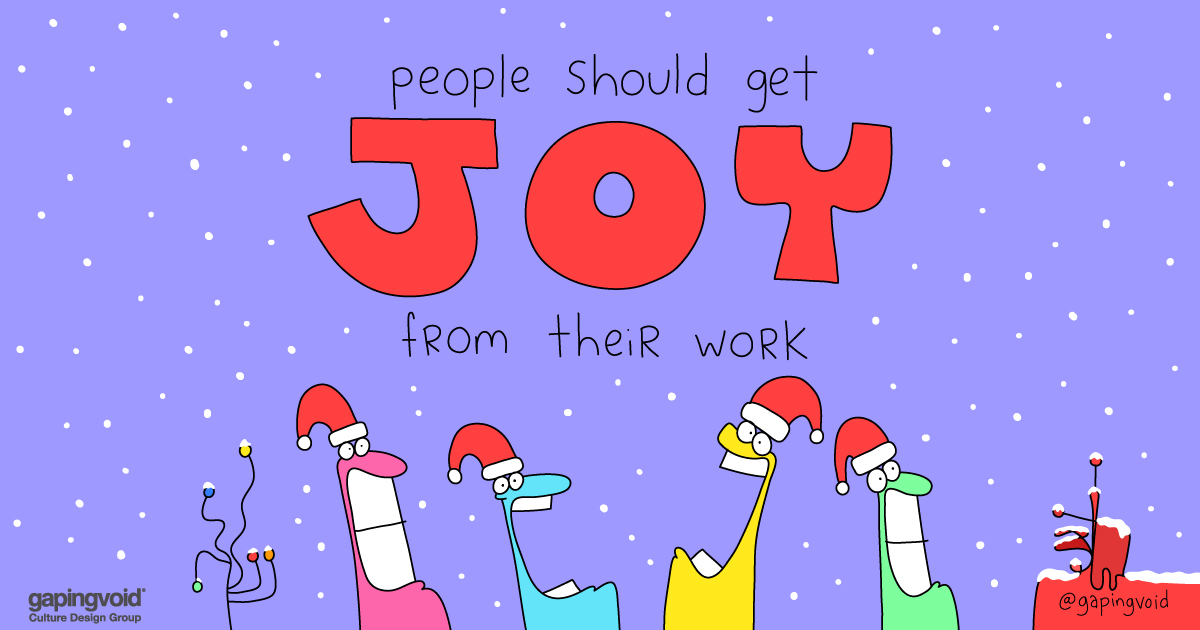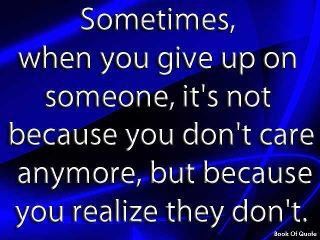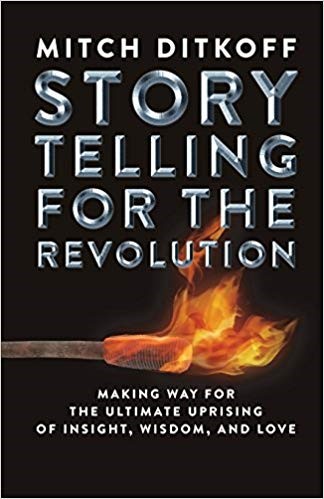On Being a Team Leader With Very Little Time
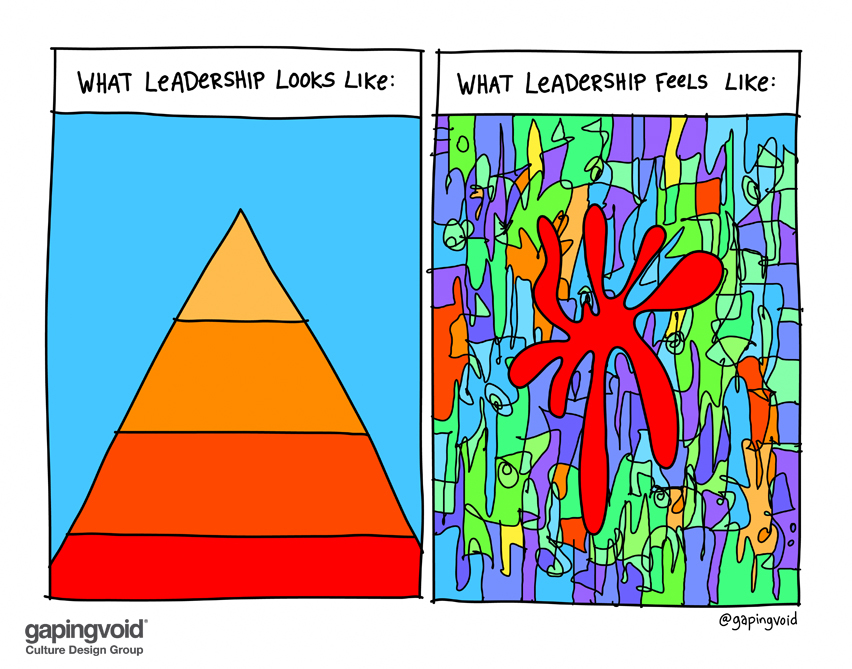
There are three things I've learned about Team Leaders in the past 37 years of working with these organizations.
1. They want their teams to become more high performing
2. The time they have to play their role is limited
3. They have choices about which team building efforts to make
Towards that end (assuming you have three minutes), take a look at the many choices you have to increase the long-term effectiveness and well-being your team. Then pick at least ONE to focus on this week.
YOUR CHOICES
-- Listen more deeply to each team member's needs and perspectives
-- Notice when team members are doing something well
-- Give more positive feedback soon after your notice a success
-- Notice "room for improvement" moments, then give feedback
-- Improve your team meetings
-- Begin team meetings by acknowledging forward progress
-- Establish team agreements
-- Help each person understand their roles and responsibilities
-- Clarify your team's work processes
-- Have more casual, one-on-one conversations
-- Secure more support from Senior Leadership
-- Empower team members to solve their own problems
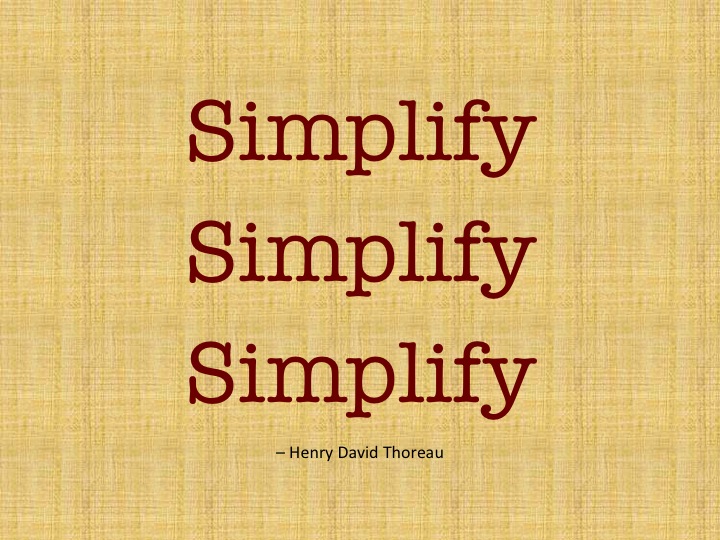
Go beyond the team leader overload syndrome
On being an effective team leader
Communicate your responsibilities to your team
Illustration: gapingvoid
Posted by Mitch Ditkoff at 09:19 PM | Comments (0)
April 19, 2024TEAM LEADERS: Communicate Your Responsibilities to Your Team!

If you are a Team Leader, one of the first things you will need to do is let your team know the full scope of your roles and responsibilities.
You may think they know, but it's very likely that they don't -- at least not at the level of specificity that a high performing team requires.
And if team members don't understand what you actually DO -- and WHY you do it -- chances are good that they will resist, rebel, or reject your efforts to play your role.

1. HOW TO PROCEED: As soon as possible, meet with your team and explain the scope of your role. If you happen to be a new team leader (and your team is doubtful of your skills, leadership ability, or authority),let them know, who, specifically, in your organization, has empowered you to BE the Team Leader and that you take your responsibility very seriously.
Be sure to mention that one of your main roles is to be a helpful resource for team members -- to be there for them to help ensure that they enjoy their job, learn, grow, collaborate, and accomplish their ambitious performance goals for the year.
NOTE: Some members of your team probably perceive you as the person who is going to judge, evaluate, correct, criticize, intimidate, and hassle them. Paranoia alert! This is old school thinking. Or more like pre-school thinking.
A savvy team leader will quickly dispel this bogus notion. The faster you can let your team know that the essence of your role is be of of major support to them, the better.
2. BE SPECIFIC ABOUT YOUR ROLES AND RESPONSIBILITIES: The term "Team Leader" will mean different things to different people. Unless you explain precisely what your role is (and what it's not), you will be at the mercy of your team members' wide range of concepts, assumptions, and projections.
The best way to minimize this kind of background noise is to clearly and confidently describe, one by one, your Team Leader roles and responsibilities.
Towards that end, take a look at the list of your possible roles and responsibilities below. Note the ones that accurately describe your job and add whatever items may be missing.
-- Help your team articulate and fulfill its mission statement
-- Listen non-judgmentally
-- Share your expectations for the year
-- Establish and uphold standards of excellence
-- Facilitate the process of establishing team agreements
-- Work with team members to set performance goals
-- Observe and evaluate performance on-the-job
-- Give useful, humane, and timely feedback
-- Coach and mentor
-- Clarify team members' roles and responsibilities
-- Hold people accountable for results
-- Identify, clarify, and communicate team processes
-- Facilitate team meetings
-- Secure resources for the team
-- Ensure that team members create their Learning Plans for the year
-- Promote the teams' successes to Senior Leadership
-- Establish a simple, inspiring ideation process
-- Conduct performance reviews
-- Acknowledge individual and team progress
-- Address team challenges, conflicts, and breakdowns
-- Do everything possible to ensure the team's well-being

Posted by Mitch Ditkoff at 11:39 AM | Comments (0)
April 09, 202425 Reasons Why Brainstorming Sessions Fail in Your Company

Whenever I ask my clients to tell me about the quality of their company's brainstorming sessions, they usually roll their eyes and grumble, noting several of the phenomena below.
Recognize any of them in your organization?
1. Lame facilitation
2. Wrong problem statement
3. Unmotivated participants
4. Hidden (or competing) agendas
5. Insufficient diversity of participants
6. Addiction to the status quo
7. Lack of clear ground rules
8. Insufficient trust in the facilitator
9. No transition from "business as usual"
10. Lack of robust participation
11. The extroverts take over
12. Habitual idea killing
13. Attachment to pet ideas
14. Discomfort with ambiguity
15. Hyper-seriousness

16. Endless interruptions
17. People come late and leave early
18. Premature adoption of the first "right idea"
19. Group think
20. Hierarchy, turfs, and competing sub-groups
21. Imbalance of divergent and convergent thinking
22. No tools or techniques to spark creativity
23. Inadequate idea capture methods
24. Premature evaluation
25. No meaningful follow through
Free the Genie sessions eliminate all of the above
Posted by Mitch Ditkoff at 07:45 AM | Comments (5)
January 10, 202432 Inspiring Quotes on Mastery

"Mastery" is a fascinating phenomenon -- one that many people speak about, but few attain. Is it possible? Yes, it is. But what is it really? Ah... now that's the question, isn't it? The dictionary defines mastery as "possession or display of great skill or technique." OK. Good start. If you're fluent in French, for example, you have a mastery of the language. If you win every game of chess, you show a mastery of the game. Skill is necessary, of course, in order to be a Master, but it not sufficient. Something else, beyond skill, is also needed. What might that be?
"One can have no smaller or greater mastery then mastery of oneself." - Leonardo DaVinci
"It's easy to get on the path of mastery. The real challenge lies in staying on it." - George Leonard
"If people knew how hard I had to work to gain my mastery, it would not seem so wonderful at all." - Michelangelo
"Only one who devotes himself to a cause with his whole strength and soul can be a true master. For this reason mastery demands all of a person." - Albert Einstein

"People with a high level of personal mastery are able to consistently realize the results that matter most deeply to them. They approach their life as an artist would approach a work of art. They do that by becoming committed to their own lifelong learning." - Peter Senge
"Clarity precedes mastery." - Robin Sharma
"If you are not willing to be a fool, you can't become a master." - Jordan Peterson
"It took me a lifetime." - Pablo Picasso
"Order and simplification are the first steps towards mastery of a subject." - Thomas Mann
"Over-seriousness is a warning sign for mediocrity and bureaucratic thinking. People who are seriously committed to mastery and high performance are secure enough to lighten up." - Michael J. Gelb
"Mastery is not a function of genius or talent. It is a function of time and intense focus applied to a particular field of knowledge." - Robert Greene
"All practical teachers know that education is a patient process of mastery of details, minute by minute, hour by hour, day by day." - Alfred North Whitehead
"Manhood is patience. Mastery is nine times patience." - Ursula. K. Leguin
"The Master doesn't glitter like a jewel, but is as rugged and common as a stone." - Lao Tzu
"If I had known there was such a thing as Islamic Calligraphy, I would never have started to paint. I have strived to reach the highest levels of artistic mastery, but I found that Islamic Calligraphy was there ages before I was." - Pablo Picasso
"I know how to go, go, go. Stopping, I've learned, is the stuff of mastery." - Danielle LaPorte
"Detachment is the beginning of mastery." - Sri Aurobindo
"Absorb what is useful, discard what is not, add what is uniquely your own." - Bruce Lee
"A man has to learn that he cannot command things, but that he can command himself; that he cannot coerce the wills of others, but that he can mold and master his own will: and things serve him who serves Truth; people seek guidance of him who is master of himself." - James Allen
"Mastery of awareness requires that you never take personal offense." - Deepak Chopra

"Every artist was first an amateur." - Ralph Waldo Emerson
"Meditate. Live purely. Be quiet. Do your work with mastery. Like the moon, come out from behind the clouds! Shine." - Buddha
"Mastery is not measured by the number of terrible things you eliminate from your life, but by the number of times you eliminate calling them terrible." - Neal Donald Walsch
"A good teacher protects his pupils from his own influence." - Bruce Lee
"You must immerse yourself in your work. You have to fall in love with your work. You must dedicate your life to mastering your skill. That's the secret of success." - Chef Jiro
"Mastery comes via a monomaniacal focus on simplicity versus an addiction to complexity." - Robin Sharma
"Most people have no idea of the giant capacity we can immediately command when we focus all our resources on mastering a single area of our lives." - Tony Robbins
"You cannot control what happens to you but you can control your attitude toward what happens to you. In that, you will be mastering change rather than allowing it to master you." - Brian Tracy
"Self-discipline begins with the mastery of your thoughts. If you don't control what you think, you can't control what you do. Simply, self-discipline enables you to think first and act afterward." - Napoleon Hill
"All of your scholarship, all your study of Shakespeare and Wordsworth would be vain if at the same time you did not build your character and attain mastery over your thoughts and your actions." - Mahatma Gandhi
"Progress comes to those who train and train; reliance on secret techniques will get you nowhere." - Morihei Ueshiba
"How do you best move toward mastery? To put it simply, you practice diligently, but you practice primarily for the sake of the practice itself." - George Leonard
Photo #1: Matt Sclarandis, Unsplash
Photo #2: Blaz Erzetic, Unsplash
Posted by Mitch Ditkoff at 09:18 AM | Comments (0)
September 02, 202320 Reasons Why People Get Their Best Ideas in the Shower

During the past 25 years, I've asked more than 10,000 people where and when they get their best ideas. I get all kinds of answers, but the one that has always fascinated me is "the shower" -- maybe because I also get so many of my good ideas there. And so, at the risk of overstating my case, I hereby offer you 20 reasons WHY the shower is so conducive to idea generation.
1. Showering signals "a new day" or "new beginning."
2. You're usually alone, with time to reflect.
3. Interruptions are rare.
4. The rush of water creates a kind of "white noise" that makes concentration easier.
5. Shower stalls look like little incubation chambers.
6. Water is associated with "contemplation" (i.e. sitting near a river, lake, or ocean.)
7. Showering is a metaphor for "getting rid of the dirt" -- the stuff that covers up what's beneath.
8. Showering is a ritual. Lots of creative people like to have little rituals to get their head in the right place.
9. You can write your ideas on the walls with a water soluble pen.
10. There's not a lot of judgment or analysis going on in a shower.
11. A hot shower opens the pores -- and by extension, maybe the mind.
12. Showering wakes up you. It makes you more alert.
13. Showering is a relaxing and stress free experience. With nothing to stress about, your mind is free to roam new territories.
14. If you shampoo, you're massaging your head. That's gotta be good.
15. It's hard to check your email or Facebook page in a shower.
16. Albert Einstein did his best thinking near a shower. ("Why is it I always get my best ideas while shaving?")
17. Water is associated with "flow." Being in the "flow state" is often a precursor to creative thinking.
18. There is no deliverable expected of you.
19. If you shower with a friend, and he/she happens to be in a brainstorming mode, lots of great ideas get sparked.
20. Showering is easy. Not a lot of thinking is required to make it happen, which frees your mind to think about other things.
Many stories from my book were remembered in the shower
Another place to get ideas
And another
An online shower of ideas
The mothership
Posted by Mitch Ditkoff at 11:48 AM | Comments (4)
July 02, 2023Sun Tzu on Preparation

"Every battle is won or lost before it is fought." - Sun Tzu
What challenge or opportunity is coming up for you that will require a higher level of preparation than you usually make? What extra effort are you willing to make in order to prepare? What might prevent you from making the kind of effort you know you need to make?
How can you create the support you need to ensure that your preparation efforts succeed?
MitchDitkoff.com
Posted by Mitch Ditkoff at 10:04 AM | Comments (0)
April 07, 2023The Awesome Power of Immersion

"If I had an hour to solve a problem," explained Albert Einstein, "I'd spend the first 55 minutes thinking about the problem, and the last five solving it."
Translation? One of the secrets to having a big breakthrough is immersion -- "the state of being deeply engaged, involved, or absorbed."
Immersion is the ocean in which our fabulous insights, ideas, and illuminations are swimming. That's why Yogis seek out caves, embryos gestate, and writers go on retreat.
And that's why my business partner, Steven McHugh, and I rented a townhouse in Boulder, Colorado for 30 days and 30 nights when it was time for us to start up Idea Champions. We knew we had a great idea for a business, but we also knew that ideas were a dime a dozen and that unless we really immersed we'd end up with nothing much more than a charming story to tell at cocktail parties -- the idea for a business, but not the business itself.
Armed with little more than a flip chart, a few marking pens, and a burning desire to create something new, we unplugged from all our other commitments and jumped in with both feet.

We talked. We walked. We walked our talk. We noodled. We conjured. We brainstormed, blue-skied, dialogued, role played, invented, read, sang, stretched, drank coffee, wine, the crisp Colorado air, and whatever else it took to free ourselves from the gravity of what we already knew. If this was Rocky 1, our townhouse was the Gym, Adrienne nowhere in sight.
And every night before we went to bed, blissed out of our trees, we'd remind each other to remember our dreams and speak them aloud the first thing in the morning.
CLUES. We were looking for clues, hints, perfumed handkerchiefs dropped by our muse while we slept and anything else that bubbled to the surface of the imaginal stew we found ourselves now swimming in.
Crackpots? No. More like crockpots, simmering in our own creative juices, unimpaired by the almost infinite amount of distractions we had grown accustomed to calling our life.
Immersed. We were completely immersed -- two eggs submerged in the boiling water of creation, heat turned up, lid on, timer off.
Our walls? The walls of our abode? Covered with paper, sketches, scribbles, post-its, quotes, pictures, lists, charts, diagrams, questions, and take out menus -- the barely decipherable hieroglyphics of our journey into who knows where.
The floors? Our mothers would have had a heart attack, littered as they were with anything we didn't have a place for. Rube Goldberg meets Fellini. Yin meets Yang meets Jung -- the flora and fauna of two aspiring entrepreneurs on fire with possibility.

But our immersion went far beyond the four walls of our abode. It was a state of mind, not a geographical location. It didn't really matter where we were. Walking by the creek or sitting in a bar was all the same to us, ruled as we were by our shared fascination, random silken threads of conversation with complete strangers, and the increasingly apparent sense that we were on to something big.
And then, on the morning of the 19th day, very much at ease in our townhouse abode, there was a knock on the door -- a loud and insistent knock, a knock both of us found rather odd since nobody knew where we lived -- or so we thought.
"It's open," Steven shouted from across the room. "Go ahead and let yourself in."
And there, at the threshold, stood a woman neither of us knew, a woman boldly announcing that, for the past three days, she'd been hearing about "these two creativity guys" and she just had to meet us, her business now on the cusp of either breaking through or breaking down.
I don't remember a single thing of we said, but whatever it was hit the nail on the head.
The next day, there was another knock on the door. Apparently, someone else had heard about our whereabouts. This guy had a business, too, or was trying to have a business. He spoke. We listened. He spoke some more. We listened some more, occasionally asking a question or two and sharing some insight. He too, got what he needed.
On the third day, Jesus did not rise from the grave, but, yes, there was another knock on the door -- just enough proof to the logical part of our minds that the previous two visits were not random events, but part of some kind of emerging pattern -- what fans of Rupert Sheldrake might refer to as manifestations of the morphogenetic field, or what less metaphysical folks might describe as our very own "field of dreams."
Steven and I had done nothing at all to draw these people to us -- no ads in the paper, no posters on poles, no calls, no emails, no flyers, no social marketing campaigns. The only thing we'd done was immerse -- dig deeply into our own highly charged process of creating something new.
But this "nothing at all" wasn't nothing at all. It was something -- something grand and glorious. Something extraordinarily attractive.

Is a mother hen sitting on her egg doing nothing at all? Is she slacking? Is her seeming disappearance from the poultry marketplace a sign of irresponsibility?
To the casual observer, maybe that's what it looks like, but nothing could be further from the truth. Sitting is exactly what the mother hen needs to do in order to bring new life into the world. Stillness, not action, is her path.
Did Steven and I accomplish what we set out to do during our 30 days of immersion? Yes, we did. In spades. Beyond the inspiration, collaboration, and good feelings we experienced, we emerged with the design of our first product -- a creative thinking training we ended up licensing to AT&T just two years later for a truck load of money.
Was our immersion time all fun and games? No way. Chaos and confusion were our housemates, but the rent they paid sparked a ton of learning, creativity, discovery, and a new found willingness to make friends with the unknown -- what Henry Miller was referring to when he defined confusion as "simply a word we've invented for an order that is not yet understood."
In today's business world, immersion is a very rare commodity. ADD rules the day. Time is sliced and diced. We don't have time. Time has us. We tweet, we delete, we tap our feet, but all too often nothing much beyond the status quo ever really happens. Downtime has become an anathema -- the province of "B list" players. Busy-ness and business have become synonymous.
The assumption? The more we do and the faster we do it, the more success we'll have. Boil an egg? Ha! We microwave it -- even if it tastes like shit. Dive in? No way. We hydroplane.
But it doesn't have to be that way. It really doesn't.
Slowing down and going deep trumps speeding up and going crazy. Immersion trumps diversion. It's possible. Yes, it is. I have proof. And so do YOU, if only you would pause long enough to remember those extraordinary times when you unplugged, tuned in, and dove into your own process of creating something new and wonderful.
A QUESTION FOR YOUR CONSIDERATION:
What can you do, this week, month, or quarter, to unplug from the daily grind and give yourself the luxury of immersion? Where will you go? When? And who will you invite to accompany you, if anyone?
Excerpted from my forthcoming book: WISDOM AT WORK: How Moments of Truth on the Job Reveal the Real Business of Life.
Excerpted from Storytelling at Work
MitchDitkoff.com
IdeaChampions
Posted by Mitch Ditkoff at 08:58 PM | Comments (0)
November 22, 2022THE BEAUTY OF FEEDBACK: It's Not a Weapon. It's a Mirror.

I want you to imagine, for a moment, that I am your manager and, while passing you in the hallway on the way to yet another meeting. I catch your eye, take a step towards you and, in a halting voice, say "Umm... uh... hi... I'm wondering if you have some time later today for me... er... to share a bit of feedback with you."
How are you feeling right now?
I'm guessing not so good -- especially since the word, "feedback", in most organizations, has become synonymous with, "I'm just about to chop your head off."
I'm not exactly sure what the origins of this phenomenon are, but if I were to hazard a guess I would think it has something to do with the fact that most people don't know how to give feedback and, on the other side of the coin, our amygdala (the danger sensing part of our brain) is gearing up to protect itself from perceived harm.

Too bad.
And why it's too bad is because feedback is probably the simplest, fastest, most efficient way for a person to learn, grow, and get better results.
Metaphorically speaking, feedback is a mirror.
If you're about to give a speech to a thousand people, no one would fault you for taking a moment to check yourself in a mirror to see if your hair was out of place or you had a piece of spinach stuck between your teeth. That's not vanity. That's common sense. The mirror, quite simply, helps you see yourself in order to make a useful adjustment or two.
The mirror is not judging you. It is not criticizing you. Nor is it ridiculing, shaming, dissing, mocking, humiliating, trashing, bad-vibing or demonstrating its superiority over you. Nope. All it's doing is helping you see yourself clearly in the moment. Then, YOU get to decide if you want to brush your hair or remove that piece of spinach from between your teeth.
What might you need to do differently in order to be more open to the feedback of others? How might you improve your own feedback-giving skills?
25 quotes on feedback
Why offer positive feedback
The hardest part is knowing how to begin
Positive feedback from people learning how to give feedback
Photo #1: Taylor Smith, Unsplash
Photo #2: Mihai Surdu, Unsplash
Posted by Mitch Ditkoff at 07:48 AM | Comments (0)
May 28, 2022Be a Mr. Jensen
Posted by Mitch Ditkoff at 10:41 PM | Comments (0)
April 30, 2022We Were Made for These Times!

What follows is an extraordinary call of the heart by Clarissa Pinkola Estes. Not only is it worth reading, it's worth reading aloud -- so you hear it and feel it as well as see it. Then, you get to decide who you want to share it with -- and how. This is a piece of deep, soul-inspired, primal writing that deserves to travel to every corner of the Earth.
"My friends, do not lose heart. We were made for these times. I have heard from so many recently who are deeply and properly bewildered. They are concerned about the state of affairs in our world now. Ours is a time of almost daily astonishment and often righteous rage over the latest degradations of what matters most to civilized, visionary people.
You are right in your assessments. The luster and hubris some have aspired to while endorsing acts so heinous against children, elders, everyday people, the poor, the unguarded, the helpless, is breathtaking. Yet, I urge you, ask you, gentle you, to please not spend your spirit dry by bewailing these difficult times. Especially do not lose hope. Most particularly because, the fact is that we were made for these times. Yes. For years, we have been learning, practicing, been in training for and just waiting to meet on this exact plain of engagement.
I grew up on the Great Lakes and recognize a seaworthy vessel when I see one. Regarding awakened souls, there have never been more able vessels in the waters than there are right now across the world. And they are fully provisioned and able to signal one another as never before in the history of humankind.
Look out over the prow; there are millions of boats of righteous souls on the waters with you. Even though your veneers may shiver from every wave in this stormy roil, I assure you that the long timbers composing your prow and rudder come from a greater forest. That long-grained lumber is known to withstand storms, to hold together, to hold its own, and to advance, regardless.
In any dark time, there is a tendency to veer toward fainting over how much is wrong or unmended in the world. Do not focus on that. There is a tendency, too, to fall into being weakened by dwelling on what is outside your reach, by what cannot yet be. Do not focus there. That is spending the wind without raising the sails.
We are needed, that is all we can know. And though we meet resistance, we more so will meet great souls who will hail us, love us and guide us, and we will know them when they appear. Didn't you say you were a believer? Didn't you say you pledged to listen to a voice greater? Didn't you ask for grace? Don't you remember that to be in grace means to submit to the voice greater?
Ours is not the task of fixing the entire world all at once, but of stretching out to mend the part of the world that is within our reach. Any small, calm thing that one soul can do to help another soul, to assist some portion of this poor suffering world, will help immensely. It is not given to us to know which acts or by whom, will cause the critical mass to tip toward an enduring good.
What is needed for dramatic change is an accumulation of acts, adding, adding to, adding more, continuing. We know that it does not take everyone on Earth to bring justice and peace, but only a small, determined group who will not give up during the first, second, or hundredth gale.
One of the most calming and powerful actions you can do to intervene in a stormy world is to stand up and show your soul. Soul on deck shines like gold in dark times. The light of the soul throws sparks, can send up flares, builds signal fires, causes proper matters to catch fire. To display the lantern of soul in shadowy times like these - to be fierce and to show mercy toward others; both are acts of immense bravery and greatest necessity.
Struggling souls catch light from other souls who are fully lit and willing to show it. If you would help to calm the tumult, this is one of the strongest things you can do.
There will always be times when you feel discouraged. I too have felt despair many times in my life, but I do not keep a chair for it. I will not entertain it. It is not allowed to eat from my plate.
The reason is this: In my uttermost bones I know something, as do you. It is that there can be no despair when you remember why you came to Earth, who you serve, and who sent you here. The good words we say and the good deeds we do are not ours. They are the words and deeds of the One who brought us here. In that spirit, I hope you will write this on your wall: When a great ship is in harbor and moored, it is safe, there can be no doubt. But that is not what great ships are built for."
Clarissa Pinkola Estes: American poet, post-trauma specialist, Jungian psychoanalyst, and author of Women Who Run With the Wolves.
Posted by Mitch Ditkoff at 12:33 PM | Comments (0)
April 05, 2022The Six Sides of the So-Called Box

Unless you've been in a coma for the past 20 years, I'm sure you're familiar with the phrase "get out of the box." It's everywhere. Whole industries have sprung up around it, including mine.
No one can deny that getting out of the box is a good thing to do. Seems like a no-brainer, eh? Kind of like helping little old ladies cross the street. Or tearing down the Berlin Wall. But before you start planning your heroic escape, answer me this: What the heck is the box, anyway? What is this so-called thing that keeps us so contained, confined, caged, trapped, claustrophobic, and otherwise unable to create?
Let's start with the basics. A box has six sides, including the top and the bottom.
If we can understand what these six sides are, we'll know what we're dealing with -- and this knowledge will improve our chances of getting out. Or, as Fritz Perls once said, "Awareness cures." Let us proceed...
1. ASSUMPTIONS: Assumptions are the guesses we make based on our subjective interpretation of reality. They are short cuts. Lines drawn in the sand. We end up taking things for granted because we are either too lazy to get down to the root of things or too entranced by our own beliefs to consider an alternative.
Ultimately, it is our assumptions that shape our world. The world is the screen and we are the projector, seeing only what we project -- which is all too often merely a function of the assumptions we've made. As one wise pundit once put it, "When a pickpocket meets a saint, all he sees our pockets." Bottom line, we see what we are primed to see. Change your assumptions and you change the world -- starting with your own.
2. FEAR: If you want to raise the odds of being trapped in a box for the rest of your life, all you need to do is increase the amount of fear you feel. Fear inhibits. Fear paralyzes. Fear subverts action. Indeed, when fear rules the day, even reacting is difficult. Fear not only puts us in the box, it makes it almost impossible to get out the box.
Fear of what? Fear of judgment. Fear of failure. Fear of change. Fear of the unknown. Fear of being revealed to be an impostor. Fear of this. Fear of that. And fear of the other thing, too.
Do you think it's an accident that Peter Drucker devoted his entire life to driving fear out of the workplace? Or course not. Fear sucks. And precisely what it sucks is the life right out of you. There is no box without fear. Get rid of fear and you get rid of the box.
3. POWERLESSNESS: Powerlessness is the state of mind in which people think they have no choice -- that they are victims of circumstance, that the act of attempting anything new is futile.It's why Dilbert has become the patron saint of most cubicle dwellers.
Some in-the-box people have dwelled in the state of powerlessness for their entire life, going all the way back to childhood, overpowered (or disempowered) by parents, schools, and who knows what else.
If you work in an organization, you've seen this powerlessness paradigm in spades -- as the "powers-that-be" don't always take kindly to the ideas, input, and grumblings of the "rank and file." If you're feeling powerless, not only are you in the box, it's highly unlikely that you'll be able to muster the energy, intention, or urgency to get out of it.
4. ISOLATION: Boxes are usually small and confining. Rarely is there room for more than one person. Isolation is the result. There's no one to talk to, no one to bounce ideas off of, no one to collaborate with.
Curiously, solitary confinement is the biggest punishment our society doles out -- second only to the death sentence. Being cut off from the tribe has been a very effective "behavior modification" technique for centuries. When you're in the box, that's exactly what's happening.
And while your isolation may give you a momentary feeling of much-needed privacy, safety, and relief from the judgment of others, it's fool's gold. Sitting in the dark, being completely on your own, vision obscured -- all reduce your chances of getting out.
5. MENTAL CLUTTER:
If you find yourself in the box, it would be fair to say that the box contains you. But what do you contain?

If you are like most people in today's over-caffeinated, twitterfied, information-overloaded world the answer is: too much. With the amount of information doubling every few years, most of us have way too much on our minds. Too much to do and not enough time. We have no time for musing. No time for pondering. No time for reflecting. No time for contemplating, incubating, or making new connections -- behaviors that are essential to true out-of-the-box thinking.
The result? Not a good one. We latch onto the first seemingly "right idea" that comes our way -- or else desperately try to declutter our minds with an endless series of mindless distractions that only increase the amount of clutter we need to process. Ouch.
6. TUNNEL VISION:
When you're in a box, it's hard to see. Sight lines are limited. Vision is obscured. We become shortsighted. Our vision conforms to that which confines it. We become, soon enough, narrow-minded. I'm sure you know a few people like this. Their ability to see beyond their immediate surroundings has become disabled.
When this kind of phenomenon becomes institutionalized, we end up with a bad case of "next quarter syndrome" -- especially in organizations ruled by the need to constantly please profit-seeking shareholders. Few people are thinking six months out. Few are thinking 12 months out. And almost no one is thinking five years out. Everyone is trapped by the short-term.
What we call "focus" becomes a euphemism for tunnel vision -- just another form of narrow-mindedness that makes getting out of the box about as likely as my credit card company rescinding their usurious late payment fees.
What are some ways you can reliably get out of the box on the job?
Posted by Mitch Ditkoff at 04:44 PM | Comments (2)
March 08, 2022THE CURE FOR THE CREATIVE BLUES: Self-Acknowledgment

If you're a creative person working on a project that is unlikely to get results overnight, here's a simple practice to save you from the all-too-familiar phenomenon of depressing yourself by focusing on the proverbial cup being half-empty.
At the end of each work day, acknowledge yourself for all of the progress you've made -- small, medium, and large. But not just silently, in your head, verbally -- aloud.

Most creative people, no matter how inspired they are at the beginning of a project, eventually end up feeling down in the dumps. They tend to focus on what they haven't done and everything that hasn't happened instead of their progress and the fact that they are actually getting closer to their goal.
What I do at the end of each work day is SPEAK OUT, to myself, everything I've done that day to move my project forward -- whether it was a phone call made, research done, a task accomplished, proposal accepted, a new insight, or whatever.
This simple self-acknowledgment-process establishes a sense of closure for the day, so you can let go of "work mode" and transition to an evening of rest, renewal, and incubation -- an actual night off without having to carry that heavy load of incompletes that not only weigh YOU down, but weigh down all those wonderful people around you who can FEEL your low grade virus of "not good enough."
Three minutes. That's all it takes. Try it.
Posted by Mitch Ditkoff at 02:37 PM | Comments (0)
February 14, 2022Steve Jobs on Marketing
And here's the Think Different ad that emerged from this way of thinking.
Posted by Mitch Ditkoff at 08:14 AM | Comments (0)
November 03, 2021Brainstorming vs. Braincalming

If you work in a big organization, small business, freelance, or eat cheese, there's a good chance you've participated in at least a few brainstorming sessions in your life.
You've noodled, conjured, envisioned, ideated, piggybacked, and endured overly enthusiastic facilitators doing their facilitator thing. You may have even gotten some results. Hallelujah!
But even the best run brainstorming sessions are based on a questionable assumption -- that the origination of powerful, new ideas depends on the facilitated interaction between people.
You know, the "two heads are better than one" syndrome.

I'd like to propose an alternative for the moment: "two heads are sometimes better than one."
For the moment, I invite you to consider the possibility that the origination of great, new ideas doesn't take place in the storm, but in the calm before the storm... or the calm after the storm... or sometimes, even in the eye of the storm itself.
Ever wonder why so many people get their best ideas during "down time" -- the time just before they go to sleep... or just after waking... or in dreams... or in the shower... or in the car on the way home from work?
Those aren't brainstorming sessions, folks. Those are braincalming sessions. Incubation time.
Those are time outs for the hyperactive child genius within us who is always on the go. Methinks, in today's over-caffeinated, late-for-a-very-important-date business world, we have become addicted to the storm.
"Look busy," is the mantra, not "look deeply."
We want high winds. We want lightning. We want proof that something is happening, even if the proof turns out to be nothing more than sound and fury. High winds do not last all morning. Sometimes the storm has to stop.
That's why some of your co-workers like to show up early at the office before anyone else has arrived. For many of us, that's the only time we have to think.
"The best thinking has been done in solitude," said Thomas Edison. "The worst has been done in turmoil."
I'm not suggesting that you stop brainstorming (um... that's 20% of our business). All I'm suggesting is you balance it out with some braincalming. The combination of the two can be very, very powerful.
HERE'S A FEW WAYS TO GET STARTED:
1. In the middle of your next brainstorming, session, restate the challenge -- then ask everyone to sit in silence for five minutes and write down whatever ideas come to mind. (Be ready for the inevitable joking that will immediately follow your request). Then, after five minutes are up ask everyone to state their most compelling idea.
2. Ask each member of your team to think about a specific business-related challenge before they go to bed tonight and write down their ideas when they wake up. Then, gather your team together for a morning coffee and see what you've got.
3. Conduct your next brainstorming session in total silence. Begin by having the brainstorming challenge written on a big flip chart before people enter the room. Then, after some initial schmoozing, explain the "silence ground rule" and the process: People will write their ideas on post-its or flip charts. Their co-workers, also in silence, will read what gets posted and piggyback. Nobody talks.
It's your decision, at the end of the idea generating time, if you want the debrief to be spoken -- or if you want people to come back the next day for a verbal debrief.
"Let us be silent, that we may hear the whispers of the gods." - Ralph Waldo Emerson
The Mothership: Idea Champions
Posted by Mitch Ditkoff at 10:23 PM | Comments (6)
September 25, 2021Public Art as a Storytelling Medium
Stories can be told in many ways -- not just with words. Here is a great example of how it's done with public art in Springfield, Massachusetts. Storytelling is all about the art of communicating a message in a way that is inspiring, memorable, and meaningful. Mimi Ditkoff and her team of muralists are a great example of how this is done.
What medium can YOU use to tell a story that needs to be told?
Posted by Mitch Ditkoff at 05:07 AM | Comments (0)
August 21, 2021Saying YES to Your Weirdness
Posted by Mitch Ditkoff at 08:07 AM | Comments (0)
August 09, 202127 Best Practices of High Performing Volunteer Organizations

Unless you've been in a coma your entire life, chances are good that, at some time in your life (maybe now?) you've been a volunteer for a non-profit organization.
That's the good news.
The not-so-good news is that many volunteer organizations, without even knowing it, sabotage the value their volunteers bring to the table and you, as a result, may have backed off, gone south, or found yourself grumbling to the other volunteers.
I've recently done some informal research on the subject and have identified 27 "best practices" high performing volunteer organizations abide by. Take a peek. Then, volunteer to share the list with the leaders of whatever volunteer organizations you would like to see succeed at a higher level. Can do?
1. Clearly (and often) communicate the vision.
2. Provide clearly written job descriptions.
3. Take the time to authentically welcome volunteers and orient them to their new role.
4. Ensure that volunteers know exactly what's expected of them.
5. Start new volunteers off small. Don't scare them off with too huge of a commitment too soon.
6. Keep the workloads manageable.
7. Communicate progress being made on a regular basis. Volunteers need to see that their efforts are having impact.
8. When there are setbacks or breakdowns, learn from them -- and share your learnings with others.
9. Be prepared so you don't waste people's time.
10. Create a trusting environment that ensures open communication, teamwork, and respect for diversity.
11. Keep everyone on your team informed of the inevitable changes (i.e. direction, policy, timelines, goals, personnel etc.)
12. Provide opportunities for volunteers to switch to different roles they might find more enjoyable.
13. Give and receive feedback (both formally and informally).
14. Provide opportunities for volunteers to learn and grow.
15. Honor your commitments (and if, for any reason, you cannot -- renegotiate them with volunteers).
16. Give volunteers the opportunity to take breaks from the project.
17. Make sure volunteers know they can say "no" if they are overextended or overwhelmed.
18. Enthusiastically acknowledge successes, especially "small wins").
19. Be kind and respectful in all your interactions.
20. Do your best to make sure everyone is enjoying the process of participating.
21. Respond to input, questions, and feedback as soon as possible. Don't leave people hanging.
22. Build some interpersonal "chat time" into your meetings and conference calls.
23. Teach volunteers, in leadership positions, how to delegate.
24. Even when you are stressed or behind deadline, take the time to make sure your emails have a feeling of warmth to them.
25. Fill out Project Briefs on all projects you are inviting volunteer participation -- and share them with volunteers.
25. Conduct exit interviews whenever a volunteer ends their participation or is asked to step aside.
26. Share your learnings from the exit interviews with other managers.
27. Follow the Golden Rule: Do unto others as you would have them do unto you.
Posted by Mitch Ditkoff at 03:01 PM | Comments (1)
February 18, 2021What Should You Charge for Your Online Course?
Good, sound advice from Thinkific on figuring out what to charge for your online course.
Posted by Mitch Ditkoff at 01:41 PM | Comments (0)
January 15, 2021Want to Improve Your RFP Process?

Allow me to introduce myself. My name is Mitch Ditkoff. I am the Co-Founder of Idea Champions, an innovation consulting and training company headquartered in Woodstock, NY. We've been in business since 1986 and, since that time, have responded to more than 1,200 RFPs.
Along the way, we've noticed a curious trend.
Time and again, we've seen RFP-requesting companies get stuck with a vendor or contract that did not fulfill their needs because their RFP process got in the way -- a process that could have been a lot more effective if only it had been more open, honest, and complete.
And so, as a public service to you and all our other prospective clients, here are 10 simple guidelines to increase the odds of your RFP process getting you the kind of results you are looking for:
10 TIPS FOR IMPROVING YOUR PROPOSAL PROCESS
1. Be Prepared: The odds of us delivering a meaningful proposal to you increase exponentially in response to the accuracy and thoroughness of the input you provide.
If the person you report to has asked you to "google innovation consultants" and put five proposals on his/her desk by next Friday, make sure you are sufficiently briefed so what we deliver to you will be fully aligned with what you really need.
2. Be Clear About Deadlines: Is the proposal you are requesting really due yesterday? The first thing tomorrow? Two weeks from now? Please be willing to give us the scoop on when you really need it and we'll be happy to deliver it by then -- or sooner.
When you give potential vendors a fake deadline, it doesn't bode well for your future working relationship -- one that needs to be rooted in mutual trust, respect, and integrity.
And besides, unnecessarily stressing potential vendors may end up working against you, significantly increasing the odds of you receiving flawed, incomplete, or incomprehensible proposals.
3. Be Transparent: While your proposal process is your business, not ours, there is something to be said for letting us know how many other companies you've invited to respond. If you're asking another 25, our chances are 4% and we might decide not to throw our hat in the ring. Make sense?
If you already know you have only $2,500 to spend on your three-day event in Orlando, let us know that, too. This information will save us the time it takes to write a proposal you will never accept and you the time it will take to read it. Win/Win.
4. Be Ethical: If you are contacting us only to get some useful thought starters about your event or initiative and already know you will not be engaging our services, there's really no need to ask for a proposal.
Chances are good we'll be happy to talk with you about your event, anyway, just for the opportunity to spark a future business relationship with you.
We subscribe to the notion that the more you give, the more you get. But asking us for a proposal that has no chance of being accepted is really not playing fair.
Put yourself in our shoes. The Golden Rule applies.
5. Be Direct About What You're Asking For: If what you mean by "a proposal" is merely our fee, simply ask for it and we'll tell you. It will save us both a lot of time -- and more than a few trees.
If all you need is two pages' worth, mention that, too. If we give you ten and your threshold is two, both of us lose.
6. Be Honest: If you've already decided to engage the services of someone else, but need three competitive bids for "legal reasons," let us know. As part of our newly launched "Consulting Companies for a Proposal Savvy World" campaign, we'll send you -- within 24 hours -- our "They've Already Decided" proposal.
Much less work for us -- and no bad karma for you.
7.Keep Us Posted: At reasonable intervals, after we've submitted our proposal, please be willing to let us know where we stand.
If you haven't read our proposal yet, that's useful to know. If you can't find it, feel free to ask us to send another. If your conference has been canceled, we're just an email away. If you've decided to do it in-house, just holler. If budgets have been frozen... or your CEO has been indicted by the FTC... or you've decided that one of our competitors is the perfect fit, you know where to find us.
This information, delivered in a timely way, will allow us to release the dates we've been holding for you, significantly reducing the odds of you feeling guilty (or cranky) the next time we ask for an update.
8. Respond to Our (Infrequent) Emails: Often, when a prospective client asks us for a proposal, they ask us to "hold the date." This is perfectly understandable. It's common practice.
But sometimes another prospective client, the next day, will ask us for the same date. That's when we'll send you an email and ask for an update.
Since we will have given you the right of first refusal, all you need to do is let us know what's happening. Takes less than two minutes.
9. Provide Authentic Closure: Let's say you decide not to engage our services. Maybe you liked another consultant's approach better or decided to go with the low cost provider.
So be it. Your choice. No problem. Yes, we might be disappointed, but we'll get over it.
What's harder to get over is when there's no closure.
Of course, we realize you owe us nothing. You are not, by law, required to do anything after we submit our proposal. We also realize that your silence isn't synonymous with a lack of care. Indeed, sometimes it's the opposite -- since you may have grown to like us and don't want to be the bearer of bad news.
For us, bad news is better than none.
That's how we learn and, hopefully, get better at responding to your future requests.
And that's not all.
You get to maintain a positive relationship with a company (us) whose services you may want to engage in the future. You also avoid getting a bad rap among the other consulting companies with whom we are regularly in contact.
And we, of course, get the kind of feedback we need help us grow our business. How long does this closure effort take? Three minutes? Five? Ten at the most.
10. Consider Reinventing Your RFP Process: The above nine suggestions, of course, are only from our perspective. We're guessing there are at least a few other improvements you can think of that will significantly raise the odds of your future RFP process being more effective, efficient, and humane.
If you're stuck for fresh ideas about how to improve your RFP process, click here and conjure up some new ways you can change the game for the better.
A big thank you to Paul Roth and Val Vadeboncoeur for their sage input on this topic.
Posted by Mitch Ditkoff at 02:15 PM | Comments (4)
December 26, 2020Find Joy in Your Work!
Posted by Mitch Ditkoff at 08:01 PM | Comments (0)
October 17, 2020HOW MUCH DOES LUNCH COST? Pay What You Want!
During these economic melt down times of the Coronavirus, all bets are off. "Business as usual" just won't cut it anymore. Businesses and entrepreneurs are quickly changing business models, pricing models, staffing models, while simultaneously trying to figure out how to use ZOOM.
Forward thinking restaurateurs have been at this game for a while, as the above 2017 video makes abundantly clear.
Idea Champions is also experimenting in this realm. For example, instead of offering a two-week free trial of our online Free the Genie tool, we've decided to extend it to a free 10-year trial -- one way we can give back and be of assistance to people in need. Will we ever "profit" from this experiment? I have no idea. For now, it just feels like the right thing to do.
What can YOU or your business do to adapt to these radically changing times? What might you give away for free? How can you simplify your product or service? What might home delivery look like?
Posted by Mitch Ditkoff at 03:06 AM | Comments (0)
October 01, 2020Skillset vs. Mindset

A few years ago, as one of my clients introduced me to a roomful of people attending a leadership development workshop I was facilitating, something she said caught my attention: Innovation skills. That's what she was telling the 41 business leaders of the future they were going to learn from me.
Yes, it was true. I was going to help these people learn and practice some new skills. But that was only half the story. Actually, less than half. Much less.
If there's one thing I've learned these past 33 years of working as an innovation provocateur, it's this: mindset -- not skillset -- is the name of the game in business these days.
When a person's mindset (i.e. receptivity, curiosity, adaptability, enthusiasm, focus) is in the right place, skillset becomes secondary.
Is acquiring new skills useful? Of course it is. If you're about to have surgery, you want to know the doctor with the scalpel knows what he/she is doing. But all the skills in the world become useless if the mind of the physician is cloudy.
I'm talking attitude. Viewpoint. Approach. It's not what you look at, it's what you see. Psychologists have boiled down the phenomenon to three words: "Motivation affects perception".
If you're driving through a town and are hungry, what do you see? Restaurants. If you're running out of gas, it's gas stations you notice. And if someone you love is dying, you become suddenly amazed at how many funeral parlors there are.
Bottom line, if you want to jump start innovation, begin paying more attention to mindset. Be willing to make the effort required to help yourself and others enter into the frame of mind most conducive to innovating. Because in the end, it's less about where you're going, than where you're coming from.
What can YOU do to keep yourself in an innovation mindset?
Idea Champions
MitchDitkoff.com
A simple way to enter into the innovation mindset
Posted by Mitch Ditkoff at 11:35 PM | Comments (0)
September 14, 2020The Poop Revolution!
Posted by Mitch Ditkoff at 06:40 PM | Comments (0)
September 13, 2020AL SIRAAT COLLEGE: Team Leadership Training Testimonials

What follows is a sampling of testimonials from some of the 33 graduates of Idea Champions' Team Leadership Training, delivered to Al Siraat College, in Epping, Australia in 2020.
SHORT AND SWEET
"This is the best professional training I have ever done in my life. I wish I'd done it many years ago, so I could have incorporated its excellent ideas and practices earlier in my professional and personal life." -- Wayne Semmens
"An extraordinary experience." -- Rahat Arain
"Invaluable to my professional development. Will definitely be carried throughout my life." -- Gulcan Ayvaz
"Amazing. Gave me a different perspective on my role as a leader. I enjoyed the creativity of the program and how huge concepts were unpacked in a simplified manner." -- Shahidah Osman
"Fantastic. A great way to interact with other Team Leaders, share ideas, and learn from each other's experiences." - Misbah Aqeel
"Delivered in a very simple and unique way, making it easy to apply in my daily life. Helped me develop confidence in my leadership." - Maryam Omer
"Never a dull moment. A very enjoyable and relaxing experience that helped keep our minds open and look for creative ideas to improve ourselves and our teams." - Daniel Saleh
"An eye opener. Empowering. Helped me look at things from different perspectives and find new ways to improve things." - Suffian Mohammed Amin
"I now feel we have a process that will be followed by all stakeholders." - Leah Hamel
"Relevant, engaging, and fun. If we are able to implement even half of what we learned, we will become a different organization." - Fazeel Arain
"I got almost immediate, desired results!" - Sitki Esenyel
"It was a blessing to have the opportunity to go inward, outward, and onward. Each session was targeted and practical. The design and delivery were always engaging and stimulating." - Evla Han
"Generated many creative ideas to improve our teams and the school." - Noori Ahmad
"As a result of the training, my team is now working more collaboratively and sharing ideas. Trust has built over time." - Elif Boz

A DEEPER DIVE INTO THE TESTIMONIALS

"This is the best professional training I have ever done in my life. The breadth of topics was better than anything I have done before. The experience was both inspiring and practical. It was so good, in fact, that I wish I'd done this training many years ago, so I could have incorporated its excellent ideas and practices earlier in my professional and personal life." -- Wayne Semmens
"Being in the Team Leadership Training has been an extraordinary experience. We have learned through listening and peer-to-peer dialogue. It was supportive, with no  judgements, a variety of tools to extend our thinking, and no homework! What more could we have asked for? I do believe I'm starting to understand and appreciate people a little more. You have modeled, for us, a beautiful way to acknowledge others in a way that will help us build good relationships with our teams." -- Rahat Arain
judgements, a variety of tools to extend our thinking, and no homework! What more could we have asked for? I do believe I'm starting to understand and appreciate people a little more. You have modeled, for us, a beautiful way to acknowledge others in a way that will help us build good relationships with our teams." -- Rahat Arain
"Thank you very much for the wonderful training sessions! The time I spent in the Team Leadership Training has been invaluable  to my professional development and will definitely be carried throughout my life. I have been equipped with skills that assist my parenting of teenagers too, which was an unexpected bonus. I look forward to implementing the knowledge and tips you taught me and passing them onto others who will benefit, too." -- Gulcan Ayvaz
to my professional development and will definitely be carried throughout my life. I have been equipped with skills that assist my parenting of teenagers too, which was an unexpected bonus. I look forward to implementing the knowledge and tips you taught me and passing them onto others who will benefit, too." -- Gulcan Ayvaz
"The Team Leadership Training has given me an opportunity to develop my leadership skills to a different level than before. It helped me be reflective and embrace my challenges with grace and resilience. Mitch is an inspirational trainer who gives  his utmost energy with passion and engagement throughout the training. He amazed me in the way he presented his uplifting and thought-provoking creative ideas and succinct content. The training gave me a different perspective on my role as a leader. I learned, immensely, about ways to improve myself and the practicality of different leadership strategies. I enjoyed the creativity of the program and how huge concepts were unpacked in a simplified manner." -- Shahidah Osam
his utmost energy with passion and engagement throughout the training. He amazed me in the way he presented his uplifting and thought-provoking creative ideas and succinct content. The training gave me a different perspective on my role as a leader. I learned, immensely, about ways to improve myself and the practicality of different leadership strategies. I enjoyed the creativity of the program and how huge concepts were unpacked in a simplified manner." -- Shahidah Osam
"I was blessed to take the Team  Leadership Training. I found the training was very much targeted to develop my skills in many areas because it was delivered in a very simple and unique way, making it easy to apply in my daily life. The program helped me develop confidence in my leadership." -- Maryam Omer
Leadership Training. I found the training was very much targeted to develop my skills in many areas because it was delivered in a very simple and unique way, making it easy to apply in my daily life. The program helped me develop confidence in my leadership." -- Maryam Omer
"The Team Leadership Training is great way to interact with other Team Leaders, to share ideas, and to learn from their experiences. Mitch is a fantastic facilitator and, during each session, not once did I think of the time or when it would end!  I have benefited a lot from this training, have definitely learned to run meetings better, gel my team together, and clarify our roles and responsibilities." -- Misbah Aqeel
I have benefited a lot from this training, have definitely learned to run meetings better, gel my team together, and clarify our roles and responsibilities." -- Misbah Aqeel
"Mitch is a very enthusiastic facilitator, with great character, and makes everyone feel welcome. Even though there were many people in the sessions, he always made time to give people one-on-one feedback. I liked the way he infused each topic with storytelling to help get the message across. I also liked the 
way he got people out of their comfort zone. There was never a dull moment. All in all, it was a very enjoyable and relaxing experience that helped us keep our minds open and looking for new and creative ideas to improve ourselves and our teams." -- Daniel Saleh
"The Team Leadership Training is an eye opener and empowering. It helped me look at things from a different perspectives and to always find ways to improve things. I appreciated the time taken to unpack all the learnings and the practical examples shared by Mitch. As a result of this program, our team meetings  ehave changed for the better. Efficiency has improved." -- Suffian Mohammed Amin
ehave changed for the better. Efficiency has improved." -- Suffian Mohammed Amin
"The Team Leader training allowed me to follow a set procedure in regard to implementing any new process within my team and with external teams. It assisted me in with dealing with others, particularly those in more senior positions than myself, since they have also been through the training. I now feel as though we have a process that will be followed by all stakeholders." -- Leah Hamel

"The Team Leadership Training was a relevant and practical dive-in to improve ourselves and our teams. If we are able to implement even half of what we have learned, we will be a different organization than what we are now. The training was relevant, engaging, and fun." -- Fazeel Arain
"My team leadership has definitely improved because I valued the content of the training and saw its inherent value. And then, when I went to implement the theory and turn it into practice, I got almost immediate, desired results!  If I could graph my progress, it would resemble an upward trajectory." -- Sitki Esenyel
If I could graph my progress, it would resemble an upward trajectory." -- Sitki Esenyel
"The Team Leadership Training is much more than just professional development. I'm grateful to be part of a community that invests in people. In this process, some of the things I've learned is that there are emotional and cognitive barriers to receptivity and helping and that leadership and learning are seriously complex. It's a blessing to have the opportunity to go inward, outward, and onward. Each session was targeted and practical. The design and delivery was always engaging and stimulating." -- Evla Han
"As a result of the training, my team is now working more collaboratively and sharing ideas. Trust has built over time." -- Elif Boz
"I liked how the training brought all of our leaders under one roof and better understanding what everyone is going through, learning from each other. I also liked the way it was organized and how many creative ideas we came up with to improve our teams and the school." -- Noori Ahmad
What does it mean to be a team leader?
Designed and facilitated by Idea Champions
The back story
Posted by Mitch Ditkoff at 01:20 PM | Comments (0)
July 29, 2020BRAVING: A Deeper Dive Into What Real Trust Is All About
Here's a very lucid 10-minute video from Brene Brown on trust. "Braving" is her acronym for what she considers to be the key elements of trust: Boundaries, Reliability, Accountability, Vault (confidentiality), Integrity, Non-Judgment, and Generosity of intent (i.e assuming the best in others).
37 inspiring quotes on trust
Idea Champions
MitchDitkoff.com
Posted by Mitch Ditkoff at 09:41 PM | Comments (0)
July 26, 2020The Real Organizational Chart?

One reason why there isn't more innovation in most of our lives is because too many of us are working on our own. Not a good idea. Pause for a moment and identify at least one person with whom you need to collaborate. Who is it? What role will they play? And when will you ask for their support?
Start your idea factory
Idea Champions
Posted by Mitch Ditkoff at 12:54 PM | Comments (3)
July 23, 2020It's All a Matter of Perspective
Here's a two-minute video that delivers a very powerful message in a very simple way. If you are collaborating with anyone these days and tend to "see things differently" and your seeing things differently results in some interpersonal breakdowns, this one's for you.
Idea Champions
MitchDitkoff.com
Posted by Mitch Ditkoff at 01:23 AM | Comments (0)
July 09, 2020The DNA of Idea Champions Workshops and Trainings

Most people think that the ability to be innovative is a mystical state available only to the chosen few.
The effort, they imagine, takes a lot of time and hard work. And since they don't have time and don't like hard work, they reason that innovation just isn't in the cards for them.
But innovation is not a mystical state. It's a natural state -- a human birthright. The people in your organization, in fact, already are innovative. The only thing is: their natural ability to be innovative is being obscured by their own habits of mind and a variety of bothersome organizational constraints.

Their challenge is the same one as seeing the "hidden" arrow in the FedEx logo (look between the "E" and the "X").The arrow has always been there, but most people never notice it.
This is the work of Idea Champions. We help people see what they already have, but don't know how to access.
We help people make meaningful adjustments of vision, insight, and perception so they can acknowledge, embrace, and apply their innate ability to be more creative on the job -- and, for those clients who want to reinvent their "innovation process", we help them figure it out.
What follows is a brief summary of how we do this...
1. Know Thy Customer:
Long before we ever get into a room with participants, we do our due diligence -- learning about WHO we are serving, WHAT they expect, and HOW our time with them will be the most significant.
Sometimes this takes the form of phone interviews. Or online polls. Or studying key documents our clients send us in order to understand their current reality, industry, business challenges, organizational constraints, and hoped for outcomes.
2. Customization:
Based on our assessment of our client's needs, we put together a game plan to get the job done. Towards this end, we draw on more than 100 "innovation-sparking" modules we've been developing since 1986.
3. Co-Creation:
Early in the design process, we invite our clients to give us feedback about our approach. Their feedback stirs the creative soup and provides us with the input needed to transform a good session design into a great one.
4. Spacing In:
We make a great deal of effort to ensure that the space in which our sessions take place are as ideal as possible. Form may follow function, but function also follows form.
When participants walk into an Idea Champions session, they begin "mind shifting" even before the session begins. It is both our belief and experience that culture/environment is a huge X factor for creativity and innovation.
5. Drive Fear Out of the Workplace:
W. Edwards Deming, one of America's most revered management consultants, was a big proponent of removing fear from the workplace. So are we. Towards that end, each of our sessions begins with a norm-setting process that makes it easy for participants to establish a dynamic culture of innovation for the day.

6. Mindset:
Organizations don't innovate, people do. But not just any "people." No. People who are energized, curious, confident, fascinated, creative, focused, adaptive, collaborative, and committed.
People who emerge from our sessions are significantly more in touch with these "innovation qualities" than when they began. Their minds have changed. They see opportunities when, previously, all they saw were problems.
They let go of perfectionism, old paradigms, and habitual ways of thinking. In their place? Open-mindedness, listening, idea generation, original thinking, full engagement, and the kind of commitment that drives meaningful change.
7. Balancing Polarities:
Human beings, by nature, are dualistic, (i.e. "us" vs. "them," "short-term" vs. "long-term," "incremental" vs. "breakthrough," "left brain" vs. "right brain".)
The contradictions that show up in a corporate environment (or workshop) can either be innovation depleters or innovation catalysts. It all depends how these seeming conflicting territories are navigated. Idea Champions is committed to whole-brain thinking -- not just right brain or left brain thinking.
Our work with organizations has shown us that one of the pre-conditions for innovation is a company's ability to strike the balance between these polarities.
Each workshop we lead and each consulting engagement we commit to is guided by our understanding of how to help our clients find the healthy balance between the above-noted polarities.
8. Expert Facilitation: "A rock pile ceases to be a rock pile when someone contemplates it with the idea of a cathedral in mind," wrote St. Exupery.
This, quite simply, is what Idea Champions does. But we do far more than just contemplate. We also architect and build.
Since 1986, we've been facilitating innovation-sparking engagements for a wide variety of industries. We have mastered the art and science of turning lead (or leaders) into gold. And we can train your people to do the same thing we do.
9. Experiential Challenges: "What I hear, I forget. What I see, I remember. What I do, I understand."
So said the great Chinese sage, Confucius. This 14-word quote describes the essence of our work. Simply put, we get people off their "ifs, ands or buts," and into the experience of what's possible.
While we value theory, research, models, data, best practices, business cases, and most of the other flora and fauna of business life, we've come to understand that the challenge of sparking insight, breakthrough, and change, is best accomplished by doing -- not talking.
That's why all of our sessions include experiential challenges that provide participants with visible ways of seeing innovation in action -- what supports it and what obscures it.
10. Emergent Design: Awakening the creativity of an organization's workforce is not a follow-the-dots exercise.
Although all of our interventions begin with carefully crafted project plans and agendas, our facilitators are fluent in the art and science of making the kind of real-time adjustments, refinements, and improvisations that are the difference between a good session and a great session.
Facilitators who attempt to imitate our approach find it difficult to succeed without first learning how to master the art of emergent design. The good news is that it can be learned -- and this is just one of the things we teach in our Train the Trainer programs.
11. Edutainment: Idea Champions sessions are a hybrid of two elements: education and entertainment. We know that when participants are enjoying themselves their chances of learning increase exponentially.
That's why we make all of our sessions a hybrid of education and entertainment. Participants do not get tired. They do not get bored. They do not sneak long looks at their smart phones.
12. Full Engagement: Idea Champions sessions are highly participatory. Our facilitators are skilled at teasing out the brilliance of participants, regardless of their social style, job title, or astrological sign.
But perhaps more importantly, our facilitators know how to help participants tease out each others' brilliance. Eventually, everyone gets into the act. The shy people take center stage and the power players take a back seat. The collective wisdom in the room gets a much-needed chance to be accessed and expressed.
13. Convergence: Idea Champions is successful because what we do works. And one of the reasons WHY it works is because our sessions help participants translate ideas into action.
Ideas are powerful, but they are still only the fuzzy front end of the innovation process. Ultimately, they need to turn into results. Creativity needs to be commercialized. Our workshops, trainings, and consulting interventions help our clients do exactly that.
14. Tools, Techniques, and Takeaways: Ideas Champions closes the gap between rhetoric and reality. We don't just talk about innovation or teach about it -- we spark the experience of it. And we do that in very practical ways.
One way is by teaching people how to use specific, mind-opening techniques to access their innate creativity. Another way is by providing our clients with a variety of innovation-sparking guidelines, processes, and materials that can be immediately used on the job.
Idea Champions
Creating a Culture of Innovation
Storytelling at Work
Brainstorm Facilitation Training
What our clients say
Posted by Mitch Ditkoff at 04:06 PM | Comments (1)
July 07, 2020DANIEL PINK: The Surprising Truth About What Motivates Us
What does it take to learn anything some from somebody else?
Idea Champions
Posted by Mitch Ditkoff at 10:48 AM | Comments (0)
June 27, 2020BRILLIANT!

This 15-minute talk by Prem Rawat, from his recent series of Lockdown talks, is absolutely brilliant. If you're wondering why the world is having such a hard time these days -- and what the simplest solution for its troubles might be -- here's the medicine.
PS: It doesn't matter what "path" you walk or what religion you practice, peace is peace for everyone. Just like water is water for everyone, no matter what their seeming differences might be.
PremRawat.com
Posted by Mitch Ditkoff at 10:01 PM | Comments (0)
June 07, 2020Often, the Hardest Part of Giving Feedback is Knowing How to Begin

Sometimes, when we have feedback to give someone, the hardest part is knowing how to begin. The good news? There's a thousand ways to do so. The not-so-good news? Most people don't have a "go-to" way to begin and, because they don't, they procrastinate or don't set enough context which increases the odds of the receiver of feedback feeling uncomfortable or defensive. Below are some sample ways to segue into a feedback conversation. Find the one you like the most and experiment with it. Or, if none of these work, create your own.
"I loved what happened earlier today when you..... Mind if I sit down with you for a few minutes and let you know how powerful moment that was for me?"
"I wonder if you have a few minutes now to chat. I'd like to share something that's been on my mind recently."
"I learned something powerful from you yesterday when you ... Got a few minutes for me to let you know how cool that moment was?"
"When might you have five minutes today or tomorrow to talk with me? I'd like to clear the air about something that happened between us that's been troubling me."
"You, my friend, are amazing. Mind if I take a few moments now to let you know what I mean by that?"
"Is this a good time for the two of us to talk? I have some feedback that might be useful to you."
"Earlier today I noticed something in your interaction with X that caught my attention. Do you have a few minutes now to explore that moment with me?"
"I saw you do something today that really impressed me. Gotta a few minutes now for me to let you know what that was?"
"Yesterday, at our staff meeting, I noticed something that made me uncomfortable. Mind if I share my perspective with you for a few minutes?"
Why offer praise and positive feedback
25 quotes on feedback
Idea Champions
Posted by Mitch Ditkoff at 10:46 PM | Comments (0)
June 04, 202025 Quotes on Feedback

1. "We all need people who will give us feedback. That's how we improve." - Bill Gates
2. "I think it's very important to have a feedback loop, where you're constantly thinking about what you've done and how you could be doing it better." - Elon Musk
3. "Everything in my environment is offering me feedback, if I will only listen." - Sharon Weil
4. "True intuitive expertise is learned from prolonged experience with good feedback on mistakes." - Daniel Kahneman
5. "Criticism may not be agreeable, but it is necessary. It fulfills the same function as pain in the human body. It calls attention to an unhealthy state of things." - Winston Churchill
6. "Whatever words we utter should be chosen with care for people will hear them and be influenced by them for good or ill." - Buddha
7. "The two words 'information' and 'communication' are often used interchangeably, but they signify quite different things. Information is giving out; communication is getting through." - Sydney J. Harris
8. "Listening, not imitation, may be the sincerest form of flattery." - Joyce Brothers

9. "To acquire knowledge, one must study; but to acquire wisdom, one must observe." - Marilyn vos Savant
10. "Knowledge rests not upon truth alone, but upon error also." - Carl Jung
11. "To become more effective and fulfilled at work, people need a keen understanding of their impact on others and the extent to which they're achieving their goals in their working relationships. Direct feedback is the most efficient way for them to gather this information and learn from it." - Ed Batista
12. "In a growth mindset, challenges are exciting rather than threatening. So rather than thinking, oh, I'm going to reveal my weaknesses, you say, wow, here's a chance to grow." - Carol Dweck
13. "Average players want to be left alone. Good players want to be coached. Great players want to be told the truth." - Doc Rivers
14. "If you reject feedback, you also reject the choice of acting in a way that may bring you abundant success." - John Mattone
15. "Feedback is only valuable if the person giving it knows what they are talking about; feedback from an idiot is white noise that will damage you and from which you will learn nothing." - Phil Beadle
16. "Treat feedback as a gift rather than as a slap in the face." - Frank Sonnenberg
17. "There is a difference between judgment and feedback. Your critics use you as a mirror for their own hidden darkness. Your teachers hold up a mirror to yours." - Vironika Tugaleva
18. "Neither care too much nor too little about the feedback of others." - Miles Anthony Smith
19. "There is no failure. Only feedback." - Robert Allen
20. "It's not a proper feedback if it's given to flatter and/or belittle someone. True feedback should be given to empower someone perform better." - Assegid Habtewold
21. "The culture the leader creates impacts the feedback a leader receives." - Ron Edmondson
22. "In the best classrooms, grades are only one of many types of feedback provided to students." - Douglas Reeves
23. "Critics only make you stronger. You have to look at what they are saying as feedback. Sometimes the feedback helps, and other times, it's just noise that can be a distraction." - Robert Kiyosaki
24. "Don't solicit feedback on your product, idea or your business just for validation purposes. You want to tell the people who can help move your idea forward, but if you're just looking to your friend, co-worker, husband or wife for validation, be careful. It can stop a lot of multimillion-dollar ideas in their tracks in the beginning." - Sara Blakely
25. "When we make progress and get better at something, it is inherently motivating. In order for people to make progress, they have to get feedback and information on how they're doing." - Daniel Pink
TEN TIPS ON GIVING FEEDBACK
-- Give at least five times more positive feedback than negative.
-- Give feedback soon after the behavior you want to respond to.
-- Pick the moment when both of you are in the right frame of mind.
-- Keep it private. Feedback is not a spectator sport.
-- Prepare. Take the time to organize what you want to say.
-- Avoid generalities. Cite specific examples.
-- Focus on the issue or behavior, not the person.
-- Pay attention to body language. Adjust your feedback accordingly.
-- Keep it simple. Don't focus on too many things at once.
-- End on a positive note.
Idea Champions
Positive feedback from our clients
Posted by Mitch Ditkoff at 03:44 PM | Comments (0)
May 12, 2020GREAT QUOTES ON EXCELLENCE

The word "excellence" means different things to different people. Your definition may be different than mine... or your best friend's.... or your customers... or the CEO of the company you work for -- assuming, of course, you are not a freelancer, self-employed, or unemployed. Ultimately, YOU are the one to decide what excellence really means... why it matters... and how to get there. Towards that end, here is a selection of inspiring quotes on that very topic. See if you can find one that calls to you -- then reflect on what you can do to bring more excellence into your life -- on or off the job.
NOTE: The English word excellence comes from the Latin excello -- "to elevate, raise up, surpass."
"Excellence is not a gift, but a skill that takes practice. We do not act rightly because we are excellent. In fact we achieve excellence by acting rightly." - Plato
"The desire of excellence is the necessary attribute of those who excel. We work little for a thing unless we wish for it." - Edward Bulwer-Lytton
"The secret of joy in work is contained in one word: excellence. To know how to do something well is to enjoy it." - Pearl S. Buck
"Excellence is never an accident. It is always the result of high intention, sincere effort, and intelligent execution; it represents the wise choice of many alternatives. Choice, not chance, determines your destiny." - Aristotle
"Excellence is the gradual result of always striving to do better." - Pat Riley
"Excellence is doing a common thing in an uncommon way."- Albert Einstein
"Every job is a self-portrait of the person who did it. Autograph your work with excellence." - Jessica Guidobono
"Excellence is the unlimited ability to improve the quality of what you have to offer." - Rick Pitino
"The sad truth is that excellence makes people nervous." - Shana Alexander
"Those who attain any excellence, commonly spend life in one pursuit; for excellence is not often gained upon easier terms." - Samuel Johnson
"Aspire greatly; anything less than a commitment to excellence becomes an acceptance of mediocrity." - Brian Tracy
"The price of greatness is responsibility." - Winston Churchill
"I fear not the man who has practiced 10,000 kicks once, but I fear the man who has practiced one kick 10,000 times." - Bruce Lee
"Perfection is not attainable, but if we chase perfection, we can catch excellence." - Vince Lombardi
"The will to win, the desire to succeed, the urge to reach your full potential... these are the keys that will unlock the door to personal excellence." - Confucius
Idea Champions
MitchDitkoff.com
Posted by Mitch Ditkoff at 11:52 PM | Comments (0)
May 01, 2020THE BEGINNING OF MASTERY: Wax on, Wax Off
Posted by Mitch Ditkoff at 08:02 AM | Comments (0)
April 05, 2020CHANGE IN THE TIME OF CORONAVIRUS: Freeze or Flow?
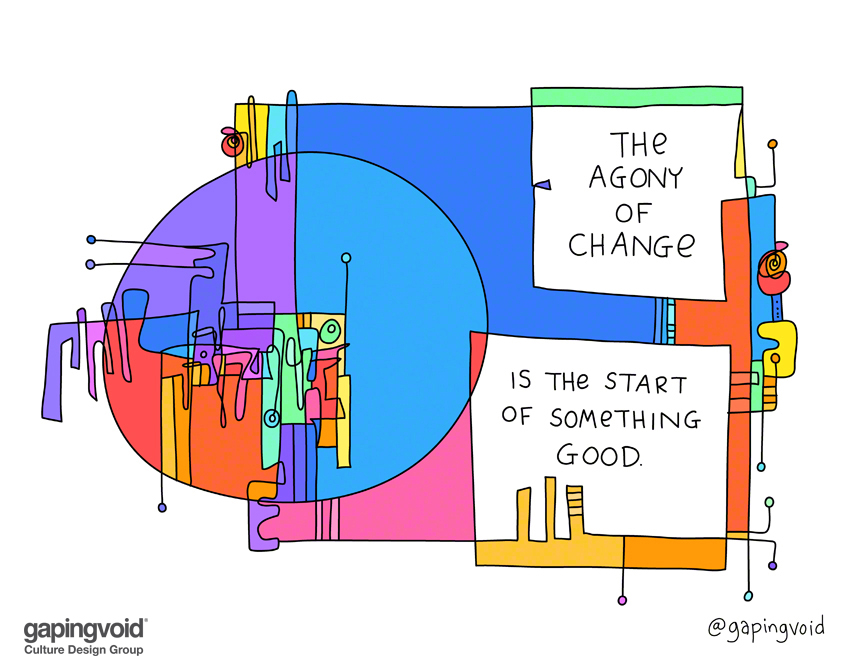
This just in from The Sydney Morning Herald -- a timely story of a company, in Australia, that completely changed their business in just ten days.
Stagekings used to make massive pop-up stages for Miley Cyrus concerts and other big productions. But with the outbreak of Coronavirus and all public gatherings cancelled, they lost 95% of their business. Down? Yes. But not out. Ten days later they transformed themselves into a company that makes stand-up desks and other "isolation furniture". Read about it here.
FOOD FOR THOUGHT: What can you do to change the way you do business these days? How can your product or service adapt to the needs of the time?
"It is not the strongest of the species that survives, nor the most intelligent that survives. It is the one that is most adaptable to change." -- Charles Darwin
Big thanks to Fazeel Arain, Co-Founder of Al Siraat College for the heads up. (PS: Most schools on the planet are also shifting what they do and how they do it. Now's the time, folks. Flex! Adapt! Reinvent!
Idea Champions
Illustration: gapingvoid
Posted by Mitch Ditkoff at 06:09 AM | Comments (0)
February 11, 2020What's Next After Twitter

Ever since Twitter made its appearance on the scene in 2006, millions of people have become enamored with the prospect of delivering a message in 140 characters or less.
Short and sweet has become the name of the game. Brevity rules.
And why not? In a world ruled at least as much by ADD as by maniacal despots, who's got time for anything else?
These days, we don't have time. Time has us.
But according to industry sources, Twitter has become passe. Like the SONY Walkman. Like your father's Oldsmobile. Like the last two sentences of this paragraph.
That's why I've invented TWI -- the next, new super hip, low carbon footprint, social networking platform.
It's quicker. It's faster. And by the end of this post, the company will have already issued an IPO.
140 characters? Please! That's an eternity!
With TWI all you get is 20 characters. That's an 86% improvement in productivity over Twitter. 86%!
If you can't deliver your message in 20 characters, you're obviously a slacker and we don't want your business. Why would we? You'd probably end up calling our customer service bots and wasting their time with your long-winded complaints.
TWI. Think about how much more efficient you will be -- leaving you so much more time to drink coffee and get more things done.
C'mon! What are you waiting for? Time. Is. Passing. Act now!
Idea Champions
Quick way to spark innovation
Even quicker
Posted by Mitch Ditkoff at 05:21 AM | Comments (0)
January 28, 2020What Idea Champions Clients Have to Say About Us
Posted by Mitch Ditkoff at 12:40 PM | Comments (0)
January 07, 2020GUY KAWASAKI on The Top Ten Mistakes of Entrepreneurs
This is absolutely brilliant! Fantastic content, authentic delivery, entertaining, and provocative. If you are an aspiring entrepreneur, this is required viewing. But even if you're not trying to raise venture capital, you can still learn a lot from Guy simply by tuning into the way he makes his pitch. And his Art of the Start is a treasure.
Posted by Mitch Ditkoff at 04:26 PM | Comments (0)
December 11, 2019On Creating an Innovation Mindset

If you want to spark innovation in your organization and are looking for the diamond cutters stroke, consider storytelling. Since 1987, I've tried everything under the sun to help my clients raise the bar for innovation. What I've discovered is that innovation begins in the mind and that unless people are in the right mindset, innovation will never be more than a pipe dream. Storytelling, I've learned, is the simplest, fastest, most memorable way to get people into an innovation mindset. Here's how we do it. And if you only have 90 minutes, this is how we do it. Its also boosts employee engagement.
I wrote the book
The back story
In our clients words
Posted by Mitch Ditkoff at 11:10 AM | Comments (2)
December 02, 2019Sound Advice for Public Speakers
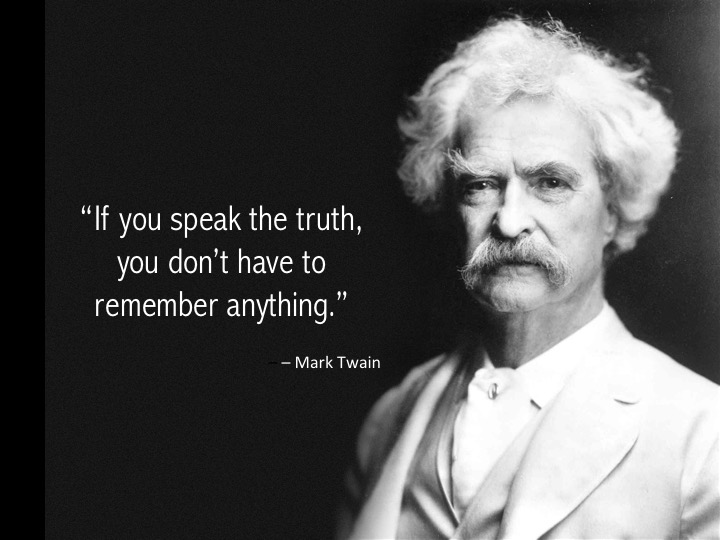
Inspired by Rebecka Forrester
A practical example
10 keys for giving a great keynote
MitchDitkoff.com
Posted by Mitch Ditkoff at 04:13 AM | Comments (0)
November 30, 2019Are You an Idea Addict?

There are lots of things in this world people get addicted to: alcohol, nicotine, heroin, sex, and iPhones, just to name a few. But perhaps the biggest addiction of them all is the addiction to our own ideas. Here's how it works:
We think something up. We feel a buzz. We tweak it, we name it, we pitch it, and POOF, the addiction begins.
At first, like most habits, it's a casual pursuit with a thousand positive side effects: increased energy, renewed focus, and a general feeling of well-being. Like wow, man. But then... we think about it in the shower. We think about it in the car. We think about it when people are asking us to think about other things. We even dream about it.

Soon we want everyone to know about it. We want them to feel the buzz. We want them to nod in agreement. We want them to recognize just how pure our fixation is.
If this is where it ended, it wouldn't be that big of a deal. I wouldn't be calling it an addiction. Maybe I'd be calling it an "inspiration," or a "commitment" or a "visitation from the Muse." But it doesn't end there. It goes on and on and on and on -- often to our own detriment.
If you are launching a new, creative venture, of course, you want to conjure up cool ideas. That's a good thing. But if you cling to ideas just because they're yours, or just because you've invested major time and energy into in them, then it's time to take a good look of what "intoxicating ideas" of yours it might be time to let go. Commitment is one thing. Addiction is quite another.
What hot, new idea of yours might you be just a little bit too addicted to?
Idea Champions
Brainstorm Champions
MitchDitkoff
Posted by Mitch Ditkoff at 08:20 PM | Comments (2)
November 23, 2019ANTHEMS ON THE RISE TAKES OFF
Dominos delivers pizzas (547 million per year). FedEX delivers packages (3 billion per year). And Anthems on the Rise delivers custom songs (one, so far, this year).
One? Just one? Yes. But what a one it is -- One Lit Candle (Song for Greta) -- now featured on WAFA's (Water, Food, Air Awards) website in the Youth Climate Awards category.
Hoffman and Edwards' compelling anthem (with gorgeous vocals by Stephen Rivera) has found, in WAFA, the perfect partner to get its message out to the world. Indeed, both WAFA and Anthems on the Rise are kindred spirits, committed, as they are, to shining a bright light on the very best of what it means to be a conscious, caring, creative human being.
WAFA makes it possible for the environment's silent heroes to have a voice and Anthems on the Rise helps make that voice come alive.
If you are inclined to help WAFA accomplish its ambitious planet-saving goals, click here. If your organization would benefit from having its own inspired anthem, click here.
And if you don't feel like clicking on either of the above links, click here for some memorable quotes on possibility -- something which WAFA and Anthems on the Rise, thank God, are both wide open to.
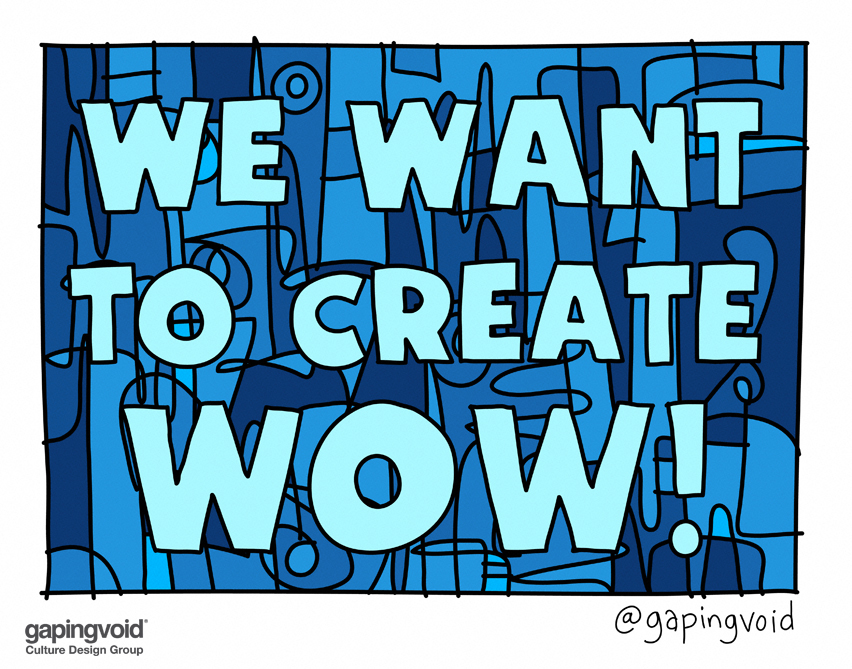
Posted by Mitch Ditkoff at 11:48 PM | Comments (0)
November 22, 2019Why You Need to Ask Why

Some years ago, there was a big problem at one of America's most treasured monuments -- the Jefferson Memorial in Washington, DC. Simply put, birds, in huge numbers, were pooping all over it, which made visiting the place a very unpleasant experience. Attempts to remedy the situation caused even bigger problems, since the harsh cleaning detergents being used were damaging the memorial.
Fortunately, some of the National Parks managers assigned to the case began asking WHY -- as in "Why was the Jefferson Memorial so much more of a target for birds than any of the other memorials?"
A little bit of investigation revealed the following:
The birds were attracted to the Jefferson Memorial because of the abundance of spiders -- a gourmet treat for birds.
The spiders were attracted to the Memorial because of the abundance of midges (insects) that were nesting there.

And the midges were attracted to the Memorial because of the light.
Midges, it turns out, like to procreate in places were the light is just so -- and because the lights were turned on, at the Jefferson Memorial, one hour before dark, it created the kind of mood lighting that midges went crazy for.
So there you have it: The midges were attracted to the light. The spiders were attracted to the midges. The birds were attracted to the spiders. And the National Parks workers, though not necessarily attracted to the bird poop, were attracted to getting paid -- so they spent a lot of their time (and taxpayer money) cleaning the Memorial.
How did the situation resolve? Very simply. After reviewing the curious chain of events that led up to the problem, the decision was made to wait until dark before turning the lights on at the Jefferson Memorial. That one-hour delay was enough to ruin the mood lighting for the midges, who then decided to have midge sex somewhere else.
No midges, no spiders. No spiders, no birds. No birds, no poop. No poop, no need to clean the Jefferson Memorial so often. Case closed.
Now, consider what "solutions" might have been forthcoming if those curious National Parks managers did not stop and ask WHY:
1. Hire more workers to clean the Memorial
2. Ask existing workers to work overtime
3. Experiment with different kinds of cleaning materials
4. Put bird poison all around the memorial
5. Hire hunters to shoot the birds
6. Encase the entire Jefferson Memorial in Plexiglas
7. Move the Memorial to another part of Washington
8. Close the site to the general public
Technically speaking, each of the above "solutions" was a possible approach -- but at great cost, inconvenience, and with questionable results. They were, shall we say, not exactly elegant solutions.
Now, think about YOUR business... YOUR company... YOUR life. What problems are you facing that could be approached differently simply by asking WHY.... and then WHY again... and then WHY again.. until you get to the core of the issue? If you don't, you may just end up solving the wrong problem.
THE FIVE WHYS TECHNIQUE
1. Name a problem you're having
2. Ask WHY it's happening
3. Get an answer
4. Then WHY about that
5. Get an answer
6. Then ask WHY about that -- and so on, five times
Our new, half-day, WHAT'S THE PROBLEM workshop
Idea Champions
Posted by Mitch Ditkoff at 09:41 PM | Comments (2)
October 06, 2019A Real Life Example of the Power of Giving Feedback

Most Fortune 500 companies have some kind of corporate strategy in place for ratcheting up their innovation efforts. Consultants are hired. CEOs give pep talks. And internal initiatives are launched.
To the casual observer, it all looks good, but few of these initiatives ever amount to anything In fact, research indicates that 70 percent of all change initiatives fail.
Why such a low percentage? It depends on who you ask. Senior leaders see it as a workforce issue. The workforce sees it as a senior leader issue. Consultants see it as an issue their company is best suited to resolve. And the occasional in-house astrologer sees it as a Gemini in Pluto issue. Bottom line, nobody really knows.

Here's how I see it: one of the biggest (and least addressed) reasons why most change initiatives fail can be traced back to the cro-magnon way most innovation-seeking people give and receive feedback -- especially when it comes to pitching high concept ideas.
Case in point: Some years ago, Lucent Technologies asked me to facilitate a daylong "Products of the Future" ideation session for 75 of their best and brightest. The pay was good. The challenge was compelling. And I was going to have carte blanche to design the session just the way I wanted.
Or so I thought.
The woman who had contacted me, I quickly found out, reported directly to the CEO. So far, so good. And her concept of the session was spot on -- that the CEO and his Direct Reports (a new rock band?), would make an appearance at the end of the day to listen to five BIG IDEA pitches and then give their feedback, real-time.
Theoretically, this made perfect sense. But theory and reality are two very different things -- kind of like the difference between asking your teenage daughter to clean up her room and her actually doing it.
The harsh reality is this: The vast majority of Senior Leaders are not very skillful when it comes to giving feedback -- especially in response to ideas that challenge the status quo. "Feedback," for them, has become code for "With all due respect, let me tell you why your idea sucks".
As a facilitator of high profile brainstorming sessions, I cannot, in good faith, allow this all-too-predictable dynamic to play itself out. Not only will potentially profound ideas be prematurely dismissed, the hard-working, brilliant people who have spent all day generating and developing these ideas will become royally pissed, disempowered, humiliated, passive/aggressive, and depressed. The result? Very few of them will want to participate in future sessions.
So I told the consultant-seeking woman from Lucent that I, in service to the outcomes she was about to hire me to ensure, needed to meet with her CEO so I could teach him and his team how to give effective, humane feedback to a roomful of 75 future product generating optic fiber geniuses.
 "Impossible!" was her response. "Our CEO is very busy man -- and besides... he doesn't like consultants."
"Impossible!" was her response. "Our CEO is very busy man -- and besides... he doesn't like consultants."
"Got it," I said, quickly assessing my options. "And thank you, so much, for your kind invitation to facilitate the session, but I must respectfully decline" -- and, with that, I began packing up my briefcase.
This, shall we say, caught her slightly off guard. "I... don't understand where you are going with this," she replied.
"Look," I said. "If you want to get meaninful results from an all-day brainstorming session, especially if you are flying people in from who knows where, we've got to be absolutely sure that the feedback at the end of the day is done well. I am not going to walk 75 of your best and brightest people off the plank."
I could tell that my unexpected feedback was registering. "OK, OK...but the best I can do is get you five minutes with him during the coffee break just before the report outs".
"Great," I said. "I'll take it."
Fast forward two months.
From 8:30 am -- 3:00 pm, 75 of Lucent's most brilliant technologists conjured up products that made my head spin. The room was abuzz with glorious possibilities. The sense of accomplishment was palpable. At 2:45 they selected five of their best ideas and summarized them on flipcharts. At 3:00, it was time for coffee and sugar, me craning my head for the CEO and his merry band of direct reports.
I envisioned him to be a tall man, silver-haired, with a large Rolex and a steely look in his eyes -- someone who might be good friends with the Governor and eventually have his portrait hanging in the lobby at headquarters. He was, much to my surprise about 5'6", wearing a Mickey Mouse t-shirt, loafers, and no socks. My kind of guy.
"Rich," I began, extending my hand. "Welcome, Mitch Ditkoff here from Idea Champions, facilitator of today's extraordinary ideation session, "how would you like to learn a simple technique in the next five minutes that will not only take all the dread out of giving feedback, but spark some seriously powerful idea development on the spot?"
He looked at me as if I'd just given him the holy grail. "You're on!"
"Great. Here's how it works," I began. "When an idea is pitched, first say what you LIKE about it -- the upside, what's promising. After a few genuine likes, then express your CONCERNS -- the stuff you probably wanted to say in the first place. But for each concern you express, it will be your responsibility to follow it with a SUGGESTION, a way that would resolve your concern and keep the idea alive Got it?"
"Got it."
"Oh... one more thing, Rich. If you forget to use the method, do I have your permission to remind you?"
"Absolutely".
The senior team took their place on stage, sitting behind a table, draped in black, that reminded me of the Nuremberg Trials. The 75 brilliant brainstormers took their seats at round tables -- everyone attentively listening to me describe the feedback process that was just about to unfold.

The first BIG IDEA pitch was excellent -- a compelling idea for a telecommunications platform of the future that was utterly mind blowing. The audience applauded, I acknowledged the presenter, and then gave the floor to the CEO, reminding him to use the feedback technique I'd taught him just a few minutes ago -- which he proceeded to do for, oh, maybe 30 seconds or so.
After that? It was Apocalyse Now meets The Godfather, with a little Don Rickles in Vegas thrown in for good measure, a scene I'd witnessed countless times before in corporate America -- the kneejerk, reptilian-brained, go-for-the-jugular tendency most senior executives have to focus on what's wrong with a new idea before what's right.
Speaking into the mic in my best baritone imitation of the Wizard of Oz, I quickly intervened.
"Oh Mr. CEO of a very large and profitable telecommunications company. Remember the LCS technique! First your LIKES, then your CONCERNS, then your SUGGESTIONS."
In an optic fiber nanosecond, he sheepishly smiled, thanked me for the reminder, and returned to the technique.
The rest of the session went off without a hitch. Five powerful ideas got pitched. Seven of Lucent's top executives weighed in with insight, honesty, and graciousness. And 75 aspiring innovators experienced something they had probably never experienced before -- that it was possible to spend all day brainstorming "out there" possibilities and get the kind of feedback from senior leadership that was honorable, empowering, easy-to-listen to, and immediately helpful.
SO WHAT? Ever hear the phrase "ideas are a dime a dozen." Of course you have. It's one of the classic truisms we were all brought up to believe. That old saw, however, is less about ideas being inconsequential, than it is about people not knowing how to elicit their value. Granted, not every idea is worth developing, but far too many good ones are lost along the way because the person to whom the idea is pitched is blinded by their own knee jerk reactions.
The literature is filled with examples of great ideas whose value was not immediately recognized. The steam engine. The MacIntosh. FedEx. And the Post-It Note just to name a few. All of them were pitched to the "powers-that-be" and all were victims of knee jerk, naysaying, idea killing behavior. Yes, it's true, many senior leaders beat the drums for "out of the box thinking". But when push comes to shove, as it often does, their drumming is more like fingernails on the edge of an office desk than a conga player with fire in his eyes. So let's give our senior leaders what they need to make the shift from theory to practice -- and that is a simple method for them to respond to new and untested ideas in a way that increases the odds of innovation actually happening.
NOW WHAT? Think about your style of responding to new ideas. Do you listen? Do you pause long enough to see the seed of innovation? Do you give meaningful feedback in a humane way? And what about your organization? Do people know how to give and receive feedback? Do they take the time? Does the process increase the odds of innovation becoming a reality? If not, what can you about it this week to turn things around?
Posted by Mitch Ditkoff at 06:46 PM | Comments (0)
October 02, 2019The Five Regrets of the Dying

Bronnie Ware is an Australian nurse who spent several years working in palliative care, caring for patients in the last 12 weeks of their lives.
She recorded their dying epiphanies in a blog called Inspiration and Chai, which gathered so much attention that she put her observations into a book called The Top Five Regrets of the Dying.
Ware writes of the phenomenal clarity of vision that people gain at the end of their lives, and how we might learn from their wisdom.
"When questioned about any regrets they had or anything they would do differently," she says, "common themes surfaced again and again."
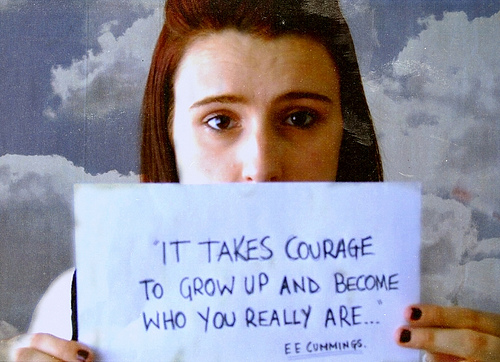
THE FIVE REGRETS OF THE DYING
1. I wish I'd had the courage to live a life true to myself, not the life others expected of me.
"This was the most common regret of all. When people realize that their life is almost over and look back clearly on it, it is easy to see how many dreams have gone unfulfilled. Most people had not honored even a half of their dreams and had to die knowing that it was due to choices they had made, or not made. Health brings a freedom very few realize, until they no longer have it."
2. I wish I hadn't worked so hard.
"This came from every male patient that I nursed. They missed their children's youth and their partner's companionship. Women also spoke of this regret, but as most were from an older generation, many of the female patients had not been breadwinners. All of the men I nursed deeply regretted spending so much of their lives on the treadmill of a work existence."
3. I wish I'd had the courage to express my feelings.
"Many people suppressed their feelings in order to keep peace with others. As a result, they settled for a mediocre existence and never became who they were truly capable of becoming. Many developed illnesses relating to the bitterness and resentment they carried as a result."
4. I wish I had stayed in touch with my friends.
"Often they would not truly realize the full benefits of old friends until their dying weeks and it was not always possible to track them down. Many had become so caught up in their own lives that they had let golden friendships slip by over the years. There were many deep regrets about not giving friendships the time and effort that they deserved. Everyone misses their friends when they are dying."
5. I wish that I had let myself be happier.
"This is a surprisingly common one. Many did not realize until the end that happiness is a choice. They had stayed stuck in old patterns and habits. The so-called 'comfort' of familiarity overflowed into their emotions, as well as their physical lives. Fear of change had them pretending to others, and to their selves, that they were content, when deep within, they longed to laugh properly and have silliness in their life again."
Do you have a story to tell before you die?
Why did I write my book?
Inspiring links on the power of storytelling
Posted by Mitch Ditkoff at 11:47 PM | Comments (0)
September 13, 2019What I Learned from Being Heckled at a Corporate Keynote Presentation
Every person who has ever had a job has experienced at least one "moment of truth" in their life -- a time when all the chips were on the table and the decision of whether to go "all in" or not had to be made.
One such moment happened to me a few years ago when I was facilitating a creative thinking session for 110 of Lucent Technology's "best and brightest" -- a room full of brilliant computer scientists with more PhDs than most politicians have excuses.

There I was, on stage, introducing the day with a slide show of quotes from legendary innovators, when a man in the 10th row stands up and screams, "You are totally wrong! I used to work with that guy and he never would have said anything like that! If you can't get your quotes right, why should I believe anything you're about to tell us?"
If this was the Wild West, I had just been challenged to a duel at High Noon, armed only with a remote and a blueberry muffin.
Standing as I was in the epicenter of the optic fiber universe, I had only a nanosecond to assess the situation. There was no time for a strategic plan, no time for deliberation, no time to call my coach. This was Defcon 1, me face-to-face with one very angry man.
"Well..." I began (stalling for as much time as a single word would allow), "it is possible that you're right. The slides I'm showing today were just finalized yesterday and my assistant may have made an incorrect attribution. I will check with her when I get back to the office. That being said, I invite you to focus on the good stuff that's here for you today, not the possible flaws."
Logical? Yes. Effective? No. My comments only made him angrier, his face growing redder by the moment.
I now had a choice to make -- whether to further engage my corporate heckler in a heroic attempt to win him over or continue with the reason why I'd been hired in the first place -- to help seriously left-brained scientists tap into their lesser-used right brain.

Choosing the latter, I proceeded to teach a powerful mind-opening technique based on the thinking styles of Albert Einstein and Garry Kasparov (a former Soviet Union Grand Chess Master).
Technique taught, I walked to the side of the stage and observed.
For the next five minutes, everything went smoothly. Everyone in the audience was focused and doing the work.
Then, without warning, Mr. You-Got-Your-Slides-All-Wrong stood up and, with great velocity, began approaching the stage. On a scale of 1-10, with "1" being walking and "10" being storming, he was a 9.8.
The faster he walked, the quieter the room got as I took my stance and readied myself for whatever was next.
Two feet from me, my fast approaching inquisitor stopped dead in his tracks, looked at me fiercely, eyes on fire, and exclaimed, "This is amazing!"
"What is amazing?" I replied.
"The technique you taught," he said. "I just had an incredible breakthrough about a problem I've been struggling with for years."
Happy for him and greatly relieved, I asked if he'd like to share his breakthrough with the group -- a task that would require the two of us to change roles for a few minutes, him taking center stage as teacher, me taking his seat, as student.
Which is exactly what we did.
The man was on a roll, inspired, lucid, and highly expressive. I couldn't have asked for a better spokesperson to convey the message I was trying to communicate that day -- a message about the innate ability all people have to go beyond their limiting assumptions and tap into a realm where breakthrough insights abide.
The dramatic and very visible shift my "heckler" had made from left-brained naysayer to right-brained savant was the embodiment of a teaching I couldn't have scripted in a hundred years. This had never been about me putting this man in his place or him putting me in mine. It was about changing places and seeing the world and ourselves through new eyes.
FOOD FOR THOUGHT

None of us know when the moment of truth will come. None of us know what it will look like and how we will respond.
But we do know this: If we are awake and engaged in our work, it will come. There is no escape. The more we are already "all in", the easier it will be for us to respond to whatever comes our way. The more we are able to flex to the moment and make wise choices that serve the greater good, the more powerful the outcomes will be.
My moment of confrontation, at Lucent, did not allow me the luxury of deep deliberation. I had to trust myself, be in the moment, and go with the flow. But even more than that, I had to be willing to reframe what seemed to be a problem into an opportunity. I had to make lemonade out of lemons, on the spot, and not squirt anything in the eyes of the people I was there to serve.
My task was not to find fault with the fault finder (an easy thing to do), but to transform the moment into deeper understanding.
On the front lines of business, it is extremely easy to find fault in others. Even on a good day, most of us are woefully imperfect -- filled with a lifetime's worth of quirks, projections, fears, habits, and routines -- the kind of stuff that bugs even our closest friends. Throw in the X factor of stress, heavy workloads, and constantly changing priorities and you have a formula for... well... major heckling.
Your mission, should you choose to accept this assignment, is not to take it personally.
The person who is heckling you (at work, on the street, or in your home) is most likely having a bad day, week, month, quarter, year, or life. If Jesus, himself, was to make a sudden appearance, your heckler would probably find fault with his hair, clothes, or accent.
If you react with the same negativity that is coming your way, all you'll end up doing is throwing fuel on the fire. If you hate being judged, but then judge the judgers for judging, you will only end up in a fun house hall of mirrors with no exit.
Make sense?
PS: At lunch, after the high drama Lucent session, my client informed me of three things: 1) The man who heckled me does the same thing to every outside speaker no matter how much coaching he's received; 2) The exchange between the heckler and me was the perfect embodiment of one of Lucent's core values at the time -- allowing creative dissonance -- a value they had been trying, unsuccessfully, to embed it their culture for years and; 3) As a result of the positive impact my session had, Lucent was going to license my company's creative thinking training. Lemons hadn't just turned into lemonade, they turned into some major cash flow, too.
FOR YOUR CONSIDERATION: Think of a moment of truth you've had in the past year -- a surprise encounter that demanded an intuitive, in-the-moment response from you. What was that like for you? What did you do? What did you learn from the experience? And if, perchance, you did not respond in a way that worked, what might you do differently next time?
The story above is excerpted this book
It is NOT excerpted from this book
Posted by Mitch Ditkoff at 09:39 PM | Comments (0)
September 09, 2019The Perfect Want Ad
Simon Sinek cuts to the chase. This is all you really need to know if you are trying to attract the right people to your team, project, or organization. And notice how he used the Earnest Shackleton story to make his point. Telling the right story is a very powerful way to deliver a message that sticks.
Big thanks to Fazeel Arain for the heads up!
Idea Champions
Posted by Mitch Ditkoff at 03:02 AM | Comments (0)
August 26, 201921 Reasons Why You Like to Do Your Creative Work in Cafes

Ever since I was old enough to realize there would never be a want ad in a newspaper that described a job I wanted, I've loved working in cafes. I never really thought much about it until a few days ago when a baffled friend of mine asked why I was so into it.
His assumption? That working in a cafe would be a distraction. A distraction? Dude, quite the opposite. I do some of my best work in cafes.
And so, at the risk of trotting out a few half-baked conclusions that my non-cafe-going critics will have a field day trashing, here goes:
21 REASONS WHY YOU LIKE TO WORK IN A CAFE
1. It doesn't feel like work.
2. It's a nice break from the office.
3. You don't have an office.
4. Easy access to caffeine.

5. If you have a home office, you appreciate the fact that -- in a cafe -- there are no interruptions from your wife/husband/kids/roommate who rarely think they are interrupting when they stick their head in the your office and begin the conversation with something like "I'm not interrupting you, am I?"
6. The act of going from your office to a cafe gets the creative juices flowing.
7. Muffins.
8. You get a whole bunch of unexpected inputs that change your perspective for the moment (i.e. snatches of conversation, songs on the radio, odd posters on the wall).
9. There are no distracting tasks to default to (i.e. cleaning your desk, filing, tossing paper clips over the cubicle wall).
10. The people in your office want you to talk in hushed tones and have a need for you to appear busier than you really are.
11. Being waited on by the cafe staff puts you in the mode of "things coming to you" without much effort.
12. You focus on your most creative projects.
13. It feels good being part of a community -- even if the community disbands after your third cappuccino.
14. Old patterns are interrupted. New patterns emerge.
15. You like the authenticity of your responses when the geek at the next table, peeking up from his Mac, asks what you're working on.
16. It's like having a focus group at your beck and call. You can ask anyone for their opinion and they'll give it, no strings attached.
17. If you work at home, it's just a matter of time before your spouse asks you to move a piece of furniture or clean the bathroom.
18. It brings out the artist and poet in you.
19. If you go back to the same cafe again and again, you develop trusting relationships with some of the other regulars -- sharing enthusiasm, feedback, and croissants.
20. The sounds in a cafe become a kind of "white noise" that make it easier to concentrate than when you are working alone at home or in your office. Your "self-talk" gets drowned out by the ambient noise.
21. If anything breaks, someone else has to fix it.
I rest my case
I wrote some of this book in a cafe
Idea Champions
Posted by Mitch Ditkoff at 11:33 PM | Comments (5)
June 29, 2019STEVEN COVEY on Listening
Posted by Mitch Ditkoff at 01:21 PM | Comments (0)
June 07, 201930 Ways to Know If You Have What It Really Takes to Innovate
Do you have what it takes to innovate? I'm not talking IQ, degree, or job title.
I'm talking the curious confluence of behaviors that come with the territory of being someone who turns top of the line ideas into bottom line realities.
1. You come up with great ideas in the shower and car
2. You like to stay up late... or get up early... or both
3. You're comfortable with ambiguity and chaos
4. While your ducks are rarely in a row, they're happy most of the time
5. You're not worried about failing
6. You've invited at least one friend into your personal think tank
7. You test out your ideas on just about anyone who will listen
8. You know what you don't know, but can't always explain it
9. You like making connections between things that don't go together.
10. You're open to feedback and also don't care what anybody thinks
11. Some of your friends think you're out of your mind
12. You find yourself laughing in the middle of the day for no reason
13. People get inspired around you
14. You've been known to wear two different socks
15. You feel like you're on the brink of a breakthrough a lot of the time
16. Sometimes you figure things out by talking, not thinking
17. You write notes in the margins of books
18. You like to conduct little experiments
19. You have a game plan, but it keeps changing
20. You love to immerse

21. You find ways to "work in the cracks" even when your day job dominates
21. You wish there were more hours in the day
22. Your passion to make a difference exceeds your doubt
23. You find yourself getting clues about your project in odd places
24. You feel like you're having a spiritual experience
25. You are far more organized than anyone thinks
26. You know you need a collaborator, but are picky about who
27. You have a bold vision of what success looks like
28. Your project has little to do with what your college major was
29. You're looking for someone to head up marketing and sales
30. You can think of another ten items that should be on this list
Illustration
Idea Champions
If you need a jolt
Our workshops and trainings
Posted by Mitch Ditkoff at 03:58 PM | Comments (4)
May 02, 2019The Case for Doing Nothing

Fabulous article in the NY Times about the power and glory of doing nothing. Hooray! Thanks to Booth Dyess for the heads up.
Idea Champions (yes, we do too much)
Mitch Ditkoff (also does too much)
Posted by Mitch Ditkoff at 09:35 AM | Comments (0)
April 29, 2019PAY WHAT YOU CAN: An Innovative Pricing Model
EXISTENTIAL QUESTION #1: How much is anything worth?
EXISTENTIAL ANSWER #1: What people are willing to pay for it.
Which is precisely why Idea Champions has recently launched it's Pay What You Can pricing model for our Micro-Learning for Innovators service -- a year long, online curriculum of innovation-sparking videos, articles, tools, and techniques. It's our, out-of-the-box experiment. And so far, it's working.
The model is super simple. If your company wants to raise the bar for innovation, but is budget-constrained, YOU decide on the value of our Micro-Learning service and pay that amount. While I reserve the right to say NO to your offer, 98% of the time I will say YES.
Intrigued? Want more info? Contact info@ideachampions.com with the words "Micro-Learning for Innovators" in the subject line.
NOTE: For now, we are only offering this service to organizations. In time, we will offer this service to individuals. Stay tuned.
A Micro-Learning testimonial from a happy client
Other testimonials
Pay what you want restaurants
Panera Cares (their "pay what you can" experiment failed)
TED TALK: Panera Cares (pay what you can experiment)
The creator of Micro-Learning for Innovators
Posted by Mitch Ditkoff at 09:59 AM | Comments (0)
April 22, 201915 Common Missteps Entrepreneurs Make

A good articles from Forbes -- practical advice for aspiring entrepreneurs.
Illustration: Gapingvoid
Idea Champions
Posted by Mitch Ditkoff at 11:23 AM | Comments (0)
March 16, 2019The Good Thing About Bad Ideas
One of the inevitable things you will hear at a brainstorming session is "there are no bad ideas." Not true. There are plenty of bad ideas. Nazism, for instance. Arena football. Bow ties.
What well-meaning "keep hope alive" brainstorming lovers really mean is this: Even bad ideas can lead to good ideas if the idea originators are committed enough to extract the meaning from the "bad".
Do you think that War and Peace was written in one sitting? No way. There were plenty of earlier drafts that were horrid, but eventually led to the final outcome.
The key? Finding the value in what seems to be a "bad idea" and then using that extracted value as a clue or catalyst for further exploration. The following technique, excerpted from Awake at the Wheel, shows you how...
HOW IT WORKS:

1. Identify a challenge worth brainstorming.
2. Conjure up a bad idea in response to it.
3. Tell someone about your bad idea.
4. Ask the other person to express something redeemable about your bad idea -- an aspect of it that has merit.
5. Using this redeemable essence as a clue, brainstorm some new possibilities
Idea Champions
Brainstorm Champions
Brainstorm now, online!
Posted by Mitch Ditkoff at 06:59 AM | Comments (0)
February 17, 2019Innovation as a Happy Accident

A little known fact about innovation is that many breakthroughs have not been the result of genius, but "happy accidents" -- those surprise moments when an answer revealed itself for no particular reason.
The discovery of penicillin, for example, was the result of Alexander Fleming noting the formation of mold on the side of petri dish left uncleaned overnight.
Vulcanized Rubber was discovered in 1839 when Charles Goodyear accidentally dropped a lump of the polymer substance he was experimenting with onto his wife's cook stove.
More recently, 3M's post-it was also the result of an accident in the lab. Breakthroughs aren't always about invention, but the intervention required, by the aspiring innovator, to notice something new, unexpected, and intriguing.
LEARN FROM YOUR HAPPY ACCIDENTS:

1. Think about a recent project, pilot, or business of yours that did not turn out the way you expected.
2. Ask yourself if any of the unexpected results offer you a clue or insight about how you might proceed differently.
3. Instead of interpreting your results as "failure," consider the fact that the results are simply nature's way of getting you to see something new -- something that merits further exploration.
Excerpted from Awake at the Wheel
Idea Champions
MitchDitkoff.com
Posted by Mitch Ditkoff at 02:59 PM | Comments (3)
January 23, 2019The Samurai Guide To Managing Difficult Clients (& having a life)

You are smart. You are creative. You are committed. And you have an awesome grasp of social media. Of course you do, you are a mover and a shaker in a company trying to stay relevant, make some magic, and diffentiate itself from the competition. You are also going slightly insane.
Why? Because your clients routinely make insane demands on you, expecting miracles with very little notice. Part of you actually enjoys this phenomenon, given your fascination for big challenges and the ever-present potential to become heroic. Another part of you does not enjoy this phenomenon, often feeling like the deck is stacked against you. And guess what? It is -- not just because your client --internal or external, older, higher paid, or more experienced -- is constantly disregarding the fact that you have a life outside the workplace, but because this kind of client-driven behavior, unfortunately, has become the norm these days.

Is there as way out of this madness? Yes there is. And it has everything to do with how you manage your clients. True, there is no formula or algorithm for how to do this, but it can be done. Yes, it can -- all modulated through your own particular style and your client's personality.
For starters, here are ten simple guidelines. Pick one and begin.
TEN SIMPLE WAYS TO BETTER MANAGE YOUR CLIENTS
1. Help your client translate their over-the-top request into a question that begins with the words "How can we?" The effort to frame a pressing challenge in the form of a "How can we?" question will open up the conversation, reveal hidden challenges for the two of you consider, and cut to the chase in an elegant, time-efficient way.
2. Get your client to describe their vision of success. The clearer your clients are about what their "hoped for outcomes" are, the more you will understand what's really required to get results.
3. Establish clear agreements and protocols at the beginning of the relationship. Let your clients know what you can do and what you can't do -- what you will do and what you won't. There will likely be a little voice in your head wondering if this will "fly" with the client. Relax. It will. In fact your client will respect you more for clarifying your boundaries.
4. When asked for a super-quick turnaround of a project, let your client know what you are able to deliver and what you are not able to deliver in the time frame requested. Let he/she know what the trade-offs are. Once your client becomes knowledgeable about the downsides of such a quick turnaround, he/she will be more likely to extend the deadline.
5. Speak the truth. If you know a particular request is impossible to fulfill in the time allotted, say so -- and offer an alternative fall back date. Even an extra day or two on a project can make all the difference in the world.
6. Be sure to ask "by when" your client needs the deliverable. Poke at the so-called deadline. Often, a client's request "by yesterday" means "a week from now," or "by Thursday", not "tomorrow." Don't assume your client's anxiety or lack of planning means you have to work all weekend.
7. Ask your client for the names and contact numbers of key people on their team (or in their company) -- resources you can contact on a moment's notice, especially when your client is unavailable.

8. Practice "reflective listening" -- sometimes known as "checking for understanding." This is simple to do. For example, if your client makes a request of you at 4:59 pm on Friday (or any time, for that matter), restate your understanding of the request, i.e. "If I understand you correctly, you are asking my team and I to launch a new viral video for your company no later than tomorrow morning -- one that will get 10 million views by Monday. Is that accurate?" If it is (and you agree), at least you know what your mission is. If it's not (or gives your client pause), the two of you will be able to make some last-minute adjustments to your marching orders.
9. Realize that pushing back and saying "no" is not the same thing as being "negative." Your goal is to create a collaborative relationship, not an abusive one. You want to be a partner, not a slave -- a consultant/advisor, not a whipping boy or girl.
10. Feel free to give your clients feedback, not just head nods. Unfortunately, very few people know how to give feedback in a meaningful, effective, non-threatening way. And so they say nothing. Not a good idea. One feedback format you might consider using is called LCS. It takes only a few minutes, sometimes less. Here's how it works.
Idea Champions
When you need big ideas and are super-time crunched
What our clients say about us
Posted by Mitch Ditkoff at 08:58 AM | Comments (0)
January 16, 2019When You Love What You Do
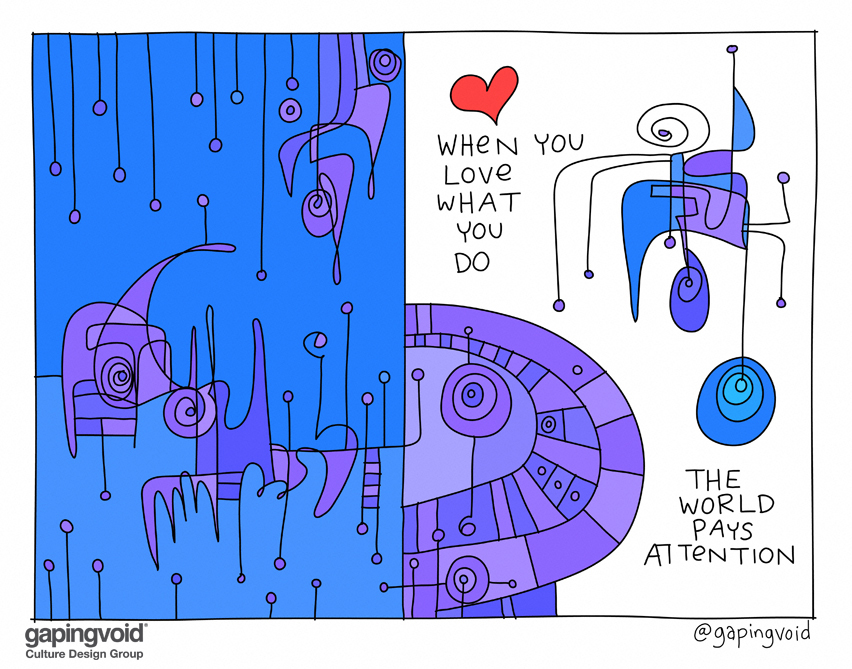
We love what we do -- helping forward-thinking organizations go beyond the status quo and tap into the collective genius of their workforce. Here's one way we do it. And here are some others.
What our clients say
Illustration: gapingvoid
Posted by Mitch Ditkoff at 09:26 AM | Comments (0)
December 21, 2018The Martial Arts of the Mind
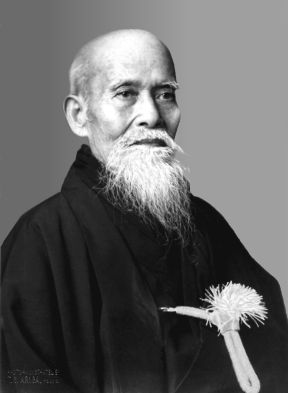
Ten years ago I was invited to teach a course on "Innovation and Business Growth" at GE's Crotonville Management Development Center for 75 high potential, business superstars of the future.
The GE executive who hired me was a very savvy guy with the unenviable task of orienting new adjunct faculty members to GE's high standards and often harsher reality.
My client's intelligence was exceeded only by his candor as he proceeded to tell me, in no uncertain terms, that GE gave "new instructors" two shots at making the grade -- explaining, with a wry smile, that most outside consultants were intimidated the first time they taught at GE and weren't necessarily at the top of their game.
I'm not sure how you say it in Esperanto, but in English what he said translates as "The heat is on, big time."
I knew I would have to raise my game if I expected to be invited back after my two-session audition was over.
And so I went about my business of getting ready, keeping in mind that I was going to be leading a 6-hour session for 75 of GE's "best and brightest" flown half way around the world -- high flying Type A personalities with a high regard for themselves and a very low threshold for anything they judged to be unworthy of their time.
I had five weeks to prepare, five weeks to get my act together, five weeks to dig in and front load my agenda with everything I needed to wow my audience: case studies, statistics, quotes, factoids, and more best practices than you could shake an iPhone at.
I was ready. Really ready. Like a rookie center fielder on designer steroids, I was ready.
Or so I thought.
The more I spoke, the less they listened. The less they listened, the more I spoke, trotting out "compelling" facts and truckloads of information to make my case as they blankly stared and checked their email under the table.
Psychologists, I believe, would characterize my approach as "compensatory behavior."
I talked faster. I talked louder. I worked harder -- attempting in various pitiful ways to pull imaginary rabbits out of imaginary hats.
Needless to say, GE's best and brightest -- for the entire 45 minutes of my opening act -- were not impressed.
Clearly, I was playing a losing game.
My attempt to out-GE the GE people was a no-win proposition. I didn't need new facts, new statistics, or new quotes. I needed a new approach -- a way to secure the attention of my audience and help them make the shift from left-brained skepticism to right-brained receptivity.
And I needed to do it five minutes, not 45.
The next few days were very uncomfortable for me, replaying in my head -- again and again -- my lame choice of an opening gambit and wondering what, in the world, I could do to get better results in much less time.
And then, like an unexpected IPO from Mars, it hit me. The martial arts!

As a student of Aikido, I knew how amazing the martial arts were and what a great metaphor they were for life.
Fast forward a few weeks...
My second session, at Crotonville, began exactly like the first -- with the Program Director reading my bio to the group in an heroic attempt to impress everyone. They weren't.
Taking my cue, I walked to center stage, scanned the audience and uttered nine words.
"Raise your hand if you're a bold risk taker."
Not a single hand went up. Not one.
I stood my ground and surveyed the room.
"Really?" I said. "You are GE's best and brightest and not one of you is a bold risk taker? I find that hard to believe."
Ten rows back, a hand went up. Slowly. Halfway. Like a kid in a high school math class, not wanting to offend the teacher.
"Great!" I bellowed, pointing to the semi-bold risk taker. "Stand up and join me in the front of the room!"
You could cut the air with a knife.
I welcomed my assistant to the stage and asked him if had any insurance -- explaining that I had called him forth to attack me from behind and was going to demonstrate a martial arts move shown to me by my first aikido instructor, a 110-pound woman who I once saw throw a 220-pound man through a wall.
Pin drop silence.
I asked our bold risk taker to stand behind me and grab both of my wrists and instructed him to hold on tight as I attempted to get away -- an effort that yielded no results.
I casually mentioned how the scenario being played out on stage is what a typical work day has become for most of us -- lots of tension, resistance, and struggle.
With the audience completely focused on the moment, I noted a few simple principles of Aikido -- and how anyone, with the right application of energy and the right amount of practice, could change the game.
As I demonstrated the move, my "attacker" was quickly neutralized and I was no longer victim, but in total control.
In three minutes, things had shifted. Not only for me and my attacker, but for everyone in the room.
That's when I mentioned that force was not the same thing as power -- and that martial artists know how to get maximum results with a minimum of effort -- and that, indeed, INNOVATION was all about the "martial arts of the mind" -- a way to get extraordinary results in an elegant way.
PS: I was invited back 26 times to deliver the course.
THE COMMENTARY
Every day, no matter what our profession, education, or astrological sign, we are all faced with the same challenge -- how to effectively communicate our message to others.
This challenge is particularly difficult these days, given the glut of information we all must contend with. The amount of information available to us is doubling every ten years! Yearly, more than one million books are published. Daily, we are bombarded with more 6,000 advertising messages and 150 emails. As a result, most of us find ourselves in a defensive posture, protecting ourselves from the onslaught of input.

What I've discovered in the past 25 years of working with some of the world's most powerful organizations is that if I really want to have get my message across, I've got to deliver it in a what that gets past the "guardians at the gate" -- the default condition of doubt, disengagement, and derision that comes with the territory of life in the 21st century business world.
My rite of passage at GE was a microcosm of this phenomenon.
Indeed, my presumptive effort to "win over my audience" by impressing them with data, case studies, and best practices was a losing game. Not only was I barking up the wrong tree, I was in the wrong forest.
The key to my breaking through the collective skepticism of GE's best and brightest wasn't a matter of information. It was a matter transformation.
They didn't need to analyze, they needed to engage -- and it was my job to make that easy to do. Or, as Mahatma Gandhi so deftly put it, I had to "be the change I wanted to see in the world."
I had to do something that invoked the curious, playful, and associative right brain, not the logical, linear, analytical left brain -- tricky business, indeed, especially when you consider that most business people, these days, have a very low threshold for anything they judge to be impractical
Which is why I chose the martial arts as the operational metaphor at GE, my attempt to move them from the Dow to the Tao.
Impractical? Not at all.
Bottom line, whether we know it or not, we have all entered the "experience economy" -- a time when being involved is at least as important as being informed.
Information is no longer sufficient to spark change. Data is no longer king. Thinking only takes us part of the way home. It's feeling that completes the journey -- the kind of feeling that leads to full on curiosity and the kind of engagement that opens the door to exciting new possibilities.
Which is exactly what happened at GE when I made the shift from marshaling my facts, to marshaling my energy -- and by extension, the energy of 75 of GE's best and brightest.
FOOD FOR THOUGHT: What message have you been trying to deliver (with too little impact) that might be communicated in a totally different way -- a way that more successfully engages people and leads to measurable results?
Excerpted from Storytelling at Work
Idea Champions
Applied Innovation
My Keynotes
It All Began With Balls
Big Blues from the Viagra People
Posted by Mitch Ditkoff at 10:58 PM | Comments (3)
December 12, 2018Allow More Time to Be Creative!
It doesn't get any simpler than this, folks! You want to be more creative? You want to create the conditions that allow other people you work with to be more creative? Stop rushing them! Go beyond the nanosecond! Allow more time!
Carl Jung chimes in
Idea Champions
Allow more time for storytelling!
Play time at AT&T
Posted by Mitch Ditkoff at 06:07 PM | Comments (0)
December 06, 2018Give the Gift of Creativity, Collaboration, and Storytelling

As you enter into the holiday season, perhaps you are wondering what to give your boss, direct reports, teammates, co-workers, clients, customers, or mother-in-law. Look no further! Especially if you are looking for a way to shop online. Idea Champions' online store is now open for business -- offering a variety of mind-opening books, card decks, and innovation-sparking tools. Prices range from $9.95 -- $129.
Idea Champions
Our clients
Photo: Anderson W Rangel
Posted by Mitch Ditkoff at 01:00 PM | Comments (0)
November 19, 2018Testimonial from the Founder of Al Siraat College in Melbourne

"I had a strong desire to introduce a culture of creativity and innovation to our humble school in Australia. Being cash strapped as a new school (and knowing consultants were not cheap), I started following Mitch Ditkoff's blog, The Heart of Innovation.
After many years of reading his posts, I finally found an opportunity to invite Mitch to Al Siraat for a short visit to explore the possibilities of what our collaboration might look like. During that visit, Mitch opened my eyes to the fact that anything was possible. We then embarked on a wonderful, four-year journey of culture change, learning, innovation, transformation, and friendship.
The more we worked together, the more I realized that changing the culture of a school is not an easy task. There is no quick path. Culture change requires a long-term commitment and a large amount of visioning, planning, team development, role clarity, creative thinking, clear communication, community building, intrinsic motivation, risk taking, empowerment, perseverance, humor, and just the right touch.
Mitch has greatly assisted Al Siraat in our culture change ambitions which continue to be ongoing. I am very thankful for Mitch's coaching, guidance, inspiration, and support -- helping me and the entire staff of Al Siraat take this much-needed journey, which has only just begun."





100 educational innovations from around the world
Idea Champions
Storytelling for the Revolution
Posted by Mitch Ditkoff at 07:10 PM | Comments (1)
November 11, 2018Immersive Experiences in Education
Posted by Mitch Ditkoff at 10:30 PM | Comments (0)
Babies Teaching Kindness and Empathy in SchoolsPosted by Mitch Ditkoff at 10:11 PM | Comments (0)
Teach the Teacher!Posted by Mitch Ditkoff at 09:51 PM | Comments (0)
100 Inspiring, Global Innovations in the Field of Education, K-12Click here to read about 100 innovations that are changing the face of K-12 education around the world.
This year's list provide an opportunity to learn about the most innovative, impactful, and scalable examples of forward-thinking educational practices from around the world. It shows how the future of education is heading towards a more holistic, facilitator-based model, one that focuses on well-being, social skills, and gender equity. If you are an educator, parent, student, or simply interested in the future progress of our planet, this post is for you.
Idea Champions
MitchDitkoff.com
Posted by Mitch Ditkoff at 06:09 PM | Comments (0)
November 10, 2018Oracy in the Classroom
Posted by Mitch Ditkoff at 10:00 PM | Comments (0)
October 22, 2018KEYNOTE SPEAKING DEMYSTIFIED: There Is More Than One Audience

Recently, I gave a keynote presentation to 150 people in the health care industry. After being introduced, I decided, as I usually do, to leave the safe confines of the podium ("a platform raised above the surrounding level to give prominence to the person on it"), dismount the stage, and "walk my talk" -- weaving my way in between the 20 round tables in the room, each with their own pitchers of water, tent cards, and little bowls of red and white mints.
For a keynote speaker, dismounting the stage and walking into the audience is always a risk -- the same kind of risk people take when they decide to get married, instead of just date. Or, why it's often easier to love humanity than just a single human being.
People, in theory, are interested in learning. People, in theory, are interested in listening to an outside speaker, especially when he's flown in from who knows where. But in reality, it's a completely different story. How do I know? By looking. By seeing. And by feeling what is really going on.

To the AV guy in the back of the room, there were 150 health care professionals in attendance, but to me there were 12 different subgroups -- some large, some small. Twelve different mindsets. Twelve different tribes. And while they were all being paid by the same employer, they were all paying a very different kind of attention to what I was saying -- all thinking very different thoughts.
Mind you, I'm not claiming to be psychic or a mind reader, but after 25 years of doing this kind of work, a person develops a curious ability to sense what people are thinking.
GROUP 1: "Thank you! Thank you! Tell it like it is, my brother! Finally, somebody is speaking the truth! Hallelujah!"
GROUP 2: "Please do not come any closer to my table, sir. And, under no circumstances, approach me with a microphone. First of all, I have nothing to say and, second of all, even if I did, nobody in this room would be listening to me."
GROUP 3: "Excuse me. I... don't believe I've ever heard of you. Do you actually know anything about the nuances of our industry?"
GROUP 4: "It all sounds good to me. Makes perfect sense. But... um... er... how much extra work is this going to mean for me?"
GROUP 5: "I wonder what's for lunch. I sure hope it's not that awful chicken they served us last time. That wasn't chicken. That was shoe leather."
GROUP 6: "Flavor of the month alert! Last year it was Excellence. The year before that it was Lean Management. Now, it's Innovation. This too shall pass."
GROUP 7: "Hmm.. How can I seem to be interested when this guy gets close to my table so my boss won't think I don't really care."
GROUP 8: "Innovate! Yes! We totally need to innovate! Absolutely! Wait a minute! Isn't that why they pay our senior leaders the big bucks?"
GROUP 9: "Very cool. Good timing. How can I get my team on board?"
GROUP 10: "Earth to keynote speaker! It's all about priorities. I mean, if I had more time to innovate I would, but all I'm doing these days is running from one meeting to the other."
GROUP 11: "Theoretically speaking, I am with you 100%. Maybe 200%. But when push comes to shove around here, we are not in a business likely to innovate."
GROUP 12: "Innovate, schminnovate! We need more head count."
My point? Every keynote audience is a melting pot of varying perceptions, assumptions, and needs. In order for keynote presenters to be effective, they need to find their "golden mean" -- their own sweet spot between the inevitable extremes that will be represented by the audience. Any attempt to convert the "slackers" or align with the "early adopters" will create nothing but more separation, resistance, and duality. In the end, it all comes down to what Mark Twain said years ago: "When you speak the truth, you don't need to remember a thing."
MitchDitkoff.com
My clients
What my clients say
Posted by Mitch Ditkoff at 10:16 PM | Comments (0)
September 17, 2018How to Attract a Big AHA!

What is it that allows some people to get creative breakthroughs while others get only creative breakdowns -- alternately blaming themselves, society, their company, and their increasingly suspect astrological configurations?
Is it true that people who experience breakthroughs are "gifted"? Or are there other factors at work -- factors that we (the people) have more control over than we might think?
While nobody can deny that some people seem to be blessed with "creative leanings" (i.e. Mozart at 4), research has shown that anyone can have the much sought after AHA! experience -- that is, IF they immerse themselves in the little understood process of creation.
Time and again, the literature bears this out: great creative breakthroughs usually happen only after intense periods of intention, immersion, struggle -- even madness.
It is sustained and focused effort towards a specific goal -- not luck, wishing, or caffeine -- that ultimately prepares the ground for creative insight. This kind of effort does not always generate immediate results and sometimes leads people to conclude that it's just not in the cards for them.
Alas, they forget during their inevitable encounters with doubt, that the BIG AHA! is never far away and can happen at any time, any place, under any condition. Let's take a look at some classic examples:

RENE DESCARTES
Recognized as the "father of modern science," Rene Descartes offers a very interesting footnote to the history of creative breakthrough. An exceptionally gifted student in 17th century France, young Rene dropped out of school at the age of 17 upon realizing that the only thing he had learned was that he was completely ignorant.
Law school proved no better, nor did a brief stint in the military, or an aborted career as a gambler. Frustrated with the choices available to him, Descartes decided to retire at the ripe old age of 20.
While his parents, teachers, and friends pleaded with him to change his mind, young Rene was adamant, and for the next two years did little else but stay in bed, read, think, dream, and write.
Curiously, one night in the second year of his retreat, Descartes had a dream in which the essence of what we now know as the "scientific method" was revealed to him. In time, his discovery was shared with the scientific community and Western science had a new hero. Ah, the paradox of it all!
While scientists far and wide heralded Descartes for his contribution to Western, rational science, no one (in their right mind) would acknowledge that the root of Descartes' discovery came to him in a dream - a non-rational, non-linear, altered state of consciousness in the mind of a dropout!
Descartes story is not at all uncommon. The truth, the breakthrough, the AHA! came to him only after years of intense, conscious effort. Like ripe fruit, the answer made its appearance at the right time -- a time when he wasn't trying, but had let himself be receptive to the promptings of his own subconscious mind.

ELIAS HOWE
Elias Howe had struggled for years in his attempt to invent a lock stitch sewing machine. His early designs, though inspired, were flawed. Indeed, the needle he designed had a hole in the middle of the shank, which simply didn't work. Then, one night, depressed at how slowly things were going, Howe dreamed he was captured by a bunch of savages who took him prisoner before the King.
"Elias Howe," screamed the monarch, "I command you upon the pain of death to finish this machine at once!"
Try as he might, Howe still could not find the solution. The King, making good on his word, immediately ordered his troops to take Howe to the place of "execution" (dream pun intended). As Howe was being led away, he looked up and noticed that the spears the savages were carrying had eye-shaped holes near the top! Voila!
In a flash, Howe awoke, jumped out of bed, and spent the rest of the night whittling a model of the new, improved needle -- the design breakthrough that quickly brought his experiments to a successful conclusion.

RICHARD WAGNER
At the age of 40, Richard Wagner was going through a serious mid-life crisis. His artistic career was stalled, his marriage was falling apart, and his finances were in shambles. Desperate, he decided to travel, hoping to find some inspiration. Traveling, however, only tired him.
Then, one morning, just at the moment when he finally gave up on his frantic effort to invoke his muse, Wagner heard a musical theme in a dream -- one that was about to change his life and the history of music.
Explained Wagner, "After a night spent in fever and sleeplessness, I forced myself to take a long walk through the country. It looked dreary and desolate. Upon my return, I lay down on a hard couch. Sleep would not come, but I sank into a kind of somnambulance, in which I suddenly felt as though I were sinking in swiftly flowing water.
"The rushing noise formed itself into a musical sound, the chord of E flat major, whence developed melodic passages of increasing motion. I awoke in sudden terror, recognizing that the orchestral prelude to Das Rheingold, which must have lain long latent within me, had at last been revealed to me. I decided to return to Zurich at once and begin the composition of my great poem."

MOZART
A prodigy? Yes. Gifted? Yes. Unusually receptive? Yes. But also tuned in to the state of mind that preceded great creative breakthroughs.
Explained Mozart, "When I am, as it were, completely myself, entirely alone, and of good cheer -- say traveling in a carriage or walking after a good meal, or during the night when I cannot sleep; it is on such occasions that my ideas flow best and most abundantly. Whence and how they come, I know not, nor can I force them."
"Those pleasures that please me, I retain in memory, and am accustomed... to hum them to myself. If I continue in this way, it soon occurs to me how I may turn this or that morsel to account, so as to make a good dish of it....agreeably to the rules of counterpoint, and to the peculiarities of the various instruments."
"All this fires my soul, and provided I am not disturbed, my subject enlarges itself, becomes methodized and defined, and the whole, though it be long, stands almost complete and finished in my mind, so that I can survey it, like a fine picture or a beautiful statue, at a glance."
"Nor do I hear in my imagination the parts successively, but I hear them.....all at once. What a delight I cannot tell! All this inventing, this producing, takes place in a pleasing lively dream."

RUDYARD KIPLING
Many people who experience supernormal moments of great creativity report a willingness to let themselves be open to the non-logical, non-linear, and unexplainable promptings of an inner voice. Maybe you call it a "hunch" or "intuition," but whatever you call it, know that paying attention to it is often the key to manifesting your vision or idea.
Rudyard Kipling, the English writer, was very much in touch with this faculty. "Most men," wrote Kipling, "keep their personal Daemon (guardian spirit) under an alias which varies with their literary or scientific attainments."
"Mine came to me early when I sat bewildered among other notions. 'Take me and no other,' it said. I obeyed and was rewarded. After that, I learned to lean upon him and recognize the sign of his approach. If ever I held back anything of myself (even though I had to throw it out afterwards), I paid for it by missing what I knew the tale lacked."
"I took good care to walk delicately, lest my Daemon should withdraw. I know that he did not, because when my books were finished they said so themselves with almost the water-hammer click of a tap turned off. 'Note here.'"
"When your Daemon is in charge, do not try to think consciously. Drift, wait, and obey."
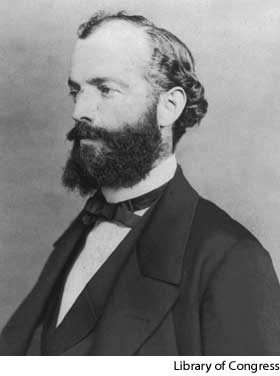
AUGUST KEKULE
It is not only writers and composers that have creative breakthroughs. Molecular scientists do, too. Notes the Flemish scientist, Kekule, "One fine evening I was returning by the last bus through the deserted streets of the metropolis, which are at other times so full of life."
"I fell into a reverie, and lo! the atoms were gamboling before my eyes. Whenever those diminutive beings had appeared to me before, they had always been in motion, but I had never been able to discern the nature of their motion."
"Now, however, I saw how frequently, how smaller atoms united to form a pair; how a larger one embraced two smaller ones; how still larger ones kept hold of three or even four of the smaller, while the whole kept whirring in a giddy dance."
"I saw how the larger ones formed a chain. I spent part of the night putting on paper at least a sketch of these dream forms."
Then, years later, the big illumination made it's appearance.
"I turned my chair to the fire and dozed. Again the atoms were gamboling before my eyes. This time the smaller groups kept modestly in the background. My mental eye, rendered more acute by repeated visions of this kind, could now distinguish larger structures....long rows, sometimes more closely fitted together; all twining and twisting and snakelike motion."
"But look! What was that? One of the snakes had seized hold of its own tail, and the form whirled mockingly before my eyes! As if by a flash of lightening I awoke. Let us learn to dream, gentlemen."
Kekule had made a most remarkable discovery -- that benzene is a cyclic or ring structure and the carbon chain at the molecular core of the compound does indeed form a chain that "swallows its own tail".
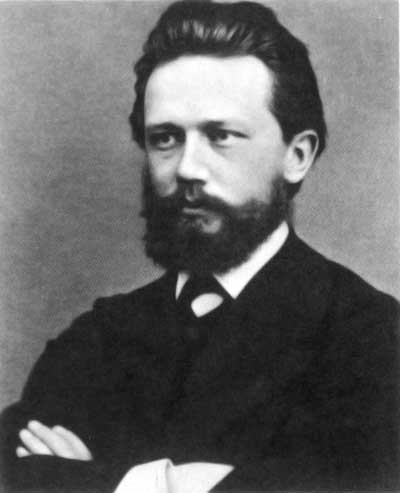
TCHAIKOVSKY
OK, all you aspiring creators, how about a tip from the man who composed the Nutcracker Suite? "Generally, the germ of a future composition comes suddenly and unexpectedly. It takes root with extraordinary force and rapidity, shoots up through the earth, puts forth branches and leaves, and finally blossoms."
"I forget everything and behave like a mad man. Everything within me starts pulsing and quivering. Hardly have I begun the sketch, before one thought follows another."
"In the midst of this magic process, it frequently happens that some external interruption awakes me from my somnabulistic state. Dreadful indeed are such interruptions. They break the thread of the inspiration."
AUTHOR'S NOTE: I realize there are no stories, in this article, about women with BIG AHA moments. The "literature" is fairly lame in this regard. Most of the anecdotes are about men. I'd like this article to be better balanced. Do you have any examples YOU can share with me -- and I will edit this posting accordingly.
Posted by Mitch Ditkoff at 08:08 PM | Comments (0)
September 06, 2018A Big Shout Out to All of the Teachers on the Planet

In the past 12 months I have spent 90 days working very closely with Al Siraat College, an Australian school in the Islamic tradition, located in the suburbs of Melbourne. Working at the school for a month at a time, I've had an extraordinary opportunity, to see, first hand, up close and personal, both the glory and the challenge of what it takes be a teacher in 2018 and also what's required to establish the kind of school culture that is conducive to real learning.
On the glory side of the equation, there is a lot to acknowledge -- countless opportunities for teachers to make a difference in the lives of the next generation of movers and shakers... never-ending chances to open eyes, open minds, and open hearts... chances to listen, connect, nurture, empower, encourage, inspire, awaken, educate, and be a catalyst for positive change. The audience? Kids! Children! Teenagers! Multi-cultural keepers of a very special flame -- the hope for our world. The ones Thomas Edison referred to when he said that "the greatest invention in the world is the mind of a child."

On the flip side of the equation?
The extremely hard work required of teachers to deliver real value to class after class of kids who sometimes would rather be playing, texting, sleeping, googling, eating, watching TV, daydreaming, or any number of other pursuits far more interesting to them than algebra or sitting quietly at their desks. Toss in a few dozen X factors like one-parent families, stress, English as a second language, a multiplicity of learning styles, social media, distractability, bullying, and the rites of passage most kids go through daily and you have a formula for a very challenging profession.
I want to take this moment in time to deeply THANK all of the teachers in the world for taking on the challenge of educating our children -- and for staying with it even when it seems like nothing they do is noticed, working, or appreciated.
I also want to take this moment to thank all of the hard working teachers of Al Siraat for giving it their best day after day after day after day. I know it's not easy. I know it's not always fun. I know the path forward isn't always clear. But the efforts you are making ARE bearing fruit and will CONTINUE to bear fruit in ways you have not yet imagined. Stay with it! Hang in there! Trust the process! As they say, "Rome wasn't built in a day."
And to the Staff, Administrators, Directors, and Founders of Al Siraat, allow me to take this unofficial cyberspatial moment to acknowledge YOU for all your vision, commitment, perseverance, resilience, flexibility, collaboration, courage, and willingness to learn. The world needs more people like you! Stay with it! You are being called and you are responding, with nobility, love, and respect to the source of that call.
Thank you all, from the bottom of my heart, for the opportunity to be a part of what you are creating -- what one day may very well become a model for Islamic education in the West.
Heads of Learning
School Coordinators
Heads of Year
Middle Years Homegroup Teachers
Senior Years Homegroup Teachers
Junior Years Homegroup Teachers
Subject teachers
Specialist teachers
Counseling Services and Learning Support
Religion and Islamic Studies
Customer support
IT Support
Site Team
College Management
Executive Team
Posted by Mitch Ditkoff at 02:52 AM | Comments (0)
August 29, 201810 Tips for Giving a Great Keynote

Actors want to direct. Directors want to produce. And consultants want to deliver keynote presentation. And why not? The pay is good. It doesn't take much time. And it's a lot less heavy lifting than most consulting gigs.
Easier said that done, however. Delivering an impactful keynote is not as easy as it looks. If you want to get into the game, begin by reviewing the following guidelines to see if you have what it takes.
1. Be in tune with your purpose: If you're going to hold an audience's attention for more than 10 minutes, you've got to begin by holding firm to your purpose... your calling... what gets you out of bed in the morning. If it's missing, all you could ever hope to deliver is a speech -- which is NOT what people want to hear. If your purpose is clear, you're home free and won't need a single note card.

Mark Twain said it best: "If you speak the truth, you don't need to remember a thing."
2. Be passionate: Realize you are on the stage to let it rip. Completely. People are sitting in the audience because they want an experience, not just information. They want to feel something, not just hear something.
So play full out. Pull the rip cord. Jump!
3. Connect with the audience: You may know a lot of stuff. You may have a double Ph.D, but unless you know how to connect with the audience, your knowledge ain't worth squat.
If you were a tree falling in a conference room, no one would hear it.
So tune in! Establish rapport! Connect! And that begins by respecting your audience and realizing you are there to serve.
4. Tell stories: That's how great teachers have communicated since the beginning of time. Storytelling is the most effective way to disarm the skeptic and deliver meaning in a memorable way.
"The world is not made of atoms," explained poet, Muriel Rukyser. "It's made of stories."
No bull. Parable!
5. Have a sense of humor: There's a reason why HAHA and AHA are almost spelled the same. Both are about the experience of breakthrough. And both are sparked when the known is replaced by the unknown, when continuity is replaced by discontinuity.
Hey, admit it. At the end of the day, if you can't find the humor in business, you're screwed. So, why wait for the end of the day. Find the humor now.
6. Get visual: It's become a corporate sport to make fun of power point, but power point can be a thrill if done right. A picture really is worth a thousand words.
If you want to spark people's imagination, use images more than words. The root of the word imagination is image.
7. Have confidence: Do you know what the root of the word "confidence" is? It comes from the Latin "con-fide" -- meaning "to have faith." Have faith in what? Yourself.
That's not ego. It's the natural expression of a human being coming from the place of being called.
So, if you're about to walk out on stage and are feeling the impostor syndrome coming on, stop and get in touch with what is calling you.
Let that guy/gal speak.
8. Trim the Fat: When Michelangelo was asked how he made the David, he said it was simple -- that he merely took away "everything that wasn't."
The same holds for you, oh aspiring-kick ass-presenter-at-some-future high-profile-conference (or, at the very least, pep-talk-giver to your kid's Junior High School soccer team).
Keep it simple. Or, as Patti LaBarre, the delightful MC at last year's World Innovation Forum put it, "Minimize your jargon footprint."
9. Celebrate what works: If you want to raise healthy kids, reinforce their positive behaviors -- don't obsess on the negative. The same holds true for keynote presentations.
If you want to raise a healthy audience, give them examples of what's working out there in the marketplace. Feature the "bright spots," as Chip Heath likes to say. Share victories, best practices, and lessons learned. Save the bitching and moaning for your therapist.
10. Walk the Talk: Good presenters are genuinely moved. Being genuinely moved, it's natural for them come out from behind the podium and actually move around the stage or into the audience -- as in walking the talk.
Don't hide behind the podium. Screw your notes. If you have to depend on notes to give your presentation, guess what? You're not being present.
People aren't sitting in the audience to watch you read from your notes. They're sitting there to watch you blast off and inspire them to get out from behind their podium and accomplish the extraordinary.
Idea Champions
MitchDitkoff.com
My clients
What my clients say
Posted by Mitch Ditkoff at 10:04 PM | Comments (2)
August 28, 2018Be Yourself!
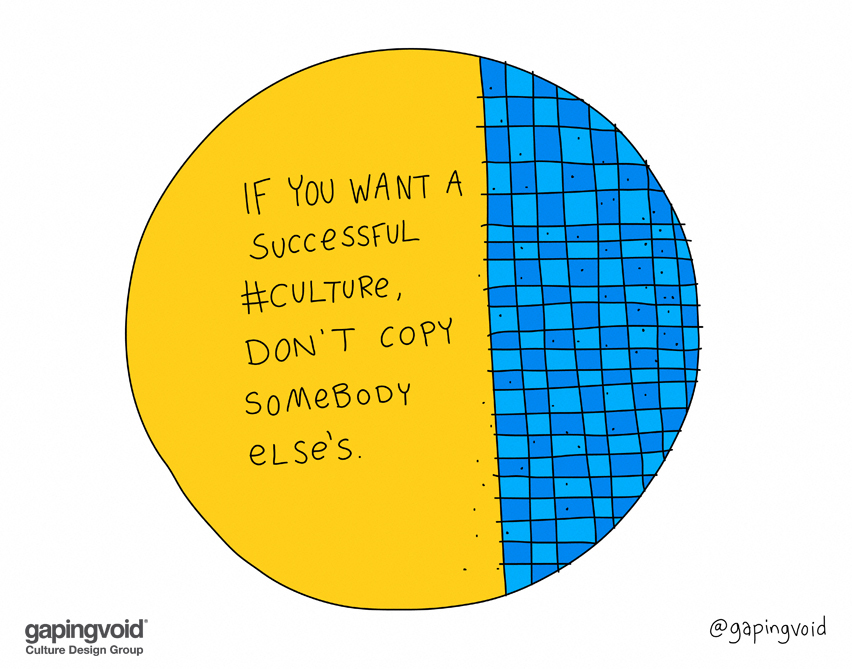
Your company is unique. Honor that uniqueness. While there is nothing wrong with benchmarking other company's best practices, be mindful not to mindlessly graft them on to your company's culture. Be who you are!
Illustration: gapingvoid
Idea Champions
Help for being who you truly are
The author of the book
Posted by Mitch Ditkoff at 06:15 PM | Comments (0)
August 21, 2018How to Authentically Brand Yourself in a Crowded Marketplace
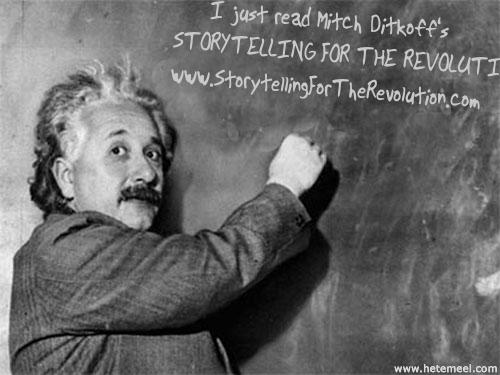
If you have 30 minutes, click here to listen to an interview of me waxing on about how you can better brand yourself and your company. Includes some useful tips about how to use storytelling towards that end. No brand strategists died in the taping of this interview.
PS: The link is only good until 4:00 pm EST on August 2nd.
MitchDitkoff.com
Storytelling for the Revolution
Idea Champions
Posted by Mitch Ditkoff at 06:49 PM | Comments (0)
August 06, 2018You're Right!

There is a scene from Fiddler on the Roof that has taught me more about life than most holy books I've read.
In it, two men are heatedly arguing over the age of a horse. When they see Tevye, the town milkman/sage, walking by, they begin passionately pleading their case.
"Tevye!" blurts the first, "I've been cheated! Last month I bought a horse from this sorry excuse for a man. He told me the horse was six years old, but it is 12!"
Tevye listens carefully, strokes his beard, nods his head, and smiles. "You're right!" he says.
"What!" screams the second. "No way! Not true! The horse I sold him was six years old and I have the papers to prove it!"
Again, Tevye listens, strokes his beard, nods his head, and smiles. "You're right!" he says.
A third man, who'd been watching the argument from the beginning, boldly steps forward.
"Tevye... with all due respect for your great insight and wisdom, how can he be right" (pointing the the first) "and he be right" (pointing to the second).
Tevye listens, strokes his beard, nods his head, and smiles. "You're right!
Then he starts dancing like a madman.
Next time you think you're right... remember Tevye.
Life is full of paradox, contradiction, and seeming dissonance. See if you can dance your way through it without making anyone wrong. Look for the sweet spot -- or what Rumi once referred to as "the field beyond right doing and wrong doing."
IdeaChampions
Storytelling for the Revolution
Posted by Mitch Ditkoff at 02:44 AM | Comments (3)
June 20, 2018How to Spark Innovation in Your Company in 10 Minutes Per Week

Do you work in an organization that is trying to raise the bar for innovation, teamwork, storytelling, and leadership, but doesn't have the budget to pay for trainings, keynotes, and workshops? Here's an alternative -- Idea Champions' Micro-Learning for Innovators service. It all happens online. At your own pace.
The price? YOU decide on the value of our service and make us an offer. 95% of the time we go with what our prospective clients suggest. 5% of the time we decline. Interested? mitch@ideachampions.com
Posted by Mitch Ditkoff at 10:23 AM | Comments (0)
June 07, 2018100 Simple Ways to Be More Creative on the Job

1. Ask the most creative people at work for their ideas.
2. Brainstorm with a co-worker.
3. Tape record your ideas on your commute to and from work.
4. Present your challenge to a child.
5. Take your team off-site for a day.
6. Listen to your inner muse.
7. Play music in your office.
8. Go for a daily brainstorming walk.
9. Ask someone to collaborate with you on your favorite project.
10. Exercise during your lunch break.
11. Turn on a radio at random times and listen for a message.
12. Invite your customers to brainstorming sessions.
13. Think of new ways to define your challenge.
14. Remember your dreams.
15. Reward yourself for small successes.
16. Introduce odd catalysts into your daily routine.
17. Get out of the office more regularly.
18. Give yourself an unreasonable deadline.
19. Take more naps.
20. Jot down as many ideas as possible in five minutes
21. Work in cafes.
22. Transform your assumptions into "How can I?" questions.
23. Conjure up a meaningful goal that inspires you.
24. Redesign your office.
25. Take regular daydreaming breaks.
26. Dissolve turf boundaries.
27. Initiate cross-functional brainstorming sessions.
28. Arrive earlier to the office than anyone else.
29. Turn a conference room into an upbeat think tank room.
30. Read odd books that have nothing to do with your work.
31. Block off time on your calendar for creative thinking.
32. Take a shower in the middle of the day.
33. Keep an idea notebook at your desk.
34. Decorate your office with inspiring quotes and images.
35. Create a headline of the future and the story behind it.
36. Choose to be more creative.
37. Recall a time in your life when you were very creative.
38. Wander around a bookstore while thinking about your challenge.
39. Trust your instincts more.
40. Immerse yourself in your most exciting project.
41. Open a magazine and free associate off of a word or image.
42. Write down your ideas when you first wake up in the morning.
43. Ask yourself what the simplest solution is.
44. Get fast feedback from people you trust.
45. Conduct more experiments.
45. Ask yourself what the market wants or needs.
46. Ask "What's the worst thing that could happen if I fail?"
47. Pilot your idea, even if it's not ready.
48. Work "in the cracks" -- small bursts of creative energy.
49. Incubate (sleep on it).
50. Test existing boundaries -- and then test them again.
51. Schedule time with the smartest people at work.
52. Visit your customers more frequently.
53. Benchmark your competitors -- then adapt their successes.
54. Enroll your boss or peers into your most fascinating project.
55. Imagine you already know the answer. What would it be?
56. Create ground rules with your team that foster new thinking.
57. Ask stupid questions. Then ask some more.
58. Challenge everything you do.
59. Give yourself a deadline -- and stick to it.
60. Look for three alternatives to every solution you originate.
61. Write your ideas in a notebook and review them regularly.
62. Make connections between seemingly disconnected things.
63. Use creative thinking techniques.
64. Play with the Free the Genie cards.
65 Use similes and metaphors when describing your ideas.
66. Have more fun. Be sillier than usual.
67. Ask "How can I accomplish my goal in half the time?"
68. Take a break when you are stuck on a problem.
69. Think how your biggest hero might approach your challenge.
70. Declare Friday afternoons a "no-email zone."
71. Ask three people how they would improve your idea.
72. Create a wall of images that inspires you.
73. Do more of what already helps you be creative off the job.
74. Laugh more, worry less.
75. Remember your dreams -- then write them down.
76. Ask impossible questions.
77. Eliminate all unnecessary bureaucracy and admin tasks.
78. Create a compelling vision of what you want to accomplish.
79. Work on hottest project every day, even if only 5 minutes.
80. Do whatever is necessary to create a sense of urgency.
81. Go for a walk anytime you're stuck.
82. Meditate or do relaxation exercises.
83. Take more breaks.
84. Go out for lunch with your team more often.
85. Eat lunch with a different person each day.
86. Ask for forgiveness, not permission.
87. Invite an outside facilitator to lead a brainstorming session.
88. Take more risks outside of the office (i.e. surf, ski, box etc.)
89. Ask for help when you need it.
90. Know that it is possible to make a difference.
91. Find a mentor.
92. Acknowledge all your successes at the end of each day.
93. Create an "idea piggy bank" and make deposits daily.
94. Have shorter meetings.
95. Try the techniques in Awake at the Wheel
96. Don't listen to or watch the news for 24 hours.
97. Make drawings of your ideas.
98. Bring your project or challenge to mind before going to bed.
99. Divide your idea into component parts. Then rethink each part.
100. Post this list near your desk and read it daily.
Illustration: Unsplash
Idea Champions
Posted by Mitch Ditkoff at 01:16 AM | Comments (9)
May 14, 2018The Kindness-At-Work Manifesto

It has recently come to my attention that some of the most loving, passionate, well-intentioned people in the world have a tendency to treat their co-workers unkindly -- especially during times of stress or on a Monday, Tuesday, Wednesday, Thursday, or Friday.
Consumed by their need to do something extraordinary for humanity, they forget the people they work with are human.
And so, in an effort to restore a Culture of Caring to organizations everywhere. it is my honor to present to you the Kindness-At-Work Manifesto -- 40 daily opportunities to go beyond the imperfections of your co-workers and rise to a place of uncommon goodness.
Where does it begin? With your intention to maintain your commitment to kindness any time one of your co-workers does not.
CHOOSE KINDNESS WHEN YOUR CO-WORKERS...
1. Forget to acknowledge you for a job well done
2. Take credit for something they had little to do with
3. Don't reply to your emails
4. Talk behind your back
5. Eat the last cookie
6. Withhold vital information
7. Expect you to work on the weekends
8. Forget to send you the agenda
9. Make an impossible request on you at the end of the day
10. Criticize you for not responding to their email when the item they wanted you to read was the 93rd item on the list
11. Don't let you finish a sentence
12. See the glass not as half empty, or half full, but cracked
13. Have no clue how to listen
14. Preface their regular attempts to criticize you with "Do you have a moment? I'd like to share some feedback with you."
15. Arrive late to every meeting
16. Talk to the boss about your shortcomings before airing it out with you, one-on-one
17. Expect you to cover for them every time they do a half-assed job
18. Start humming Bee Gee songs with no warning
19. Expect you to "do the math" every time your team goes out for lunch, then proceed to forget to calculate the tip and the tax when they leave too little cash for their part of the meal
20. Seek competition instead of collaboration
21. CC you on more emails than the US Tax Code has corporate loopholes
22. Think you're an idiot
23. Forget to ask how you are after your operation
24. Rarely look you in the eye
25. Make up phony excuses why they didn't return your phone call
26. Start talking about their new ringtone as if it was the Holy Grail
27. Think they know more than you do
28. Worship data
29. Talk about their old LSD experiences every time you say the word "watermelon".
30. Only express kindness when they want something from you
31. Forget to forgive you for an old mistake you made
32. Ask you to help them start a blog at 5:30 pm
33. Give you bad information regularly, then wonder why you're late with whatever it is they expect from you
34. Think they are closer to God than you because they went to a yoga class last February
35. Invite you to brainstorming sessions that are nothing more than their veiled attempts to get you to praise their pet ideas
36. Send you emails with emoticons
37. Think they're your friend because they friended you on Facebook
38. Enter into every conversation with you as if they were late for a meeting with a more important person
39. Never return the books they borrow
40. Think you're not committed because you don't work 90 hours a week
Of course, the above 40 items don't tell you how to be kind -- they only name the occasions where kindness is missing. But guess what? No one needs to teach how to be kind. You already know how to be kind.
Your next step? Choose one of the 40 opportunities above and be conscious of it all next week. Then, when one of your co-workers manifests that behavior, choose kindness.
Also in the Huffington Post
Idea Champions
Posted by Mitch Ditkoff at 10:38 PM | Comments (1)
May 07, 2018Perfect Advice for Anyone In Your Organization Resistant to Change
MitchDitkoff.com
Idea Champions
My new book
Posted by Mitch Ditkoff at 09:52 AM | Comments (0)
May 02, 2018One Quality of a Good Executive

38 quotes on leadership
Al Siraat college making a difference in the world
Idea Champions
Photo: Evelyne Pouget
Posted by Mitch Ditkoff at 08:19 PM | Comments (0)
May 01, 2018Visioning and Strategic Planning Sessions for Executive Teams
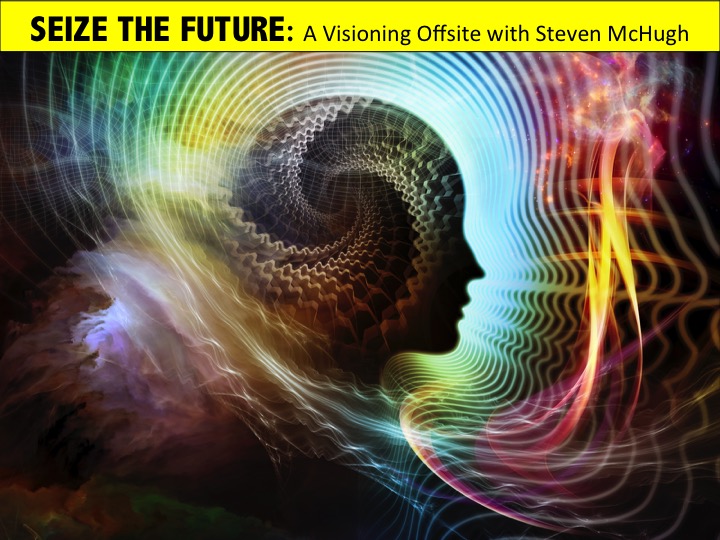
"The best way to predict the future is to create it." -- Alan Kay
Face it. Most corporate strategic planning processes are boring, tedious, and highly ineffective -- a day or two of smart, highly paid executives sitting in a hotel meeting room and wishing it was over. Bad muffins. Bad lighting. And plastic ferns. The outcomes? Some new ideas, a rarely-read report, and the vague recollection that the same thing happened last year. Bottom line, a lost opportunity.
The reason why? The process used to go beyond the status quo was either lame, incomplete, or poorly facilitated. Sound familiar?
Enter Seize the Future, Idea Champions' highly engaging, two-day offsite that gets Senior Teams out of their ruts and into the kind of mindset and rigor required to create an inspired vision and strategy for their company's future.

Designed and facilitated by Idea Champions' co-founder, Steven McHugh, Seize the Future, has been used with dozens of top teams at a wide range of Fortune 500 and mid-sized companies. It works every time and will work for you, as well, no matter what your industry.
The deliverable? A consciously-conceived, inspired, and actionable vision/strategy that has been signed in blood (i.e. indelible magic marker) by the very movers and shakers whose job it is to help their organization craft a bold new, profitable future.
Intrigued? Want to speak with Steven and find out more? He is just an email away. A 15-minute call is all that's needed for you and Steven to determine if Seize the Future is right for you. Steven@ideachampions.com -- or leave a message for us at 845.679.1066.
On the Idea Champions website
Our clients
What they say
Our team
Posted by Mitch Ditkoff at 06:26 PM | Comments (0)
April 26, 2018Micro-Learning for Innovators in Just 15 Minutes Per Week
 If you are looking for a simple, inexpensive way to spark innovation in your organization in just 15 minutes per week, here it is. No workshops. No trainings. No keynotes. No complicated idea management software. No headbanging. And the first three companies that respond to this post get to name their own price. Here's what one of our happy clients says about this innovative service of ours.
If you are looking for a simple, inexpensive way to spark innovation in your organization in just 15 minutes per week, here it is. No workshops. No trainings. No keynotes. No complicated idea management software. No headbanging. And the first three companies that respond to this post get to name their own price. Here's what one of our happy clients says about this innovative service of ours.
PS: If you want to know how much it costs, text me at 845.389.9096 and I'll let you know ASAP.
The creator of this service
The company he co-founded
This might be included
10 ways to enable innovation in the workplace
Another way of thinking about time
Posted by Mitch Ditkoff at 08:24 AM | Comments (0)
April 12, 2018Two Simple Steps to Sell Anybody on Your Vision

You are a visionary. Or, if that word feels too inflated for you, then at least someone with an inspired vision of the future for your organization. To you, it's obvious. To others? Not so much. Your challenge? Communicating your vision in such a way that that people not only SEE it, but embrace it. Here's one thing to keep in mind as you proceeed -- some words of wisdom from Fast Company Magazine.
Idea Champions
How we can help
Posted by Mitch Ditkoff at 06:04 AM | Comments (0)
April 01, 2018The 10 Personas of an Effective Brainstorm Facilitator

Allow me to make a wild guess. You have participated in more than a few brainstorm sessions in your life. Yes?
And allow me to make another wild guess. Many of those sessions left you feeling underwhelmed, over-caffeinated, disappointed, disengaged, and doubtful that much of ANYTHING was ever going to happen as a result of your participation. Yes, again? I thought so.
There's a ton of reasons why most brainstorming sessions under-deliver, but the main reason -- the Mount Olympus of reasons (drum roll, please....) is the brainstorm facilitator. Armed with a short list of ground rules, a flipchart marker, and a muffin, most brainstorm facilitators miss the mark completely.
The reason has less to do with their process, tools, and techniques than it does with their inability to adapt to what's happening, real-time, in the room. In an all-too-professional attempt to be one-pointed, they end up being one-dimensional, missing out on a host of in-the-moment opportunities to spark the ever-mutating, collective genius of the group.
If only our well-intentioned brainstorm facilitators could abide by the words of Walt Whitman, when he confessed that he "contained multitudes."
Translation? If you or anyone you know is going to lead a diverse group of time-crunched, opinionated, multi-tracking, people through a process of originating breakthrough ideas, DON'T BE A ONE TRICK PONY! Be a multitude -- or, at the very least, be multi-faceted. Let it rip. Hang ten. Pull out the stops.
Use your right brain and your left. Let all the cats out of the proverbial bag -- and by so doing, exponentially increase your chances of sparking brainpower, brilliance, and beyond-the-obvious ideas.
OK. Enough bloggy pep talk. Let's get down to business. Take a few minutes now to rate yourself, on a scale of 1-10, for how skillful you are at embodying the following personas of a high flying brainstorm facilitator. Then tune into your biggest strength and ask yourself how you can amplify that quality. Then identify your biggest weakness and figure out how you can improve in that arena.

1.CONDUCTOR
A skilled brainstorm facilitator knows how to orchestrate powerfully creative output from a seemingly dissonant group of people. In the conductor mode, the facilitator includes everyone, evokes even the subtlest contributions from the least experienced participant, and demonstrates their commitment to the whole by offering timely feedback to anyone who "gets lost in their own song."
2.ALCHEMIST
A good brainstorm facilitator is able to transmute lead into gold -- or in modern terms -- knows how to help people "get the lead out." This talent requires an element of wizardry -- the ability to see without looking, feel without touching, and intuitively know that within each brainstormer lives a hidden genius just waiting to get out.
3.DANCER
Light on their feet, brainstorm facilitators move gracefully through the process of sparking new ideas. Able to go from the cha-cha to the polka to the whirling dervish spinning of a brainstorm group on fire, savvy facilitators take bold steps when necessary, even when there is no visible ground underfoot. "The path is made by walking on it," is their motto.
4. MAD SCIENTIST
Skillful brainstorm facilitators are bold experimenters, often taking on the crazed (but grandfatherly) look of an Einstein in heat. While respecting the realm of logic and the rational (the ground upon which most scientists build their homes), the enlightened facilitator is willing to throw it all out the window in the hope of triggering a "happy accident" or a quantum leap of thought. Indeed, it is often these discontinuous non-linear moments that produce the kind of breakthroughs that logic can only describe, never elicit itself.

5.DIAMOND CUTTER
Fully recognizing the precious gem of the human imagination (as well as the delicacy required to set it free), the high octave brainstorm facilitator is a craftsman (or craftswoman) par excellence -- focused, precise, and dedicated. Able to get to the heart of the matter in a single stroke without leaving anything or anyone damaged in the process.
6. ACTOR
Brainstorm facilitators are "on stage" whether they like it or not. All eyes are upon them, as well as all the potential critical reviews humanly possible. More often than not, the facilitator's "audience" will only be moved to act (perchance to dream) if they believe the facilitator is completely into his or her role. If the audience does not suspend this kind of disbelief, the play will close early and everyone will be praying for a fire drill or wishing they were back home eating a grilled cheese sandwich.
7.ENVIRONMENTALIST
Brainstorm facilitators are the original recyclers. In their relentless pursuit of possibility, they look for value in places other people see as useless. To the facilitator in full mojo mode, "bad ideas" aren't always bad, only curious indicators that something of untapped value is lurking nearby.
8. OFFICER OF THE LAW
One of the brainstorm facilitator's most important jobs is to enforce "law and order" once the group gets roaring down the open highway of the imagination. This is a fine art -- for in this territory speeding is encouraged, as is running red lights, jaywalking, and occasionally breaking and entering. Just as thieves have their code of honor, however, so too should brainstormers. Indeed, it is the facilitator's task to keep this code intact -- a task made infinitely easier by the ritual declaration of ground rules at the start of a session.''
9.SERVANT
Some brainstorm facilitators, intoxicated by the group energy and their own newly stimulated imagination, use their position as a way to foist their ideas on others -- or worse, manipulate the group into their way of thinking. Oops! Ouch! Aargh! Brainstorm facilitating is a service, not a personal platform. It is supposed to be a selfless act that enables others to arrive at their own solutions, no matter how different they may be from the facilitator's.
10. STAND-UP COMIC
Humor is one of the brainstorm facilitator's most important tools. It dissolves boundaries, activates the right brain, helps participants get unstuck, and shifts perspective just enough to help everyone open their eyes to new ways of seeing. Trained facilitators are always on the lookout for humorous responses. They know that humor often signals some of the most promising ideas, and that giggles, guffaws, and laughable side-talk frequently indicate a rich vein of possibility to explore. Humor also makes the facilitator much more "likable" which makes the group they are facilitating more amenable to their direction. Ever wonder why the words "Aha!" and "Ha-Ha" are so similar?
The book from which the article was excerpted
Idea Champions
Our clients
What they say
Our brainstorm training
Posted by Mitch Ditkoff at 12:11 AM | Comments (0)
March 18, 2018HOLY FOOLS DAY: March 25th!
Gail Larsen initiated Holy Fools Day in 2014, and in this fourth year of bringing a wonderful spark of madness to the world, you're invited to join Gail, Wisdom Healing Qigong Master Mingtong Gu, Sacred Activist Andrew Harvey and a fervent group of transformational speakers to take your own wild leap of faith. What one bold action are you ready to take toward the change you want to see in the world?
Posted by Mitch Ditkoff at 09:31 AM | Comments (0)
February 22, 2018How to Go Beyond the Email Blues
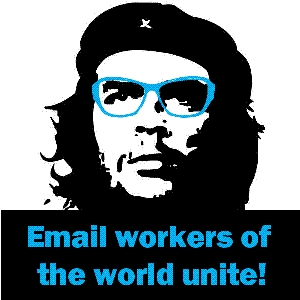
In 1999, I wrote a tongue-in-cheek blues song about email.
My purpose was to poke fun at some of the email madness going on at that time. (If you want to give a listen, click the link above).
It's 18 years later now and the email scene has become even weirder. If I was going to write a sequel, it wouldn't be the blues, it would be the black and blues -- because that's how bruised most of us are feeling these days about email. Bruised, abused, and beat up.
And so, in service to all of the loyal readers of The Heart of Innovation and all of Idea Champion's awesome clients, it is my privilege to share with you our own email survival strategies -- perhaps the most practical posting you will ever read on this blog.
1. Decide. Phone or email: Before sending off yet another email, ask yourself if email is the appropriate platform to communicate your message.
Maybe a phone call would be better. Or a face-to-face meeting. Or skywriting.

If your email is more than 2-3 paragraphs, you probably need to talk. Emotionally charged issues are better done on the phone or in
person.
If you require consensus or a quick decision, forget email. Try Skype or the phone or -- this just in -- walk down the hall and actually talk to somebody.
2. Create a simple way to organize your email: I'm not suggesting you sign up for one more poorly facilitated webinar to figure this out -- but you will need to devise a simple and sustainable way to process all the messages flooding your inbox daily.
If you don't have some kind of organizing system in place, you will be a victim of email overload, resulting in the regrettable phenomenon of the people waiting for your response to assume that you've either moved to Mongolia or don't like them (both of which may be true).
When a new email comes in, you have five choices:
1. Read it immediately and respond
2. Read it and delete
3. Keep it in your inbox (which becomes your TO DO list)
4. File it in a folder called "EMAIL" and respond later
5. File it, by subject, in various folders in your sidebar
3. Read the entire email: When you are pressed for time, it is more than likely you will only glance at your emails, instead of actually reading them.
The result? You miss key pieces of information and, without realizing it, subsequently confuse other people down the line or waste their time because you are only partially informed about the topic of the email, but you (madly scrolling through your emails), think you know.
4. Write clear subject lines: Many emails get lost or neglected because their subject lines are confusing
Cease and desist! Snap out of it! Use laser-like. descriptive headlines. You can do this! You can! Do not write "An Idea" in your subject heading. Write "An Idea for Tripling Our Sales: FEEDBACK NEEDED" or SOMETHING that alerts to the reader to what your email is really about.
5. Include "Requests for Action", when appropriate:
If you want readers of your emails to actually respond (not just read your email as if it was the back of a cereal box), be sure to include the response you are requesting in the subject line.
FEEDBACK NEEDED
ACTION REQUESTED
CALL TO ACTION
CALL ME TODAY
NOTE: If you begin an email thread and have received all the input you need, remember to delete the REQUEST FOR ACTION phrase in your subject line. Otherwise, you will get besieged by input you neither need or want.
6. Begin your subject line with "FYI" if all you are doing is sharing information, i.e.
FYI: Going on vacation
FYI: I just won the Congressional Medal of Honor
FYI: Cool article about muffins
7. Maintain single subject threads: If multiple subjects are embedded in emails, readers lose track and become, functionally (or pathologically), out of the loop.
Do not add new subjects to email threads. If a given email "reminds" you of a new topic you feeling a burning need to communicate, start a new email thread. Or move to Canada.
8. Use ALL CAPS sparingly: Caps, when used selectively, can be very effective, calling attention to key words.
Used indiscriminately, they create the impression of SHOUTING. LOTS OF SHOUTING. IT GETS OLD FAST. VERY FAST. LIKE THESE FEW LINES OF THIS BLOG POSTING WHICH ARE NOW STARTING TO SEEM LIKE AN INFOMERCIAL FOR A HOME EXERCISE MACHINE YOU CAN BUY IN SIX EASY PAYMENTS OF $99.99, BUT YOU WILL NEVER USE.
9. Use "cc: selectively: Before cc'ing everyone in the known universe, PAUSE and ask yourself WHO really needs to read your email? If you have any doubt, check in with your cc minions and ask them to tell you WHAT email topics of yours they really need to be cc'd on.
10. Be Wise About "To" and "Copy" Fields: Remember this, oh multi-tracking and time-crunched sender of emails: Names in the "To" field are for people you are directly speaking to. Names in the "copy/cc" field are for people who will benefit from reading your email email, but your email is not essential to them and you do not need them to respond.
11. Acknowledge the sender: If an email falls in a forest, does anyone hear it?
Please understand that it is a courtesy to acknowledge that you have received and understood SOME of the emails sent you way. If the email you receive cites a deadline two weeks away, don't wait two weeks to respond. Instead, send a quick "thanks" or"'will do" or "can't do" to acknowledge receipt.
If you have an objection to what the email writer is saying, speak up! Say something! Silence, in the email zone, creates nothing but ambiguity and confusion.
12. Follow the 2-minute rule: If it will take you less than 2 minutes to respond to an email and remove it from your inbox, do it.
13. Create some sacred email time: Email can be incredibly distracting. If you continue to check your email throughout the day, your chances of concentrating on any one topic drop lower than the chances of health care, in the US, being affordable before 2050.
Pick a few slow times of the day when you actually have the time to check email, instead of knee jerkily checking your inbox every 30 seconds.
14. Use the phone more: If you need a quick answer, try calling. If you have something long to explain, try calling. If you don't understand an email, try calling. Or just walk to the person's office and TALK to them.
The goal, by the way, is communication, not transmission. Just because you sent an email to ten people and crossed their names off your TO DO list, does not mean you have communicated.
MitchDitkoff.com
Idea Champions
Posted by Mitch Ditkoff at 12:06 AM | Comments (0)
February 06, 2018MICRO-LEARNING for Innovators (in just 15 minutes per week)

Innovation is a huge topic in organizations these days. Every company is looking for new and better ways to do more with less, differentiate themselves from the competition, and unlock the hidden genius of their workforce.
At the same time, many organizations are budget-constrained. Flying in an outside consultant to lead a workshop or training can sometimes be cost prohibitive. This I understand.
Which is precisely why my company, Idea Champions, is now offering Micro-Learning for Innovators, a cost-effective way to stir the innovation soup -- a virtual, self-organizing, just-in-time way to increase everyone's ability to be a proactive innovator on-the-job. And it only takes 15 minutes per week.
TOPICS INCLUDE: Mindset, Culture of Innovation, Creative Thinking, Idea Generation, Brainstorm Facilitation, Storytelling, Leadership, Teamwork/Collaboration, Listening/Feedback, Problem Solving

HOW IT WORKS:
1. You and I have a 20-minute phone conversation about WHY you want to raise the bar for innovation and creativity in your organization.
2. Based on your needs, I create a year-long, customized Micro-Learning for Innovators curriculum for you -- a landing page of links to 52 engaging articles and videos of mine on the topic (curated from more than 1,200 I have produced).
3. Each week (or month), for the next year, you forward selected links to your team (or whatever part of your workforce is participating in the program.)
4. Participants read/view the link(s) in preparation for their meeting (real-time or virtual) that you or one of your surrogates facilitates. All you need to reserve on your agenda is 10 minutes for the innovation topic. NOTE: This is micro-learning, not head-banging.
5. You (or your designated meeting moderator) facilitates the innovation-topic-of-the week conversation. This deepens learning, quickens the sharing of best practices, sparks creative thinking, ensures accountability, and establishes a robust, intrinsically motivated learning community.
OPTION #1: I send you a simple "Moderator's Guide" that helps ensure your weekly innovation-sparking conversations are as effective as possible.
OPTION #2: I participate on your launch call to help you set the context, inspire participation, and answer any questions your people might have about the value, purpose, and process of the program.
OPTION #3: At TBD intervals, throughout the year, you invite me to facilitate one of your online meetings/trainings.
FEE: Name your own price for an annual license. (In other words, you quantify the value of my service to your organization and make me an offer. If it's "in the zone," I will say YES. If your offer is below what I consider fair, we will talk and see if we can come to an agreement.
WHO CREATED THE PROGRAM? Mitch Ditkoff, Co-Founder of Idea Champions, Author of the two award-winning winning books on innovation and storytelling. Creator of a wide variety of storytelling workshops and keynotes. Innovation Blogger of the Year, two years running. Master storyteller. His clients.
Interested? email Mitch today: mitch@ideachampions.com
Our clients
What they say
Our workshops and trainings
One of our micro-learning partners
Posted by Mitch Ditkoff at 09:02 AM | Comments (0)
February 01, 2018Out of the Box, In the Box

ED NOTE: I just checked the stats/hits on the last eight years of Heart of Innovation blog posts and was surprised to see that the following article about my father's death got the most attention (30% more views than anything else!). I've always assumed I was "supposed" to be writing about innovation and creativity, but maybe there's something else more essential I need to be writing about...
There is a time of life when the time of life is about to end -- the time of last breaths, the time of saying goodbye to everything you have ever known or loved, the time of letting go.
This is the time my father now finds himself in.
He is flat on his back in a hospital bed, but the hospital bed is in his bedroom in West Palm Beach which is where he has chosen to die -- and will.
There will be no more calls to 911, no more paramedics, no more blood transfusions, no needles, no pills, no tests. This is his death bed and we are around it, me, his son -- his daughter, my sister -- my wife, his daughter-in-law -- grandchildren, great grandchildren, and the ever present hospice nurse here to keep him as comfortable as possible.
His mouth is dry. He cannot swallow. Someone swabs his lips as he gathers what's left of his strength to move his tongue toward the precious few drops of water.
The sound track for his last night on Earth is an oxygen machine pumping purified air through transparent tubes clipped to the end of his nose.

On the counter -- creams. Creams for this and creams for that and creams for the other thing, too. I've never seen so many creams.
Those of us around his bed are very still, holding his hand, rubbing his back, looking at him and each other in ways we have never looked before.
There is very little for my father to do but breathe. This lion of a man whose life was defined by ferocity and action is barely moving now. A turn of the head. A flutter of the eye. A twitch.
Though his eyes are closed, I know he can hear, so I bend closer and talk into his good, right ear. I tell him he's done a good job and that all of us will be OK. I tell him I love him and to go to the light. I tell him everything is fine and he can let go.
The hospice nurse is monitoring his vital signs. They keep getting lower and lower. I touch my father's cheek and it is cooler than before. His skin looks translucent. Almost like a baby's.
He opens his eyes and shuts them once again. None of us around him know what to do, but that's OK because it's clear there is nothing to do.
Being is the only thing that's happening here.
My father had his last shot of morphine about an hour ago. He had his last bowl of Cheerios yesterday at 10am. Cheerios and half of a sliced banana. That was the last time he could swallow.
![IMG_0516[1]-1.jpg](http://www.ideachampions.com/weblogs/IMG_0516%5B1%5D-1.jpg)
It is quiet in the room. Very quiet.
I see my sister, my nieces, my wife, the nurse. All of us are as helpless as my father. The only difference is we are standing.
If only we could pay as much attention to the living as we do to the dying. If only we could stop long enough from whatever occupies our time and truly care for each other, aware of just how precious each breath is, each word, each touch, each glance.
Sitting by my father's side, I am hyper-aware of everyone who enters the room -- the way they approach his bed, what they say, how they say it, the look on their face, their thoughts.
I want to be this conscious all the time, attuned to the impact I have on others in everything I do. It all matters.
Nothing has prepared us for this moment. Not the books on death and dying, not the stories of friends who's fathers have gone before. Not the sage counsel of the Rabbi.
Nothing.
One thing is clear. Each of us will get our turn. Our bodies, like rusty old cars gone beyond their warrantees, will wear out. Friends and family will gather by our side, speak in hushed tones, hold our hands, and ask if we are comfortable.
That's just the way it is. It begins with a breath, the first -- and ends with a breath, the last.
In between? A length of time. A span of years. A hyphen, as my teacher likes to say, between birth and death.
What this hyphenated experience will be is totally up to us.
Will it be filled with kindness? Love? Compassion? Gratitude? Giving? Delight? Will we be there for each other before it's time to fill out the forms and watch the body -- strapped to a stretcher by two men in black suits -- be driven away like something repossessed?
I hope so. I really do. I hope we all choose wisely. I hope beyond a shadow of a doubt before we walk through the shadow in the valley of death that we choose to hold each others' hands NOW, rub each other's backs, bring each other tea, and listen from the heart with the same kind of infinite tenderness we too often reserve only for those about to depart.
My father is very quiet now, breathing only every 20 seconds or so. Or should I say being breathed?
And then...there is nothing. Only silence. No breaths come. No slight changes of expression on his face. No whispered words of love.
We, around his bed, are in his home, but he is somewhere else.
Bye bye Daddy! Travel well! Know that we love you and will keep the flame of who are deeply alive in our hearts. Thank you for everything. We will meet again. Amen!
Posted by Mitch Ditkoff at 11:32 PM | Comments (3)
January 25, 2018ANONYMOUS REVEALED

I have a confession to make. Actually, it's more like a revelation than a confession.
You know all those fabulous quotes and articles you've read over the years with no attribution other than "Anonymous"? It was me. It's true. I have written thousands of things I've never signed my name to. I couldn't. I mean -- the writing just came through me. Like a storm. In fact, I was in such a state of presence as these pearls of wisdom appeared, there wasn't even a "me" involved, so how could I sign my name?
So I did the only thing I could do -- and that was to sign what I wrote with the now all-too-familiar word "Anonymous".
Please don't get me wrong. I'm not complaining, nor do I have any regrets about my selfless decision. It felt right at the time. But now, with the economy slowing down -- it's starting to make sense that I claim what is rightfully mine.
After countless hours of consultations with pundits, epistemological savants, numerologists, and intellectual property lawyers, I've arrived at an approach that is not only honorable and fair, but flawless and timely with absolutely no carbon footprint. Nor were any animals harmed in the writing of this paragraph.
I am pleased to announce that YOU, dear reader, get to play a key role going forward -- one that will take you less time than it will to order a take-out pizza.
Since I am claiming no royalties whatsoever from my past writings (many of which, by the way, went on to become blockbuster movies, novels, bumper stickers, and refrigerator magnets), I think it is only fair to request that every time you forward anything attributed to "Anonymous" you link it to this page -- a promo for my new online creativity course -- soon to be offered as a subscription service
My goal? To model what it's like to claim one's true inheritance and take the risk that this post will go viral and I will have to answer a lot of questions from slick talk show hosts more interested in their own TV ratings than my no longer anonymous success.
A small example of what I've never been paid for
Posted by Mitch Ditkoff at 09:37 PM | Comments (8)
December 04, 2017Ask for Permission to Facilitate

Here's a useful tip for you the next time you find yourself standing in front of a group of people and about to facilitate a meeting of any kind: Before you begin, ask people to give you permission to facilitate.

This may sound like a complete waste of time, especially if you've been brought in by the powers-that-be to facilitate the meeting, but it's not. It's essential. Here's why:
If your meeting is anything like the other 11 million meetings being held each day in corporate America, chances are good that there will be a time during your gathering when at least one person -- bored, cranky, distracted, or angry that they weren't asked to facilitate, will do something (consciously or unconsciously) to derail the session.
This something can take many forms -- everything from incessantly checking email under the table... to returning late from breaks... to ranting on any number of topics that have absolutely nothing to do with the matter at hand -- moments that will require a skillful and well-timed response from the facilitator.
If you haven't bothered to ask for permission to facilitate, people will resist (or ignore) your spontaneous interventions every step of the way. And if they don't resist you every step of the way, they will silently retreat into their own private Idaho, perceiving you, in their fevered mind, as an invasive, disempowering, or egomaniacal facilitator.
Bottom line, you will lose them.
And, if the people you lose should happen to be "tribal chieftains" of any one of the many feudal kingdoms represented in the room that day, you will lose a bunch of other people, as well. Their minions.
This is not the outcome you want -- an outcome that will lead you to triangulating to third parties or wishing you had gone into your father's dry cleaning business.
The way out of this mess? Simple.
Within the first five minutes of your meeting, after establishing a few simple ground rules, let everyone know that you need their permission to play your facilitator role -- that there may be some times, during the meeting, when you may have to ask someone to hold a thought or shift their behavior in some way ... and that unless you have their permission to do so, they will likely end up resenting you or feeling mistreated when, in fact, all you are trying to do is ensure that the meeting is a productive one.
Invariably, meeting participants will gladly give their permission for you to facilitate, even if they chuckle, under their breath, while doing so. And if they just sit there, silently, after your request -- bumps on an analog -- all you need to do is ask them to give you some kind of visible indication that they agree -- either by standing up or giving you the "thumbs up".
This simple act of people visibly giving you permission to facilitate is often the difference between success and failure -- especially when, later in the meeting, someone starts acting out or marching to a drummer from another planet.
Armed with the permission they gave you at the beginning of the meeting, all you need to do is reinforce the ground rule that's been forgotten and remind them that all you're doing is playing the role they gave you permission to play in the first place.
Works like a charm every time.
Idea Champions
A good meeting
MitchDitkoff.com
Posted by Mitch Ditkoff at 11:18 PM | Comments (0)
November 25, 2017VALIDATION
Ever feel invisible, unappreciated, unacknowledged? Ever feel the need to be seen, recognized, and validated? (Or maybe this is more of an issue for other people in your life: your friends, family, or co-workers.) No matter where you fit into this phenomenon, methinks you will enjoy this thought provoking video.
Thanks to Fazeel Arain for the heads up!
Idea Champions
Posted by Mitch Ditkoff at 10:35 AM | Comments (0)
November 18, 2017Understand What Lean Six Sigma Is Without Getting a Huge Headache

Ten years ago, my company was a vendor to a Fortune 100 company devoted to SixSigma. So devoted, in fact, that they required all of their vendors to take a two-day day Six Sigma training. While I never liked thinking of myself as a "vendor", I took the course. My experience of it? Like taking a geometry test while doing my taxes in a DMV office.
Yes, during those two days, I realized there were lots of useful tools to learn to make my business more effective. But I didn't learn them. Nor did I ever apply a single one of those tools on the job. The lunch buffet was memorable, but that was about it.
Fast forward to a few months ago. That's when I discovered a company who changed the way I thought about all this stuff. With a light touch, a deep understanding of how people learn, and a large dose of humanity, they have found a way to make the essence of SixSigma accessible, relatable, and enjoyable to learn. While they totally get that process is king, they also get that it is people who use processes and unless those people are actually learning process improvement methods in a memorable way, nothing much will change.
GoLeanSixSigma's online trainings draw on 25 years of success helping the world's leading organizations create happier customers and save millions of dollars. Click here if you are curious and want to kick their proverbial tires. For free. As in nada, zero, zippo, zilch.
Just for fun, here's the lyrics to a funny blues song I wrote about Six Sigma in an attempt to gain back my humanity after my first exposure to the SixSigma world.
The difference between Six Sigma and Lean Six Sigma
Posted by Mitch Ditkoff at 08:07 AM | Comments (0)
November 17, 2017On Being a Better Listener

Good article from Fast Company on the emotional intelligence required to be a better listener.
If you want to innovate, listen more
24 quotes on good communication
Non-judgmental listening
Posted by Mitch Ditkoff at 06:13 PM | Comments (0)
November 16, 2017How to Manage Distractions

Great article in Fast Company on how to manage distractions. Not that YOU ever get distracted, of course. Wait... I just got a text from my cousin... I'll..um...er... finish this blog post later...
MitchDitkoff.com
Idea Champions
Posted by Mitch Ditkoff at 02:24 PM | Comments (0)
November 11, 2017WANT TO LEAD A GOOD MEETING? Begin with Facilitative Presence!

Since 1987, I have been facilitating a wide variety of high octave business meetings for just about every industry on planet earth. These meetings have been variably referred to as leadership development programs, creative thinking trainings, innovation workshops, team building off sites, brainstorming sessions, strategic planning pow wows, senior team retreats, annual conferences, and business simulations.
Along the way, as you might imagine, I've developed quite a repertoire of approaches, methods, processes, tools, techniques, and skills to help me get the job done. All of them have worked if delivered in the right way at the right time.
But when push comes to shove (as it often does), the single most effective meeting facilitation ability I've discovered is the most mysterious one of all: presence. Yes, presence, -- the ability to be totally in the moment, no matter what the collective mood, mindset, or drama is of the people in the room.
Presence, I have come to realize, is the doorway to all things meaningful -- the bridge between what is and what can be.

Easier said than done, however, especially when you, as the "meeting leader", find yourself in a room full of strong-willed, highly opinionated people who, more often than not...
1. Are not there of their own free will.
2. Represent competing agendas.
3. Don't always like or trust each other.
4. Are wondering why they aren't leading the meeting.
5. Have a hard time letting go of control.
6. Don't want to rock the boat.
7. Have a long history of funky meeting behaviors.
8. Are concerned that the meeting will actually accomplish its goal, leading to the uncomfortable moment when they will be expected to volunteer for a project they have no time to deal with.
9. Keep sneaking peaks at their cell phones.
10.Have major issues with senior leadership (even if they are senior leadership).
Facilitative presence -- the ability to let go of what just happened, what hasn't happened, and what might happen in service to what is happening is the difference-maker.
Presence opens up space and time. Presence opens up possibility. Presence enables a kind of organizational Red Sea to part so that everyone in the room, no matter what their social style, title, or astrological sign can take a fresh look at what needs to be addressed right then and there.
Presence is one of the major pre-conditions for change. It requires that the meeting facilitator has an uncluttered mind, trust in their own instincts, and a relentless fascination for group process.
If you like, think of presence as a kind of Venn diagram, the intersection where improv, planning, and curiosity meet.

The good news? There are many ways a meeting facilitator can get to the space of presence. The simplest way is similar to what some people, these days, are refering to as "mindfulness". Others call it by different names: "witnessing", "centering", "non-attachment", or "the fruits of meditation."
Ultimately, it doesn't matter what you call it. What matters is that you experience it so you can be a conduit/channel for a disparate group of people going beyond their individual differences to get to higher ground.
Idea Champions
Our workshops and trainings
One way to establish presence
The DNA of the meetings we run
Posted by Mitch Ditkoff at 01:43 PM | Comments (0)
November 05, 2017Beyond Sage on the Stage Consulting

To borrow a phrase from the radically changing world of healthcare -- the essence of organizational culture change can be boiled down to three words: "Physician heal thyself"-- as in companies restoring optimum health to their enterprise from the inside out.
While many patients, anxious about their well-being, simply want the doctor to tell them what to do, that is, ultimately, a prescription for failure. Sustainable change only happens when people take full responsibility for their own condition.
Being told to "take two aspirins and see me in the morning" by someone with a framed medical school degree above their desk may be comforting in the short-term, but it completely misses the point. It's a paradigm whose time has come and gone.
The long and disappointing history of "change initiatives" bears this out. The data is there. 70% of them fail. And the main reason why 70% of them fail is because most organizations who enter into the culture change process rely too much on outside "experts" who, invariably treat their "patients" as someone incapable or unwilling to heal themselves.
Does the phrase "co-dependence" ring a bell?
If you expect your organization to make the kind of changes required for it to succeed, long-term, know this: the outside consultant as prescriber model (referred to in the OD world as "sage on the stage") has got to go. It will not work.
We understand, of course, that your company's Senior Leaders need some kind of roadmap or blueprint to help them navigate their way forward. They are not about to embrace an "organic process" that does not frame out the strategies and tactics required to help their company become an agile, innovative, best-company-to-work for enterprise.
This we understand. And, we will be happy to provide you with a blueprint.
But please understand this: embedded into the DNA of our blueprint is the highly collaborative process of co-creating the blueprint with you, your Design Team, and selected Senior Leaders.

We are not prescribing two aspirins. We are not asking you to call us in the morning so we can prescribe two more aspirins or a tourniquet. We are engaging you in a dynamic, interactive, collaborative partnership to ensure that the effort made is genuine, robust, and sustainable.
And that only happens when a critical mass of people in your organization are deeply engaged in the change process from the very beginning. No aspirins required.
This is the primary difference between our approach and traditional "sage on the stage" consulting.
And while we're at it, here's another way to think about the choices before you -- vacations.
Some people like to go on Safaris. Some people like to go to 5-Star hotels.
On Safari, everything is not always neat and clean. Conditions change. Weather shifts. The road is often bumpy. There are unknowns and surprises that require flexibility, adaptability, and in-the-moment decision making.
In a 5-Star hotel, everything is buttoned down, pre-programmed, and effortless. Indeed, that is what 5-Star Hotel customers are paying for -- for someone else to do the work, someone else to cook the food, someone else to make the bed. We get it.
But a large scale, organizational change effort is not a 5-Star Hotel
It is more like a Safari. And while there are definitely best practices to abide by and time-tested principles to be guided by, success cannot be prescribed by a third party -- especially if you are committed to internalizing the mindset, skills, tools, and processes, needed for you organization to make this their own, replicable process in the years to come.
Make sense?
Idea Champions
What we do
What our clients say
Posted by Mitch Ditkoff at 12:44 PM | Comments (1)
October 28, 2017Innovation from the Inside Out

These days, almost all of Idea Champions' clients are talking about the need to establish a culture of innovation. Some, I'm happy to report, are actually doing something about it. Hallelujah! They are taking bold steps forward to turn theory into action.
The challenge for them is the same as it's always been -- to find a simple, authentic way to address the challenge from the inside out -- to water the root of the tree, not just the branches.
External systems and protocols, no matter how seductive they are to create, are simply not sufficient to guarantee real innovation. In the words of Oliver Wendell Holmes, "Systems die. Instinct remains."
This is not to say that organizations should ignore systems and structures in their effort to establish a culture of innovation. They shouldn't. But systems and structures all too often become the Holy Grail -- much in the same way that Six Sigma has become the Holy Grail.
Unfortunately, when the addiction to systems and structures rules the day, an organization's quest for a culture of innovation degenerates into nothing much more than a cult of innovation.

Organizations do not innovate. People innovate. Inspired people. Fascinated people. Creative people. Committed people. That's where innovation originates -- from deep within the inspired individual who understands that his/her sustained effort is what's required to go beyond the status quo.
The organization's role -- just like the individual manager's role -- is to get out of the way. And while this "getting out of the way" will undoubtedly include the effort to formulate supportive systems, processes, and protocols, it is important to remember that systems, processes, and protocols are never the answer. They are the context, not the content. They are the husk, not kernel. They are the menu, not the meal.
Ultimately, organizations are faced with the same challenge that religions are faced with. Religious leaders may speak passionately about the virtues their congregation needs to abide by, but sermons only name the challenge and remind people to experience something -- they don't necessarily change behavior.
Change comes from within the heart and mind of each individual. It cannot be legislated or evangelized into reality.
What's needed in organizations who aspire to innovation is an inner change. People need to experience something within themselves that will spark and sustain their effort to innovate -- and when they experience this "something," they will be self-sustaining.
They will think about their projects in the shower, in their car, and in their dreams. They will need very little "management" from the outside. Inside out will rule the day -- not outside in. Intrinsic motivation will flourish.
People will innovate not because they are told to, but because they want to. You can create all the reward systems you want. You can reinvent your work space until you're blue in the face. You can license the latest and greatest idea management tool, but unless each person in your organization OWNS the need to innovate and finds a way to tap into their own innate brilliance, all you'll end up with is a mixed bag of systems, processes, and protocols -- the husk, not the kernel -- the innovation flotsam and jetsam that the next administration or next CEO or next key stakeholder will mock, reject or change at the drop of a hat if the ROI doesn't show up in the next 20 minutes.
You want culture change? You want a culture of innovation?
Great. Then find a way to help each and every person in your organization come from the inside out. Deeply consider how you can nurture, and develop the primal need all people have to create something extraordinary.
What is the simplest thing you can do, today, to spark innovation on your team?
Posted by Mitch Ditkoff at 10:58 AM | Comments (10)
October 17, 2017Bottom Up Innovation!

If you are working with a team of any kind and are hoping for more innovation, know this: it's a function of "intrinsic motivation", not pep talks, carrots, sticks, or "new initiatives." Find out what people REALLY want to do and, assuming it is aligned with your organization's vision, give your blessings and get out the way. Will every bottom-up effort work? Of course not. But some will. Go ahead. Roll the dice. Empower people to make some magic!
Illustration: gapingvoid
Idea Champions
MitchDitkoff.com
Posted by Mitch Ditkoff at 01:06 PM | Comments (0)
October 11, 2017The NBA's new MVP

And that would be... drum roll please... Mike Kennedy -- the NBA's Associate Vice President of Talent and Learning.
Read more about Mike's leading edge work here, as well as the NBA's renewed commitment, under Commissioner, Adam Silver, to be a robust, learning organization that is as much "on their game" off the court, as they are on.
And just in case you're assuming the article in Chief Learning Officer is some kind of puff piece, it's not. As one of the 40 vendors Mike has brought in to deliver workshops to the NBA's rising leaders, I know, from first-hand experience that Mike is the real deal: super-smart, creative, committed, authentic, funny, and a true team player. I'm not sure if Mike can dunk, but he's definitely got game.
ME AS A 17-YEAR OLD HIGH SCHOOL POINT GUARD

My other clients
What my clients say
Mike chose one of Idea Champions' workshops to bring to the NBA
Posted by Mitch Ditkoff at 06:14 PM | Comments (0)
September 05, 2017THE ULTIMATE INNOVATION: Going Beyond the Jungle of Ideas

Posted by Mitch Ditkoff at 09:27 PM | Comments (0)
August 29, 2017How I Won a Contract from AT&T By Teaching One Man to Juggle

A picture may be worth a thousand words, but a good story is worth a million. Here's a five-minute story about how the company I co-founded, Idea Champions, won a large contract from AT&T by teaching the Director of Training and Development how to juggle in five minutes.
Read the full story in this book
A priest, a penguin, and a newspaper reporter walk into a bar
Me speaking about storytelling in business

Posted by Mitch Ditkoff at 05:56 PM | Comments (0)
July 28, 2017Service Beyond the Call of Duty

Most companies trying to get a "competitive advantage" eventually realize that the key is customer service -- the ability to differentiate themselves from the competition by delivering their product or service in unforgettable ways. Here's a memorable example:
Some years ago, my company came together for a two-day team building offsite -- an "all hands on deck" outdoor ropes course experience in Colorado. All 14 of us met at a deli in Boulder to buy sandwiches for lunch later that day -- so when we got to our destination, two hours away, we could all chow down before the team building began.
Great concept. Great planning. Lots of turkey, tuna, and tofu. The only problem? I left all 14 sandwiches on the deli counter. None of them made it to my car -- something I only realized 30 minutes later. Too far down the road to turn back and with no time to buy a replacement lunch, we continued on our sandwich-less way.
Fast forward 90 minutes.
Surprise of surprises! When we checked in at the front desk, the 14 sandwiches were waiting for us! Huh? What? Really? The front desk guy then proceeded to explain that the owner of the deli, way back in Boulder, upon realizing we had left our sandwiches on his front counter, got in his car five minutes after we left and drove TWO HOURS to our destination, getting there before us! Un-blanking-believable! Amazing!
Guess who had a customer for life? Guess how many people I've told this story to? Guess how many new customers the deli owner got as a result of his outrageous, beyond-the-call-of-duty expression of customer service? The short answer: MANY.
This is as simple as it gets, folks. I seriously doubt that the deli owner ever attended a class on customer service. I seriously doubt he was reading books on customer service the night before or googling it. Not necessary. He knew, in his heart of hearts, that my leaving the bag of sandwiches on his counter was an opportunity to be extraordinary and he went for it.
YOU have that same choice every day. So do I. The question isn't whether or not we have the opportunity to go beyond the call of duty. The question is whether or not we CHOOSE to go beyond the call of duty.
Next time the opportunity arises, remember the deli guy.
Idea Champions
Like Einstein, take some time to think about it
Storytelling as a way to spark innovation
Posted by Mitch Ditkoff at 05:40 PM | Comments (0)
July 17, 201712 Ways to See What's Not Immediately Obvious

The above image is a good metaphor for business. There's something hidden in it that most people don't see at first glance. Looking at it the same way you always look at things won't help. If you can't see what's hidden, you've got to find a way to adjust the way you look...
Still can't see it? It says: "I CAN'T SLEEP." Look again.
12 WAYS TO SEE WHAT'S NOT IMMEDIATELY OBVIOUS
1. Soften your focus
2. Sneak up on it
3. Look at things from a different angle
4. Don't try so hard
5. Notice new patterns
6. Stop staring
7. Ask someone else to look on your behalf
8. Look away, then look back
9. Shrink or expand the image
10.Change the lighting
11.Take a break, then look again
12.Breathe more slowly
Posted by Mitch Ditkoff at 12:10 AM | Comments (0)
July 15, 2017Happiness Is It's Own ROI

Illustration: gapingvoid
MitchDitkoff.com
Posted by Mitch Ditkoff at 10:02 PM | Comments (0)
June 27, 2017When a Best Practice Isn't
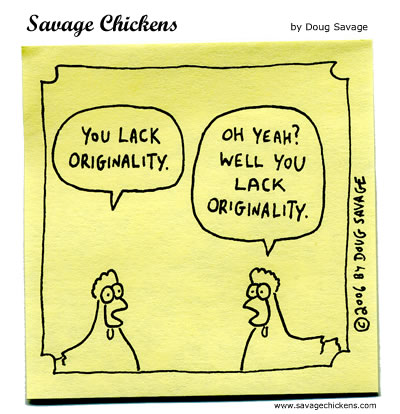
I'm a collector of best practices. I like to find out what forward thinking individuals and organizations have done to accomplish extraordinary results.
Sometimes I share these stories in my keynotes or workshops. Invariably, my stock rises when I tell these stories. People think I know stuff. They get giddy. They take notes. They think about how to adapt these best practices to their organization. But then things get weird.
People start becoming satisfied with emulating other people's lives. Instead of thinking up their own best practices, they imitate. Ouch!
The spirit of innovation gets replaced by the religion of innovation.
Gone is reflection. Gone is the process of discovery. Gone is the ownership that comes with birthing new insights. In it's place? Simulation. Imitation. And, all too often, the blind following of pre-packaged solutions.

I'm not saying there isn't value in paying attention to other people's best practices. There is.
But when when imitation replaces creation, something invariably gets lost -- and innovation eventually goes down the drain.
Idea Champions
My Keynotes
Cartoon
Create your own best practices
Posted by Mitch Ditkoff at 10:47 PM | Comments (2)
June 25, 2017Want to Vacation in Woodstock?

If you are looking for a great place to rent in Woodstock, NY, consider renting my home -- just a 12 minute walk to town. Mountain views. Peaceful. Gorgeous. A great place to rest, renew, and rejuvenate. Short- term or long-term rentals available. Click here for the full monte. Or send me an email: mitch@ideachampions.com
Posted by Mitch Ditkoff at 12:16 PM | Comments (0)
June 16, 2017Listen to Your Subconscious Mind

If you study the lives of people who have had Eureka moments, you'll discover that their breakthroughs almost always came after extended periods of intense, conscious effort.
They worked. They struggled. They abandoned all hope. They recommitted -- and then the breakthrough came. And often at the most unexpected of moments.
They weren't buying lottery tickets at their local deli, hoping to win a breakthrough fortune. They were digging for treasure in their own back yard.
Rene Descartes (Mr. "I-Think-Therefore-I-Am") got the Scientific Method revealed to him in a dream. Elias Howe arrived at the final design for the lock stitch sewing machine in a dream. Richard Wagner got the idea for his uber work, Das Rhinegold, while stepping onto a bus after long months of creative despair.
In other words, the conscious mind works overtime in an attempt to solve a problem or achieve a goal. Unable to come up with the solution, the challenge gets outsourced to the subconscious mind, which then proceeds to figure things out in its own, sweet time. Of course, all of this assumes we are listening to that still small voice of wisdom within us.
Well then, what's a not-so-still, left-brained, bottom-line-watching person to do if he or she wants to increase the odds of tapping into their inner Einstein.
Here's a start:
This week, keep a log of your most inspired ideas, intuitions, and dreams. When something pops for you (an inspired thought, an inkling, a sudden insight) write it down, even if it doesn't make sense. Then, at the end of the week, read your log. Look for clues. Notice patterns. Make new connections. See what insights come to mind. And be willing to share them with your peers.
Posted by Mitch Ditkoff at 11:48 PM | Comments (3)
May 26, 2017The Intersection of Innovation and Continuous Improvement

What does creative thinking and innovation have to do with continuous improvement? A lot. Two sides of the same coin.
Interview with Idea Champions' President, Mitch Ditkoff, on GoLeanSixSigma.
Focuses on the intersection of innovation and continuous improvement. Both are needed. Both are complementary.
Indeed, the Managing Partner and Executive Advisor of GoLeanSixSigma, Elisabeth Swan, was an Idea Champions consultant at one point in her storied career.
Posted by Mitch Ditkoff at 09:01 AM | Comments (0)
May 24, 2017Fail, Fail, the Gang's All Here
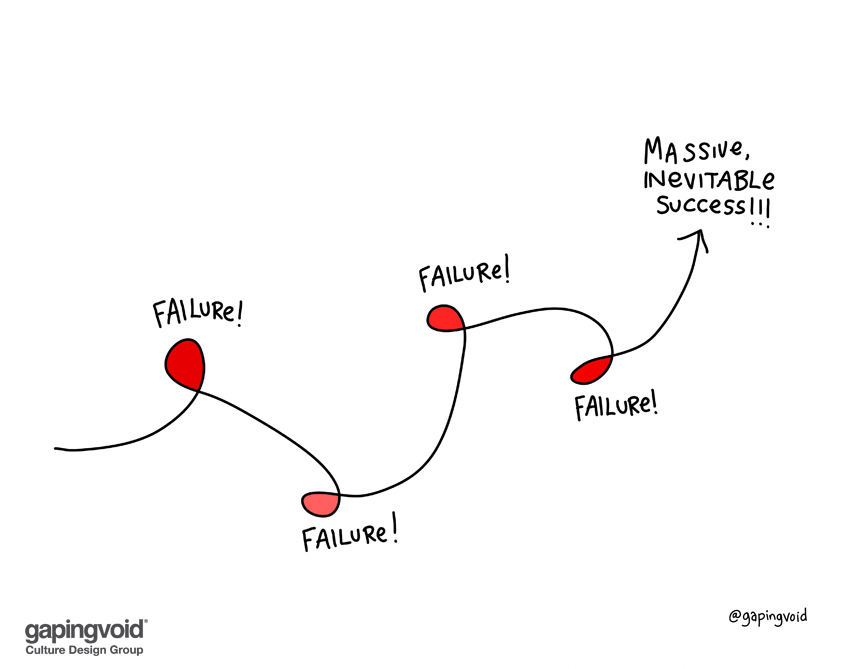
Illustration: GapingVoid
Great quotes on failure
MitchDitkoff.com
Posted by Mitch Ditkoff at 06:20 PM | Comments (0)
May 10, 2017If You Want to Innovate, Listen!
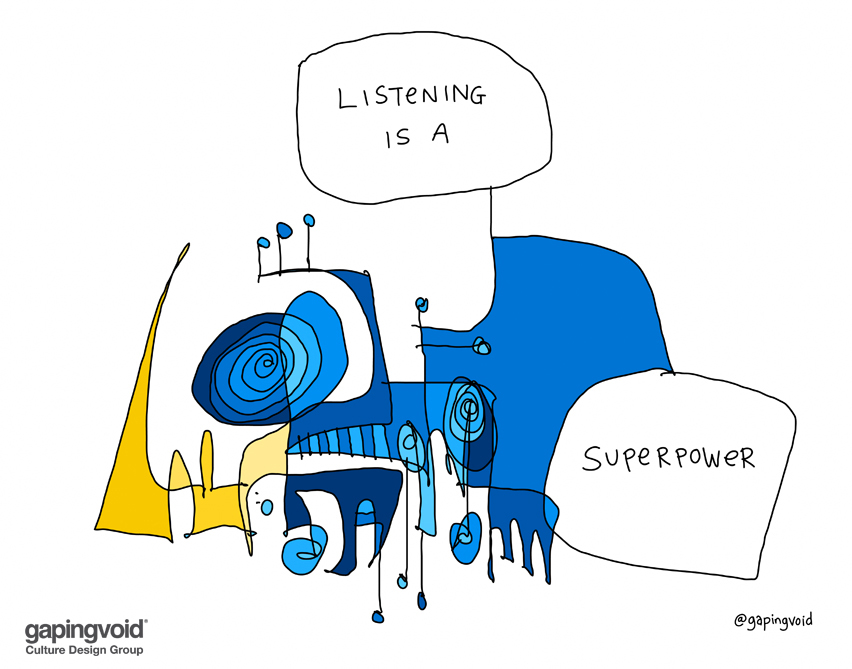
If you're interested in raising the bar for innovation in your organization, start listening more. Listening, quite simply, is the most powerful form of influence.
Generally speaking, when we think of influencing others we are thinking about our ability to get others to think and act in ways we want them to, in ways that serve our interests and objectives.
The influence process is most often conceived as the ability to provide compelling arguments -- that is, arguments that are indisputable and indicate there is only one way to proceed.
The influence process is seen as the ability to turn aside all alternative ways of thinking, to demonstrate their inadequacy in the service of making one's own position more compelling.
The ability to influence goes beyond the ability to make a compelling argument, of course. It can also involve the use of power, seduction, or fear to drive others to a particular outcome.
What is much more rarely recognized is the role of listening and empathy in the influence process.
Listening to what concerns and drives others provides a powerful basis for influence because it is by showing how your perspective will affect the concerns and interests of others that you gain others' interest and support.
But the case for listening and empathy goes much further.
If you can truly understand what others value and are concerned about, it can lead you to change your position about what is required to achieve the goals you are striving for.
If you deeply understand others, you can mobilize them, not by manipulation -- but by gearing your approach to address the real needs and interests of your stakeholders.
Listening and appreciating multiple viewpoints can help you gain more acceptance for your ideas and better ideas. And, as it all plays out, these better ideas will eventually attract more support and increase your influence -- so you can then listen more and attract more support.
-- Barry Gruenberg
Illustration: gapingvoid.com
Idea Champions
MitchDitkoff.com
Posted by Mitch Ditkoff at 09:45 AM | Comments (4)
May 04, 2017Need a Breakthough? Unplug for a Moment. Take a Break!

True innovators rarely follow the straight and narrow path. Not only do they march to a different drummer, they're often not even on the same playing field as most people. Take Seymour Cray, for example, the legendary designer of high-speed computers.
According to John Rollwagen, ex-chairman of Cray research, Seymour used to divide his time between building the next generation super computer and digging an underground tunnel below his Chippewa Falls house.
Cray's explanation of his tunnel digging behavior is consistent with the stories of many other creatives -- inner-directed, boundary-pushing people who understand the need to go off-line whenever they get stuck.
Bottom line, whenever they find themselves struggling with a thorny problem, they walk away from it for a while. They know, from years of practical experience, that more (i.e. obsession, analysis, effort) is often less (i.e ideas, solutions, results).
Explained Cray, "I work for three hours and then get stumped. So I quit and go to work in the tunnel. It takes me an hour or so to dig four inches and put in the boards. You see, I'm up in the Wisconsin woods, and there are elves in the woods. So when they see me leave, they come back into my office and solve all the problems I'm having. Then I go up (to my lab) and work some more."
Explained Rollwagen, "The real work happens when Seymour is in the tunnel."
We help people dig their tunnel
And sometimes we do this via storytelling (like the one above)
MitchDitkoff.com
Posted by Mitch Ditkoff at 09:55 PM | Comments (0)
May 01, 2017Blow the Minds of Your Customers
In what ways can you blow the minds of your customers this month? How can you exceed their expectations? How can you deliver the kind of off-the-grid service they will never forget? Check out what WestJet did. Whoa!
Posted by Mitch Ditkoff at 07:20 PM | Comments (1)
April 22, 2017FREE ONLINE POLL: How to Improve Your Company's Ideation Process

Here's the simplest way to figure out how to improve your company's ideation process: Enter Idea Champions' FREE IDEATION POLL CONTEST. Just send an email to office@ideachampions and write "Ideation Poll" in the subject line. We'll put your name in the proverbial hat on May 1st and, blindfolded, pick out three winners.
If YOU are one of the winners, we'll send you a link to our ideation poll which you, in turn, will forward to your workforce. A week after that we'll send you the results along with a some useful "food for thought". The value? You will better understand where the holes are in your company's idea generation bucket so you can patch them up or begin figuring out how to get a different bucket. Sneaky marketing shtick from us? None. Nada. Zero. Zilch.
What our clients say about us.
50 quotes on the power of ideas
More about ideation process
Posted by Mitch Ditkoff at 01:34 PM | Comments (0)
April 21, 2017Move the Hole!

I like what Edward deBono once said about the phenomenon of creative people trying to get results, but coming up empty (and I paraphrase). "If you are digging for oil and don't find any, move the hole!"
Pretty simple, eh? Sometimes, it seems as if aspiring innovators get fixated on a particular approach and, no matter what happens (or doesn't), they just keep doing the same old thing over and over again even when experience reveals that their approach is not working.
Of course, it's always possible that other factors are at play:
1. Perhaps the hole you've dug is too shallow and success is only a few shovelfuls away. Digger deeper, then, makes sense. Always possible.

2. Maybe you're digging in the right place, but the tools you're digging with are not the right tools for the job.
3. And, of course, it's always possible that in your effort to discover oil, you don't see the unexpected diamonds and gold coins you stumble upon because everything that is "not oil" is invisible to you.
So, let's make this real for a moment. Think of a project you are working on -- one you have passion for whose results have been slower to materialize than you hoped. Got it? Good. Now answer the following before doing any more digging:
CAN YOU DIG THIS?
1. What are your instincts telling you about how to proceed? Have you dug the hole deep enough? Might it be time for you to move the hole? And if it is the time to move the hole, where might you move it? What are some new approaches to try? Other places to look?
2. If you sense that you haven't dug deep enough -- that you've been a dilettante, slacker, or half-hearted digger for oil -- what can you do to martial your forces and commit to a more rigorous digging effort? And what support, if any, might you need?
3. If, in your digging adventures, you have stumbled upon some unexpected "finds", but dismissed them because you were only focused on oil, how might you extract the value from your accidental discoveries?
By the way, 75% of all product breakthroughs are NOT the result of strategic plans or "intentional effort", but the result of serendipity and "happy accidents" -- what happens when the open-minded innovator stumbles on something intriguing, pauses, and makes the right kind of effort to see if this discovery has value and is worth pursuing.
Posted by Mitch Ditkoff at 02:07 PM | Comments (0)
April 16, 201714 Ways to Get Breakthrough Ideas
There's a lot of talk these days about the importance of innovation. All CEOs worth their low salt lunch want it. And they want it, of course, now.
What sparks innovation? People. What sparks people? Inspired ideas that meet a need, whether expressed or unexpressed -- ideas with enough mojo to rally sustained support. Is there anything a person can do -- beyond caffeine, corporate pep talks, or astrology readings -- to quicken the appearance of breakthrough ideas?
Yes, there is. And what follows are 14 catalysts -- simple guidelines, principles, and approaches that will help you on your way.
1. FOLLOW YOUR FASCINATION
If you find yourself fascinated by a new idea, chances are good that there's something meaningful about it for you to consider. Fascination, quite simply, is nature's way of getting our attention. Well beyond seduction or attraction, it's an indication that we are being called. Out of the thousands of ideas with the power to capture our imagination, the felt fascination for one of them is a clue that there's something worthy of our engagement.
Don't dismiss it as trivial. Give it room. Give it time to breathe. Honor it. If you have any doubt, consider the origins of the word "fascination". It comes from the Latin "fascinus," meaning to be "enchanted or delighted."
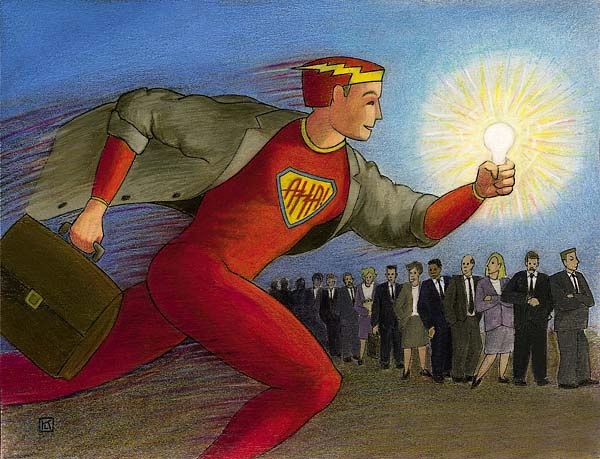
What enchants or delights us is sacred -- or could be sacred -- a clue that something significant is knocking on our door. Indeed, if we are willing to let fascination grow inside us, a kind of immaculate conception can occur, the illogical, miraculous becoming pregnant with possibility -- the bodily expression of the phenomenon that you are here to birth something extraordinary.
The idea is simply the first "waaaaaaah" to get you to notice.
What new idea is fascinating you? What new possibility has captured your attention? In what ways can you honor this inspiration today?
2. IMMERSE
Breakthrough ideas, like telemarketers or Jehovah's Witnesses, have a curious habit of showing up at odd times. And because they do, we're not always ready to receive them. To complicate matters, chances are good that when they do show up, we are multi-tracking our little tushies off -- checking email, microwaving dinner, or looking for our Smart Phone amidst the half-folded laundry. Not exactly the pre-conditions for breakthrough.
The alternative? Immersion -- the act of becoming completely involved or absorbed in something -- engrossed, enthralled, or preoccupied."
If you want to radically increase your odds of originating breakthrough ideas, you will need to immerse. Don't be a chicken, be a hen! Baby chicks break through the shell separating them from flight not because their mothers are rushing off to meetings on parenting skills, but because their mothers are immersed in the act of hatching. Mommy is sitting in one place for a looooooooong time. And baby chick is also sitting (curled up) in one place for a looooooooong time.
At Google, employees are given 20% of their time to immerse in projects that have nothing seemingly to do with their so-called day job. At 3M, it's 15%. W.L. Gore gives employees a half a day each week to immerse in projects that fascinate them.
Look at your calendar. Block out some time to focus on the development of your most inspired idea or venture. Unplug! Incubate! Hatch! Immerse!
3. TOLERATE AMBIGUITY
Breakthrough ideas are not always the result of a revolutionary Eureka moment. On the contrary, they are often the result of an evolutionary series of approximations or failed experiments. When Thomas Edison was asked how it felt to fail 800 times before coming up with tungsten as the filament for the light bulb, his answer was a revealing one.
"Fail?" he said. "I didn't fail once. I learned 800 times what didn't work."
Edison had the ability to tolerate ambiguity -- to "not know." Like most breakthrough thinkers, he had the ability to dwell in the grey zone. Confusion was not his enemy.
"Confusion," explained Henry Miller, "is simply a word we have invented for an order that is not yet understood."
If you are attempting to birth a breakthrough idea, get comfortable with discomfort. Give up your addiction to having all your ducks in a row, at least in the beginning of your discovery process. People may think you're a quack, but so what? Your chances of birthing a breakthrough idea (and result) exponentially increase the more you are able to tolerate ambiguity.
What new idea of yours is bubbling on the brink of breakthrough? In what ways can you stay with it, even if something in you is impatient for a breakthrough?

4. MAKE NEW CONNECTIONS
True creativity rarely happens in a vacuum. On the contrary it is the product of two or more variables connecting in a new way. It happens all of the time in nature. Water, for example, is really just the connection between hydrogen and oxygen. It happens in the human realm as well. Roller blading is nothing more than the connection between ice skating and roller skating. MTV? Nothing more than the connection between music and television. Drive in banking? Car + banking.
The originators of these breakthrough products didn't pull rabbits out of hats. All they did was see a new, intriguing (and potentially commercial) connection between already existing elements.
Why don't more of us make these kinds of connections? Because we usually stay within the confines of what we already know. We live in a box of our own creation -- whether that box be defined by our nationality, profession, concepts, cubicle, or astrological sign.
The more we are willing to get out of this box, the more likely it will be that powerful new connections will reveal themselves to us -- uncommon linkages between this, that, and the other thing -- kind of the way it was for Johannes Gutenberg when he noticed a previously undetected connection between the wine press and coin punch. And so the printing press was born.
Make three parallel lists of ten words. The first list? Nouns. The second list? Verbs. The third list? Adjectives. Then look for intriguing new connections between them.
5. FANTASIZE
In 1989, Gary Kasparov, the Soviet Union Grand Chess Master, played a two game match against "Deep Blue," the reigning supercomputer of the time. Kasparov won easily. When asked by the media what his competitive advantage was, he cited two things: intuition and the ability to fantasize. (And this, from a master strategic thinker!)
Few of us are ever encouraged to fantasize -- a behavior most commonly associated with children or perverts. And yet, fantasizing is exactly how many breakthrough ideas get their start -- by some maverick, flake, or dreamer entertaining the seemingly impossible.
I find it curious that business leaders want their employees to come up with fantastic ideas or solutions, but they don't want their employees to fantasize. And yet, the words "fantastic" and "fantasy" come from the same linguistic root, meaning to "use the imagination."
Think of a current challenge of yours. What would a fantasy solution to this challenge look like? What clues does this fantasy solution give you?
6. DEFINE THE RIGHT CHALLENGE
"It's not that they can't find the solution," said G.K. Chesterton, the renowned American philosopher and writer, "They can't find the problem!"
Translation? Most people, in their rush to figure things out, rarely spend enough time framing their challenge in a meaningful way. If they owned a GPS, they'd fail to take the time to program in their destination because they were so much into the hustle of getting out of town. Coming up with the right question is at least half of getting the right answer.
If you want a breakthrough idea, begin by coming up with a breakthrough question -- one that communicates the essence of what you're trying to create.
State your most inspired challenge or opportunity as a question beginning with words "How can I?" Then write it three different ways. Which is your real question?

7. LISTEN TO YOUR SUBCONSCIOUS
If you study the lives of people who have had Eureka moments, you'll note that their breakthroughs almost always came after extensive periods of intense, conscious effort. They worked, they struggled, they noodled, they gave up, they recommitted -- and then the breakthrough came. And often at unexpected moments. They weren't buying lottery tickets at their local deli, hoping to win a breakthrough fortune, they were digging for treasure in their own back yard.
Rene Descartes got the idea for the Scientific Method in a dream. Richard Wagner got the idea for Das Rhinegold while stepping onto a bus after long months of creative despair. Einstein used to conduct "thought experiments" (a fancy name for daydreaming) whenever he got stuck.
In other words, the conscious mind works overtime in an attempt to solve a problem or achieve a goal. Unable to come up with the breakthrough, the challenge gets turned over to the subconscious mind which then proceeds to figure it out in its own, sweet time.
Of course, all of this assumes that we are listening to the promptings of our subconscious mind.
This week, keep a log of your most inspired ideas, intuitions, and dreams. At the end of the week, review your log. See what insights come to you.
8. TAKE A BREAK
If you want a breakthrough, you will need to take a break. True innovators rarely follow the straight and narrow path. Not only do they march to a different drummer, they're often not even on the same playing field as most people.
Take Seymour Cray, for example, the legendary designer of high-speed computers. He used to divide his time between building the next generation super computer and digging an underground tunnel below his Chippewa Falls house. Cray's explanation of his tunnel digging behavior is consistent with the stories of many other creatives -- inner-directed, boundary-pushing people who understand the need to go off-line whenever they get stuck.
Bottom line, whenever they find themselves struggling with a thorny problem, they walk away from it for a while. They know, from years of experience, that more (i.e. obsession, analysis, effort) is often less (i.e. ideas, solutions, results).
Explained Cray, "I work for three hours and then get stumped. So I quit and go to work in the tunnel. It takes me an hour or so to dig four inches and put in the boards. You see, I'm up in the Wisconsin woods, and there are elves in the woods. So when they see me leave, they come back into my office and solve all the problems I'm having. Then I go up (to my lab) and work some more."
Next time you find yourself stuck on a thorny problem or project, walk away from it for a while. Stay conscious of new solutions coming to you during this down time.
9. NOTICE AND CHALLENGE PATTERNS AND TRENDS
There are many people these days who make their living from the pattern recognition business: futurists, meteorologists, air traffic controllers, and stock brokers just to name a few. And while their success rates may not always be 100%, it is clear that whatever success they enjoy is intimately tied to their ability to notice patterns and then interpret those patterns correctly for the rest of us.
The same holds true for breakthrough thinkers. The only difference? Breakthrough thinkers often hit the gravy train by challenging old patterns and then reconfiguring them in new ways.
"The act of creation," said Picasso, "is first of all an act of destruction."
"The genius," said American painter, Ben Shahn, "is merely the one able to detect the pattern amidst the confusion of details just a little sooner than the average man."
What trends in the marketplace most intrigues you? In what ways might these trends shift in the coming years -- and how might your most inspired idea be in sync with this imagined shift?

10. HANG OUT WITH A DIVERSE GROUP OF PEOPLE
Years ago Sony used to insist that their engineers spend at least 25% of their work time out of the office and mixing it up with people outside of the four walls of their industry. Keepers of the innovation flame at Sony understood that diverse inputs were essential to the origination and development of breakthrough ideas.
Unfortunately, most of us tend to stay within the intellectual ghettos of the familiar. We hang out with the same people day and night -- usually people who either agree with us, report to us or, through some indefinable act of karma, are joined to us at the hip.
If you want to increase your chances of getting a breakthrough idea, you will need to break the bonds of the familiar. Hang out with a different crowd. Go beyond the usual suspects. Seek the input of oddballs, mavericks, outcasts, or, at the very least, people outside your field. If you can let go of your need for comfort and agreement, you will find yourself catapulted into new ways of seeing, thinking, and acting -- all precursors to breakthrough ideas.
Make a list of ten people outside of your traditional posse that you can spend some time with this month.
11. BRAINSTORM
Breakthrough thinkers are often rugged individualists. They believe in their inalienable rights to think for themselves. They value their opinions, their perspectives, and their innate creativity. Their biggest fear is group think. All well and good.
But there is an important distinction to be made between group think and the phenomenon of inspired individuals getting together to spark each other's brilliance. Indeed, most great breakthroughs are more about inspired collaborations than they are about lone wolf genius.
Think Bill Gates and Paul Allen (Microsoft), Steve Jobs and Steve Wozniak (Apple), Sergey Brin and Larry Page (Google), David Filo and Jerry Yang (Yahoo), Watson and Crick (DNA), Lennon and McCartney (the Beatles), Hewlett & Packard.
All you need to do is frame a meaningful question, invite the right people, and facilitate the process for helping your think tank creatively jam. If you are not the right person to facilitate, you probably know someone who is. Ask them.
What is the topic of your next group brainstorm? Who will you invite? Who will facilitate? When?
12. LOOK FOR HAPPY ACCIDENTS
Breakthrough ideas are often less about the purposeful act of inventing new things that it is the art of noticing new things that happen accidentally -- those surprise moments when the answer is revealed for no particular reason.
The discovery of penicillin, for example, was the result of Alexander Fleming noting the formation of mold on the side of a Petri dish left unattended overnight. Vulcanized rubber was discovered in 1839 when Charles Goodyear accidentally dropped a lump of the polymer substance he was experimenting with onto his wife's cook stove.
Breakthroughs aren't always about inventions, but about the intervention required to notice something new, unexpected, and intriguing. For this to happen, you will need to let go of your expectations and assumptions and get curious. Give up being an expert. Let go of the past. See with new eyes.
What failed experiment or unexpected outcome might be interesting for you to reconsider?

13. USE CREATIVE THINKING TECHNIQUES
I live in the Northeast. In the Winter, it's common for old cars, especially on very cold mornings, not to start. When this happens, the best thing you can do is get a jump start. All you need are jumper cables and another car that's got its motor running.
Creative thinking techniques are like jumper cables. They spark ignition. They turn potential into kinetic energy. They get you going when you're stuck. If you're looking for a breakthrough idea, perhaps all you need is a jump start. That jump start can take many shapes. It can be a classic, creative thinking technique, of which there are many. It could be a "creative thinking coach" or a favorite book, or a quote. Ultimately, it doesn't matter what medium you choose, just as long as you choose something to get your motor running.
What is one creative thinking technique you might use the next time you need a jump start on the job?
14. SUSPEND LOGIC
Perhaps Einstein said it best when he declared: "Not everything that can be counted counts; and not everything that counts can be counted."
He was referring, of course, to the part of the human being that knows intuitively -- the part that is tuned in, connected, and innately creative. Kids live in this place. The rest of us just visit, preferring the left-brained world of rationality, logic, linearity, and analysis.
On some primal level, we're all from Missouri. We need proof. And while there is nothing inherently wrong with gathering data, the addiction to it subverts our ability to originate breakthrough ideas.
We know this. That's why we go to the movies, the pub, watch TV, read novels, dial 900 numbers, and daydream. We seek an altered state, one that is free of the normal gravity of daily life. That's why movie makers ask us to suspend disbelief. That's why brainstorm facilitators ask us to suspend judgment. That's why women (innately intuitive as they are) ask the men in their lives to stop being so damn practical for a change and actually feel something.
It is in this state of suspension that our innate creativity is free to percolate to the surface -- over, under and around all of the left brained guardians at the gate. And so... if you want to really birth a breakthrough idea, you too will need to enter into this state -- at least in the first phases of your new venture. Suspend judgment. Suspend evaluation. Suspend your addiction to the practical. What exists on the other side is fuel for the fire of your untapped creativity.
What can you do this week to suspend practicality, logic and rationality in service to birthing your big idea?
Posted by Mitch Ditkoff at 04:39 AM | Comments (1)
April 14, 2017Listening is a Superpower
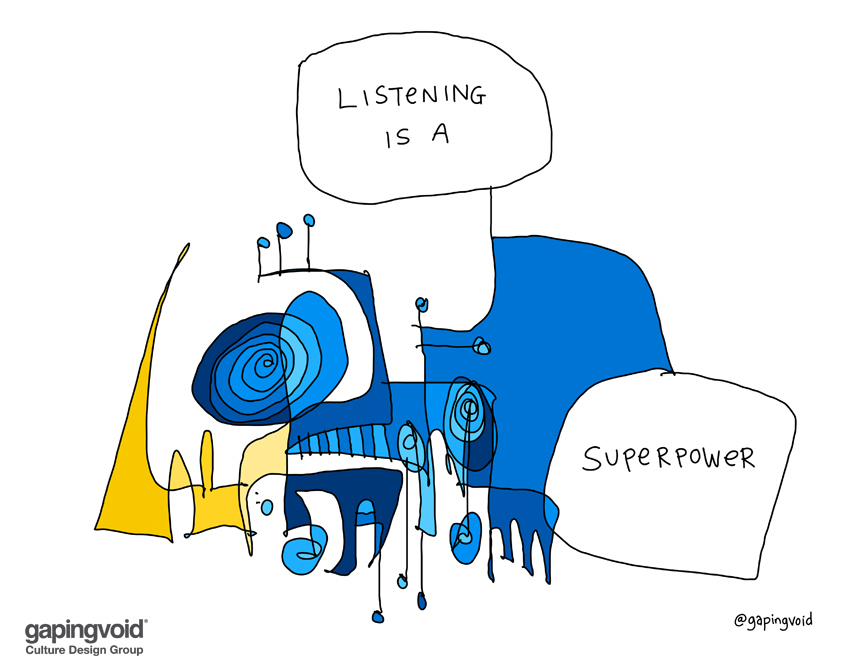
As an innovation provocateur and storyteller, I am continually fascinated at how rare real listening is in most organizations. Everyone seems to be moving so fast or just WAITING for their turn to speak, that real listening rarely happens. Methinks, it goes all the way back to our childhood where we were deeply appreciated for speaking our first word, but never appreciated for the first time we listened.
24 quotes on good communication
Illustration: gapingvoid.com
MitchDitkoff.com
Posted by Mitch Ditkoff at 09:00 AM | Comments (0)
March 13, 2017The Man Behind The Heart of Innovation and His Daughter

A story about Emilia when she was 13
Storytelling and daughters
Idea Champions
Posted by Mitch Ditkoff at 06:59 PM | Comments (0)
March 10, 2017Making the Time to Be Creative
One of the biggest obstacles to creativity and, by extension, innovation, is the lack of time that is so prevalent in today's ADD culture. This two-minute video makes a very compelling case for you and all the people you work with to take some more time if you REALLY want to crank up the creativity.
25 quotes on creativity
Idea Champions
Posted by Mitch Ditkoff at 09:26 AM | Comments (0)
March 02, 201720 Ways to Get Feedback on Your Coolest, Newest, Boldest Idea

You've got a great idea. I know you do. But I also know it's just sitting there. In your head. Like a lump. Why? Because you haven't pitched it to anyone.
Everyone -- even your best friends -- all seem so busy, right? And even if they're not busy, you... um....er... uh... don't really know how to kick-start the conversation to get them to help you develop your idea. The hardest part? Beginning. And so, here's a way to start -- actually, 20 ways to start -- phrases you can use to increase the odds of someone giving you the feedback you need to develop your bold, new idea.
Go ahead. Get your idea out there. Invite someone to give you feedback. You can do this.
20 IDEA FEEDBACK STARTERS
1. "I wonder if you have a few minutes to give me some feedback on a new idea of mine. Is this a good time?"
2. "I'd love your opinion about a new idea that really excites me. Got five minutes to spare?"
3. "I just had a big breakthrough. Mind if I share it with you?"
4. "I need a second opinion on a new idea of mine. Available?"
5. "Can I book some time with you tomorrow to pitch you a bold, new idea of mine. I think you'll find it inspiring."
6. "I just figured out how to _________. Can I share it with you?"
7. "I'd love your sage counsel on a new project of mine."
8. "You're one of the smartest people I know around here. Mind if I share a new idea with you?"
9. "Who do you recommend I talk with around here to help me develop an exciting idea of mine?"
10. "I got a deal for you. I'll buy you breakfast tomorrow if you give me some feedback on a bold, new idea that came to me last night."
11. "I'd love you to play devil's advocate with me for a few minutes. Mind if I pitch you a new idea of mine?"
12. "When would be a good time for the two of us to get together and brainstorm an idea with the power to change our industry?"
13. "I need you help. I really do. Can you help me think through a new and untested idea of mine?"
14. "I've got a great idea that I'm really confused about. Can you help me sort it out?"
15. "Everyone I talk to tells me you're the resident genius around here. Mind if I pitch you a great idea that needs some polishing?"
16. "Would you be open to being my coach? I've got an awesome idea that's kind of flapping in the wind."
17. "If you've got five minutes, I'd love your help thinking through a great, new possibility."
18. "Can I take you to lunch today to help me refine a new idea?"
19. "Got 60 seconds to give me some feedback?"
20. "If you give me your feedback on my latest idea, I promise to name my tenth child after you. Ready?"
Posted by Mitch Ditkoff at 02:22 PM | Comments (2)
March 01, 2017A BEGINNER'S GUIDE TO HELPING ORPHANS: One Man's Journey

There are 140 million orphans in the world. That's 14 million more than the entire population of Japan. And it's getting worse with every war, earthquake, and disaster. If you want to read the story of how one man is making a difference in this little understood arena and what YOU can do to begin getting involved, click here. And if you want to do something about it today, consider making a donation to the Himalayan Children's Charity -- a fantastic organization that is attempting to raise $10,000 to continue providing a wide range of services to orphans in Nepal.
Posted by Mitch Ditkoff at 02:37 AM | Comments (0)
February 25, 2017NOW IS THE TIME TO BEGIN!

20 awesome quotes on beginning
Awesome illustration: Gaping Void
Idea Champions
Posted by Mitch Ditkoff at 03:35 PM | Comments (0)
February 20, 2017Unresolved Conflict at the Top Produces Chaos in the Middle and the Bottom

A guest post by Idea Champions' newest leadership development consultant, Dr. Barry Gruenberg.
When those in senior leadership positions avoid conflict among themselves, the unresolved conflict ripples throughout the organization and paralyzes action at every level. Key issues go unresolved and the tension at the top pervades the organization. Followers of each of the powerful protagonists must constantly demonstrate their loyalty to their sponsors in their words and deeds; they must scrutinize all that they do to ensure that they are not seen as violating the party line.
Lower level employees are often enlisted to participate in task forces or committees to deal with the various by-products of the unresolved issues.
These efforts are virtually guaranteed to fail since any recommendations for resolution will compromise at least one of the contending senior managers who will usually use their power to veto the idea, leaving the task force frustrated and progress hindered.

This is ironic because the members of the task force will have attempted to remain loyal to their constituency throughout the proceedings and will usually feel that they have salvaged the most important interests of their group in the negotiation process. But the senior managers, who have delegated their conflict, will generally take an all or nothing posture on the outcome.
The only true resolution to this phenomenon requires the direct participation of the protagonists -- their committed effort to resolve their differences before the symptoms of their misalignment irrevocably muddies the organizational waters.
Idea Champions
Becoming an Adaptive Leader
Listening With Impact
Posted by Mitch Ditkoff at 09:07 AM | Comments (0)
December 11, 2016100 Days of Rejection
Entertaining and inspiring 15 minute TED talk about a fascinating experiment launched by a young entrepreneur and what he learned about how to turn rejection into opportunities.
Idea Champions
Storytelling at Work
Posted by Mitch Ditkoff at 05:56 PM | Comments (0)
November 22, 2016Time Is an Invented Thing. Invent It!
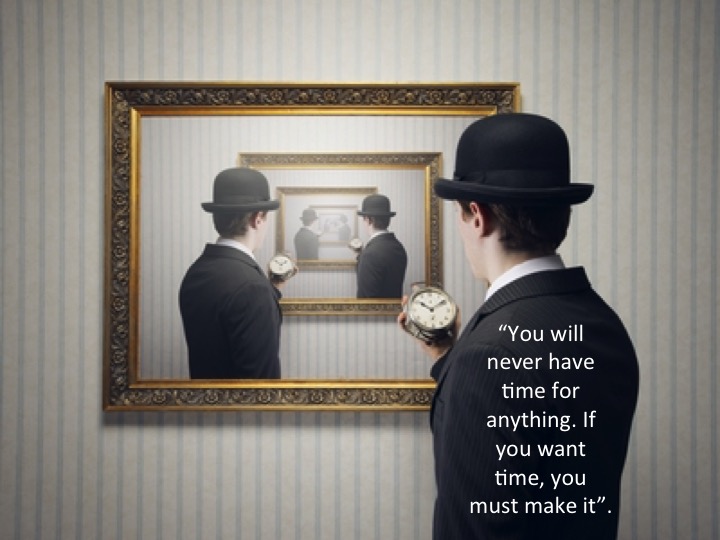
Reality check time. What do YOU need to make more time for? And WHEN will you make it?
Idea Champions
What's your story?
Posted by Mitch Ditkoff at 06:05 PM | Comments (0)
November 20, 2016Click Through to Kindness

HERE'S AN INTERESTING STATISTIC: The "click through" rate on negative headlines is 65% higher than positive headlines. People are far more curious about the negative than the positive. Parents, by the way, respond to their children with 10 times more "NO" statements than "YES" statements. No wonder why so many movies and TV shows are so full of conflict, violence, negativity, and scandal.
Actually, I am not all that surprised. The fairy tales we grew up on all have a dark side (the monster, the demon, the boogeyman) and kids want their parents telling those same stories over and over again.
On some level, its not just voyeurism or obsession -- it's catharsis -- part of our cellular journey, going from darkness to light.

That being said, there's a cultural tipping point to all of this, whereby too many of us are focusing only on the glass being half empty and calling our conclusions "social activism" or "being realistic". Methinks, a better balance is required -- the ability to keep our eyes open to the destructive forces so we can respond in intelligent ways, but WITHOUT becoming negativity junkies, losing our center, our sense of the possible, and the kind of personal, daily renewal required to be IN the world, but not OF the world.
Remember, the LOTUS grows in the MUDDIEST of waters. Moving out of the country is not the answer, nor is hiding in our houses. Conversely, demonizing the "other" creates only reactivity and resistance. There is a middle path here, folks and we have not yet found it.
Remember, there are some extraordinary exemplars in human history of those who have taken the high road: Gandhi, Martin Luther King, Jesus and many, many others who no one has ever heard about -- maybe even the person sitting next to you on the bus.
Ultimately, it gets down to each breath, each thought, and each action. We have a choice every moment of the day. I like what Buddha supposedly said about the mind (and I paraphrase) "There are approximately 2,000 thoughts every second. I have slowed my mind down enough to be able to tell you what the last two were."
My question to you is this -- something Gandhi suggested: "How can you be the change you want to see in the world?"
And getting down to the bare basics... how can you, in your home life, work life, and community life, be an embodiment of the kind of clarity, kindness, compassion, wisdom, and honesty you'd like to see our so-called leaders embody?
PS: Just saw this great quote from Prem Rawat on a friend's FB feed: "Fight the fight you want, yes. Be a warrior for justice and peace, but first, fill your own cup with joy or you're not going to be clear and able to accomplish much to make the world a better place."
Photos: Jesse Ditkoff
International Day of Compassion and Kindness
Tell a different story
Idea Champions
Posted by Mitch Ditkoff at 07:07 PM | Comments (0)
October 29, 2016How to Sell Without Selling
 A few years ago, my wife and I bought a Turkish rug from Mehmet, Istanbul's Steve Jobs of rug merchants.
A few years ago, my wife and I bought a Turkish rug from Mehmet, Istanbul's Steve Jobs of rug merchants.
If I could run my company as well he could sell, I'd be a very wealthy man.
Technically, speaking, Mehmet didn't really sell us anything. He simply created the conditions that allowed us to buy (which some people, I know, will think is really just a clever form of selling, but it wasn't.)
How did Mehmet work his magic, when all we did was sit down at his cafe to drink some coffee with no conscious desire to buy a rug?
MEHMET'S MAGIC
1. He effortlessly established rapport
2. He gave us all the space we needed
3. He shared his knowledge with great feeling
4. He had beautiful rugs and knew them better than most people know themselves
5. He loved what he did
6. He had a wonderful sense of humor
7. He had kind eyes and a big heart
8. He conducted the transaction in the spirit of service
9. He asked us how much we thought the rug was worth and then sold it to us for less.
10. He knew what he was doing and he did it with the perfect blend of flair and humility.
Take a moment to think about the way that you currently sell your product or services. If it's not going quite as well as you'd like, ask yourself: "What can I learn from Mehmet the Rug Merchant?"
Posted by Mitch Ditkoff at 01:09 AM | Comments (2)
October 11, 2016You Suck at Powerpoint!
Posted by Mitch Ditkoff at 06:33 PM | Comments (0)
October 07, 2016It All Began With Balls
Here's a fun, 7-minute story about Idea Champions big breakthrough soon after we started the business -- inspiration for YOU to do something different, provide your clients an EXPERIENCE, and have some fun along the way. "If you always do what you've always done, you'll always get what you've always got."
This story in the Huffington Post
Excerpted from this book
Posted by Mitch Ditkoff at 07:59 AM | Comments (0)
September 27, 2016Millennials in the Workplace
While this video is a bit over the top and stereotypical, it does have the potential to spark some useful dialogue about the challenge of fully engaging Millennials in a way that works for everyone. The good news? Idea Champions is in the process of developing a very cool workshop for organizations committed to finding new and better ways of tapping into the brilliance of Millennials. Just leave your name and contact info below if you'd like us to let you know when the workshop is ready for prime time.
Idea Champions
Posted by Mitch Ditkoff at 12:00 PM | Comments (0)
September 09, 2016Finished, Not Perfect
Posted by Mitch Ditkoff at 05:36 AM | Comments (0)
August 30, 2016I Am Not a Handyman

Are you a man -- or know a man who is, shall we say, "handyman challenged"? If so, then this newly published Huffington Post article of mine, is for you. Three minutes worth of comic relief. If you like it, please LIKE it and forward the link to your friends. Let's go viral!
90 other HuffPost articles of mine
My day job
Storytelling at Work
Posted by Mitch Ditkoff at 09:54 AM | Comments (0)
July 30, 2016Why Your Organization Needs to Create a Culture of Storytelling
Why create a culture of storytelling?
Storytelling videos, interviews and articles
Sparking innovation via storytelling
Idea Champions
Posted by Mitch Ditkoff at 10:42 AM | Comments (0)
June 17, 2016JUST SAY YES!

Idea Champions is thrilled to welcome Dr. Barry Gruenberg to it's team of consultants, facilitators, and bloggers. Here is Barry's latest pearl of wisdom.
When somebody asks you if you can do something, just say YES. You can always figure out how later. Indeed there is a good chance that what you are being asked for is not what's really needed, anyway.
We often evaluate the value we can add to a situation by imagining that there is someone else who really has the required expertise. We interpret our uncertainty as a testimonial to our inadequacy as compared to the imagined expertise of the presumed, all-knowing other.
Actually, our uncertainty and humility are essential elements of what we bring to the party; they drive our curiosity about what is really going on and help us listen to multiple points of view on the problem without having preconceived ideas about solutions.
Developing a deep understanding of what a problem truly consists of is a much more valuable contribution than providing a pre-conceived solution; devising solutions is easy once we have a robust problem statement.
The problem with high levels of expertise?
1. When you have a hammer, everything looks like a nail
2. If you have to appear as an expert, you have little opportunity to learn anything new.
In today's world, characterized by unprecedented new technologies and business models, we are much more likely to find ourselves facing adaptive challenges that require new ways of thinking and acting. So embrace your ignorance and go for it!
Barry's workshop on listening
Idea Champions
Barry on what leaders can do to foster innovation
Posted by Mitch Ditkoff at 09:38 AM | Comments (0)
June 07, 2016HOW TO GET PEOPLE OUT OF THE BOX: A 5-Minute Tutorial

Ever heard the expression "get out of the box?" Of course you have. Ever wonder what the six sides of that so-called box actually are? If not, here's your 5-minute tutorial of the day. Once you're clear about what the sides of the box are, you will be significantly more able to help people (and yourself) get out of it.
One way to get out of the box
Another way
My book on the subject
Boxes
Posted by Mitch Ditkoff at 11:24 AM | Comments (0)
April 18, 2016The Curious Origins of the Stop Sign

I've been doing some fascinating research lately on the origins of common objects in our lives -- things we see daily, but often take for granted. Like the Stop Sign, for example.
Most people think the Stop Sign was created to regulate traffic. Not true. According to Dr. Ellison Burke of the Global Institute for Slowing Things Down Before You Hurt Yourself, the origin of the Stop Sign has nothing to do with traffic -- and dates back several thousand years.
Historical references to the Stop Sign have been noted in more than 27 civilizations, most notably Babylonia, Egypt, Mesopotamia, Sumeria, Crete, Rome, and the Han Dynasty.

According to social scientists, each of these civilizations experienced one or more periods of rapid growth now referred to in the literature as "Societal Acceleration Syndrome" -- the way in which daily transactions speed up in proportion to a civilization's escalating Gross National Product.
In other words, speed has become one of the most statistically predicable indicators of a civilization's development and, as I will note later in this article, eventual decline.
My research doesn't end here, however. In each of the above-mentioned civilizations, there have always been a small, but vocal group of citizens who -- concerned about the quickening pace of daily life -- have warned the masses about this dangerous phenomenon.
Indeed, a joint longitudinal study conducted by the Yukon Archeological Institute and the Asian Society for Shorter Haiku, has revealed that this "small, but highly committed group of socially responsible citizens" has made repeated efforts to diffuse their respective society's "escalating addiction to velocity."
In Sumeria, for example, a fringe group of philosophers and poets routinely posted "Styopsian" signs at strategic intersections throughout the country -- not to stop traffic, but to stop unnecessary "mind movement."
Their effort resonated with the citizenry and eventually led to the widespread appearance of what modern day sociologists now refer to as "stop signs" -- in urban centers, villages, cattle crossings, and universities.
One of the most curious facts I've unearthed in my research is this: For the past 2,000 years, Stop Signs, regardless of the country of origin, have always been octagonal.
Apparently, each side of this iconic 8-sided, cross-cultural symbol for stillness, has been imbued with a secret teaching of great import:

1. Slow down
2. Pay attention
3. Look around
4. Pause
5. Look within
6. Breathe deeply
7. Appreciate
8. Move consciously
And so... the next time you see a Stop Sign, you may want to remember that you, no matter where you think you're going or how quickly you need to get there are, in fact, in the act of receiving one of the most timeless of teachings -- one that preceded Facebook, Instagram, Snapchat, texting, and Donald Trump tweeting in the middle of the night.
Next week... the YIELD SIGN.
ED NOTE: It has recently come to my attention that some readers of this blog have questioned my research methods and the veracity of my findings. A quick Google search of "Dr. Ellison Burke" and the "Global Institute for Cross-Cultural Studies," they claim, reveals not a single link. Frankly, I am baffled by their assertions and have assigned five of my brightest research assistants to get to the bottom of the matter. In the meantime, as I put to rest the niggling, naysaying deflections of my detractors, you may want to contemplate the timeless words of modern-day social scientists, Simon and Garfunkel: "Slow down, you're moving too fast, you gotta make the morning last."
This story NOT included in this book
This story NOT included in this website
This story NOT included in this training
Stop Signs 'R Us
Posted by Mitch Ditkoff at 12:12 AM | Comments (5)
April 06, 2016When There's Only 4 Seconds Left
Sometimes, it seems as if the game is over, that time is running out -- but WAIT! It ain't over til it's over! No way! Kris Jenkins drains a long range jumper at the buzzer and Villanova wins the NCAA National Championship! Bedlam ensues! (PS: YOU still have at least four metaphorical seconds left. Go for it! Take the shot! Swish!)
I'm taking my shot
Quotes to help you take YOUR shot
Idea Champions
Posted by Mitch Ditkoff at 04:14 PM | Comments (0)
April 04, 2016The Crowdsourced Birth of a New Book Beyond Business Innovation
Greetings! It's me, Mitch Ditkoff, author of this blog, President of Idea Champions, writer, speaker, husband, father, and dust particle. If you've been enjoying this blog, there is a good chance you will enjoy my forthcoming book. Towards that end, I have just launched a GoFundMe campaign and am inviting you to participate. We're talking crowd-sourced funding -- a way for me to buy the time and resources I need to write, produce, publish, and promote the book before hell freezes over. Hope you can be part of it! It takes a village... and a few village idiots!
Click here to find out more
Click here if you don't want to find out more
Posted by Mitch Ditkoff at 02:51 PM | Comments (0)
March 02, 2016WOOF! Go Beyond Your Pet Ideas!

If your company runs brainstorming sessions, know this: too many of them have become veiled opportunities for people to trot out their pet ideas.
Because everyone is so ridiculously busy these days and real listening is at a premium, people use brainstorming sessions as a way to foist their pre-existing ideas on others.
And while this sometimes leads to results, it doesn't make best use of the opportunity a brainstorm session provides. The way around this phenomenon?
Give people a chance to express their pre-existing ideas at the beginning of a session. Clear the decks. Then use the rest of the time to explore the unknown. Woof! Woof!
High Velocity Brainstorming
Conducting Genius
Idea Champions
Posted by Mitch Ditkoff at 07:48 AM | Comments (2)
February 21, 2016Non-Judgmental Listening as a Catalyst for Innovation

If there is person in your life who is on the cusp of a breakthrough, big idea, or simply struggling to figure something out, there is one thing you can do that will be supremely helpful. It has nothing to do with your good ideas, insights, or intuitions, of which you probably have many. It has everything to do with your ability to listen non-judgmentally.
Being listened to is what aspiring innovators need the most, but it is often what they get the least. Well-meaning friends, spouses, and colleagues assume that their advice, ideas, and suggestions are what's needed when, in fact, their advice, ideas, and suggestions are either uninvited, poorly timed, or overwhelming.
It's a bit like that old saw: the best way to tame a horse is to give it a big meadow in which to run.
The aspiring innovators in your life need a big meadow, not your big ideas -- and it is your listening that creates the meadow.
Creative thinkers need space to roam, wander, and meander. They need the relaxed state of mind that comes when someone, non-judgmentally, really listens to them -- without attempting to fix, improve, advise, suggest, or resolve.

Talking, in fact, is how many people think. In other words, they don't know what they think until they have a chance to "talk it out". But if there's no one listening, "talking it out" becomes very difficult.
The paradox? The smarter and more creative you are, the harder it is to really listen to others -- especially if they are frustrated, confused, or stressed. Because you don't want to see others struggling, you take on the role of "fixer", trying to resolve their issues with your insight and wisdom. Not a good idea.
While you may have a lot of insight and wisdom, your insight and wisdom is not what's needed. What's needed is listening. Authentic, non-judgmental, unhurried, no strings attached listening.
Who, in your life, do you need to listen to more deeply? And what can you do, this week, to create the conditions that will encourage them to talk?
Idea Champions
Story listening
Posted by Mitch Ditkoff at 12:32 AM | Comments (2)
January 30, 2016Welcome to the First Interspecies Book Marketing Campaign
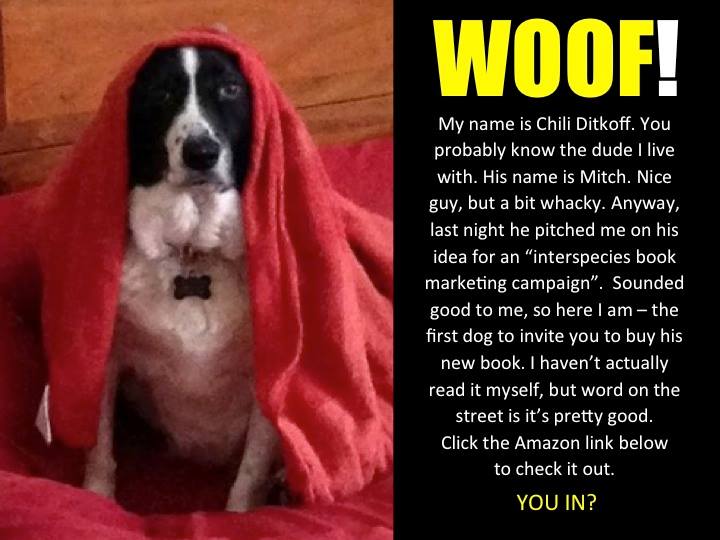
The book Chili recommends
If you don't believe my dog
A story from the book
Other dogs who also like the book
The Amazon reviews of the book
Posted by Mitch Ditkoff at 04:00 PM | Comments (0)
January 26, 2016Story as a Leadership Tool
Here's a lovely animated intro to why STORYTELLING is such a powerful communication and business tool -- by the author of Circle of the 9 Muses.
Storytelling at Work
More useful links about storytelling
And more
Posted by Mitch Ditkoff at 06:44 PM | Comments (0)
December 20, 2015How to Create an Idea Factory

One reason why many aspiring innovators never reach the finish line is because they don't have the support they need to help them navigate the creative process.
They either try to do everything themselves or spend so much time trying to enroll people on the fly that their venture loses momentum.
Conceiving the baby is easy. Delivering the baby is not. Let's take a brief look at how you can change that.
Going forward, it will be very handy for you to have a support team to be there for you when the going gets tough. Sometimes, one person can provide all of the roles. Sometimes, not. Here's a partial list of the kind of people you want to have on your side.
1.Brainstorm Buddy: a trusted friend of yours to jam with, provide feedback, share insights, ask questions, and keep you on your game.
2. Coach/Mentor: a skilled facilitator of the creative process who can help you go over, around, or through whatever inner or outer obstacles head their ugly rears.
3. Finance Wizard: someone to help you create a budget, do cash flow projections, and help you build a business case.
4. Marketing Maven: someone to help you make best use of social media and communicate your product/service to the marketplace.
5. Writer: a wordsmith to craft proposals, write grants and crank out related support materials.
Posted by Mitch Ditkoff at 06:54 PM | Comments (5)
November 12, 2015We're Going in Another Direction

If you work for an organization that issues RFPs to consulting companies, I have one humble request for you:
Please stop using the phrase "we're going in another direction" when it comes time to letting consultants know you've decided not to engage their services. It may seem like a small thing, but it's not.
"We're going in another direction" is not a very meaningful communication. It's a euphemism that delivers no useful information or feedback to the person to whom you are communicating.
If you've asked a consultant to take the time to engage with you, learn about your company, and take the time to submit a proposal, the least you can do is find a more meaningful way to deliver your feedback.
You know the phrase "political unrest?" Of course you do. It's all over the news, but just like "We're moving in another direction," it's vaporware -- a watered down representation of the truth.
So... instead of informing consultants that you are "going in another direction", consider offering them more useful feedback. Everybody wins. You get to speak your truth and they get the kind of honest feedback they need to help grow their business.
Alternative phrases to "We're going in another direction"?
1. "Your fees were too rich for our blood -- about 30% more than we are willing to pay."
2. "It was obvious, from your proposal, that you didn't fully understand our needs and our culture, so we selected another service provider. Thanks, anyway."
3. "We've decided to do it (the conference/keynote/workshop) ourselves, since we are under very tight budgetary constraints."
4. "We chose someone who lives in our city. Makes sense for us, since we don't have to pay for travel and accommodations."
5. "We've decided to go with a long term consultant of ours who already knows our business and our culture."
6. "Our CEO is only comfortable with professors from Ivy League universities. And besides, he's never heard of you before."
7. "You missed the deadline by 48 hours. We needed the proposal by Friday, but we didn't receive it until the following Monday."
Of course, I realize you don't want to hurt anyone's feelings by delivering bad news -- but bad news, delivered in an honorable way, is much more preferable than not sharing the truth, the whole truth, and nothing but the truth. Make sense?
Idea Champions
Our clients
What they say
Posted by Mitch Ditkoff at 02:24 PM | Comments (4)
October 23, 2015What I Learned From Listening to Ravel's Bolero for 14 Hours Straight

During the course of a lifetime a human being goes through many rites of passage. Birth, for example. First love. The death of a loved one and enduring a Republican primary debate. For me, one of the most memorable rites of passage happened in college during my "pledge weekend" -- the weekend I was initiated into a fraternity.
I realize, of course -- especially in these politically correct times -- that college fraternities are rarely associated with anything remotely smacking of insight, awareness, or transformation. But for me it most certainly was -- at least on the rite of passage night I was initiated into Pi Lambda Phi -- an experience now permanently etched into whatever remains of my mind.
The initiation?
To sit blindfolded in a pitch black room, next to 21 of my sweating classmates, all of us holding 17 marbles in our left hands while listening to Ravel's Bolero for 14 hours.

That is not a misprint, folks. Fourteen hours of Bolero. Fourteen.
If you are not familiar with Bolero, allow me to briefly introduce it to you. It goes a little something like this: dahhhh, dah dah dah dah dah dah dah dah dah, dah, dah dah dahhhh, dah dah dah, dah dah dah dah dah dah dah dah dah dah dah dah dah.
It is, shall we say, an extremely REPETITIVE piece of music, a kind of mental military mantra, one that requires the kind of refined sensibility to appreciate that none of us in that room possessed. I think the operational word here is TORTURE -- a kind of classical music waterboarding experience I still have not yet completely recovered from. Five minutes of Bolero is usually enough for most people. Fourteen hours is like the last year of a really bad marriage.
Now here's where it really gets interesting... by the grace of the Bolero gods and the fact that the recording we were listening to had been made on a reel to reel tape player, every 17 minutes or so there would be a four second delay before the music looped back to the beginning. FOUR SECONDS. That was it. Every 17 minutes we had a four second reprieve from Mrs. Ravel's lunatic son.
What I learned during those four seconds taught me a lesson I will never forget.
Those four seconds were not memorable because of the SILENCE itself, but because of what happened DURING that silence -- the space that opened up -- a chance for the 22 of us to enjoy a blast of divine humor -- humor initiated by the youngest of us in the room that day, the Honorable Barry "Boonbeam" Birnbaum (now a much sought after attorney in New York City). What Barry did during those precious few seconds not only renewed and refreshed us, it most likely prevented the lot of us from spending the rest of our lives in a loony bin.
"Nice beat, but you can't dance to it" was Barry's comment during the first of our four second reprieves. "More bass! More bass!" was his commentary the second time around. "I much prefer the London Philharmonic version", he interjected after Round Three. And so and so on it went, 49 times every 17 minutes throughout that dark night of our collective soul.
The smiles and laughter that followed Barry's comments refreshed our minds and rebooted our souls. Humor saved the day. Humor gave us new life. Or as Gandhi once confessed: "If I had no sense of humor I would long ago have committed suicide."
Humor is the great equalizer, no matter who you are and what you do. It opens the heart, relaxes the mind, diffuses worry, energizes, uplifts, renews, restores, and rejuvenates. I like to think of it as one of the core universal truths on planet Earth. Beyond this Earth, I cannot say for sure, other than my perception that ETs from other worlds, at least in the pictures I've seen of them, never seem to be smiling. I don't get it. They all so serious. All that "advanced consciousness" and still no sense of humor. Really? REALLY?
I have no idea if extraterrestrials listen to Bolero or think George Carlin is funny, but I do know this: HUMOR IS A GIFT FROM GOD. Humor is divine. Humor is wisdom wearing a smile.
Why else do you think the court jesters had the ear of the King?
Quotes on humor and play
Idea Champions
Clarence Darrow chiming in
When dogs spark big ideas
The Syndrome Syndrome
My new book
Posted by Mitch Ditkoff at 01:41 AM | Comments (1)
October 03, 2015Sixty Second Stories
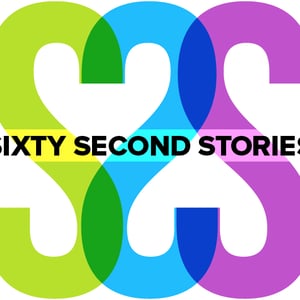
Here's a great resource for your organization, especially if you are looking for a creative way to integrate your brand messaging into video.
Sixty Second Stories is a design house that produces explainer videos, marketing campaign videos, and specializes in kinetic typography.
I love these people! Brilliant! High integrity! Fun!
Posted by Mitch Ditkoff at 11:26 AM | Comments (0)
September 15, 2015The Art of Sparking Innovation
When my mother was alive, she told me she had no idea what I did for a living. Around the canasta table, she would tell her friends I was a "motivational speaker", no matter how many times I explained what I actually did. The slide show below is dedicated to her and to YOU, too -- especially if you're wondering what the heck goes on in one of Idea Champions' innovation-sparking workshops. Best to view full screen.
Posted by Mitch Ditkoff at 05:18 PM | Comments (0)
September 04, 2015HOW TO MAXIMIZE IDEA POWER FOR FREE: A 3-Minute Video Tutorial

Need powerful, new ideas to grow your business, solve a problem, or find a better way? Don't want to go to yet another meeting to figure things out? Start paying attention to the ideas you are conceiving away from the workplace. And encourage others to do so, as well. Here's WHY and HOW.
Idea Champions
First, identify the problem
Innovation sparking keynotes
Free online creative thinking tool
Posted by Mitch Ditkoff at 10:34 AM | Comments (0)
July 17, 2015A Creative Tip from Einstein

One way to do so
Idea Champions
We talk our walk
Brainstorm Facilitation Training
Posted by Mitch Ditkoff at 04:30 PM | Comments (0)
July 12, 2015Sing For the Silenced: July 19th!

Guest post by singer, songwriter, and social activist, Marc Black.
Can you imagine somebody ruining your land, bringing disease to your home, and then offering you money in exchange for your silence? When we heard about that happening from hydro-fracking, we decided to sing for the silenced. And so we have.
Sing for the Silenced is an artist movement that's out to stop Big Gas and Big Oil from first damaging the environment by fracking and then silencing their victims.

This is one way the dark truth about fracking has remained hidden from so many for so long. Corporate interests have embraced a policy of buying silence from folks who's land and health have been compromised by this process. While non-disclosure "agreements" are widely accepted as legal in our system, we believe this is not the case when the public's need to know is interfered with.
Our purpose is to focus artists on this issue, to bring sound to this silence and light to this darkness. And we've already begun

About a year ago, we recorded a show at the wonderful Maverick Concert Hall in Woodstock, NY. The show featured a song entitled Sing for the Silenced and many other tunes on environmental themes by John Sebastian, Happy Traum, Peter Schickele, and myself. This CD (with two studio cuts on the end) is now available. We invite you to purchase it.
And now... the Sing for the Silenced Bus Tour, Concert. and Giant Puppet Show
On July 19, a one day, educational bus tour and car caravan will travel to some of the areas in Pennsylvania that have been ardest hit by the scourge of fracking and the silencing that has followed. And you're invited!

The bus will make a few stops in New Jersey and another at Plymouth Meeting Mall outside of Philadelphia on the way to Montrose, PA. Please keep in mind that you are more than welcome to drive and meet us in Montrose at noon for the tour or three for the concert. (Details at SingForTheSilenced.org).
Once we've concluded the two-hour tour of fracking sites, guided by Vera Scroggins, we will begin a family friendly program of great musical performers, speakers, food, and a giant puppet show.
The car caravan and the concert are both free. The only charge is for a seat on the bus (to help pay for the charter). For information about the campaign and the tour, log onto SingForTheSilenced.org.
Beside growing awareness about the horror of these nondisclosure agreements, let's sing for the victims of this silencing and let them know that we can still hear them!
Posted by Mitch Ditkoff at 09:45 PM | Comments (0)
July 03, 2015The Beauty of a Wandering Mind

Do you have a tendency to zone out? Daydream? Follow the yellow brick road? Well, your day has come.
Instead of having to defend yourself from the army of people demanding you become more focused every second of the day, now you have some vital research, noted by the New York Times, to build a case for your wandering mind.
Explains, Dr. Jonathan Schooler, of UCLA:
"For creativity, you need your mind to wander, but you also need to be able to notice that your mind is wandering and catch the idea when you have it. If Archimedes had come up with a solution in the bathtub, but didn't notice he'd had the idea, what good would it have done him?"
Idea Champions
Facilitated wandering
Wanderlust
Posted by Mitch Ditkoff at 09:47 AM | Comments (1)
June 19, 2015The Cult of Monetization

I wish I had a nickel for every time someone has asked me if I make money from my blog -- and a dollar for every time one of these people used the "M" word, asking me if I've found a way to "monetize" the effort.
Well, before I answer their frequently asked question, let me begin with the basics. The word "monetize" completely repels me. If there is one word in the English language I could live without it would be that word.
What? "Leverage," "incentivize," and "maximize" aren't enough? Now we need "monetize?"
I've got nothing against money. I like money. I like having it. I like spending it. I've (help!) got two kids to put through college soon. It's just that not everything we do needs to be monetized.

I feel really good about hugging my kids without monetizing the effort. I also feel really good about walking my dog without monetizing the effort. Same goes for laughing, breathing, singing, listening to music, watching a sunset, writing poetry, volunteering, talking to friends, meditating, and reading books.
I don't get paid a penny for any of these things. But somehow, blogging has to monetized? No, it doesn't.
The weird thing is, whenever I'm asked by well-meaning friends if my blogging has helped me grow my business, my response is usually tinged with a subtle form of defensiveness, bravado, and hocus pocus about "building a brand."
I confess. My response has not always been authentic because I have bought into the assumptions, doubts, and "business acumen" of my inquisitors.
The fact of the matter is this: I blog because I love it. I love to write. I love to communicate. I love to connect. I love to inspire. I love to stir the soup, share ideas, experiment, provide a service, learn, discover, and be part of a community that is passionate about growth.
NOTE: The previous paragraph is not marketing copy. Neither is it my new mission statement, or attempt to get more Twitter followers.
We live in an age that is far too focused on money. People have confused it with a lot of other things: like happiness, for example... and meaning.... and fulfillment... and the innate thirst to make a contribution to others.
I'm not suggesting that money is evil or my clients should start paying me in yak milk. No.
What I'm saying is this: Not every action needs to be monetized. Some things should be done for the sheer joy of it.
And you, bloggers, out there -- stand up for yourselves! Stop playing the game of "building a business case" every time someone asks you if all the time you spend blogging is worth it.
Of course, it's worth it! But the measure of it's worth cannot always be measured in dollars and cents.
An honorable way to create more money
Idea Champions
Promo for my forthcoming book
Our new brainstorming website
HuffPost story of me arm wrestling a CIA agent
Posted by Mitch Ditkoff at 10:02 AM | Comments (4)
May 01, 2015The Professor and the Jar

A college professor stood before his philosophy class at the start of a new semester. Silently, he picked up a very large jar and filled it with golf balls. Then he asked the students if the jar was full. They agreed that it was.
The professor then picked up a box of pebbles and poured them into the jar. He shook the jar lightly, pebbles settling into the open areas between the golf balls. He then asked the students again if the jar was full.
They agreed that it was.
The professor next picked up a box of sand and poured it into the jar. He asked once more if the jar was full. The students again responded with a resounding "yes."
The professor then produced two cups of tea from under the table and poured them into the jar, filling the empty spaces between the sand. The students laughed.
"Now," said the professor. "I want you to understand that this jar represents your life. The golf balls are the important things -- your family, health, friends, and feeling of well-being. If everything else was lost and only they remained, your life would still be full."
"The pebbles are the other things that matter -- your job, your house, your accomplishments etc. The sand is everything else -- the small stuff."
"If you put the sand into the jar first," he continued, "there's no room left for the golf balls or pebbles. The same holds true for life. If you spend all your time and energy on the small stuff, you'll never have room for the things that are really important to you."
"Pay attention to the things that are essential to your happiness. Spend time with your children. Spend time with your parents. Take your spouse out to dinner. Smell the flowers. Enjoy the beauty of existence. There will always be time to clean the house and fix the disposal. Take care of the golf balls first -- the things that really matter. The rest is just sand."
One of the students then raised her hand and asked what the two cups of tea were about
The professor smiled, "I'm glad you asked."
"The tea shows you that, no matter how full your life may seem, there's always room for tea with a friend."
This story is not in my forthcoming book, but 36 others are.
Idea Champions
Posted by Mitch Ditkoff at 09:36 AM | Comments (1)
April 28, 2015The Power of Tears

Social media did not exist when I was 26. But social work did -- a profession dedicated to improving the quality of life for individuals, groups, families, couples, and communities.
As the Golden Boy of an upper middle class Jewish family from New York, social work was not on my radar screen. The pay wasn't good enough. The status wasn't high enough. And the hours weren't short enough.
So when my neighbor, a University of Virginia Medical Center pediatrician, invited me to become the social worker for a new, federally-funded "early intervention" program I was only half listening. Yes, I was social and yes, I knew how to work, but counseling parents of multi-handicapped infants did not seem like a talent I possessed.
My neighbor, the pediatrician, saw it differently.
"We have a mentor already picked out for you," she explained. "And besides, we don't want professional social workers. We want people who can learn on the job, so we can roll this program out across the country."
The case she made was compelling. And the scope of the project was inspiring -- for me to be part of a team of health care professionals, teachers, and psychologists who would provide services to families into whom a handicapped child had been born. The goal was to do everything possible to keep the families together -- a challenge that, historically, had been proven difficult to do, given all of the stressors and dysfunctional behaviors that manifest when a handicapped child enters the family system.
My job? To be the first person, from our team, on the scene whenever a physically handicapped child was born at the University of Virginia Medical Center or identified, a few months later, to be showing the signs of serious developmental delay.

The protocol was a simple one. I would get a phone call from the hospital, drop everything I was doing, and then meet with the doctors and parents. The doctors were glad to see me because it meant they wouldn't have to deal with all those untidy emotional issues. The parents were not glad to see me because my appearance confirmed the fact that something was definitely wrong with their child -- not at all what they were expecting when packing their bags the night before and wondering how many birth announcements to send out.
For two years, that's what I did, working closely with 20 families of handicapped children living within 50 miles of the University of Virginia Medical Center.
I learned a lot and felt a lot. But the one thing that stands out in my mind, some 41 years later, has nothing to do with facilitating parent groups, making home visits, or navigating the bureaucracy of a flawed medical system. It has to do with a young, single mother and the power of tears.
Lorraine Thompson was 17 when I first met her in a flourescently lit waiting room. Her son, Michael, was three months old. Neither of them was in good shape. Lorraine was overwhelmed, highly stressed, and barely said a word. Michael was twitching, kicking, and drooling, having been diagnosed with cerebral palsy just days before.
Seeing how much pain this young woman was in, my instinct was to comfort her, to be a safe haven from all the suffering in her life. And so, for the first few months of my weekly counseling sessions with her, that's what I tried to do -- bringing her tea, listening, and reminding her of all the many medical center resources available to her. After each session, I wrote up my notes and carefully tracked whatever progress she had been made since her last visit.
Progress was being made. Lorraine seemed to brighten in my presence and come out of her shell. My social work mentor saw it differently. To her, the progress being made wasn't progress at all, but my own unconscious strategy to protect myself and Lorraine from what really needed to happen.
My good intentions were getting in the way. What needed to happen, my mentor explained, was for me to stop being so damn benevolent and let Lorraine Thompson, the 17-year old, semi-catatonic, single mother of a severely handicapped son fall apart. She had to, as my mentor explained, "fall to the place she could fall no further from."
At first, I balked at this suggestion. Hey, I was the only person in the world this woman was receiving any solace from and now I was being asked to withdraw it? It made no sense. But after listening to my mentor wax on about "the healing process", my task became clear. The next time I met with Lorraine, I would let her fall apart.
Three weeks passed. Lorraine and her son, as they had been accustomed to doing for the past three months, met me in the parents lounge. We began as we usually did, me asking Lorraine how her week had been going. After a few minutes of chit chat, she started talking about the tough stuff -- the lack of support from her mother, her son's constant gagging on food, and a seemingly endless stream of complaints. But instead of responding with a hand on the shoulder or light-hearted diversion, I said nothing. I just sat there, silent, looking at her.
Lorraine held my gaze for about 10 seconds, then started crying. The crying turned to sobbing and the sobbing turned into something I have no name for. I continued sitting there in silence, remembering the sage counsel of my mentor. Let her fall to the place she can fall no further from.
It took a while, but it happened. Lorraine cried all her tears. When she was done, I reached out and held her hand. At first she wouldn't look at me. Then she did. There was a great deal of relief in her eyes.
SO WHAT? I wonder how much time, in my life, I've spent propping other people up when all that was needed was simply holding the space for them to let go. In the name of benevolence, compassion, and humanity, I've performed any number of seemingly heartfelt moves designed to relieve the suffering others. And while all of it has been well-intentioned, there have been many times where the highest expression of wisdom would have been to do nothing other than "hold the space" -- a space where no props and pep talks were needed -- a space where true healing could begin.
NOW WHAT? Is there a Lorraine Thompson in your life -- someone going through a hard time who you've been propping up with your good intentions? Are you willing, the next time you see him or her, to stop trying to save them and simply let them feel what there is to feel?
Excerpted from Storytelling at Work, to be published in October
Idea Champions
Some of my HuffPost articles
Posted by Mitch Ditkoff at 07:11 PM | Comments (0)
April 24, 2015Thank You!
Posted by Mitch Ditkoff at 03:08 AM | Comments (0)
February 28, 2015How to Deliver a Meaningful, Memorable Message Quickly

HINT: It has nothing to do with pep talks, powerpoint shows, case studies, statistics, data, performance reviews, carrots, or sticks. Give up?
Stories. That's right. Stories. Storytelling, done well, is the most effective way to deliver a meaningful, memorable message. It's been going on since the Stone Age. Why? Because it works.
Here's my 5-minute talking head video on the topic.
25 quotes on storytelling
As it applies to teenage girls
One of my stories
Our storytelling workshop
Posted by Mitch Ditkoff at 01:36 PM | Comments (1)
February 27, 2015I Am Moving to a Blog Cabin

I see the future.
Everyone will have a blog. Every blogger's pet will have a blog. Every blog will have a blog. Every blog's blog will have a blog. No one will be reading any of these blogs because everyone will be too busy writing blogs. (Those with ADD will be tweeting).
Bloggers will occasionally visit other blogs, but only for the purpose of leaving comments that will direct readers back to their own blog.
Letter writing will become popular once again, gaining a new lease on life after the internet crashes repeatedly because of the profusion of blogs, tweets, and youtube videos created by 5-year olds, holographic spammers, robots, and terrorist groups.
Why all the blogging?
Because people want to connect. And WHY do people want to connect? Because there is a fundamental need inside each and every one of us to feel connected.
"Connected to WHAT?" is the question.
Most business leaders are likely to say something like "the marketplace," or "our customers" or "company values," but the real answer is far more fundamental -- your self.

Remember that? The part of you that doesn't have a title, a strategic plan, or a smart phone to keep it all together? That's where real communication begins -- from the inside out. And even more importantly, that's where the real experience of life begins.
Bottom line, for each of us to feel truly connected, we first need to connect with ourselves. Then, and only then, does it make sense to connect with others.
Otherwise, all our efforts to connect will be fundamentally flawed -- tinged with the slightly neurotic need for more approval, information, and virtual friends -- none of which are really necessary once we master the fine art of tapping into who we really are in the first place.
Sort of like putting the isness back in business.
And speaking of the future -- high rises are out. Blog cabins are in.
Idea Champions
Brainstorm Champions
My innovation-themed keynotes
Illustration: Sara Shaffer
Posted by Mitch Ditkoff at 05:32 PM | Comments (0)
February 18, 2015The Idiot Savant's Guide to Sparking Innovation On the Job

Here's a common scenario: An acquaintance passes you on the street, stops, and asks how you're doing. You begin responding with some meaningful updates about your life, but the person asking you the question seems quite distracted -- surprised you are actually answering their question.
Their opening question to you is what's known as a "social nicetie" -- a polite, automated greeting with very little depth to it.
Business leaders do something similar. They ask their workforce for ideas, but when people actually respond, the business leader or manager acts as if they're late for an important meeting.
Here's my six-minute rant on the phenomenon.
Idea Champions
More grist for the mill
This will help
Posted by Mitch Ditkoff at 06:51 PM | Comments (0)
February 17, 2015On Being an Idea Champion

There's a reason why the expression "ideas are a dime a dozen" is so popular. Because they are. It's easy to get ideas. What's not so easy is championing ideas. And by "championing", I am referring to the kind of heroic commitment required to actually manifest those ideas. Here's my six-minute video elaboration on this often neglected topic. It's great that you have a new idea you care about. Wonderful. Now, ask yourself "What is it going to take for me to press through all the inevitable obstacles and bring this idea to life?"
Posted by Mitch Ditkoff at 07:34 AM | Comments (0)
February 06, 2015BE WHO YOU ARE (everyone else is already taken)
My company, Idea Champions, is headquartered in a town that most people don't associate with corporate consulting -- Woodstock. Yes, THAT Woodstock -- the Woodstock the world has come to know and love as the geographical center of all things musical, alternative, holistic, and far out. It's been an interesting ride living here and then traveling, as I do, all over the world to do my corporate consulting thing.
Here's a 5-minute video of me telling a funny story about my little Woodstock secret coming out at a cocktail party in Munich, Germany. And here's the full story about it in the Huffington Post -- excerpted from my forthcoming book.
Idea Champions
More stuff I've written
The story workshop
Posted by Mitch Ditkoff at 12:54 AM | Comments (0)
February 03, 2015The Secret to a Good TED Talk
Idea Champions
Ten Tips for Giving a Kick Ass Keynote
When Oversleeping Before a Keynote is the Right Thing to Do
Posted by Mitch Ditkoff at 11:22 PM | Comments (0)
The Idiot's Guide to Managerial Success in the 21st Century
Idea Champions
Brainstorm Champions
Posted by Mitch Ditkoff at 10:51 PM | Comments (0)
February 02, 2015CROSSING THE TEENAGE CHASM: The Power of Personal Storytelling

There are 16,593,242 teenage girls living in America. One of them lives in my house. That would be my daughter, Mimi, an extraordinary 17-year old who, shall we say, has been quite an education for me.
If you have a teenage daughter, you know what I mean. If you've been a teenage daughter, you know what I mean. If you have a friend with a teenage daughter (and spent hours chanting "It's just a phase she's going through, it too shall pass") you know what I mean. Everyone else -- oh ye of no teenagers in your life -- please give me the benefit of the doubt for a moment while I shed some major light on the little understood emerging science of how to communicate to a teenage girl.

Most people who know me would assume I'd have no trouble communicating to my teenage daughter. I'm smart. I'm likable. I'm laid back and usually thought of as "cool". I am also a professional communicator -- my work taking me all over the world to speak with all kinds of people: rocket scientists, MTV programmers, actuaries, college students, polymer chemists, PR wizards, cultural creatives, Hollywood executives, video game makers, and everybody else in between -- a percentage for whom English is their second language.
Compared to communicating to my teenage daughter, these people are a piece of cake.
Usually, my attempts to engage my daughter in meaningful conversation are perceived of as lame. I ask what I consider to be authentic, thoughtful, caring questions and, more often than not, get only inscrutable, one word answers -- "Fine", "Good", and "OK" being the three most popular, as she mounts the carpeted staircase to her room.
If I try to get clever in my conversation-opening mode, I succeed only in getting "the look" -- the non-verbal equivalent of "Yo, dude, I see through your game of trying to have a conversation with me and, God, why would I want to talk with anyone as old as you when, in fact, I have some serious texting and Netflix watching to do?"
But today... ah, today... driving Ms. Mimi to school was a Red Sea parting experience -- a glorious epiphany, free parking in Monopoly -- one of those Archimedes-in-the-bathtub moments we've all heard about.
Are you ready for the the secret to communicating to a teenage girl? STORY!
Yes, story! Today, instead of my pitiful, Socratically-infused, semi-desparate attempt to engage my still-not-yet-fully-formed-frontal-cortex-challenged daughter, I completely shifted gears. I took a left turn, instead of a right, segueing from something she said to the spontaneous telling of a personal story -- the passionate, no holds barred sharing of a life-changing moment, for me, that happened five years ago in Australia -- a moment when the eternal adolescent in me made a quantum leap.
I was not probing. I was not teaching. I was not "looking for an opening" to establish more rapport. I was merely recounting a story that mattered to me -- one, it turns out, that mattered to her, she being an edgy, aspiring artist who, like me, sometimes wrestles with doubt.
The vibe in the car? Totally transformed from the kind of teenage black hole moment where only a father's bald spot is visible to the sudden brilliance of a Christmas morning.
When my story was over, my daughter was not only fully present, engaged, and responsive... she asked ME questions. Here in this space, Mimi and I were one, two members of the same tribe sitting around the same fire, the light in each others' eyes all we needed to find our way home to ourselves and each other.
While there probably aren't a whole of teenage girls in your life right now, you, as a human being, entrepreneur, manager, team leader, worker bee, business owner, or freelancer, are faced with the same challenge every single day that millions of parents of teenage girls are faced with -- and that is how to how to BRIDGE THE GAP between you and "that other person"... how to connect... how to engage in a way that works.
May I suggest that STORY is the way to go -- the convertible, low-carbon emission vehicle that allows you to travel vast distances between others who may be very different from yourself. Story, quite simply, is the BRIDGE, the universally understood medium that makes it profoundly easy to deliver and receive a message in the least amount of time and in a way that is empowering, inspiring, and memorable.
What story will YOU tell this week? And who will you tell it to?
Idea Championshttp://www.ideachampions.com
Posted by Mitch Ditkoff at 11:00 AM | Comments (1)
January 30, 2015Networks 'R Us
Human beings' classic, overarching metaphor to explain the underlying structure of what's going on here on planet Earth (and inside a human being, too) is shifting from "Tree of Knowledge" to "Networks." Has big time implications for how an individual, team, department, company, or society organizes itself -- regardless of it's product or service. Lot of ground is covered in this wonderful RSA Animate presentation.
QUESTION: How can your organization shift from top down hierarchical to a self-organizing interactive network? How can people connect in new and elegant ways to share information, expertise, insight, and new ideas?
Posted by Mitch Ditkoff at 02:08 AM | Comments (1)
January 10, 2015A New Technique for Capturing the Attention of Business Leaders

During the past 25 years I have worked with some of the most analytical people in the world: tax auditors, engineers, polymer chemists, actuaries, and rocket scientists just to name a few.
In my effort to help these fine folks make the journey from caution to creativity, I've developed quite a number of non-traditional learning strategies -- most of which have worked well enough to get me invited to work with some extraordinary organizations.
Not a single one of the methods I used had anything to do with the bathroom. At least not until one fateful day at GE, when I found myself teaching Innovation and Business Growth to an amphitheater full of GE's "best and brightest" -- all of whom would be listening, the next day, to the iconic Jack Welsh, standing on the very same stage that I was standing on today.
My task? To move GE's leaders of the future from their left brain to their right brain -- to help them understand, from the inside out, what Einstein meant when he said "Not everything that counts can be counted; and not everything that can be counted, counts."
Having done this kind of work for the past 25 years, I had developed my own Swiss Army knife's worth of mindset-shifting approaches -- approaches that included the right use of music, story telling, humor, movement, emergent design, creative thinking techniques, experiential challenges, appreciative inquiry, and teaching people how to juggle.
Two hours into my GE session, things were going just fine. The 75 participants from 11 countries had given up their fear that I was going to make them sing Kumbaya and I had given up my fear that someone would soon discover my graduate school education was in poetry, not business.
At 10 am, my advanced facilitator skills kicked in and I began to notice that my bladder was full -- the kind of full that, If I didn't respond soon, would result in me hopping from one foot to the other.

Priorities newly clarified, I tweaked my agenda and taught the group a creative thinking technique that would keep them busy for at least another 10 minutes -- plenty of time to relieve myself.
Technique taught, I made my way up the aisle, out the door, found the bathroom, and did what 95% of all men do when it's time to pee -- aim dead center for the round hockeypuck-shaped thingee in the middle of the urinal, mindful not to get any drops on my newly dry-cleaned pants when it was time to zip up.
The bathroom, also one of GE's best and brightest, was about the size of a New York City studio apartment, complete with shiny marble counter tops and a week's worth of neatly folded hand towels on the sink.
Mission accomplished, I flushed, checked my face in the mirror, and retraced my steps to the meeting room.
Upon entering, everyone turned around and looked at me. Half of them were laughing. The other half were smiling. And if there was another half lurking somewhere beyond the laws of earthly mathematics, they would have been madly texting the details of what they had just found so amusing.
I was tickled that GE's best and brightest were so happy to see me, but I was also perplexed. This was not the usual welcome I received upon returning from a bathroom.
Confused, I shot a glance in the direction of Ben, my business partner, in the back of the room. He was standing, wildly gesticulating, Marcel Marceau on steroids.
"Your mic is on", he seemed to be saying, pointing at his lapel.
"Hmmm", I thought to myself. "My mic is on... my MIC is on".
Oops. Double oops!
From what I could tell, I had just broadcasted my entire bathroom experience to 75 global, business leaders of the future. I had to think fast.

"Oh that?" I said, taking another step down the aisle to the podium. "All part of the day's design. Intentional. Totally intentional. My attempt to..."
The rest of my sentence was drowned out by laughter. A lot of laughter. They would have none of it. Of course, they wouldn't. What I was saying was completely ridiculous, but because the way I said it was entertaining and self-effacing, they were not only forgiving, but suddenly much lighter and much more engaged than before I had exited the room just minutes before.
In fact, it would not be an exaggeration to say that in the three years of facilitating Innovation and Business Growth sessions at GE, I had never seen a group of people as focused, engaged, and happy to be in the room as this particular group was at this particular moment in time.
In some strange way, I had accomplished in three minutes, from a remote location -- the bathroom -- what usually took me at least a an hour or two -- bringing a room full of left-brained, curmudgeonly, bottom-line oriented business people to a collective state of mind that was fully present, relaxed, focused, and receptive to whatever was going to happen next.
How about you? The next time you find yourself making a presentation in front of a room full of people, what can you do -- other than broadcasting your bathroom experience -- to fully capture their attention?
Excerpted from Storytelling at Work
Posted by Mitch Ditkoff at 04:27 PM | Comments (0)
December 13, 2014BIG IDEA: Empowering the Homeless
What idea do you have to make a difference? What can YOU do to go beyond the obvious and really be of service to people in need? And if you work in an organization, how can you rally the troops to join you in the venture? Check out what 24-year old Veronika did. Genius!
Need to brainstorm it with others?
Just need a starter idea?
Posted by Mitch Ditkoff at 07:46 PM | Comments (0)
October 07, 2014THE SEED OF INNOVATION MOMENT: A 3-Minute Video Tutorial

If you are trying to spark a renaissance of innovation in your company by launching some kind of "innovation initiative", consider the fact that the seed of innovation is already available in every conversation that people are having. This 3-minute video tutorial dives in deeper.
The Seed of Innovation keynote
Create change agents
A more structured way to do this
Posted by Mitch Ditkoff at 03:51 PM | Comments (0)
September 26, 2014Derek Jeter Wins the Game!
Posted by Mitch Ditkoff at 03:02 AM | Comments (0)
September 19, 201426 Inspired Quotes on the Innovation Most Needed on Planet Earth -- PEACE!
You've heard of product innovation, process innovation, business model innovation, and disruptive innovation. Now it's time for PEACE INNOVATION -- and that's what's happening on September 21st all around the world as millions of people in cities, towns, and hamlets gather together to celebrate the International Day of Peace.
Want to know more? See more? Feel more? Tune into PeaceCast, a 48-hour livestream broadcast to celebrate the International Day of Peace. Starts at 8:00 am (EDT) on 9/20 and ends at 6:00 am (EDT) on 9/22.
Posted by Mitch Ditkoff at 11:36 PM | Comments (0)
September 01, 2014REAL ROI: Return on Imagination!
If you're a champion of innovation, chances are good you've encountered the ROI beast more than a few times -- senior leaders looking at you cross-eyed and questioning the value of your efforts. Stop the madness! Change the game! Forward this slide show today!
First, get clear about your problemPosted by Mitch Ditkoff at 11:26 AM | Comments (1)
July 14, 201410 Things You Can Do in the Next 3 Minutes
 1. Eat an apple
1. Eat an apple
2. Brush your teeth
3. Sing a song
4. Make a to do list
5. Google yourself
6. Take your dog for a very short walk
7. Forgive your parents for being imperfect
8. Complain about the government
9. Write a mediocre haiku
10. Submit a 10-minute-or-less peace-themed video (or a link to a video) to PeaceCast, an organization of inspired volunteers who are producing a 48-hour livestream, on September 21st, to celebrate the UN-sanctioned International Day of Peace. Three minutes. That's all it takes. Three minutes to communicate a message of peace to a world that sorely needs it. Or you could brush your teeth. Click here.
Sample #1 from 2013
Sample #2 from 2013
Sample #3 from 2013
PeaceCast on Facebook
Posted by Mitch Ditkoff at 01:11 AM | Comments (0)
July 07, 2014Rene Descartes Had It Backwards

Rene Descartes, the famous French philosopher, mathematician, and writer is remembered by many as the author of the famous phrase, "I think therefore I am."
With all due respect to the probably-way-smarter-than-me Mr.Descartes, I don't buy it.
Based on my non-Aristotelian, late night sojourns into the flip side of thinking, it's become very clear to me that a more accurate statement would be "I am therefore I think."
Then again, since we all know Werner Heisenberg irrefutably proved that the experimenter affects the experiment, it is likely that the truest philosophical statement of being would probably take on the shape of the person who said it.
And so, in a highly non-caffeinated fit of blogospheric bravado, I present to you 15 alternate statements of epistemological coolitude that give Descartes' tired phrase (and mine) a run for their money.
1. "I wink, therefore I am." - Sarah Palin
2. "I blink, therefore I am." - Malcolm Gladwell
3. "I link, therefore I am." - Larry Page and Sergey Brin
4. "I sink therefore I am." - Davey Jones and his Locker
5. "I stink therefore I am." - Pepe LePew
6. "I drink, therefore I am." - WC Fields
7. "I ink, therefore I am." - Kinkos
8. "I slink, therefore I am." - Marilyn Monroe
9. "I rink, therefore I am." - Wayne Gretzky
10. "I kink, therefore I am." - Ray Davies
11. "I clink, therefore I am." - Moet Chandon
12. "I fink, therefore I am." - Vinny "The Rat" Scalucci
13. "I pink, therefore I am." - Mary Kay
14. "I tink, therefore I am." - Bob Marley
15. "I plink, therefore I am." - Ernest Kaai
Got others? Lay them on me.
A big thank you to Cary Bayer and Barney Stacher for a bunch of the aforementioned pearls of wisdom
Posted by Mitch Ditkoff at 06:39 PM | Comments (5)
June 27, 2014We Speak Right Brain AND Left Brain

Because our blog is entertaining and our home office is in Woodstock, some organizations overlook us -- assuming we are a niche player. Not true. Here's a sampling of our clients And, by the way, we were the first company ever hired by AT&T to teach creative thinking to their work force. We speak right brain AND left brain.
Posted by Mitch Ditkoff at 12:47 PM | Comments (0)
April 01, 2014What Makes a High Performing Innovation Council?

During the past 25 years I've seen a lot of innovation councils (aka "innovation task forces") come and go. Some of them looked good at the beginning and died a slow death. Some of them looked bad at the beginning and died a quick death. And some of them actually succeeded.
Before diving in, pause, take a breath, and consider the following guidelines. They will save you time. They will save you headaches. And they may even save your company.
20 TIPS FOR LAUNCHING AN INNOVATION COUNCIL
1. Quit now if you're not really into it.
2. Be mindful of who you invite to participate. Just because someone is a "senior leader" doesn't automatically mean they should be on the Innovation Council. If they don't have the time, passion, or willingness to push the envelope, there's no reason for them to participate.
3. Create a charter. Define tasks. Make sure everyone knows exactly what's expected of them.
4. Establish clear agreements at your first meeting. Otherwise, prepare for chaos, wheel spinning, indecision, and the corporate hoky poky.
5. Build accountability into the process. Innovation Council members, no matter how high up they are on the corporate food chain, need to keep their word to each other. No slacking.
6. Clarify the lines of communication to key stakeholders who are not Innovation Council members. Do not fall prey to the Ivory Tower Syndrome.
7. Feel free to include senior leaders on the council, but only if they really want to do the work. This is NOT a committee or a plum ambassadorship to a fictitious country called "innovation." This is a working group that really needs to be on top of its game, honor its commitments, and model the very best of what real innovation is all about.
8. Meet more often than you want to. (If you only meet once a quarter, fuggedaboutit.)
9. Make sure the person who facilitates your meetings knows what they're doing -- and is prepared for each meeting.
10. Limit the size of your Innovation Council to seven. Any more than ten and you'll have an Innovation Swamp.
11. Have a sense of urgency, not panic.
12. Celebrate your successes, even if they're small.
13. Honor confidentiality.
14. Be lifelong learners about innovation. Put together a reading list. Teach each other.
15. If an Innovation Council member starts to flake out, ask them to either step up or step out.
16. Take notes at each meeting and distribute them within 24 hours.
17. Invite non-Council members to participate in your meetings every once in a while. Don't become a cult.
18. Speak your truth to your "executive sponsors", or whoever the Innovation Council reports to. If they're not holding up their end of the bargain, you're wasting your time.
19. Communicate what you're doing to the rest of the company. Don't keep it a secret. Transparency is the name of the game.
20. Do whatever is necessary to stay inspired. All too often Innovation Councils implode under the collective weight of their own busyness, ridiculous work loads, and stress. PS: Have fun with this!
Posted by Mitch Ditkoff at 01:29 AM | Comments (7)
March 29, 201456 Reasons Why Most Corporate Innovation Initiatives Fail

Innovation is in these days. The word is on the lips of every CEO, CFO, CIO, and anyone else with a three-letter acronym after their name. As a result, many organizations are launching all kinds of "innovation initiatives" -- hoping to stir the creative soup. This is commendable. But it is also, all too often, a disappointing experience.
Innovation initiatives sound good, but usually don't live up to expectations. The reasons are many. What follows are 56 of the most common -- organizational obstacles we've observed that get in the way of a company truly raising the bar for innovation.
See which ones are familiar to YOU. Then, sit down with your Senior Team... CEO... innovation committee, or team and jump start the process of going beyond these obstacles.
56 Reasons Why Most Corporate Innovation Initiatives Fail
1. "Innovation" framed as an initiative, not the normal way of doing business
2. Absence of a clear definition of what "innovation" really means
3. Innovation not linked to company's existing vision or strategy
4. No sense of urgency
5. Workforce is suffering from "initiative fatigue"
6. CEO does not fully embrace the effort
7. No compelling vision or reason to innovate
8. Senior Team not aligned
9. Key players don't have the time to focus on innovation
10.Innovation champions are not empowered
11. Decision making processes are non-existent or fuzzy
12. Lack of trust
13. Risk averse culture
14. Overemphasis on cost cutting or incremental improvement
15. Workforce ruled by past assumptions and old mental models
16. No process in place for funding new projects
17. Not enough pilot programs in motion
18. Senior Team not walking the talk
19. No company-wide process for managing ideas
20. Too many turf wars. Too many silos.
21. Analysis paralysis
22. Reluctance to cannibalize existing products and services
23. NIH (not invented here) syndrome
24. Funky channels of communication
25. No intrinsic motivation to innovate
26. Unclear gates for evaluating progress
27. Mind numbing bureaucracy
28. Unclear idea pitching processes
29. Lack of clearly defined innovation metrics
30. No accountability for results
31. No way to celebrate quick wins
32. Poorly facilitated meetings
33. No training to unleash individual or team creativity
34. Voo doo evaluation of ideas
35. Inadequate sharing of best practices
36. Lack of teamwork and collaboration
37. Unclear strategy for sustaining the effort
38. Innovation Teams meet too infrequently
39. Middle managers not on board
40. Ineffective roll out of the effort to the workforce
41. Lack of tools and techniques to help people generate new ideas
42. Innovation initiative perceived as another "flavor of the month"
43. Individuals don't understand how to be a part of the effort
44. Diverse inputs or conflicting opinions not honored
45. Imbalance of left-brain and right brain thinking
46. Low morale
47. Over-reliance on technology
48. Failure to secure sustained funding
49. Unrealistic time frames
50. Failure to consider issues associated with scaling up
51. Inability to attract talent to risky new ventures
52. Failure to consider commercialization issues
53. No rewards or recognition program in place
54. No processes in place to get fast feedback
55. Inadequate sense of what your customers really want or need
56. Company hiring process screens out potential innovators
Posted by Mitch Ditkoff at 01:31 PM | Comments (4)
March 22, 2014Secrets of the Best TED Speakers
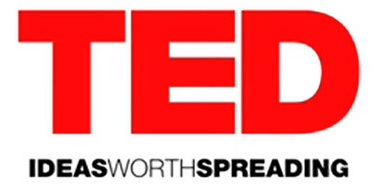
Want to perk up your public presentations? Take a look at Carmine Gallo's new book TALK LIKE TED: The 9 Public Speaking Secrets of the World's Top Minds. Gallo studied more than 500 TED presentations and has distilled what he learned into bite-sized insights for the rest of us. Here are a few highlights:
1. Start with personal stories.
2. Be passionate about how your idea will change the world and inspire lives.
3. Use humor (but sparingly).
4. Feature visuals on your slides, not data.
5. Use body language to focus the audience on you and accentuate the most important parts of your talk.
6. Be yourself. Be authentic!
7. Practice! Practice! Practice!
Good interview with Carmine Gallo on Mark May's fine blog.
Idea Champions
Posted by Mitch Ditkoff at 09:27 AM | Comments (0)
March 16, 2014How to Spark Wisdom in the Workplace
Dear Heart of Innovation Readers:
If you have received any value from this blog and would be interested in supporting my next, big project -- now launched as a GoFundMe campaign -- click here for a 3-minute video of me describing it and a written description of what the whole thing is all about -- a venture which includes the writing, publication, and promotion of a new book, Wisdom at Work, along with the launching of WISDOM CIRCLES in organizations around the world.
Whatever support you can provide is very much appreciated, Plus, you will be sent a copy of the book when it's published, if you want.
Mitch Ditkoff's GoFundMe campaign
Posted by Mitch Ditkoff at 09:35 AM | Comments (0)
March 07, 2014Your Money or Your Life

For the life of me, I cannot remember the name of the financial services company that left me an urgent voice mail message asking that I call them back immediately about my availability to lead their annual leadership retreat on a island off the coast of Florida.
All I can recall was how generic sounding their name was -- something like National Investment Services... or Consolidated Financial Brokers.... or The American Banking Alliance -- kind of like the corporate equivalent of John Doe.
Somehow, they had heard of me and, with their big company pow wow coming up, were looking for someone, with a track record, to help them "become more innovative."
Never having heard of them before, I googled their name and, 1.73 seconds later, found myself on their website, slickly designed, I imagined, by someone with a special fondness for iStock photos of earnest looking models impersonating business people -- models who must have just moved to L.A. to pursue acting careers, but found themselves, at 24 or 35, working part-time as waiters and jumping at the chance to pick up some easy money wearing a suit and a smile for a day.

Easy for me to say -- me being the proverbial pot calling the proverbial kettle black with my big ass mortgage, family to feed and young entrepreneur's dream of making it big so I'd actually have enough moolah, one day, to invest with a financial services firm. Not to mention all the time in the world to write my best-selling book.
My first meeting with the client was pleasant enough. They talked. I listened, choosing not to interrupt them every time they made their point with an acronym I probably should have known if I only I hadn't spent my formative years living as a hippie, poet and monk.
OK, so they weren't a solar energy company. So they weren't asking me to help them end AIDS. I got it. This was business. The money business. The big money business -- and I was in it, no matter how much Rilke and Rumi I read on the side. Money. This was about money. Money and the VP of something or other inviting me to meet with him and his team the following week on the 57th floor of a building on Wall Street. There would be a badge waiting for me at the security desk, he explained. All I needed to do was show my ID.
Thrilled? Was I thrilled? Not exactly. But this was a possible gig and I needed the bread, so I went.
The VP and his team on the 57th floor looked nothing like the iStock photos on their company's homepage, though they did have a real nice view of Manhattan and a large mahogany conference table.
Our conversation went well enough. I asked all the right questions. They gave all the right answers. They sprinkled the conversation with football metaphors. I nodded. They gave me their business cards. I gave them mine. But on the way home, I began to feel a creeping sense of dislocation and dread -- like I was auditioning for a movie I wasn't quite sure I wanted to be in -- a movie being produced by a very fat man, sitting poolside, cell phone and martini in hand.

So when they called me back for a third meeting, I was betwixt and between. Do I simply trust my instincts and tell them I'm not their man? Or do I let go of my all-too-obvious self-righteous judgments and focus on the possibility that I might actually be able to help them get to higher ground?
Eternally the optimist, I chose the latter and decided to meet with them a third time -- a meeting, sad to say, which only confirmed the fact that I didn't like them very much and didn't like myself for sitting in a room with them and enabling their collective hallucination of themselves as a service organization when all they really wanted to do was make more money. Lots more money.
More chit chat. More coffee. More "run it up the flagpole" platitudes that littered our conversation like hidden charges on a credit card bill.
This was the moment of truth.
My client-to-be, apparently satisfied with what was about to become his decision to engage my services, cut to the chase and asked me to quote him a fee.
The honorable thing to have done, at the time, would have sounded like "John, I wish you the best of luck at your offsite, but after deep consideration, I don't think I'm the best possible fit for your company's needs."
But since I hadn't yet mastered the art of speaking my truth I took the easy way out and doubled my fees, thinking that they would now be so ridiculously high it would be the client's decision to end the relationship, not mine.
"That sounds about right," the client exclaimed, extending his right hand to seal the deal.
Fast forward six weeks later.
It's 8:30 a.m. and I'm on stage, in the Oakwood Room, on a beautiful island off the coast of Florida. Looking out at the audience, I notice that four of the gathered troops are sleeping, heads on the table. Someone in the front row explains to me that last night had been a "late one" and they'd all stayed up, drinking, until 4:00 a.m.

I tap the mic and begin speaking, trusting that the sound of my amplified voice would be enough to wake the dead.
Two of them snap to attention. The other two don't, still lightly snoring.
I signal the people sitting next to their sleep-deprived peers to poke them, which they do, shooting glances at me as if I am a substitute algebra teacher.
This is, as far I could tell, not a leadership offsite at all, but a college fraternity weekend -- big men on campus with stock options, golf shirts and a very high opinion of themselves. The collective attention span in the room is somewhere between a tse tse fly and a lizard. Nothing I say lands. Nothing. Nada. Zilch. Only one thing is clear -- I am the highly paid warm up act before another night of drinking -- a small typographic box they can check off next quarter to prove they have done "the innovation thing."
I may have missed the moment of truth back at my client's office six weeks ago, but I wasn't going to miss it today.
"Gentlemen and ladies," I announce. "It's obvious that some of you don't want to be here. It seems you'd rather be golfing, napping or checking your email. I have no problem with that. So... we're going to take a 20-minute break. Only return if you really want to be here. Otherwise, you'll just be dead weight, screwing it up for the rest of us. Kapish?"
Twenty minutes pass. Everyone returns. Every single one of them.
And while the rest of the day didn't exactly qualify as one of the great moments in the history of innovative leadership off sites, at least it wasn't a total loss. Some good stuff actually happened. People woke up. People shaped up. People stepped up. And I learned a valuable lesson that would serve me for the rest of my life: Follow my feeling, not the money trail.
This story excerpted from my forthcoming book: WISDOM AT WORK: How Moments of Truth on the Job Reveal the Real Business of Life.
This story also in the Huffington Post
What's the Problem?
How to help these guys change
We all have a story to tell
Idea Champions
Posted by Mitch Ditkoff at 11:28 AM | Comments (0)
March 01, 2014Follow Your Feeling, Not the Money Trail

Sometimes, you just gotta follow your feeling, not the money trail. A new article of ours just published in the Huffington Post.
Posted by Mitch Ditkoff at 12:07 AM | Comments (0)
February 17, 2014Would You Invest Three Hours to Save Yourself Months of Wasted Effort?

Idea Champions has just launched a groundbreaking three-hour workshop that will save your organization untold time, tons of money, and a thousand pounding headaches you can't afford to have.
Posted by Mitch Ditkoff at 02:18 PM | Comments (0)
February 15, 2014How to Help Your Senior Team Get Aligned About a Strategic Direction

I am totally inspired by the feedback that Steven McHugh, co-Founder and Chief Innovation Officer of Idea Champions, received from Life Care Centers of America, in response to a two-day Senior Team Strategy Offsite he designed and facilitated for them. See below...
 "I wanted to thank you for the wonderful work you've done for us at Life Care Centers of America.
"I wanted to thank you for the wonderful work you've done for us at Life Care Centers of America.
As you know, when I left my CFO position at Olin Corporation to help lead Life Care, I was presented with a number of difficult challenges. Due to strict government regulations, the long-term care industry was in turmoil. In 30 years, Life Care had not performed any unified, long-term strategic planning, and there was no HR department for over 27,000 employees.
Based on the excellent work you did for over five years with my former company, I knew you had the skills to help us. Your role in aligning 230 different facilities into a unified force has been remarkable, especially in the short time frame you were given.
As you know, the results of the process you took us through have been astounding. In an environment where five of the top six public nursing home companies have declared bankruptcy, we have enjoyed unprecedented growth. You helped our senior officers transform into a dynamic leadership team. Our clarity around an aligned mission translated into a powerful vision that we can communicate to the rest of the organization.
Your Vision Mapping sessions were the catalysts for communicating our message to the rest of the organization. Your ability to develop balanced scorecards for all 230 facilities was the key to translating strategy into results.
It is now clear what actions are important for us to take, and for the first time, our people know how their success will be measured.
From the senior level to the staff in each facility, actions are now aligned to achieve strategic goals.

As an interesting byproduct of your work here, we are beginning to develop leaders at all levels in the organization who are empowered to do whatever it takes to get the job done. They have a clear line of sight to the strategic goals and are stepping up to the plate to get them done.
I am proud of how we have responded to the process you have embedded into our culture. Thank you for justifying my faith in bringing you in to facilitate this major change in how we operate.
I look forward to continuing our work together in developing a high performance organization."
-- Michael Waddell, President, Life Care Centers of America
50 quotes on possibility
50 quotes on vision
Creators on Creating
What we do
Idea Champions
Posted by Mitch Ditkoff at 01:26 PM | Comments (0)
January 17, 2014What Business Can Learn from Baseball

A few years ago I ran across an article that got me thinking about how what we measure can change the way we think about what we measure, and how the latest technology that enables us to measure more and more things is not always our friend.
For several decades now, baseball scouts and coaches have been using radar guns to measure how hard pitchers throw. In fact, you can always spot a scout at a baseball game because he's the guy in the stands, behind home plate, with the radar gun pointed at the pitcher, zealously jotting down little nuggets of facts in his notebook like a squirrel gathering acorns.
Not surprisingly, baseball people have come to value pitchers who can throw hard (95 MPH and faster).

This seems to make sense at face value, but if we think about it a bit more we have to ask ourselves if throwing a baseball faster actually makes one a better pitcher. The answer is -- not necessarily.
There are many factors that contribute to making a pitcher effective:
1. Does the pitcher throw the ball exactly where he wants to throw it?
2. Is it easy or difficult for the batter to see the ball coming out of the pitcher's hand?
3. Can the pitcher throw his array of pitches at different speeds, confusing the batter's timing?
4) Can the pitcher deal with adversity, or does he get rattled when things go wrong?
These factors are all more important than how hard a pitcher throws a baseball.
But baseball's obsession with pitch speed, enabled by the ease of measuring speed with a radar gun, has caused some organizations to lose focus on what they're really trying to gauge; that is, the pitcher's effectiveness -- can he get batters out?
A few years ago, the Kansas City Royals conducted an experiment to test the existing assumption that faster is better.
Dayton Moore, the General Manager of the Kansas City Royals, has issued an edict banning radar guns from the lower levels of the organization -- the place where young players first go to develop their skills.
Moore believed that eliminating radar guns from the minor leagues would eliminate a big distraction for young pitchers -- getting caught up in throwing hard in order to be noticed and promoted and forgetting to develop other, key pitching skills.
It may take some time to determine if Moore's hunches turn out to be right, but I, and a host of soft-throwing pitchers in the Baseball Hall of Fame, like Whitey Ford and Hoyt Wilhelm, are willing to bet that they are.
I will end my baseball rant with the following quote from the contemporary economist. Adam Smith:
"Some years ago the sociologist and pollster, Daniel Yankelovich, described a process he called the "McNamara Fallacy", named after the Secretary of Defense, Robert McNamara, who had so carefully quantified the Vietnam War.
'The first step,' he said, 'is to measure what can easily be measured. The second is to disregard what can't be measured, or give it an arbitrary quantitative value. This is artificial and misleading. The third step is to presume that what can't be measured easily isn't very important. This is blindness. The fourth step is to say that what can't be easily measured really doesn't exist.'
The philosopher A. N. Whitehead called this tendency, the Fallacy of Misplaced Concreteness.
Are contemporary business and government leaders all too quickly and lazily falling into the trap of McNamara's Fallacy? Are we measuring only that which is easy to measure (and money, for one thing, is easy to measure) and making decisions based merely on those numbers because other important factors, such as long-term effects on quality of life and the environment, are just too difficult to quantify?
Should we all be rethinking what we measure and why, just like the Kansas City Royals did? And what are our own industry's "radar gun measurements" that give us easy-to-acquire numbers that gather importance simply because they're easy to get?
And if you're still not convinced, consider what Albert Einstein had to say about the topic: "Not everything that counts can be counted and not everything that can be counted counts!"
-- Val Vadeboncoeur
Idea Champions
The author of this article teaches this course
Posted by Val Vadeboncoeur at 02:43 PM | Comments (1)
January 16, 2014The Value of Nothing

When children are born prematurely, they're placed in incubators. When fields stop producing, farmers let them lay fallow. When baseball players are in a prolonged slump, they're given a day off.
It's the same with innovators -- or should be.
They, too, need to incubate. They, too, need to lay fallow. They, too, need time off. You already know this. That's why you often choose to "sleep on it" before making a big decision.
Pausing isn't procrastinating. It's an act of renewal -- a chance to relax and let your subconscious shine -- a phenomenon that's all-too-rare these days -- especially in organizations where everyone is overworked, overwhelmed, and over-caffeinated.
Face it. Sometimes the best thing to do is nothing.
THE DO NOTHING TECHNIQUE
1. The next time you are working hard, but getting no results -- notice it.
2. Take a break.
3. If you feel the urge to produce, let the urge pass.
4. During this down time, simply notice the ideas and insights that come to you.
5. DO NOT attend my webinar on this subject. (I don't have one).
Listen to your subconscious
Excerpted from Awake at the Wheel.
Posted by Mitch Ditkoff at 10:24 PM | Comments (1)
December 03, 2013The Real Flowering of Innovation

ED.NOTE: The following is dedicated to all the male readers of this blog -- especially those who are married, work too hard, and think about "innovation" just a little too much.
Today, in a sudden fit of love and appreciation, I bought a dozen roses and brought them home to my wife.
Usually, when I think of buying roses, I go through a predictable sequence of events. First, I surrender to a wonderful feeling of expansiveness that takes me over. Then I get curious and smell the flowers. Then I ask the shopkeeper how long she thinks the roses will last. Then I ask the per stem price, do the math, and reach the pitifully male conclusion that $46.95 is way too much too spend on something that won't last out the week and is probably less expensive somewhere else and it's obviously indulgent of me to be buying so many roses when I've got two kids to put through college in a few years and besides, beauty is within.
All of this, of course, is my inner Woody Allen taking the low road in response to what is obviously a Johnny Depp moment.
So I dig deep and bring the roses home -- my entire living room taking shape around them.
I then become very aware that there are definitely not enough flowers in the room. In a curious way, the recent appearance of roses has made the rest of the room seem barren. Tabletops and shelves that only minutes ago were doing just fine, are now utterly flowerless.
So I do the only thing a man can do when faced with such a paradox -- I return to the flower shop.
But the shop is closed. Closed? Impossible! I need flowers!
So I get back in my car and speed my way to the other flower shop in town.
It, too, is closed -- or, should I say, closing. The owner is shutting the door and giving me the "too-bad-you-didn't-get-here a few-minutes-ago" look.
But I will not be denied. And he knows it.
"What do you want?" he asks.
"Cut flowers," I reply.
He signals me to enter and I buy way more flowers than makes sense. A ridiculous amount.
Let's put it this way: if I was in the federal witness protection program, my sudden flower buying behavior would have put my government handlers in a tizzy.
Fast forward ten minutes to my wife in our kitchen.
She is looking at me as if I am totally insane -- me, the guy who, only days ago was making an airtight case for a more modest household budget.
Here's my philosophy:
Flowers first. Logic second. If money is tight, buy more flowers. The more flowers you buy, the more money will appear. And if not in this lifetime, then the next (or maybe the one after that).
OK. There you go -- my not very financially sound, flower-centric view of the universe. You, my friend, are a witness. If I forget, please remind me.
Indeed, next time we meet, you have my permission to ask me how the flower thing is going.
Remember, flowers first. (OK. Stop reading this blog. Go out and get some flowers, already).
Idea Champions
If you want your company to flower
Our newest offering
Posted by Mitch Ditkoff at 12:36 AM | Comments (0)
November 27, 2013Forget THINK TANKS. The Time Has Come for THANK TINKS!

On this day of THANKSGIVING, I'm asking for your feedback on a new idea of mine which I have playfully named THANK TINKS.
The idea is for organizations to provide their workforce with a simple, dependable way to express their gratitude -- as a counter-balance to the all-too-common tendency many people have to focus on what's wrong.
In the same way that Quality Circles were a big hit in the 1980's, THANK TINKS ("Appreciation Circles"), might be just the right thing for these challenging times of ours.
Here's a wonderful article on the power of gratitude in business by Forbes writer, Erika Andersen.
21 quotes on appreciation
Idea Champions
Posted by Mitch Ditkoff at 12:41 PM | Comments (0)
November 21, 2013The Art of Capturing Attention
How can you or the company you work for use video more effectively to deliver a message, promote a product, or capture the attention of the people to whom you are trying to communicate?
Capture attention!
Capturing attention at GE
Idea Champions
Posted by Mitch Ditkoff at 11:13 AM | Comments (0)
November 14, 2013One Reason Why Brainstorming Fails

Advertising executive Alex Osborn, frustrated by his employees' inability to come up with novel and creative ideas, invented the concept of brainstorming in the late 1930's. His 1953 book, Applied Imagination, described how to apply the concept in very simple terms. Osborne put forth two basic principles: Defer Judgment and Focus on Quantity.
These days, people attempting to lead ideation sessions are often mindful of the first principle, but they almost never remember the second. And this, quite simply is a big reason why most brainstorm sessions fail to produce even mediocre results.

At first glance, the quantity principle seems counter-intuitive. How can people come up with quality ideas, you might ask, by not striving for quality ideas?
But there's a method to this madness -- and it has to do with how our minds work and how we are trained to think.
If you are asked to come up with "good" and "novel" ideas in response to a problem, challenge or opportunity, whether you are working alone or with others, you will tend to aim for the best ideas possible. Makes sense, right?
However, in your striving for the best idea, you will tend to dismiss ideas you consider to be less-than-terrific.
When ideas pop into our minds, we tend to judge them immediately as too small, too big, too pedestrian, too unrealistic, too obvious, too goofy, too ordinary, too expensive, or too whatever.
It's as if the Red Queen is ensconced in our brains, shouting "off with his head!" at every idea that dares to speak up.
That's because human beings are conditioned to see what's wrong with an idea before seeing its possibilities.
It's like seeing a baby bird and judging it to be inadequate because it can't fly yet.
And this process is barely conscious. We dismiss our ideas so quickly that we often don't even notice they were thought of at all. "We've got nothing" becomes our mantra.
If you are generating ideas in a group and everyone is experiencing this phenomenon at the exact same time, the great silence will inevitably head its ugly rear. No one will be willing to share any of the ideas that have popped into their heads because their ideas will be self-censored -- deemed to be inadequate or flawed.
This is why "experts" are, usually, the worst brainstormers imaginable.

Educated, experienced, and cognizant of all the ins and outs of the topic being brainstormed, experts will immediately see the flaws -- not the possibilities -- killing promising new ideas with the effectiveness of a healthy immune system killing off a germ or virus.
This is why many forward thinking focus groups bring in children or non-experts to generate new ideas -- people whose idea immune systems are not yet fully developed.
Think about it for a moment. If "ordinary" ideas can be generated, articulated, announced, and captured then an interesting thing can happen. Other people can improve the ideas. One idea will lead to another and another and another, radically increasing the odds of something truly original manifesting.
This kind of magic, however, cannot happen if Osborn's principle of striving for quantity is ignored.
Think of Osborn's dual principles as two sides of the same coin.
Defer judgment postpones the act of criticizing ideas as they are generated. Focusing on quantity helps us defer our tendency to judge our ideas as they are conceived.
Not unlike the proverbial coin, if you don't have both sides, "you've got nothing."
-- Val Vadeboncoeur
Idea Champions
Virtual Brainstorm Training
High Velocity Brainstorming
Posted by Mitch Ditkoff at 09:00 PM | Comments (1)
November 02, 2013Wake Up the Passion to Innovate

Innovation is a big fat generic concept in most corporations -- like life on other planets or trying to get teenagers to clean up their room.
Unless the individuals within an organization have a genuine sense of urgency, personal ownership, and an authentic passion for innovation, nothing much will happen.
Corporate initiatives that fail to awaken the human instinct to innovate are doomed, no matter how many pep talks, tote bags, or t-shirts proliferate.
For me, as an innovation consultant, it is clear that the short amount of time I have with my clients needs to be devoted to awakening the passion to innovate.
Tools, techniques, theory, data, models, bibliographies, business cases, best practices, and the fabulous muffins served on breaks are all fine, but it is the passion to innovate that is the real driver of success.
No passion, no innovation. Plain and simple.
Unfortunately, most organizations squash passion. That is why start-ups have a much easier time innovating than Fortune 500 companies. And that's why savvy Fortune 500 companies recreate the feeling of start-uppiness whenever they can.
The best thing any consultant can do when working with an organization is to hold up a mirror and ask their clients what they see.
Are they modeling what it means to be innovative? Or are they asking other people to do what they themselves have not done?
Idea Champions
Applied Innovation
Short videos of me
Posted by Mitch Ditkoff at 01:17 AM | Comments (0)
November 01, 2013Let Go of Perfectionism!
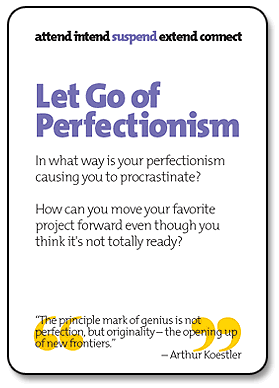
Card from Free the Genie
Online version, too!
Posted by Mitch Ditkoff at 02:20 PM | Comments (1)
October 16, 2013One Coin Is All It Takes
Who's gonna put the coin in the hat in your business? Who's gonna play?
Posted by Mitch Ditkoff at 05:04 PM | Comments (0)
The School in the CloudThis is quite extraordinary. Sugata Mitra's TED talk on the future of learning. Blows the top off of what you think education is and how you think it happens. Exciting times!
Posted by Mitch Ditkoff at 03:53 PM | Comments (0)
October 15, 2013Go Beyond the Impostor Syndrome

In a rapidly changing, highly complex and unpredictable world, leadership has little to do with being the smartest person in the room.
It is often the case that those holding positions of authority believe they must justify their position by providing the best solutions to the problems they face.
Often this need to demonstrate that one "has the answer" is grounded in a deeply rooted fear that one, in fact, does not truly know what to do and that revealing one's uncertainty will lead to an erosion of confidence in one's superiors and subordinates.
They see their authority as grounded in their knowledge and expertise and feel obliged to demonstrate their acumen whenever consequential problems are addressed.
This phenomenon invariably leads to compensatory behavior in which one's inner doubts and uncertainty about how to address complex and ambiguous issues leads to unjustified rigidity of positions and an inability to see the value of alternative points of view.

If we must constantly prove to everyone that we deserve the position we have attained, we can never allow ourselves to be seen as needing to learn anything or to rely on anyone else.
This dilemma -- often referred to as the "impostor syndrome", -- systematically undermines one's ability to learn, to benefit from the perspectives of others, and to appreciate the value of others' strengths and points of view.
It also often leads to behaviors in which we diminish others in order to reassure ourselves of our importance and our value.
Lastly, it virtually guarantees that the decisions that get made are not the best ones because they are not informed by the experience, insight, and creativity of the people around us.
- Barry Gruenberg
Idea Champions
34 Awesome Quotes on Leadership
Posted by Mitch Ditkoff at 01:50 AM | Comments (2)
October 08, 2013The Telekinesis Coffee Shop
This is a brilliant marketing idea made manifest -- a way to promote a new movie, virally, via some real-time faux telekinesis in a coffee shop.
Posted by Mitch Ditkoff at 06:02 PM | Comments (0)
September 29, 2013THE NEXT BIG INNOVATION: Peace!
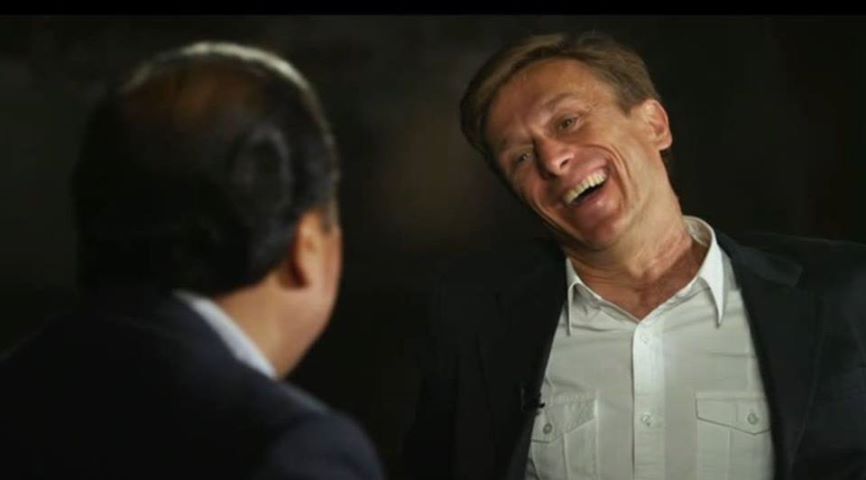
There's a lot of different kinds of innovation going on in the world today -- business model innovation, product innovation, process innovation, disruptive innovation, and so forth. But there's another kind of innovation that most of us are ignoring --peace innovation -- what it takes for each and every one of us to be in a state of well-being, regardless of the number of innovations entering our lives.
Yesterday, the Huffington Post published an article of mine on this topic -- one that includes a compelling 28-minute video of a conversation between peace activist, Jeremy Gilley, and Prem Rawat, an extraordinary man who has been a peace advocate for more than 40 years.
Enjoy it -- and, if you do, think about who you might forward it to. We're all this together...
Posted by Mitch Ditkoff at 02:04 PM | Comments (0)
September 28, 2013Miles Davis on Mistakes

Idea Champions
50 quotes on failure
50 quotes on risk taking
Posted by Mitch Ditkoff at 11:43 PM | Comments (0)
May 30, 2013Great Place to Stay in Woodstock, NY
Posted by Mitch Ditkoff at 02:44 PM | Comments (0)
May 28, 2013The Nancy Factor

See the picture to your left? Of course you do. That's Nancy Seroka, Idea Champions' Director of Operations, World Class Administrator, and Queen of Client Relations.
Without Nancy, there would be no Idea Champions. Nancy is the glue, the DNA of Details, the one who minds the store while the rest of us are on the road, in the clouds, or otherwise engaged.
For the past 13 years, Nancy has been juggling hundreds of Idea Champions projects with style, class, and heroic effort. The fact that she is still somewhat sane astounds me.
Sometimes, I regret to say, I am blind to how much value Nancy adds to our business. You see, she does what she does with so much precision and consistency that I often don't even notice it.
I am not alone in this regard. Indeed, I am betting that a lot of you reading this rant also have a Nancy in your business life -- someone who keep things together, supports you way beyond the call of duty, and makes magic happen while you're consumed with the details of your business life.
You have come to expect this kind of extraordinary contribution from others. You think it's "their job" -- and barely notice. Not a good idea.
Hey, you don't notice the air, either, but just imagine if it wasn't there.
And so, it is with great respect for Nancy -- and all that she is and all that she does -- that I implore you to pause for a moment and honor all of the Nancies in your life -- all of the people "behind the scenes" who are, day-by-day, minute-by-minute, helping you grow your business.
I'm not talking about the token giving of roses on "Secretary's Day". No.
I'm talking about being far more present and acknowledging of all the people who support you, without whom you would be howling at the moon, walking in circles, or looking for a job.
So, thank you Nancy. You are an inspiration and a life saver.
And should I forget, tomorrow... next week ... next month ... or next year to acknowledge you for all you are and all you do, I humbly ask your forgiveness.
Posted by Mitch Ditkoff at 10:13 AM | Comments (2)
May 22, 2013The Corporate Crapola Filter

Dear Potential Clients:
With all due respect, please do not call us if your organization is addicted to the scenario being played out in the cartoon to your left. If this was 10 years ago, we may have said YES. But no longer.
We've been paid handsomely, in the past, for hitting our heads against the wall, but those days are over. We're not saying you have to be perfect for us to work with you -- just free enough of corporate crapola for us to make a difference.
We like the Bob Newhart approach.
Idea Champions
Posted by Mitch Ditkoff at 06:51 AM | Comments (0)
May 21, 2013Making the World's Smallest Movie
Posted by Mitch Ditkoff at 11:40 PM | Comments (0)
May 12, 2013Everything You Wanted to Know About Innovation But Forgot to Ask
Thanks to my son, Jesse, for the timely heads up -- the first online resource he shared with me upon his return from his first year of college (Hampshire). Let's hear it for higher education!
Posted by Mitch Ditkoff at 08:29 PM | Comments (0)
May 10, 2013Heat Your House With Soda Cans
Posted by Mitch Ditkoff at 11:26 AM | Comments (0)
May 06, 2013The Inventive Inventory of Inventions Not Invented By Inventing Inventors
What do LSD, corn flakes, dynamite, saccharine, the microwave oven, viagra, the Pacemaker, velcro, penicillin, anaesthesia, the Slinky, Play Doh, Silly Putty, Post-its, and vulcanized rubber all have in common?
They were all discovered by accident.
Read more about this phenomenon here.
Idea Champions
The Innovation Kit
Photo
The Innovation Accelerator
Posted by Mitch Ditkoff at 11:37 PM | Comments (0)
April 22, 2013Yo Yo Mastery and You You
This guy is completely off the charts. Wow! Think about what YOU are committed to and WHAT you need to do to develop the kind of mastery this young man demonstrates.
Idea Champions
What we do
Ingenious Leadership
Posted by Mitch Ditkoff at 12:28 PM | Comments (0)
April 06, 2013The Joy of Heckling
Sometimes seemingly "bad things" morph into "good things". It all depends on how we perceive things and then how we act on our perception in a way that transforms.
Here is an example of what I'm talking about -- a new article of mine just published in the Huffington Post.
Idea Champions
Posted by Mitch Ditkoff at 10:22 AM
April 03, 201325,500 Days
This is a wonderful video -- entertaining, informative, and inspiring -- a great reminder about the truest human resource, no matter what business you're in.
Posted by Mitch Ditkoff at 08:31 AM | Comments (0)
March 27, 2013Infusing Your Workplace with Humanity
62% of all Americans are dissatisfied with their work. 85% of the general public don't trust business leaders to tell the truth when confronted with difficult issues. If YOUR organization wants to explore practical ways of raising the quality of the workplace experience and engaging employees in ways that are humane and sustainable, here's your starter kit. You may also be interested in our Humanizing the Workplace keynotes, town meetings, and workshops.
Posted by Mitch Ditkoff at 10:33 AM | Comments (0)
March 21, 2013The Humanize the Workplace Poll
If you work for an organization that needs to become a more benevolent and humane workplace, I invite you to respond to Idea Champions' new Humanizing the Workplace poll.
Not only will it jump start your thinking about simple changes that can be made on the job, it will also provide us with the vital input we need to really tune into the issues.
You'll need about five minutes.
We'll be posting the results of the poll here in a few weeks, but if you'd like us to email the results to you directly, just note your email address in the comments box or send a message to info@ideachampions.com
You can read more about this topic in my latest Huffington Post article.
Posted by Mitch Ditkoff at 08:15 AM | Comments (0)
March 20, 2013How to Humanize the Workplace
A recent poll has revealed that 62% of Americans are dissatisified with their work.
While there are a lot of contributing factors, one BIG factor is that most workplace environments are not wired to bring out the best in people. Quite the contrary.
That's what my newly published article in the Huffington Post is all about.
It doesn't just name the problem, however. It also provides a simple "starter kit" for how each and everyone of us can begin to humanize our workplace environments.
Click here to weigh in on the topic by responding to my Humanizing the Workplace poll. If you want to register for my April 4th Telesummit on this topic, click here. It's free.
Idea Champions
Posted by Mitch Ditkoff at 12:32 PM | Comments (0)
March 19, 2013When Kindness Goes Viral
Yes, innovation is important. Of course it is. (That's why you read this blog). But so is kindness. Very important. Indeed, if I was forced to pick between the two, I'd choose the second. In a heartbeat. What simple act of kindness can you perform today? For whom?
Posted by Mitch Ditkoff at 12:58 AM | Comments (0)
March 16, 2013Are Cell Phones Dangerous on Planes?
Airlines won't let you use your cell phone on a plane. The reason they give is completely bogus. This two-minute video debunks the myth.
Posted by Mitch Ditkoff at 01:13 AM | Comments (0)
March 13, 2013An Invitation to the Humanizing the Workplace TeleSummit on April 4th
Good news!
On April 4th, 7:00 pm (EST), I will be interviewed, live, by one of the founders of the Positivity Project and YOU are invited to tune in.
My topic? Humanizing the Workplace.
All you need is a phone and/or web connection. You pay nothing except attention.
If you work for an organization where it seems as if human beings are being replaced by human doings, where people are cranky too often and not fully enjoying the experience of work/life -- my interview should prove to be an inspiring and useful 75 minutes for you.

The Positivity Project is a very noble initiative.
Founders Kathy Poehnert and Alan Cohen are conducting weekly interviews with a variety of thought leaders in different fields to help nudge humanity away from a problem-centered existence towards a more positive mindset and lifestyle.
The end game? A global shift of consciousness, happening one person at a time. Yes!
I am thrilled to be one of the 20 people that Alan and Kathy have invited to participate in this exciting series.
If you've enjoyed my blog postings on Heart of Innovation and the Huffington Post, my interview should prove to be a very positive experience for you.
Click here to register (No charge. It's free).
And please feel free to invite your friends, relatives, co-workers, boss, and anyone else you can think of that might find value in taking 75 minutes to reflect on what they can do to humanize the workplace.
Positivity Project on Facebook
My Kindness-At-Work Manifesto
Idea Champions
What our clients say about us
Posted by Mitch Ditkoff at 11:47 AM | Comments (0)
March 07, 2013The Seed of Innovation Moment
Let's cut to the chase: Innovation doesn't begin with processes, structures, and protocols. It begins with inspiration.
And where does inspiration come from?
It comes from inside the impassioned mind and heart of each person who works in your organization.
When people's mind/mindset is in the right place (i.e. open, curious, imaginative, communicative), your organization is home to thousands of daily, spontaneous opportunities for innovation to take root.
But all too often it doesn't.
And the reason it doesn't is because the people who work in your organization don't necessarily know how to maximize what I have come to call seed of innovation moments -- those naturally occurring interactions where inspired people share their new ideas with each other.
Idea seeds are being sown all the time, but all too often they are falling on hard ground.
The people you work with are originating -- and communicating -- their ideas more often than you realize. In meetings. In hallways. In elevators, parking lots, offices, bathrooms, cars, and lunch rooms. Many of these ideas are very intriguing -- or could be -- but they rarely take root.
Why not?
1. People are moving way too fast to recognize the "seed of innovation" moment.
2. People rarely think it's their job to listen and respond to the ideas of others.
3. People don't know how to give meaningful, innovation-sparking feedback on the fly.
The result?
Your organization is losing out on one of it's biggest natural resources -- the innate creativity and self-organizing brilliance of it's workforce.
Is there anything you and your organization can do about this? Yes, there is. Check back here next week for our proposed 10-point plan. I'd include it here now, but someone with a juicy idea is knocking on my door...
Why you don't get your best ideas at work
Illustration
Photo
Idea Champions
Posted by Mitch Ditkoff at 08:08 PM | Comments (5)
February 21, 2013One Referral = Mucho Dinero for You
In my ongoing saga to do the least amount of marketing and sales as humanly possible with the most amount of ROE (Return on Effort), I am hereby launching Idea Champions' new and improved "Client Referral" campaign for your cash flow consideration.
It's exactly what it sounds like.
If you refer a company to us that becomes our client, you get a 10% commission on the first year's revenues from that client.
Interested? Shoot an email to info@ideachampions.com and I'll fill you in on the details.
What we do
What our clients say about us
Our team
Our website
Posted by Mitch Ditkoff at 03:25 PM | Comments (0)
January 20, 2013Coffee, Creativity, and You
After you listen to Marc Black's love song to coffee, please leave a comment below and tell me how coffee impacts your creativity. Does it quicken access to your muse? Get you in the zone? Crank you up to create? Or not?
Download the song (from Pictures of the Highway)
Posted by Mitch Ditkoff at 01:41 AM | Comments (0)
January 10, 2013How to Go Beyond Self Improvement

In 2012, more than five million books were published worldwide.
Of these, a sizable percentage were of the "self-help" variety, a growing genre that promises to help people improve the quality of their lives -- to become happier, healthier, smarter, kinder, thinner, cooler, richer, less depressed, selfish, anxious and, generally speaking, better in countless ways society uses to define what it means to be successful human being.
At the core of the self-help book world is a fundamental assumption around which all of the writing revolves -- that there is a self to improve -- an essence at the core of a human being that is flawed and needs some tweaking.
And while this assumption certainly attracts a lot of book buyers, there is another kind of book, beyond self-improvement, that addresses an even more basic theme -- not improving the self, but knowing the self -- what sage Greek philosophers were referring to, centuries ago, when they distilled the purpose of life down into two simple words: know thyself.
This is the province of the newly published The Greatest Truth of All: You Are Alive! (21 excerpted talks of Prem Rawat) -- a 198-page book that awakens, inspires, and demystifies the so-called "search for self".
The message of the book is profoundly simple -- one that Prem Rawat has, primarily, been delivering orally for the past 40 years via live presentations -- that it is possible for all 7 billion people on planet Earth to experience peace -- no matter what their profession, social style, tax bracket, or education
Written in a highly engaging, breezy style, The Greatest Truth of All offers the reader easy access to a topic too often dismissed as esoteric, "spiritual", or woo woo.
Prem Rawat, very much a modern man with a well-developed sense of humor and a gift for story telling, has found a way to decode the essence of "self-knowledge" and delivers it, to the reader, like a tall, cool drink of water on a hot summer day.
So... if you're looking for a powerful "best practice" to help you connect with the core of who you truly are, this book might be for you.
Available on Amazon, $16.00
Posted by Mitch Ditkoff at 02:54 PM | Comments (0)
January 07, 2013The Social Media Revolution Revelation
Posted by Mitch Ditkoff at 11:30 PM | Comments (0)
December 14, 2012Santa's Cheerful Guide to Non-Traditional Business Development
"Necessity," it is said, "is the mother of invention."
It is. But it is also the father, aunt, uncle, grandmother, cousin, and in-laws. Indeed, for most of us, unless there is a proverbial fire under our proverbial butt, we remain victims of the status quo. Objects at rest. Bumps on a log.
Please allow me to be more specific.
The year was 1998. Although the U.S economy was in good shape, my business was flabby. The pipeline was clogged. The marketing plan was a mess. And our cash flow wasn't.
Semi-fearless leader that I was, I bought some muffins and called a meeting. It took us all of 20 minutes to realize we had three choices if we wanted to survive: cut costs, find new clients, or reinvigorate old clients.
Cutting costs wasn't an option. Costs were already cut. Finding new clients sounded good, but it also sounded like a truck load of work. Reinvigorating old relationships, on the other hand, had a nice ring to it.
We decided to focus on local clients -- companies no more than two hours away. Singapore was out. New York City was in.
Being in the innovation business, we knew we'd have to walk the talk. Besides, Christmas was only two weeks away.
And so we decided to practice one of our own techniques and look at our challenge through the eyes of another, in this case -- Santa Claus. "How would he approach a major cash flow crunch?" we asked ourselves. "What would Santa do?"
The answer -- in an on-Dasher-on-Prancer-on-Vixen kind of way -- was obvious. Santa would take to the road. He'd visit people! He'd give out gifts!
The costume rentals cost us $300. I was Santa. Elizabeth was Mrs. Claus. Val was Rudolf. And Tiffany was the Chief Elf.
Our plan was simple.
We'd drive to Manhattan and pay surprise visits to three of our high flying ex-clients: MTV Networks, Met Life, and Price Waterhouse. Once past security, we'd give away presents (that included our marketing materials) and get recipients to promise not to open them until Christmas morning.
Fast forward three hours...
There we are, the four of us in full Christmas regalia, standing in the tastefully appointed and very marble lobby of Pricewaterhouse. Behind the imposing front desk sat three very large security guards, none of them named Prancer.
"I'd... er... uh... like to speak to Donna Chandler," I announced, doing my best to channel my inner Santa.
Clearly, the security guard was not yet in the holiday spirit. His belly was not shaking like a bowl full of jelly.
"And who shall I say wants to see Ms. Chandler?" he replied with a scowl.
I just stood there, saying nothing, hoping my long white beard and general joviality would be enough to grant us access.
It wasn't.
"Don't you recognize me, my friend?" I exclaimed. "It's me, Santa!"
"I'll need your real name, sir," the guard replied.
"My real name? It's Santa. Santa Claus."
The guard, now mumbling something under his breath to the equally oversized guard sitting next to him, was not impressed. Scroogily, he paged his way through a company directory and dialed the phone.
"Hello," I heard him say. "This is lobby security. There's some guy here who wants to see you. He's dressed up like Santa Claus and won't give me his real name."
Other people came and went. Other people were given name badges. Other people walked merrily to the bank of elevators. The four of us just stood there, lump of coal in our imagined Christmas stockings.
And then, unceremoniously, the very large security guard with no visions of sugar plums dancing in his head called us forward.
"OK, Santa," you and your little buddies can go up."
The moment we got off the elevator, on the 27th floor, everyone flooded out of their offices. Everyone wanted to see us. These weren't auditors at a Big Six accounting firm. These weren't MBAs, number crunchers, or tax geeks. These were big kids in business clothes.
Three very cheerful women led us to their office. Boldly, they sat me down in an overpriced executive chair and, one by one, sat in my lap.
"Have you been good little girls," I asked.
"Oh YES, Santa!" they giggled.
"And what do you good little girls want for Christmas?" I said.
"Better cash flow, Santa! Promotions! Vacations! And a cappuccino machine in the lounge!"
I reached into my bag and pulled out a beautifully wrapped gift for each of them.
"Will you promise Santa not to open your presents until Christmas morning?"
"Oh yes, Santa!" they exclaimed.
And then, with a shake of some strategically placed jingle bells, we were off.
On Dasher! On Rudolf! On Cash Flow!
Out of the office, we turned right at the fire drill sign, took the elevator to the tastefully appointed lobby and skipped out the door to our next former client, spreading Christmas cheer and marketing materials, ho ho hoping like children the night before Christmas, dreaming of clients dreaming of first quarter results and calling us the first day back on the job after the holidays...
Guess what? They did.
FOOD FOR THOUGHT
1. What can you do differently this week to get a huge result?
2. How can you infuse your marketing efforts with a little fun?
3. What bogus boundary are you willing to cross?
4. Who else is willing to join forces with you to take a risk?
5. What is your next step?
Excerpted from Storytelling at Work
Photo: Unsplash, Kraken Images
The Year of Living Creatively
Our clients
Posted by Mitch Ditkoff at 12:19 AM | Comments (2)
December 13, 2012What's Next After Twitter
This just in! Twitter is dead.
Or if not dead, dying. Or if not dying, passe. It's time has come and gone.
Industry experts agree. There is now a way more streamlined option available to you. Find out here -- noted in my most recent Huffington Post article.
12/12 is the Pope's first day on Twitter.
Idea Champions
Posted by Mitch Ditkoff at 12:07 PM | Comments (0)
December 04, 2012Digital Coolness from an 18-Year Old
The first photo below is a street in Tokyo. The second is my 18-year old son's (Photoshopped) vision of that same street after the Apocalypse.

PS: If you need any Photoshop work, Jesse, is your guy. He's honest. He's creative, And he's looking for some work over the Christmas vacation. Check out his new website.
Posted by Mitch Ditkoff at 11:43 PM | Comments (0)
November 21, 2012The Top Ten Reasons Why The Top Ten Reasons Don't Matter
I'm sure you are a reasonable person -- thoughtful, analytical, and rational. Nothing wrong with that now, is there? Indeed, these very popular mental faculties can come in handy. But there is something beyond them that needs more breathing space in your life. Reason, no matter how reasonable,
can only take you so far. Anyway, here's my fun list, on the Huffington Post, of why we need to go beyond reason.
Idea Champions
Keynote presentations
Unreasonable cards
Posted by Mitch Ditkoff at 01:36 AM | Comments (0)
November 09, 201250 Awesome Quotes on Risk Taking
Is it time
to try
something new?
Get out of
your comfort zone?
Take a new step
or leap?
Feeling
a little queasy?
Need some
inspiration
to go beyond
the status quo?
Here's the ticket.
50 quotes on risk taking,
my latest piece
on Huffington Post.
Posted by Mitch Ditkoff at 11:05 AM | Comments (0)
November 05, 2012What You Can Learn From W.C. Fields
Is it possible
that a youthful,
summertime
best practice
of W.C.Fields
could be
the catalyst
to help you
get a major
project
of yours
untracked, unstuck,
and on it's way
to a breakthrough?
Newest article of mine
on Huffington Post.
Posted by Mitch Ditkoff at 04:52 PM | Comments (0)
October 25, 2012The Kindness-At-Work Manifesto
This just in! We're here for just a little while. No one gets out of here alive. Not even Donald Trump. So while you're here, remember to be kind and go beyond judgment, blame, and impatience -- especially when things start getting stressed out. Like on-the-job.
Here's my inspired rant on the subject, just published in The Huffington Post.
Posted by Mitch Ditkoff at 11:38 PM | Comments (0)
October 10, 2012The Cult of Monetization
This just in
from the
Huffington Post!
My rant on
how not everything
needs to be monetized!
Especially blogs.
Yes, it is possible
for a blog
to just be a blog,
not a cash cow
not a profit center,
not an income stream
not a money maker,
not Groucho's cigar.
Just a blog.
You will not be billed
for reading this
posting.
More on this here
More on that there
Posted by Mitch Ditkoff at 10:31 PM | Comments (1)
October 06, 2012How to Create an Idea Factory

Want to see your BIG IDEAS manifest more than they do? Check out my most recent article in the Huffington Post. The solution has less to do with your ideas than it does your support team.
Posted by Mitch Ditkoff at 10:35 AM | Comments (0)
October 03, 201214 Ways to Go Beyond the Email Blues
Get too many emails?
Sick and tired
of sorting through them?
Want to jump start
an email etiquette revolution?
Here's your starter kit --
my email liberation rant
just published
in the Huffington Post.
(Yes, you can forward it to others and still honor what it's all about).
MORE HUFF POST GOODIES OF MINE
Why You Don't Get Your Best Ideas at Work
Innovation From the Inside Out
Posted by Mitch Ditkoff at 04:26 PM | Comments (1)
September 21, 201220 Reasons Why So Many People Get Their Best Ideas in the Shower
Ever wonder
why you
often get
your best ideas
in the
shower?
Here's why --
my latest
Huffington Post
article.
Posted by Mitch Ditkoff at 12:53 AM | Comments (0)
September 18, 2012How Teens Can Become Humanitarians
Watch this 9-minute video to learn how an inspired bunch of Hudson Valley teenagers are taking their bold, first steps toward becoming humanitarian leaders. The One Voice for Laos project, headquartered in Woodstock, NY, is making a big difference in many ways.
Posted by Mitch Ditkoff at 04:54 AM | Comments (0)
September 15, 2012Why People Work in Cafes
If you find yourself going to cafes to work on projects, you might find this article of mine, just published in the HuffPost, timely, amusing, and thought provoking. (I bet you can think of at least another three reasons why people like to work in cafes).
Posted by Mitch Ditkoff at 07:23 PM | Comments (0)
September 11, 201210 Tips for Giving a Kick Ass Keynote
If you
want
to be
an effective
keynote speaker,
and are
looking
for a few tips,
you have
come to the
right place.
Well, almost
the right place.
My article
on the subject
is actually
on the Huffington Post.
Just published.
Today.
Click here
to get there.
Posted by Mitch Ditkoff at 10:24 PM | Comments (0)
August 24, 2012Autistic Artistic Fantastic!
UBS "Stephen Wiltshire" from HUMBLE TV on Vimeo.
Michelangelo on effort
Idea Champions
Posted by Mitch Ditkoff at 12:12 AM | Comments (0)
August 21, 2012Insane or Brilliant? You Decide.

Full disclosure!
This is a marketing post,
our little effort
to let you know
who our clients are,
just in case
you're interested
in our services,
but hesitant to call us.
All of these organizations,
at one point,
realized they needed to
do something different
to raise the bar
for innovation.
1-845.679.1066
Our virtual interview
Idea Champions
Posted by Mitch Ditkoff at 09:24 AM | Comments (0)
August 16, 2012A Breakthrough in Higher Education
This is a very important video to watch. Huge implications. HUGE. Fast forward a year or two and imagine that Coursera has added another 500 courses to their online curriculum. Colleges will go the way of Blockbuster, unless they get their business model more together -- and make higher education way more affordable.
Posted by Mitch Ditkoff at 08:22 PM | Comments (0)
The One Voice for Laos DocumentaryHere is a remarkable 8-minute video produced by Garland Berenzy (16!), documenting the One Voice for Laos project -- an inspired humanitarian effort spearheaded by Hudson Valley teens, committed adults, and my amazing wife, Evelyne Pouget, to support 600 orphans in Luang Prabang, Laos. If you want to donate to the orphanage, send a check to the Windhorse Foundation (P.O. Box 26582, San Francisco, CA 94126) and write "Deak Kum Pa Orphanage" in the memo line.
Posted by Mitch Ditkoff at 06:44 PM | Comments (0)
August 13, 2012Flowers First! Business Second!
Today, in a sudden fit of love and appreciation, I bought a dozen roses and brought them home to my wife.
Usually, when I think of buying roses, I go through a predictable sequence of events. First, I surrender to a wonderful feeling of expansiveness that takes me over. Then I get curious and smell the flowers. Then I ask the shopkeeper how long she thinks the roses will last.
Then I ask the per stem price, do the math, and reach the pitifully male conclusion that $46.95 is way too much too spend on something that won't last out the week and is probably less expensive somewhere else and it's obviously indulgent of me to be buying so many roses when I've got two kids to put through college in a few years and besides, beauty is within.
All of this, of course, is my inner Woody Allen taking the low road in response to what is obviously a Johnny Depp moment.
So I dig deep and bring the roses home -- my entire living room taking shape around them.
I then become very aware that there are definitely not enough flowers in the room. In a curious way, the recent appearance of roses has made the rest of the room seem barren. Tabletops and shelves that only minutes ago were doing just fine, are now utterly flowerless.
So I do the only thing a man can do when faced with such a paradox -- I return to the flower shop.
But the shop is closed. Closed? Impossible! I need flowers!
So I get back in my car and speed my way to the other flower shop in town.
It, too, is closed -- or, should I say, closing. The owner is shutting the door and giving me the "too-bad-you-didn't-get-here a few-minutes-ago" look.
But I will not be denied. And he knows it.
"What do you want?" he asks.
"Flowers," I reply.
He signals me to enter and I buy way more flowers than makes sense. A ridiculous amount.
Let's put it this way: if I was in the federal witness protection program, my sudden flower buying behavior would have put my government handlers in a tizzy.
Fast forward ten minutes to my wife in our kitchen.
She is looking at me as if I am totally insane -- me, the guy who, only days ago was making an airtight case for a more modest household budget.
Here's my philosophy:
Flowers first. Business second. If money is tight, buy more flowers. The more flowers you buy, the more money will appear. And if not in this lifetime, then the next (or maybe the one after that).
OK. There you go -- my not very financially sound, flower-centric view of the universe. You, my friend, are a witness. If I forget, please remind me.
OK. Stop reading this blog. Go out and get some flowers, already.
Posted by Mitch Ditkoff at 12:50 AM | Comments (0)
August 08, 2012Shouldn't Hallmark Create an International Dancing Day?
Thanks to my sister, Phyllis Rosen, for this link.
Posted by Mitch Ditkoff at 12:49 AM | Comments (0)
August 05, 2012The "L" Word in Business
Big thanks to Sarah Jacob, Idea Champions' Dutchess of Business Development for this fine post.
I recently had the delightful privilege of attending HSM's World Innovation Forum in New York City -- two days of luminous speakers on a broad spectrum of innovation-themed topics.
With tickets at $2,500 a pop, attendees were heavy-hitters at major corporations from around the globe -- a no-nonsense crowd.
Jean-Claude Biver was one of the first speakers.
Not many CEOs have helped their company grow revenues from $24 million to $100 million in two years. Biver did at Hublot Geneve, a Swiss watchmaker that sells ten thousand dollar watches -- a product which he admits are now "totally useless" since most people these days use their smartphones to check the time.
Gesturing to the glittery watch on his wrist with a slightly baffled look, he shrugged and laughed.
The silver-haired entrepreneur began his presentation by letting us in on a little known fact: he was a hippie in the 60s, shaped by the Beatles and his many visits to Woodstock.
"First, we have to share," he explained. "Giving employees a bonus at the end of the year is not sharing. It is justice. It is important to share experiences, knowledge, doubts, and the process of success."
And then he dropped the L-bomb.
"Sharing," he declared, "is an act of love."
I was intrigued that this man was brave enough to speak that depth of truth to an audience of businesspeople.
I looked around and noticed a few people shift in their seats.
Biver went on to pitch us Principle #2: Respect, making note that self-respect was primary.
"If you don't respect yourself," he asked, "how can you respect others, or your customers, suppliers, or the earth? A person who respects himself is guided by love."
There it was AGAIN, the word "love"!
I glanced sideways.
A man got up and awkwardly sidestepped his way to the aisle. Then a woman. I stayed put, captivated.
Principle #3: Forgiveness.
"We must forgive every mistake," he explained, "but only once. You cannot make the same mistake twice."
At Hublot Geneve, Monday was the day for sharing mistakes, and for every mistake shared, employees received a bonus. The result? People got used to sharing mistakes, and everyone got the benefit of the lesson.
"Forgiveness," he said, smiling, "is an act of love."
BOLD. This man was talking about LOVE at a global business conference of people who controlled billions of dollars! He was not talking about metrics or social media or ROI. Love!
And I was loving it.
In my experience, love is at the core of any kind, generous, authentic interaction.
A corporate culture that fosters the values of freedom, autonomy, purpose, mastery, integrity, and responsibility is a culture that is really about love -- a feeling that starts with inspired leaders who care. These leaders want to make the world a better place and deliver something great, while valuing the well-being of every person they employ.
I know this inside and out, having left a six-figure job in an investment firm three years ago to do what I loved: to travel the world dancing tango.
But did others in this sophisticated business crowd know this? Could they hear Biver's message? Business movers and shakers are often distracted by the depths of data, deadlines, and deliverables and miss the chance to be authentic.
I'm guessing the word love doesn't come up too often in their weekly staff meetings. But maybe it should.
"If people act from love," Biver explained, "then they are strong."
A company with this kind of culture, Bivre continued, is one where people are comfortable, ethical, enjoy themselves, and are happy to share. They help each other, and that support makes each person stronger and the organization great -- not to mention profitable -- even if they sell incredibly expensive, useless, luxury items in a soft economy.
Jean Claude Biver's closing comment?
"My biggest asset is that I was a hippie. Thank you Woodstock, The Beatles, and The Rolling Stones."
Hallelujah! As the Director of Business Development for an innovation consultancy actually headquartered in Woodstock, I thank you, Mr. Biver, for unapologetically using a word that is taboo in American corporate culture.
Let's start a revolution.
Sarah's post on tango in business
Posted by Mitch Ditkoff at 10:18 PM | Comments (2)
July 29, 2012What Are You Really Thirsting For?
A little known fact about me (Mitch Ditkoff) is that, in addition to being the Co-Founder and President of Idea Champions, I am also a poet. In fact, my graduate school education many years ago, at Brown University, was not an MBA program -- but an MFA in poetry. If you want to see what I looked like back then, click the link below. Ready?

Posted by Mitch Ditkoff at 06:43 PM | Comments (0)
July 15, 2012Big Innovation in the Prison System

Here's an extraordinary fact: There are more people living in US jails than live in the entire state of New Mexico.
Based on the latest data, the combined inmate population of correctional facilities in the United States is currently about 2.35 million.
The cost to the US Government? $74 billion dollars. That's $30,600 per prisoner. Those are staggering numbers. But even more staggering are the recidivism rates. 60% of all prisoners released from jail eventually return.
Clearly, the prison system is broken -- not just in this country, but in the world. Attempts at rehabilitation -- and there have been many -- have simply not worked. Until recently.
The Prem Rawat Foundation's (TPRF) Peace Education Program, now being piloted in Texas' Dominguez State Prison, is getting extraordinary results. Here is the story (be sure to watch the video).

More about the program in Spanish.
More about the Peace Education Program
Inmate expressions
Letters from Prison officials
Recent PEP news
TPRF
Words of Peace Global

Posted by Mitch Ditkoff at 01:16 PM | Comments (1)
July 08, 2012Treat Your Clients Like God!
At least once a week I am approached by a struggling entrepreneur and asked how I market my services. More often than not, I blurt out any number of MBA-like platitudes.
But when I really stop and think about it, my answer morphs into something much deeper: "I treat my clients like God."
Yup. That's my marketing plan. Plain and simple. I treat my clients like God.
After the proverbial blank stare, the cash-strapped entrepreneur before me relaxes and smiles. Deep down in their entrepreneurial bones, what I'm saying makes sense.
Treating your clients like God is the way to go -- not as some kind of clever way to get a competitive edge, but because that is what life is all about: Seeing the divine in everyone. Giving everyone the benefit of the doubt. And ultimately, doing great work born of a deep-seated gratitude for the opportunity to serve.
Posted by Mitch Ditkoff at 05:55 AM | Comments (2)
June 30, 201216-Year Old Solves a 350-Year Old "Impossible" Math Problem
A few months ago, 16-year old Shouryya Ray blew the mind of mathematicians and the media by solving two "unsolvable" particle dynamics problems first posed by Isaac Newton 350 years ago.
How did he do it?
Explained Shouryya: "When it was explained to us that the problems had no solutions, I thought to myself, 'Well, there's no harm in trying."
Generations of scientists and mathematicians had tried their hand unsuccessfully at solving Newton's problem (for the technically minded, the problem was coming up with a mathematical formula to predict the fluid dynamics of a flying object taking into account the combination of forces including gravity and air friction).
That was until Indian-born Shouryya was on a school trip to Dresden University, and heard the professors mention the problem, and saying it was unsolvable.
Hearing this, Shouryya said "Why not? I didn't believe there couldn't be a solution."
So he got to work on it, and wouldn't give up until he had solved it and published his work.
Does he think it was genius that got him there? No. In fact, almost the opposite.
"I think it was just schoolboy naivety."
FOOD FOR THOUGHT: Name three things in your business or life that you written off as "impossible". Now, like Shouryya, don't believe it. Get busy. Take a fresh look at the problem. Trust your instincts. Muse, contemplate, dream.
If you need to get your creative juices flowing, try this.
The problem Shouryya solved?
Let (x(t),y(t)) be the position of a particle at time t. Let g be the acceleration due to gravity and c the constant of friction. Solve the differential equation:
(x''(t)2 + (y''(t)+g)2 )1/2 = c*(x'(t)2 + y'(t)2 )
subject to the constraint that (x''(t),y''(t)+g) is always opposite in direction to (x'(t),y'(t)).
Finding the general solution to this differential equation will find the general solution for the path of a particle which has drag proportional to the square of the velocity (and opposite in direction). Here's an explanation how this differential equation encodes the motion of such a particle:
The square of the velocity is:
x'(t)2 + y'(t)2
The total acceleraton is:
( x''(t)2 + y''(t)2 )1/2
The acceleration due to gravity is g in the negative y direction.
Thus the drag (acceleration due only to friction) is:
( x''(t)2 + (y''(t)+g)2 )1/2
Thus path of such a particle satisfies the differential equation:
( x''(t)2 + (y''(t)+g)2 )1/2 = c*(x'(t)2 + y'(t)2 )
Posted by Mitch Ditkoff at 11:00 AM | Comments (1)
June 12, 2012What You Can Learn from WC Fields
WC Fields was always an exceptionally gifted performer. But some of his most unforgettable performances took place off-camera.
Like most actors in the start of their career, Fields found himself a little short of cash. A problem? Not for him.
The non-traditional Mr. Fields simply created a "Blue Ocean" job for himself in Atlantic City, one summer, as a professional drowner.
Here's how it worked:
Several times a day, Fields would swim out to sea, pretend to be drowning, and then be "rescued" by one of his accomplices, the lifeguard.
Invariably, a large crowd would gather on the beach as the no longer struggling actor was "resuscitated."
Once it was clear that this poor fellow was going to live, the suddenly relieved crowd would turn to Field's third accomplice, the hot dog vendor, (who just happened to be standing nearby) and treat themselves to an "I'm-so-glad-he's-alive" snack.
At the end of each water-logged day, Fields would split the take with his buddies -- the lifeguard and the hot dog vendor.
Brilliant!
Now, I'm not suggesting that you do anything to deceive your customers. Not at all.
But what I AM suggesting is that you take a fresh look at what you might do differently to get an extraordinary result.
Is there a new risk you need to take? An experiment you need to try? A non-traditional collaboration to enter into?
If your product, service, or venture is drowning, what can you do to resuscitate it?
My company, Idea Champions, once got a sizable contract from AT&T by teaching the Director of Training and Development how to juggle in five minutes -- something he'd been trying to learn for 25 years.
That's what I'm talking about: a new approach, a different twist, a non-traditional angle that will spark extraordinary results.
So... what is it?
Idea Champions
Our webinars
Innovation Kits
Posted by Mitch Ditkoff at 11:49 PM | Comments (0)
May 30, 2012Speak the Truth
Posted by Mitch Ditkoff at 11:12 AM | Comments (0)
May 13, 2012Selling Ideas
In the advertisement to your left, it looks as if someone is selling an SUV or perhaps a brand of bicycle. But, actually, neither is the case. The SUV and the bikes are only a means to an end.
Well then -- "What is that end?"
Or, to put it another way -- most people don't like buying things. The decision to buy something, in fact, brings up a lot of obstacles and challenges to overcome, including coming up with the money.
So, why DO people buy things?
For example, when the person buying the SUV to your right calculates the cost of the base model, and then adds on the navigation and entertainment systems, that person won't be smiling
And when he/she finds out the costs of the added service package, special coating, and fancy rims... still no smile.
So, what got the buyer excited enough to get off the couch and go to the SUV dealer? What was so compelling?
Here's the big secret: People don't pay money for the stuff they buy. They pay money for what the stuff represents -- the IDEA behind the stuff.
The above advertisement is designed to embed the idea into the mind of the consumer that he or she -- upon buying the SUV -- will experience Nature, Rugged Adventure, Freedom, and the Conquest of the Wild.
Now THAT'S worth quite a lot, don't you think? Especially if the buyer doesn't actually have to do anything but buy the vehicle to achieve it!
Why risk snake bites, ticks, and bears when you can have what you want without ever having to be uncomfortable -- the idea of Nature, Freedom and Adventure!
Furthermore, all a person needs to know is that the idea can be achieved. Most people are happy with their purchase even if their original idea is never played out.
The bottom line, for salespeople, is this: focusing on the stuff you are selling is secondary -- a massive misstep that salespeople make a lot. It's a waste of time because buyers are mainly paying money for the idea of what can be achieved or experienced once they possess the thing they are buying.
In other words, people are buying a means, not an end.
So, stop selling stuff and start selling ideas!
With ideas, you don't have to sell at all -- just get out of the way. Ideas, if they are compelling enough, will sell themselves.
-- by Paul Roth, Idea Champions Chief Collaboration Officer
Idea Champions
Collaboration Training
Idea Champions webinars
Posted by Mitch Ditkoff at 07:11 AM | Comments (0)
May 11, 2012A Virtual High Five to You!
I'd like to take this moment to thank you for logging on and reading Idea Champions' blog. We continue to appreciate the fact that you take time out of your very busy day to check in.
Hey, if you're not reading, we're not writing. It takes two to tango and we're glad you're our virtual dance partner.
Feel free to make requests. Sometimes, one of our readers has an interest that will resonate with us and we'll write something in response.
NOTE: Please do not ask us to write about polyester, soy futures, or crop circles. We've said everything we could possibly say about these topics in earlier postings you probably missed because you were either late for something, flossing, or contemplating a career change.
Posted by Mitch Ditkoff at 05:47 PM | Comments (0)
May 03, 2012The Power of Positive Feedback
Most high level executives do not expect a lot of recognition from others. Neither do they give a lot of recognition to others.
Many managers are like the classic husband who, when his wife complains that he doesn't tell her he loves her any more, responds that he told her he loved her when he married her -- and would have let her know if anything had changed.
Similarly, most managers act as if the act of hiring an employee is recognition enough -- this in spite of the fact that every one of these managers wants to be valued and appreciated by their superiors, and is regularly disappointed by the lack of appreciation coming their way.
In today's workplace, there is a great fear that only the most extraordinary achievements warrant recognition and that all "just good" performance is merely what should be expected and does not require any special recognition.
The fear most manager's have? That "excessive" recognition will dilute the praise they give and reduce future motivation for outstanding performance.
The data, of course, indicates otherwise.
Acknowledgment of good performance increases the probability of more good performance. And specificity of feedback -- telling people exactly what you liked about what they did and why you liked it -- dramatically increases the likelihood of that performance occurring again.
The bottom line?
If we can get to a place where we are more generous and specific in the expression of our positive feedback, we will notice, in time, a dramatic increase in the quality of employees' performance and their overall satisfaction with work.
-- Barry Gruenberg
Posted by Mitch Ditkoff at 08:47 AM | Comments (1)
April 30, 2012Jesse Has Made His Choice!

Teen Manifesto
A message for dads who travel
The genie is a leprechaun today
14 year old running for President
Sticky idea
PS: Jesse is going to pay for part of his education by outsourcing his many talents as a Photoshop maestro. Leave a message here if you want to engage his services.
Posted by Mitch Ditkoff at 10:36 PM | Comments (0)
April 17, 2012Why Blog? Here's Why!
Big thank you to Seth Godin and Tom Peters for this crystal clear articulation on why blogging is so powerful.
Posted by Mitch Ditkoff at 09:19 PM
The Power of Appreciation
Do you know what the #1 reason why people quit their jobs (according to the US Department of Labor)? Not being appreciated by their managers. Of course, it all begins with each of us being thankful -- but it always helps to have others express their thankfulness for a job well done (or at least an effort well done). Who will you thank today?
21 awesome quotes on appreciation
Posted by Mitch Ditkoff at 07:05 PM | Comments (0)
April 15, 2012Caine's Arcade
Got a new idea? Some passion? Determination? Patience? Youthful optimism? Belief in yourself? A cool dad and one committed customer? That's all you need...
Posted by Mitch Ditkoff at 09:23 PM | Comments (0)
April 13, 2012Ask the Right Questions!
This is the first of several Heart of Innovation postings from the World Business Forum, which we recently attended in NYC. The conference was very inspiring. Great speakers. Timely content. And lots of food for thought (and feeling).
One theme that several presenters noted was the importance of asking the right question.

Tal Ben Shahar: "How do you get others to focus on what works? By asking the right questions."
Tal implored the audience to change the questions they are asking, noting that if we only ask "What's wrong?" (as many business leaders are wont to do), the answers will be unnecessarily skewed in response to that particular filter.
The most serious mistakes being made in business these days, according to Ben Shahar?
Asking the wrong question.
 Ben Zander spoke passionately about this theme, as well.
Ben Zander spoke passionately about this theme, as well.
The "rhythm of transformation", he explained, is totally dependent on creating new frameworks -- and creating new frameworks is often a function of being willing to ask powerful, new questions. (Ben, by the way, is the answer to the question: "How do you deliver the most powerfully compelling presentation to 4,000 people sitting on plastic seats at the Jacob Javits Convention Center?"
 Bill Clinton was all over this "question asking' theme, as well.
Bill Clinton was all over this "question asking' theme, as well.
"If we spend all our time asking the wrong questions, we're going to get the wrong answers. If we ask the right question, we still may get the wrong answer, but at least we'll have a chance."
"We're all in the future business", Clinton declared.
Amen. Clearly, if we want to create a future worth living, we will all need to start asking much more powerful questions than ever before -- questions that reflect our growing interdependency and collective need for conscious leadership.
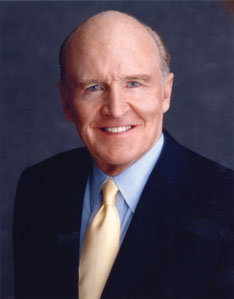 And finally, Jack Welsh weighed in on the topic.
And finally, Jack Welsh weighed in on the topic.
When asked by the interviewer how a business leader can accurately assess an employee's passion, he replied "By the intensity of their questions."
In other words, if you are trying to figure out which person to hire or which employee to assign to a particularly challenging project, make sure you tune into the kinds of questions candidates are asking.
If their questions are flabby or non-existent, it's a dead giveaway that your candidate is ill-equipped to take on the assignment.
If their questions are thoughtful, penetrating, and full of mojo, it's a clue that you are talking to the right person for the job.
SOME QUESTIONS FOR YOUR CONSIDERATION
1. What are you passionate about?
2. How can you make a profound difference on the planet?
3. What do you need to do differently in order to make this difference?
4. Who is your tribe?
5. How can you stay inspired?
6. How can you foster a culture of innovation?
7. What legacy do you want to leave behind?
8. What risk are you willing to take this week?
9. What is your vision?
10. What are your instincts telling you about your hottest, new idea?
Get the right question to brainstorm
Idea Champions
Posted by Mitch Ditkoff at 01:40 PM | Comments (0)
April 08, 2012The Best Kind of Customer Testimonial
Usually, we collect written testimonials from our satisfied clients and post them on this page -- but today, we decided to post a different kind of expression. Apparently, our client really liked the Idea Champions webinar they just experienced.
Posted by Mitch Ditkoff at 09:46 AM | Comments (0)
April 07, 2012Two Wolves
One evening an old Cherokee told his grandson about a battle that goes on inside people.
He said, "My son, the battle is between two wolves inside us all.
"One is Evil. It is anger, envy, jealousy, sorrow, regret, greed, arrogance, self-pity, guilt, resentment, inferiority, lies, false pride, superiority, and ego.
"The other is Good. It is joy, peace, love, hope, serenity, humility, kindness, benevolence, empathy, generosity, truth, compassion and faith."
The grandson thought about it for a minute and then asked his grandfather: "Which wolf wins?"
The old Cherokee simply replied, "The one you feed."
Posted by Mitch Ditkoff at 11:28 PM | Comments (1)
April 06, 2012The Biggest Room in the World

It is sometimes said that the biggest room in the world is the room for improvement. And while this may be true, the aforementioned "biggest room" was also once furnished with all kinds of cool stuff, then, before you could say "double frappucino", was impeccably stashed in a temperature controlled storage unit and through some worm hole time warp of nature, made available here -- on your favorite innovation blog. Hey, we'll even throw in a Free the Genie deck, at no extra charge, with every purchase.
Posted by Mitch Ditkoff at 12:02 AM | Comments (0)
April 01, 2012Our World Wide Webinatrix Speaks!

The writers of this blog are excited, thrilled, and tickled to announce the launching of a entirely new service to the known universe: Webinars powered by Idea Champions University.
Having spent the past 25 years delivering a wide variety of innovation-sparking workshops, trainings, meetings, conferences, and consulting interventions to forward thinking organizations everywhere, we've decided to let go of our addiction to Frequent Flyer miles and go virtual.
Our new venture began with a simple question: "How can we have the biggest impact on the most amount of people in a cost-effective, highly engaging, low carbon footprint way?"
The answer? Build a webinar curriculum and deliver our services online.

Which is exactly what we've done and will continue to do as long as the need in the marketplace exists.
Bottom line, if you're looking for a better way to build the core competency of innovation, you've come to the right place.
No airfare required. No cabs. No sending your people to overpriced hotels and wondering whose gonna cover for them while they're eating muffins and collecting one more three-ring binder they will never read.
Operators are not standing by. But our website is. And so is our integrity -- the collective mojo we've built for the past 25 years with some of the finest organizations in the world.
So visit us online to learn more about what we're offering. And while you're at it, feel free to register for one of our upcoming open-enrollment webinars -- a great way to kick our virtual tires.

If you are one of the first 50 people to register, you'll receive a 50% discount and a free annual subscription to our highly regarded online Free the Genie app.
If you'd rather schedule a group webinar (for up to 100 people), contact Sarah Jacob, our World Wide Webinatrix.
She means business.
Posted by Mitch Ditkoff at 01:48 AM | Comments (0)
March 20, 2012Why Good Leaders Pause
It's often the case that people expect their leaders to be decisive -- able to make difficult decisions quickly. Indeed, this kind of behavior is interpreted as one of the hallmarks of good leadership.
The reality is different, however.
The "rush to judgment" mindset creates undue pressure on leaders -- the kind of pressure that causes them to prematurely choose a path forward even when confronting a complex problem.
To be truly effective, leaders need to balance the need to quickly converge on a single solution with the conflicting requirement that multiple perspectives be considered.
Yes, spending time to gain an understanding of the thought processes behind conflicting perspectives slows down the decision-making process. But it also creates a rich opportunity for much more robust solutions.
Slowing down is not necessarily a sign of procrastination or indecision. More accurately, it is a sign of impending wisdom about to be applied.

Tolerating this period of pause requires leaders to exhibit two qualities that seem to be in short supply these days:
1. Self-confidence (not bravado).
2. Patience (not procrastination).
Unfortunately, as external pressures from above and below increase, leaders experience an increasing tendency to internalize these pressures, causing self-doubt, stress, and a relentless need to prove their worth.
The result? Leaders end up adopting pre-existing solutions not well-suited to the challenges at hand. They decide fast, but the decisions they make are all too often fatally flawed.
Being able to resist mounting pressures to act quickly requires great intestinal fortitude. It requires leaders to keep themselves and others passionately engaged in the process of finding a way through the uncertainty instead of grasping at known "solutions" which only make the problem worse.
This phenomenon is similar to the classic story of the drunkard looking for his car keys under a streetlight even though he knows it's not where he dropped them.
"I know my keys aren't there," he confesses, "but that's where the light is."
It's not easy searching in the dark. Nor is it easy convincing others to join you in the search.
Which is precisely why being an authentic leader is so difficult these days.
- Barry Gruenberg
Here's another one of Barry's fine articles.
Posted by Mitch Ditkoff at 11:39 AM | Comments (0)
March 11, 2012Where Einstein Got His Great Ideas
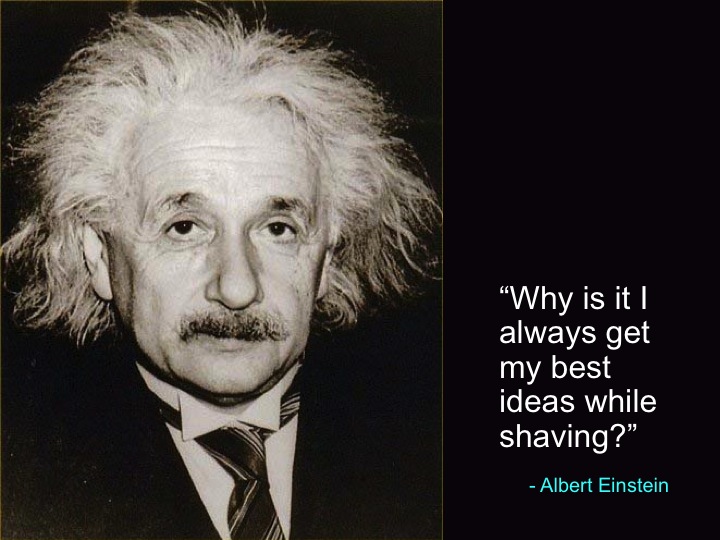
Einstein would have loved this guy
The patron saint of our webinar
Idea Champions
Posted by Mitch Ditkoff at 12:25 AM | Comments (0)
March 10, 2012Going Viral on the Cutting Edge
This is fabulous. Totally refreshing. And since it's all about razor blades, appropriately "edgy". Oh, it's already gotten more then 2.4 million views on YouTube. PS: How can you create a cool viral video that promotes your product or service?
Idea Champions
Get the juices flowing
Posted by Mitch Ditkoff at 07:54 AM | Comments (0)
March 07, 2012How to Capture the Wisdom of Your Organization's Elders

What do Clint Eastwood, Madeline Albright, Willie Nelson, Alan Alda, Desmond Tutu, Jane Goodall, Ravi Shankar, Edward Kennedy, Andrew Wyeth, Frank Gehry and a host of other creative movers and shakers have in common beside fame?
Wisdom!
Click here to see what they've learned in their long and very diverse lives... and get a glimpse of the fabulous Wisdom Project produced by Andrew Zuckerman.
If you work in an organization and are looking for a simple way to capture the wisdom of your senior people before they move on, here's a clue how to do it.
Honor the past, live in the present, be open to the future...
Posted by Mitch Ditkoff at 01:26 AM | Comments (0)
March 01, 2012Reframing Company Politics
Here is a very refreshing take on a topic most of us are not very clear about -- company politics. If you want to be more influential in your organization, this a good place to start.
Posted by Mitch Ditkoff at 04:14 AM | Comments (0)
February 23, 2012Giving In or Giving Up?
Posted by Mitch Ditkoff at 01:24 PM | Comments (0)
February 17, 2012Stick Your Neck Out
If you
want to
go beyond
the status quo
and innovate,
you will
need to
make best use
of available
resources,
adapt,
stick your neck out,
and have
a really good
sense of
humor.
Oh,
a fast
computer
will also
help.
Posted by Mitch Ditkoff at 11:30 PM | Comments (1)
February 15, 2012The Three Dimensions of Client Mix
One of the biggest business challenges for any entrepreneur or organization is "client mix" -- how many of what kind of client or customer to have.
Years ago, a good friend and former client of mine, Edwin Tanaka, clarified this challenge for me with a story about how he managed his world-wide client base for Mitsui Manufacturing.
"I use an agricultural model called Radishes, Wheat, and Trees," he explained.
Puzzled, I asked him to tell me what he meant.
He responded by asking me three questions:
"Have you ever met a guy with a 100 million dollar deal who can't pay for lunch?"
I answered, "Yes, I happen to be working with someone like that right now."
Then he said, "He may not be a bad guy with a bad deal. He is just a tree farmer who has nothing to eat while he waits for his trees to bear fruit."
Then he asked, "Have you ever met a guy with a lot of money and then, soon after that, has no money -- again and again?"
I answered, "Yes, in fact, this describes me quite well."
Edwin went on. "This is not a bad guy. He's just a wheat farmer who goes from feast to famine."
Then he asked, "Have you ever met a guy who is caught up in a lot of small projects, but never seems to do anything big?"
"Yes," I said again, "I know a lot of people like that."
It's simple," Edwin continued. "They are just radish farmers with lots to eat, but not much to show for it."
I asked him what this all meant.
"The smart farmer," he explained, "plants all three. He plants some radishes that harvest every two to four weeks. He also plants wheat, at the same time, and waits six months to a year for it to come to harvest. He also plants trees, at the same time, and eats wheat and radishes while he waits for his trees to bear fruit in 15 to 30 years. The smart farmer plants all three and always has something to eat."
I asked him how this applied to his client base.
"It's all about cultivation and timing," he said. "Smaller clients are radishes and don't need a lot of cultivation. Some clients are wheat and need more cultivation. Some are trees and need a lot of cultivation."
He continued.
"Cultivation requires time, energy, conversation, materials, expenditures, presentations, and the like. If you gave a tree the same cultivation you gave a radish, you would starve it. If you gave a radish the same cultivation you gave a tree you would drown it."
"You have to have the patience of a farmer," he said. "Farmers don't go into their fields and yank on the plants to get them to grow faster. They cultivate them. They let them germinate and grow. For major clients that brought a big return, it would take us a year or two just to get in the door. Smaller clients take much less time, energy, and effort."
"I always made sure," he explained, "that I had a good balance of radishes, wheat, and trees in my portfolio of clients. Most importantly, I never gave them too much of what they didn't need or too little of what they did need."
I never forgot Edwin's words and have applied them in my business for over 20 years. I have shared this story with clients more times that I can count.
In my consulting business, I make sure my bills are paid by the radish clients -- clients that are very regular, but tend to be smaller. They get me to my financial floor and pure survival.
My wheat clients are more project oriented. They take care of the unforeseen financial obstacles and opportunities that inevitably emerge. They come and go on a recurring basis and ensure a level of sufficiency.
My tree clients are the big clients. They take longer to acquire, but they bring abundance.
Each person or business has to define, for themselves, their own profile of a radish, wheat, or tree. There are no rules except one that I learned from Edwin, keep all three in balance.
-- by Paul Roth (Idea Champions' Chief Collaboration Officer
One of Paul's workshops
The Idea Champions team
Illustration
Cartoon
Illustration
Posted by Mitch Ditkoff at 09:42 AM | Comments (1)
February 14, 2012The Arc of a Good Presentation
Posted by Mitch Ditkoff at 08:22 PM | Comments (0)
February 09, 2012The Perfect Woodstock Getaway

When it's time to get away to fabulous Woodstock, NY, consider staying at the Blue Pearl. This extraordinary guest cottage is the perfect retreat for anyone looking to chill (especially this winter.) Located less than a mile from the center of town, the Blue Pearl is gorgeous, cozy, and warm. Mention the phrase Idea Champions when you book your stay and get a free copy of Awake at the Wheel and a year's subscription to Free the Genie.
Posted by Mitch Ditkoff at 03:44 PM | Comments (0)
February 05, 2012A Message for Parents Who Travel

Fifteen years ago I found myself standing in my closet, madly searching for clean clothes in a last minute attempt to pack before yet another business trip, when I noticed my 4-year old son standing at the entrance.
In one hand, he held a small blue wand, in the other -- a plastic bottle of soapy water.
"Dada," he said, looking up at me. "Do you have time to catch my bubbles?"
Time? It stopped. And so did I.

At that moment, it suddenly made no difference whether or not I caught my plane -- I could barely catch my breath. The only thing that existed was him and that soulful look of longing in his eyes.
For the next ten minutes, all we did was play -- him blowing bubbles and laughing. Me catching and laughing, too.
His need was completely satisfied. His need for connection. His need for love. His need for knowing, beyond a shadow of a doubt, that absolutely everything was perfect just the way it was.
Next time you're rushing out of your house for your next business trip, remember to STOP and catch the bubbles. Fifteen years later you won't remember the trip, but you will remember the bubbles.
Posted by Mitch Ditkoff at 11:49 PM | Comments (2)
January 30, 2012The Art and Science of Losing Count
"Not everything that can be counted counts, and not everything that counts can be counted."
-- Albert Einstein
If you have even the slightest respect for the wild-haired father of modern physics, consider this: Your organization's fascination with metrics is often nothing more than a thinly veiled attempt to quantify the unquantifiable -- a compulsive effort to validate that which you and everyone else already know to be true.
I'm not suggesting you abandon metrics (I track, daily, how may unique visitors make it to my website) -- all I'm saying is not everything needs to be measured, at least not all of the time.
The core of your company's "innovation process" is actually less about mind, and more about heart. (And if you're about to ask me how I know that, please read the Einstein quote one more time).
Posted by Mitch Ditkoff at 08:17 AM | Comments (0)
January 27, 2012Ten Simple Mindset Shifts for 2012
This is a marvelous, lucid, well-written blog post by Tom Asacker on ten of the fundamental mindset changes that you and your company will need to honor if you expect to thrive during these radically changing times.
HINT: Your marketing efforts need to be less about branding and more about bonding.
Who, on your team, do you need to meet with to explore Tom's key points? And when will you do it?
Posted by Mitch Ditkoff at 01:26 PM | Comments (0)
January 16, 2012How to Conduct a Virtual Meeting
If the number of the virtual meetings you're attending is going up, but the quality is going down, it's time to reconsider your approach.
Here's a useful article from Nick Morgan, of the Harvard Business Review, on how to maximize the effectiveness of virtual meetings.
Common sense? Yes. But common sense, these days, is uncommon. Nick's 5-point plan elaborates on the following:
1. Recognize virtual meetings are sub-optimal and plan accordingly
2. Plan the virtual meeting in 10-minute increments
3. Pause regularly for group input
4. Label your emotions and ask others to do the same
5. Don't neglect the small talk, but use video
The complete article
Illustration
Posted by Mitch Ditkoff at 07:30 AM | Comments (0)
January 14, 2012Want to Innovate? Start Here!
Failure is not what you think it is
Idea Champions
Thanks to Sarah Jacob for the heads up!
Posted by Mitch Ditkoff at 10:52 PM | Comments (0)
January 07, 2012Go Beyond the Business Blues

For years I was trying to figure out what all my clients had in common. Opposable thumbs? Yes. The Isle of Langerhans. That, too. Big, fat opinions about everything. For sure.
But even more than the aforementioned stuff in the preceding paragraph which you just read and probably haven't yet forgotten even though your short-term memory is getting shorter by the nanosecond and you're probably wondering, by now, why I'm rambling on and on when most blog postings are supposed to be short and sweet, it dawned on me one fine day as I was scraping marinara sauce off my shirt that the main thing all my clients had in common was the blues.
Yes, indeed. The blues. The same blues Muddy Waters had. And Robert Johnson. And BB King. Those blues.
Unlike the blues greats, however, my clients didn't have a way to express their blues. And, in the absence of this opportunity, their God given right to get right was lost.
But no more, brothers and sisters! No more!
Now, even the most buttoned down, white collared, bow-tied creators of spreadsheets at midnight have a chance to get those business blues off their chest and move towards a better future -- not to mention have fun, collaborate, and learn what it takes to innovate on the fly.
Ladies and gentlemen, without any further ado, allow me to introduce you to the world's first business blues band -- Face the Music!.
PS: Should you decide to contact them, be sure to mention that it was Idea Champions who sent you. (We give 5% of our referral fees to TPRF, one of the most well-run and inspired humanitarian organizations in the world).
The Six Sigma Blues
My blues encounter at Pfizer
The Email Blues
The Gotta Have a Process Blues
Idea Champions
Posted by Mitch Ditkoff at 01:33 AM | Comments (0)
January 04, 2012The One For Whom You Create
Poets, lose your pens,
Painters, toss your brushes
in the sea,
Musicians, give your instruments
away, then go for a long walk.
When you're done, keep walking,
notice the beauty all around you.
Don't try to remember
a single thing, breathe.
This holy moment is your poetry,
your art, your song.
Do not concern yourself with giving it form.
The One for whom you create
deeply loves
what you just didn't do.
Posted by Mitch Ditkoff at 09:53 PM | Comments (0)
December 30, 2011How Do You Get Teenagers to Clean Up Their Room?

While it is true that this blog is the third most popular innovation blog in the world, and while it is also true that, last year, I was voted the #1 innovation blogger in the world, both of these factoids pale in comparison to what I am about to present to you in the next paragraph.
Today, I finally realized what all of my blogging has been about for the past four years. Not to monetize my efforts. Not to build the brand of my company. Not to win friends and influence people. No way.

All of that stuff, of course, is nice, but none of it comes within a light year to the question I'm going to lay on you in the next paragraph -- the answer to which may just change the axis upon which the earth rotates or, at the very least, provide millions of parents with the answer to a question they have long since stopped asking.
How do you get teenagers to clean up their room?
As the proud father of a 14-year old girl and 17-year old boy, I now understand that all my efforts to help organizations establish robust, sustainable cultures of innovation is a piece of cake compared to the Olympian task of getting my two teenagers to clean their rooms.
Zen Masters cry when I ask them for advice on this subject. Grandparents laugh. Psychologists look wistfully into the distance and mumble very long German words.
I was beginning to think that no one knows the answer, but then I remembered there are thousands of really smart, creative, entrepreneurial innovators reading this blog -- some of whom are actually parents, and some of whom are actually in the Federal Witness Protection Program.
And so, ladies and gentleman, without further ado (adieu?), if you want to join in the crowd sourced, existential fun, all you need to do is write your answer to my question in the comments section below. (If you can't figure out how to do that, simply shoot me an email me (mitch@ideachampions.com).

To make it worth your while, I will be awarding fabulous prizes to the three people who submit the most insightful and actionable ideas (according to my big, fat highly subjective opinion).
FIRST PRIZE: A lifetime subscription to Free the Genie
SECOND PRIZE: Free the Genie deck
THIRD PRIZE: Awake at the Wheel
But wait, there's more!
I will present all of your suggestions to Jesse (17) and Mimi (14) -- assuming they will come out of their rooms to talk to me. I will then ask for their feedback and post their replies on this blog, along with an announcement of the three winners, in mid-January.
Multiple submissions are perfectly acceptable, even if the submissions, themselves, (like the rooms of teenagers and the parents of teenagers) are not perfect.
Posted by Mitch Ditkoff at 11:26 PM | Comments (5)
December 16, 2011The Atlassian FedEx Day Goes Global

Atlassian is a very successful Australia-based software company founded in 2002. It has 400+ employees, with 125 of them in San Francisco.
It also has more than 17,000 satisfied clients including Google, Netflix, Facebook, Twitter, Skype, LinkedIn, Pixar, Adobe, Hulu, Salesforce, UPS, Nike, and Coca-Cola.
Atlassian's software helps companies organize their data, track it, collaborate about it, and detect/fix bugs in their software.
Yeah, I know... I had never heard of them before either.
But those days may soon be over. Atlassian is fast becoming famous not only for their popular software development tools, but also for their rapidly-spreading innovation creation playfully named "FedEx Day".
Very simply, FedEx Day is a 24-hour innovation immersion event that enables employees to brainstorm, prototype, and pitch their emerging innovations.
Why is it called "FedEx Day"? Because the goal of the 24-hour blitz is for participants to originate, develop, and deliver new products, new services, or business process improvements overnight.
FedEx Days typically begin on a Thursday afternoon at 2:00 pm and end with a spirited round of presentations delivered exactly 24 hours later.
The experience is energizing, empowering, and exciting -- with the company supplying pizza and beer (this DID originate in Australia, after all) for everyone on Thursday night.
The end result? Lots of useful and successful innovations that would not have materialized had employees been required to stick with their "day jobs."
Atlassian has been, internally, conducting FedEx Days (now done quarterly) since 2005. But this program is now spreading like a Charlie Sheen Twitter meme. Many other organizations, like Yahoo, Symantec, Flickr, Hasbro Toy, and the Mayo Clinic have all begun conducting their own versions of FedEx Day.
And, NOW, for the first time ever, Atlassian is offering to send their own FedExperts to one deserving company in order to help them conduct their own FedEx Day.
Explains Jonathan Nolen, one of Atlassian's FedExperts, "It's so exciting. The possibilities are endless. Everyone has great ideas and this gives them a way to unleash the power of those ideas. And it happens all over the organization. It's incredibly inspiring to see this happen in real time."
Atlassian's Annelise Reynolds agrees. "This is part of a new trend in business where companies are understanding the importance of engaging and energizing their employees. It works wonders for both the companies and their employees. The employees have fun and the companies get some great innovations."
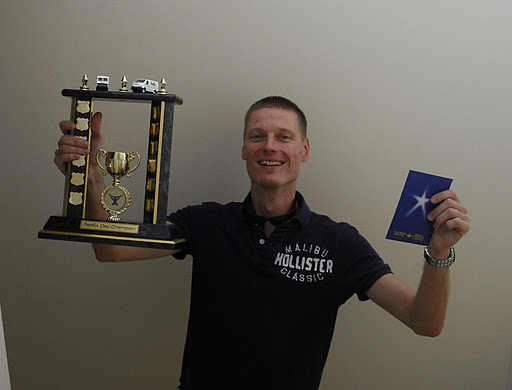
Interested? Want to enter the contest? Click here. Or here to find out what Dan Pink, author of Drive and A Whole New Mind has to say about it.
Entering is simple. All you need to do is fill out this entry form and make a convincing case for why YOUR company or department could use a 24-hour innovation blitz.
Deadline is December 21st, 10:00 PM Pacific Time! Good luck! And good on ya, mate!
- Val Vadeboncoeur
Idea Champions
Posted by Mitch Ditkoff at 07:21 PM | Comments (0)
The Fork in the RoadWhen you come to a fork in the road, how do you know which way to go? How do you decide? Do you have a way to tune in? To yourself? To your team? To your customers?
If you don't, its time to find out how to navigate the expontentially increasing number of options available to you without hurting yourself or anyone else. The good news? It doesn't require Six Sigma or overpriced consultants telling you what time it is with your own watch.
Picture this. You're walking down a road, moving into a bright future, eyes on fire. And then, suddenly, standing there in front of you, is a fork -- a surprisingly bigger than-Godzilla fork. Whaddya do? How do you decide? Which way do you go?
Posted by Mitch Ditkoff at 04:12 PM | Comments (0)
December 14, 2011The Best Practice of Love
A few weeks ago, my wife and I had a huge fight. A doozy. The Superbowl of all fights. If you're married -- or ever were -- I'm sure you've had at least one of these. Probably more.
You think you're right. They think they're right. You attack, they deflect. They attack, you deflect. You get hopeless and weird. They get hopeless and weird.
And both of you -- self-appointed judges in a supreme court of your own creation -- feel diminished, abused, blamed, hurt, ignored, dissed, damaged, and demonized.
The love? Out the window. And the window? Stuck in a half-closed position.
Whenever I'm embroiled in this kind of dynamic and (hallelujah!) manage to make it out the other side, I get majorly humbled -- all concepts of myself as a conscious, loving, evolved human being completely blown to smithereens.
And yet... no matter how painful the experience, something good always comes out of it. A phoenix rises from the ashes. Like the list below, for example -- my wishes for my dear wife, Evelyne, (the day after) and, by extension, you, me, and all the other 8 billion people on planet Earth.
THE BEST PRACTICE OF LOVE: My Wishes for You
1. Gratitude every day
2. Deep inner peace, especially during tough times
3. Kindness
4. Patience
5. Forgiveness
6. The courage to be yourself
7. Rest and renewal
8. The vision to see God in everyone
9. Letting go of self-righteousness
10. Simplicity and ease
11. The willingess to let go of worry and doubt
12. Allowing yourself to be nurtured
13. More fun
14. Plenty of time to do nothing
15. Spaciousness
16. Heartfelt self-expression
17. Health and vitality
18. Moving through the tasks of your life as if you were a dancer
19. Relating to each person you talk to as if they were the only person on earth at that moment
20. Laughter from your core
21. Appreciation of your family
22. A "live and let live" mindset
23. Waking up each day with gladness
24. Humility
25. The experience of community
26. Full responsibility for your own projections
27. Trust
28. Honoring all of the teachers in your life, past and present
29. Slowing down, going deeper
30. The ability to order a very rich dessert in your favorite restaurant without enrolling someone to share it with you
31. A wi-fi connection whenever you want
32. The end of lower back pain
33. Living the St. Francis Prayer without making a big deal of it
34. Knowing you are loved
35. Good sushi within a five-mile radius
36. Appreciation of other people's "spiritual path" -- with absolutely no judgment
37. Foot massages
38. Fresh air
39. Understanding what Krishna meant when he said: "The world is an illusion, but you have to act as if it's real."
40. Random acts of kindness
41. Nights on the town
42. The ability to be alone, but not lonely

43. Accepting the aging process with dignity and delight
44. Fabulous dinners with friends
45. Nights in front of the fire
46. Having no regrets
47. Cranking up the music
48. Not judging your kids for texting or being on Facebook
49. Seeing the blessing in every challenge that comes your way
50. Loving yourself when you look in the mirror
51. Not having to look in the mirror to love yourself
52. New adventures
53. Endless learning
54. Giving up complaint
55. A dependable plumber
56. Snow angels!
57. Working smarter, not harder
58. Looking up at the stars
59. Never going to bed angry
60. Being happy for other people's successes
61. Realizing you are everything and nothing both at the same time
62. Unconditional love
63. Reframing aging as "becoming an elder" instead of "getting old"
64. Weekends in exotic places
65. Someone else to wash the dishes
66. Enjoying the poetry of Rumi, Kabir, and Hafiz
67. Did I mention foot massages?
68. The commitment to immerse in the projects that most fascinate you
69. Deep listening
70. Longer vacations
71. Reaching out to those less fortunate than you
72. Holding hands with someone you love
73. Taking on an impossible project -- and making it happen
74. Really good chocolate
75. Unforgettable celebrations
76. Going beyond your limiting assumptions
77. The discipline that comes from love, not duty
78. Spontaneous generosity
79. One remote for all your electronics
80. A hot bath on a cold night
81. Wonderful surprises
82. The laughter of children
83. Realizing you have enough
84. Timelessness
85. Understanding this quote: "When you're on the path it's a mile wide, when you're off it, it's razor thin."
86. Giving flowers to absolute strangers
87. A wardrobe you love
88. Resilience
88. Making a clear distinction between longing and desire
89. No fear of death
90. Dancing around the living room for no particular reason
91. Howling at the moon
92. Knowing how to say "no" without being negative
93. Completing what you came here to do
94. Experiencing life as a beautiful play
95. Freshly baked chocolate chip cookies
96. Forgiving everyone who has ever wronged you
97. Passion
98. Compassion
99. The peace that passes all understanding
100. Sweet watermelon on a summer day
More
Illustration
Painting
Image
Photo
Photo
Photo
Photo
Photo
Posted by Mitch Ditkoff at 11:58 PM | Comments (0)
December 13, 2011Before Decision, Get a Vision!
Yo!
2012 is right around the corner.
Have you envisioned
what you want to create yet?
Have you unplugged
from your short-term focus
to consider the long-term?
If not, what can you do, this week,
to imagine and conceive
bold new possibilities?
Who do you need to jam with?
What prep can you do?
Where will you meet?
When will you go offline?
And above all,
why is this important to you?
Idea Champions
50 quotes on vision
20 ways to see the invisible
Posted by Mitch Ditkoff at 05:09 PM | Comments (0)
December 12, 2011Shining Eyes and Open Hearts
Ben Zander is the most extraordinary speaker/presenter/catalyst I've ever had the good fortune to experience other than my teacher, Prem Rawat. I first heard Ben at HSM's World Business Forum, in NYC. He entranced 4,000 business people for two hours and ended his enchantment by getting everyone to sing Ode to Joy in German. Ben is a masterful conductor, not just of orchestras, but of the human spirit of what's possible every single minute of the day.
Posted by Mitch Ditkoff at 09:41 PM | Comments (0)
December 10, 2011Be An Innovation Samurai!
If you expect to innovate in 2012, you will need to be more like a Samurai and less like a Slacker. Towards that end, here are the seven classic virtues of a Samurai. Food for thought... and action!
1. Rectitude
2. Courage
3. Benevolence
4. Respect
5. Honesty
6. Honor
7. Loyalty
Idea Champions
Heroic Leadership
Posted by Mitch Ditkoff at 12:02 AM | Comments (0)
December 07, 2011The Movement With No Name
Posted by Mitch Ditkoff at 10:22 AM | Comments (0)
December 06, 2011The Healing Power of Music and Creativity
Inspiring 12-minute video about the power of music and creativity in the lives of teens with HIV. We need more of this approach to life!
Thanks to Eric Booth for the heads up. His book.
Posted by Mitch Ditkoff at 09:19 AM | Comments (0)
December 02, 2011Buy Local, Bye Bye Wal-Mart
Another innovative approach
Idea Champions
Thanks to Val Vadeboncoeur for the heads up
Posted by Mitch Ditkoff at 02:14 PM | Comments (1)
November 22, 2011The Upturn Is Upon Us!
Let me be the first to declare that, despite the gloomy pronouncements of the naysaying media, there is a glorious upturn upon us. Yes, it's true. That is, IF you are willing to shift your focus just a bit and let the joy and happiness inside of you come out.
Idea Champions
Thanks to Aliza Corrado for the heads up!
Posted by Mitch Ditkoff at 10:00 PM | Comments (0)
The Architecture of Great SpeechesVery interesting presentation. Nancy Duarte has demystified the hidden structure of great speeches, using Steve Jobs and Martin Luther King speeches as examples. If you are a public speaker or aspire to deliver keynote presentations, this is a very useful tutorial. (Hint: Start with the current reality, build to the compelling vision of the possible).
Idea Champions
I am, therefore I speak
Posted by Mitch Ditkoff at 09:00 PM | Comments (0)
November 21, 2011Creativity Rated #1 Leadership Quality in Global IBM Poll
Creativity is now considered the most important leadership quality for success in business, outweighing even integrity and global thinking, according to a much-referenced recent study by IBM.
The study is the largest known sample of one-on-one CEO interviews, with over 1,500 corporate heads and public sector leaders across 60 nations and 33 industries polled on what drives them in managing their companies in today's world.
What is YOUR organization doing to help it's senior leaders unleash their creativity?
Illustration
Creative Thinking Training
Ingenious Leadership
Posted by Mitch Ditkoff at 10:48 AM | Comments (2)
November 17, 2011The Perfect Woodstock Getaway

Need a break? Want to get away for the weekend? Interested in visiting Woodstock, NY? Then stay at our fabulous Blue Pearl Guest Cottage. Just a 12 minute walk from town. Renew! Refresh! Revitalize!
Posted by Mitch Ditkoff at 11:43 PM | Comments (0)
November 07, 2011Culture of Innovation Rule #1
If you want to create a sustainable culture of innovation, you will first need to find a way to animate the buoyant energy lurking within each member of your workforce. If you skip this step, you will never hit the critical mass of mojo needed to turn theory into practice. In other words, you need to spark more of the feeling that moves someone to dance, than the thought that moves someone to create the next spreadsheet.
Idea Champions
The Four Currents
50 Ways to Foster a Culture of Innovation
Posted by Mitch Ditkoff at 12:41 AM | Comments (1)
November 06, 2011Going Beyond Digital Distraction
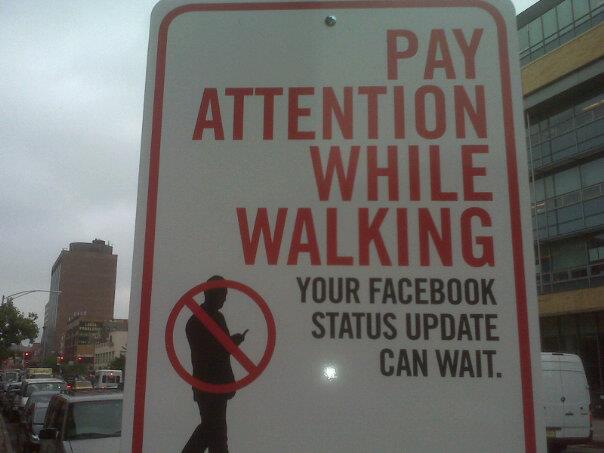
NOTE: The following piece is authored by Sarah Jacob, a new member of the Heart of Innovation blogging team. Sarah will be focusing on all things digital and the launching of Idea Champions new Virtual Innovation University -- a series of webinars and other online experiences that will make our work available to millions of people around the world. Welcome, Sarah!
Last night I read an article about the benefits of unplugging from the constant stream of information and data spew coming our way. The main message? Our addiction to distraction has made "human connection" unlikely, uncommon, and all too often, unavailable.
Forget "to be or not to be." The question these days is "To connect or not connect?"
At any given moment, any one of us is sitting in front of a computer with a seemingly infinite variety of social media options before us: e-mail, Facebook, Twitter, MySpace, Skype, Klout, and Google Plus just to name a few -- our cell phone just inches away ready to deliver the next text message (and the ever-more-rare phone call).
These days, it is easier than ever to connect with people -- a primordial urge that can be traced all the way back to our Neanderthalic roots and the ancient need to be accepted by our tribe.
Indeed, to the amygdala, the number of Likes we get on our latest Facebook status update is really just another form of survival!
"Am I accepted?" we wonder. "Do I belong?" Am I going to get booted from -- or worse, ignored by -- my virtual tribe if my status updates aren't interesting, profound, or funny enough?
Smart phones aside, we're really not all that different from our pre-Industrial Revolution ancestors who had to rely on family, neighbors, and community to harvest crops, raise barns, and fix roofs.
Skyscrapers have replaced farms, but our need to survive is as real as ever -- a need that is no longer satisfied by "job security". Why? There is none these days. It is gone, along with most of our seemingly unshakable economic structures.
Making a living these days is no longer about "getting a job" -- it's about creating work.
The good news? People are getting really creative towards that end. People are becoming their own brand. They are marketing their own unique skills, passions, and value to anyone and everyone who will listen.
They're doing it via social media in ways that blur the line between casual socializing and cunning marketing.
Was your friend's post about her exciting client meeting an enthusiastic desire to share, or was it "creating buzz"? Or both? These days, friends, acquaintances, and business contacts are all swirling around in the same human connection soup -- a soup that seems to be feeding most of us.
And yet, many of us share a gnawing sense that something about this recipe doesn't taste quite right. Something is missing. The mouth goes dry. No amount of drinking quenches our thirst. We are hungry all the time.
Today, for example, I communicated with 40 people and another 200 of my FB friends now know how I feel about the guy in high heels on the subway. But was there even the slightest hint of a sincere connection? A single authentic human exchange?
I'm being asked out on dates via text message and the most contact I've had, in the past three years, with my oldest friend is that she likes my Facebook status updates.
The constant tick of text bytes coming our way has become the digital equivalent of a strange clock ticking high on the wall in an empty room no one ever enters.
What are we really hungry for? What do we really want?
The answer is simple: Meaning. Beauty. Authentic connection. Soul. Experiences like seeing sunlight across a honey-colored wood floor. Like the sound of the wind scattering dry leaves. Like the perfect roundness of your dog's brown eye framed by a crescent of white.
In these all-too-rare moments of stillness come a surprise, an insight, an idea -- something brand new and utterly genius. Something worth sharing with another.
In this moment, without even thinking, you walk across the street to tell your neighbor. The animation in your gestures as you describe your idea is an act of creation. The aliveness you feel as you share your never-before-uttered thought is intoxicating. Your friend listens, really listens.
And if you're like me, you dance.
Idea Champions
Posted by Mitch Ditkoff at 06:23 AM | Comments (0)
October 24, 2011Innovating Is Just Like Dancing
Whatever your innovation goals are for 2012 -- take a cue from the Nicholas Brothers. If you can innovate as well as they can dance, you are home free. Check out their timing, synchronicity, flexibility, creativity, and style -- all clues about to how to deliver an extraordinary outcome.
Posted by Mitch Ditkoff at 03:27 PM | Comments (1)
October 20, 2011Drive Fear Out of the Workplace!
As I understand it, Peter Drucker (world class management guru) was totally committed to driving fear out of the workplace.
He knew (as you do, on a good day) that you cannot have a successful business if fear is running the show.
Fear constricts. Fear depresses. Fear limits the amount of options you have because survival rules the day -- and when survival rules the day, we end up operating like Neanderthals -- perceiving everything as a threat to our well-being.
What's fascinating about this is that all of us, at some level, are afraid -- and we end up bringing our fear into the workplace.
What kind of fear?
Fear of change. Fear of making a mistake. Fear of failure. Fear of being dominated. Fear of being judged. Fear of feedback. Fear of disappointing others. Fear of being overwhelmed. Fear of commitment. Fear of being manipulated. Fear of working hard and having nothing to show for it. Fear of losing your job. Fear of being penniless. Fear of other people. And on and on and on...
Well, then... what to do with all this fear business?
First off, recognize that you (and everyone else around you) is human and, as such, is subject to fear (and fear's second cousins -- anxiety, worry, discomfort, nervousness, agitation, and projection).
Secondly, realize that fear ("False Evidence Appearing Real") is not who you are and not what you want and that it is definitely possible to go beyond it.
And thirdly, do what you can to find the place inside yourself that is free of fear -- the place of faith, confidence, relaxation, clarity, innovation, trust, and resilience.
If you can't find it (and some days it ain't easy), connect with a co-worker, friend, or teammate and air it out. Don't keep your fear bottled up. It will eat you alive from the inside.
Remember, if you are feeling fear, acknowledge it. As Fritz Perls once put it, "Awareness cures." Just being aware of the fact that you are feeling fear, is the first step towards it dissipating.
And remember this: Fear is not necessarily a bad thing. It can also serve you.
Indeed, it was very useful for our Neanderthalic ancestors to feel fear from time to time. Why? Because it alerted them to real danger that needed to be dealt with. It got their adrenelin pumping enough to run from the saber-toothed tiger.
The fact that you are feeling some fear today may simply be due to the fact that you are actually sensing danger (i.e. funky business systems, bad accounting, lack of budgets, poor teamwork, old mindsets) that will eventually bring your business down unless something useful is done. So, that's a good thing.
But it's only a good thing if you let the fear you are feeling translate into intelligent action. Otherwise, you run the risk of being gobbled up by your fear which only leads to crappy feelings of powerlessness, hopelessness, and overwhelm -- not exactly the drivers of innovation and success.
Of course, if there is no saber-toothed tiger (down the hallway, around the corner, in the next office), then there's really no reason to be afraid, is there? If the saber-toothed tiger is only in your mind, you have the option to dismiss it. "Down boy!"
A QUICK GUIDE TO GOING BEYOND FEAR:
1. Acknowledge it.
2. Write down what you are afraid of (or anxious about).
3. Tell someone (a friend, teammate, your boss, your FB friends).
4. Item by item, come up with a game plan for what you (and your company) can do to address the root causes of what it is that is sparking fear in you.
5. Acknowledge your successes each time your fear subsides and is supplanted by relaxation, ease, insight, breakthrough, and success.
OK, oh brave readers of this blog, what else can you do to transmute your fear into breakthrough? Tell us. Leave a comment. Share your wisdom with us.
If we get enough juicy suggestions, we'll publish something like "50 Awesome Things You Can Do to Go Beyond Fear."
Who We Are
Companies that have not been afraid to hire us
Posted by Mitch Ditkoff at 10:25 AM | Comments (0)
October 19, 2011Stocks Are Not the Only Thing That Appreciate
I have been an innovation consultant since 1986 and have worked with hundreds of organizations in more than 15 industries. The products and services of my clients have all been different -- as have their acronyms, mission statements, and cafeteria food.
But they all have one thing in common -- and that is a pronounced tendency to undervalue the power of appreciation.
Sure, they give out gold watches and Employee of the Month awards, but the simple act of acknowledging and appreciating each other on a daily basis is in woeful short supply.
The reasons are many.
Too many managers have come to believe that the expression of appreciation will be counterproductive, leading to a self-satisfied workforce -- a workforce that will be entitled and unmotivated.
The perceived lack of time is another reason.
Most people's plates are so full these days that the time and attention it takes to acknowledge another for their efforts is considered a luxury that cannot be afforded.
A third reason?
The majority of people who work in an organization do not know how to appreciate others. It is not, shall we say, their default condition.
Why should this matter to your organization?
Because there is a direct correlation between appreciation and success. The more appreciation, the more morale improves and the more moral improves, the more willing people are to go the extra yard.
Indeed, recent U.S. Department of Labor data shows that the number one reason people leave their jobs is that they do not feel appreciated. When you quantify the cost of recruiting, orienting, and training people, that adds up. Big time.

Further research has revealed that companies that effectively value and appreciate their employees enjoy more than triple returns on equity and assets and achieve higher operating margins than companies that do not.
Time and again it has been proven: money is not the key driver of employee satisfaction. It is the experience of being appreciated.
"Celebrate what you want to see more," advises management consultant, Tom Peters.
"Appreciate everything your associates do for the business," advised Sam Walton, former CEO of Walmart. "Nothing else can quite substitute for a few well-chosen, well-timed, sincere words of praise."
Mother Teresa agrees: "There is more hunger for love and appreciation in this world than for bread."
The paradox?
Business leaders want their stocks to appreciate, but they don't see the relationship between rising stock prices and the rise in employee performance that comes from employees being genuinely appreciated.
In what ways can YOU lead the charge by authentically expressing your appreciation to someone with whom you work?
GOOD NEWS: I will be giving two keynotes, this week, at Mitre, on this very subject. Contact me if you'd like to get the ball rolling in your organization.
Posted by Mitch Ditkoff at 01:24 PM | Comments (2)
October 18, 2011100 Reasons to Go Within
Since the beginning of time, and even last Thursday, there have always been inner-directed people living on planet Earth -- sincere seekers of truth who realized that the business of life wasn't necessarily a life of business.
They wanted more out of life than stock options, a corner office, and a 401K.
Some of these people radically turned away from the marketplace and ended up in caves, forests, or spiritual retreats. Some sought the guidance of Great Masters. Others, stayed closer to home and simply checked out their nearest yoga class.
Have you ever wondered why people make this choice -- what moves a person to go beyond business as usual and turn within? Well, I have -- and here they are -- 100 of the most common reasons.
Yours may be on it. If it isn't, just let me know and I will add it to the next edition.
100 Reasons to Go Within
1. You just lost your job.
2. Oprah told you to.
3. Your 401K is now a 101K.
4. The world always seems to let you down.
5. You're not getting any younger.
6. You've always been curious about this "going within" business.
7. Someone you love just died.
8. You think the Dalai Lama is cool.
9. You read it in a book.
10. Your girlfriend ran away with your therapist.
11. Your house just burned down.
12. Watching Dancing With the Stars no longer does it for you.
13. You're an unhappy atheist.
14. You've recently been diagnosed with a terminal disease.
15. You're about to have a root canal.
16. Your three-year plan has revealed itself to be a total charade.
17. It's free.
18. You have a living Master who keeps reminding you to go within.
19. Your wife, husband, kids, and hair have all left you.
20. You like what Jesus had to say about it.
21. There's no time like the present.
22. You had a near death experience a while ago, but could never figure out how to stay in that blissful place.
23. Your team just lost the Big Game and you realize that everything you give yourself to in this world eventually disappoints.
24. You're stuck in traffic
25. You're on your death bed
26. You're on vacation
27. Inner space is a lot more interesting than outer space.
28. Space is curved. If you looked long enough through a powerful enough telescope, you'd end up seeing your own butt.
29. You've always been fascinated by the lives of sages, saints, and monks.
30. Nothing else seems to be working for you.
31. You want to build your house of bricks.
32. You've seen Avatar twice.
33. You always knew that going within was important.
34. You finally figured out that the entire world is your projection and the flickering images on the screen aren't the only thing to focus on.
35. There's nothing good on TV.
36. You lost the remote.
37. You lost your way.
38. You read Siddhartha.
39. You'd rather have your own experience than read about someone else's.
40. You love George Harrison.
41. You want to lower your stress.
42. Googling it didn't get you anywhere.
43. You don't believe your own story anymore. (And you're tired of telling it).
44. You realize that your personality is a complete fabrication and you want to find out who (or what) exists behind the mask you call your "self."
45. Your best friend suggested it.
46. You're the reincarnation of Shiva.
47. You're the reincarnation of Shiva's chiropractor.
48. You keep wondering why the spelling of "Shiva" and "Yeshiva" are so similar.
49. You've always favored silence and simplicity.
50. When you go to a video store, it takes you a long time to find anything you want to rent.
51. You once heard Prem Rawat talk about it and it sounded really good.
52. You went on a retreat last month and, even though the people there seemed to be completely full of themselves, smiled too much, and didn't have a sense of humor, you liked the way you felt when you weren't busy judging them.
53. It's good for your blood pressure.
54. You'd rather be on the inside than the outside.
55. The Dow is down (but not the Tao).
56. Your server is down.
57. All roads lead to Om.
58. You don't want to end up like the musk deer who wanders forever in search of the intoxicating fragrance that emanates from its own navel.
59. You prefer Rumi, Hafiz, and Kabir to Lady Gaga.
60. For thousands of lifetimes this is what you've done.
61. Your moon is in the House of Pies.
62. You want to find out what Prem Rawat meant when he said that "there are a lot of people who know there is a drop in the ocean, but only a few who know there is an ocean in the drop."
63. You want your mojo back.
64. Face it. You're just not that happy with your current state of affairs (even though you always tell people you are "fine" when they ask you how you are). It's kind of like you have a low grade virus or know there is a party going on nearby that you haven't been invited to and can't figure out why.
65. The happiest moments of your life have been listening to your Master speak about the beauty of going within.
66. You want shelter from the storm.
67. You've always sensed there was something universal inside of everyone -- far beyond religion or philosophy -- and you want to know what it is.
68. You read Be Here Now many years ago.
69. You're tired of waiting for Christmas, retirement, or a positive cash flow.
70. You've heard there's is at least one living Teacher who can show you how.
71. You'd rather know the "I" than the iPhone.
72. Three magi from Jersey City just showed up at your door. They are each holding a large pepperoni pizza and telling you that you better go within or they're gonna break your kneecaps.
73. Hey, if it doesn't work out, you can always get back into that network marketing thing.
74. Your favorite part of every meal is grace.
75. You don't need any credentials.
76. It's sugar free.
77. Some time ago, for no apparent reason, you experienced a profound sense of gratitude, expansiveness, and joy. Everything made perfect sense. Alas...that feeling came and went. Now you want to get it back.
78. Rush Limbaugh has nothing to do with it.
79. It's non-caloric.
80. Every time you go to a bookstore, you find yourself wandering around the spiritual section.
81. When you were a little kid you alternated between feeling like an orphan and a visitor from another planet. You always wanted to "go home." Now you understand that home is not a geographical place, but a state of consciousness and "going within" has something to do with it.
82. Sex, drugs, and rock 'n roll took you only so far.
83. You realize that Buddha, Jesus, Krishna, and Lao Tzu can't all be wrong.
84. Your most favorite people on planet Earth have all committed to this journey.
85. You understand that to "go within" you don't need to give up bowling, poker, steak, sex, baseball, beer, crossword puzzles, scrabble, sushi, cappuccino, square dancing, break dancing, blogging, basketball, William Burroughs, designer jeans, Otis Redding, jello, science fiction, bonsai trees, tweeting, fruit loops, weightlifting, jazz, bargain hunting, coin collecting, the Kabaalah, dirty jokes, making fun of politicians, arm wrestling, Bruce Lee, Lee Marvin, Marvin Gardens, toasted marshmallows, and googling your own name when no one is watching.
86. You don't want anything else.
87. You realize that if you can't be happy in your own skin, nothing else is ever going to matter.
88. Your favorite songs are all love songs.
89. You feel a deep thirst within that cannot be quenched by anything else.
90. You want to.
91. You have to.
92. It's time.
93. You know that God is within and you would like to make his/her/its acquaintance.
94. Did I mention that you're not getting any younger?
95. Tick tock tick tock.
96. You're tired of the rat race.
97. You've been looking for love in all the wrong places.
98. You're almost coming to the end of this list.
99. You're almost coming to the end of your life.
100. Rush Limbaugh has nothing to do with it.
Posted by Mitch Ditkoff at 11:58 PM | Comments (1)
October 12, 2011The Power of Positive Feedback
Most high level executives do not expect a lot of recognition from others. Nor do they give a lot of recognition to others.
Many managers are like the guy who, when his wife complains that he doesn't tell her he loves her any more, responds that he told her he loved her when he married her -- and he would have let her know if anything had changed.
Similarly, most managers act as if the act of hiring an employee is recognition enough -- and they would have let them know if anything changed.
This in spite of the fact that every one of these managers wants to be valued and appreciated by their superiors, and is regularly disappointed by the lack of appreciation coming their way.
There is a great fear that only the most extraordinary achievements warrant recognition and that all "just good" or superior performance is merely what should be expected and does not require any special recognition...
The fear is that "excessive" recognition will dilute the praise, cheapen it, and reduce future motivation for outstanding performance.
The data, of course, indicates otherwise.
Mere acknowledgment of good performance increases the probability of more good performance. And specificity of feedback -- telling the person exactly what you liked about what they did and why you liked it -- dramatically increases the likelihood of that performance occurring again.
Giving people clear targets increases the likelihood that those targets will be hit, even if no incremental reward is associated with success. Hitting a valued target is rewarding in itself.
If we can get to a place where we are more generous and specific in our positive feedback, we will notice a dramatic increase in the quality of performance and overall satisfaction with work.
- Barry Gruenberg
Posted by Mitch Ditkoff at 08:53 AM | Comments (1)
September 26, 2011Even Michelangelo's David Started Out as a Block

Stuck? Confused? Blocked?
Get over it by printing out this posting, filling in the blanks, and then reading your story aloud. Works wonders! Better than therapy! Cheaper than Prozac!
"Boy, am I blocked! I haven't felt this bad since ___________. I've tried __________________ and ____________________, but nothing seems to work. It's almost laughable the way I'm spending all my time ___________________.
I feel so frustrated I could _________________________.
I hate it when _____________________________. It makes me feel like a ________________ without a ____________.
I'm so tired of ___________________________. Just yesterday, I felt so ___________________ I could see the light at the end of the tunnel.
But now... it feels like the tunnel is filled with ___________________ and the light has turned to ___________________.
Uh oh! What if I stay stuck like this forever?
I can see the writing on my tombstone now: '__________________________ _______________________.' What an epitaph! That would really make me feel like a _________________________________________.
I wish there was someone I could blame besides myself!
Hmmm... Maybe ________________ would make a good person to dump on. If he/she was here with me now, I'd _________________________________________.
How did I get into this situation anyhow? I never really intended to _____________________________________________.
All I wanted was ____________________________.
Why does it have to be so unbelievably difficult? If only I could stop feeling so ________________________________.
Hey! Just last week I got tons of great ideas about my project -- ideas like ____________________ and ____________________ and ______________________.
Any one of those brainstorms could easily be the key. And even if they weren't, I could always ________________________________________.
I could even call ________________ and _______________. They're tuned into my project! Maybe they'd have a clue about how to proceed.
Actually, this is all pretty funny.
I seem to love focusing on my problems instead of possible solutions. Talk about creative! I must have ________ ways to avoid taking the next step.
Which reminds me.... I guess the next thing I need to do is ___________________________. And after that I'll _____________________.

Isn't it fascinating how this stuff works? In a little while, I'll probably look back at this crazy time and realize _____________________
_______________________.
Posted by Mitch Ditkoff at 01:30 AM | Comments (0)
September 24, 201122 Reasons Why We Love Lists

1. Lists simplify.
2. Lists promise instant knowledge.
3. Lists provide choices.
4. We are all victims of information overload. Lists help us make sense of the world.
5. Lists make it seem as if the list maker knows something that list readers don't.
6. Lists appeal to an ever expanding population of ADD sufferers.
7. Lists appeal to the left brain need for order and linearity.
8. Lists are made of soundbytes. Soundbytes 'R Us.
9. Lists are familiar. We grew up making them: laundry lists, grocery lists, and Christmas lists.
10. Lists can be updated, added to, or subtracted from easily.
11. Lists give us an instant opportunity to disagree.
12. Lists, with their declarative headlines, make list readers feel like they are just about to get a crash course on a topic of great significance.
13. Lists, when forwarded to friends or clients, position the list forwarder as a knowledgeable resource.
14. Lists include items that are numbered -- and most readers assume that an item that's numbered must be more true than an item that's merely bulleted.
15. Lists can be printed quickly, folded up, and put into one's pocket -- as opposed to New Yorker articles, the collected works of Henry Miller, or Sunday's New York Times.
16. Items on lists can be easily crossed off, giving the list maker an instant feeling of accomplishment
17. Lists are great ways for list makers, especially in the hyperlinked blogosphere, to plug their own books, products, and services.
18. Lists are easily scanned.
19. Numbered lists provide a sense of progression (either forward or backward).
20. Lists build suspense and excitement.
21. Lists provide bite sized facts and insights.
22. Lists make it easy to refer back to individual points or facts during a conversation ("Let's review point 10 again, it's relevant to what we're talking about right now.... ")
Thanks to Mark Dykeman for #18-22.
Can you think of any others?
Posted by Mitch Ditkoff at 05:04 PM | Comments (0)
September 14, 2011THANK Tanks, Not THINK Tanks
I'd like your feedback on a new idea of mine which I have playfully named THANK TANKS (with the help of one of my FB friends).
The idea, still rough, is for organizations to provide their employees with a practical way to express their appreciation (of each other and the business) -- instead of always harping on what's wrong.
In the same way that Quality Circles were a big hit in the 80's, THANK TANKS (i.e. "Appreciation Circles"), might be exactly what the doctor ordered for these difficult times.
The idea is related to the practice of Appreciative Inquiry, but is not focused on improving organizational processes. Rather, it focuses on the all-too-rare moment of people appreciating each other.
I realize that some business leaders will consider this a trivial pursuit. So be it.
I'm betting there are many forward thinking leaders who will be open to the idea -- especially if the execution of it is simple, engaging, low cost, and raises morale.
At the very least, consider devoting 10 minutes, in some of your meetings, for people to acknowledge each other for all the good stuff that is going on.
Your thoughts? Ideas? Feedback? How do you see this working in your company?
Posted by Mitch Ditkoff at 12:41 PM | Comments (0)
September 06, 2011Innovators Don't Only Dream, They Remember Their Dreams
Many great breakthroughs have come in dreams.
Rene Descartes got the concept for the Scientific Method in a dream. Elias Howe came up with the final design for the lock stitch sewing machine in a dream. August Kekule arrived at the formulation of the Benzene molecule in a dream.
In the dream state, the subconscious mind arrives at solutions that the conscious mind is unlikely to discover during the daily grind -- no matter much it obsesses, gathers data, or blames the "organization."
That's why Thomas Edison and Salvadore Dali used to take naps during the day. They knew they got their best ideas in dreams, so they decided to wake up more than once a day. Yes!
WHAT YOU CAN DO:
1. Before going to bed tonight, bring to mind a compelling question, challenge, or opportunity that you've been wrestling with.
2. As you fall asleep, stay focused on it.
3. When you awake, write your dream down, even if it makes no sense.
4. Stay in bed for a few minutes and reflect on each element of your dream. See if you can make any connections to the question you asked before going to sleep. If so... write them down.
PS: I once asked a group of chemical engineers to remember their dreams after the first day of a two-day creative thinking training I was leading.
Before the session started on the second day, one of the engineers -- with a huge grin on his face -- asked if he could address the full group and proceeded to explain that, the night before, he dreamed the solution to an engineering problem he'd been wrestling with for two years.
With great excitement, he then drew the solution on a flipchart, complete with detailed schematics. His collaborator, also attending the training, just sat there, completely speechless. Then they both started laughing.
"The most exciting phrase to hear in science, the one that heralds new discoveries, is not 'Eureka!' but 'That's funny!'" - Isaac Asimov
Technique excerpted from Awake at the Wheel.
Illustration
Picasso
Idea Champions University
Posted by Mitch Ditkoff at 08:18 PM | Comments (1)
August 23, 2011Create More Time to Innovate
Idea Champions
Awake At The Wheel
Free the Genie
Posted by Mitch Ditkoff at 11:27 AM | Comments (0)
August 20, 2011Exit Through the Gift Shop
It took me a while to finally watch this movie, but now that I have, I am beyond inspired. If you have even the slightest bit of desire to walk the high wire of beautiful insanity in service to whatever it is you are passionate about, this movie is for you. A force of nature. A farce of nature. A testimony to what's possible if you follow the yellow brick road with a camera and a can of spray paint.
Posted by Mitch Ditkoff at 09:32 PM | Comments (0)
August 19, 2011INNOVATORS: Be Who You Are!

Idea Champions
Awake at the Wheel
Image
Posted by Mitch Ditkoff at 01:58 PM | Comments (0)
July 30, 2011The Bridge Over the River Loan
Well, America's financial crisis has finally hit home for me. Today, as I was withdrawing money from my local ATM, the guy behind me -- shirtless and smiling -- asked me if I would be willing to give him a $5,000 "bridge loan" until September.
He goes on to tell me that he's in the process of selling his house and would definitely pay me back in six weeks. Maybe sooner.
Fasten your seat belts, folks! This is going to be an interesting ride.
Posted by Mitch Ditkoff at 11:04 AM | Comments (0)
July 19, 2011Musing on Virtual Collaboration
There's an infinite amount of extraordinary experiences you can manifest when you have an inspired vision, the right technology, and committed people willing to go for it. Turn up the volume!
How can you collaborate virtually to create big time results?
Posted by Mitch Ditkoff at 09:12 PM | Comments (0)
July 04, 2011The First Time Ever I Saw Your Face
We now interrupt this blog about innovation and creative thinking to bring you a beautiful song by a relatively unknown singer, Daya Rawat. Hey, it's the July 4th weekend! No working! No heavy thinking. No planning! It's time to celebrate your independence!
Posted by Mitch Ditkoff at 06:00 PM | Comments (0)
July 02, 2011Dan Pink on Motivation 3.0

Here's a refreshing six-minute interview with Dan Pink (author of Drive and A Whole New Mind) on what it takes for organizations to go from Motivation 2.0 to Motivation 3.0
In other words, how to move towards a workplace environment that creates more soulful employee engagement.
If you're interested in exploring ways of providing employees more time to innovate on the job -- much like Google, 3M, W.L. Gore, and Atlassian have done, this is for you.
Posted by Mitch Ditkoff at 09:28 AM | Comments (0)
June 26, 2011You Want Results? Immerse!
Recently, I polled 140 people to find out what they need "more of" in order to succeed with their various creative projects. The sixth highest rated item was IMMERSION.
And then, this morning, noted in Drive, the Surprising Truth About What Motivates Us, I discovered a great example of how true this is:
Once a quarter, software developers at the Australian company, Atlassian -- for 24 hours -- are allowed to work on whatever they want, in any way they want, with whomever they want. All the company asks is that people show what they've created to the rest of the company at the end of those 24 hours. They call these experiences "FedEx Days," because people have to deliver something overnight.
It turns out that those one-day bursts of intense, undiluted autonomy have produced more innovation and creativity than just about anything else the company has done.
What can YOU do to create more immersion time for yourself and your team?
Posted by Mitch Ditkoff at 07:32 AM | Comments (0)
May 16, 2011A Gift for the Parents of Teens

Idea Champions
Teens End Terrorism!
Posted by Mitch Ditkoff at 12:04 AM | Comments (0)
April 30, 2011Are You My Kinetic Type or Is That a Motion Graphic in Your Pocket?

If a picture is worth a thousand words, then what's a moving picture worth -- or better yet, the word "moving" that's moving?
I am speaking of the fabulous world of kinetic type -- sometimes called motion graphics -- the animation technique that mixes motion and text to express ideas.
The field is not new. It's roots go back to 1899. But the artfulness of it just keeps getting better and better.
Here's a recent example by Mary Jane Fahey.
If you are looking to launch a new campaign, initiative, or get the attention of your information overloaded workforce, think twice before sending yet another email. Think visual. Think graphic. Think kinetic.
Posted by Mitch Ditkoff at 12:39 AM | Comments (0)
April 23, 2011Chubb Business School Rocks!
NOTE: This is the first in a series of posts about Idea Champions clients who are walking the talk and making great strides towards establishing a sustainable culture of innovation.
When Mary Ann Heenehan became Program Manager of the Chubb Business School in 2008, she knew it was her responsibility to keep the already successful program moving forward with vibrant and cutting edge content.
Precisely what that looked like, she didn't yet know.
The goal of the Chubb Business School had always been a simple one -- to support their business units by offering a "mini-MBA type program" that would broaden the perspective, knowledge, and impact of the company's up and coming talent.
Each year, 140 of Chubb's "high potential, high performers" from all over the world, gathered in Scottsdale, Arizona -- in groups of 40-50 -- for precisely that purpose.
Before Heenehan was on board, the program had focused on business acumen and included traditional modules on ethics, change management, and scenario planning.
The program was very popular and recognized as a hallmark learning event at Chubb. The challenge going forward? To maintain its vibrancy and help participants adapt to a radically changing marketplace.
And so Heenehan decided to focus the program on business acumen and innovation. She wanted CBS participants -- no matter what their function -- to think more creatively.
But even more than that, she wanted participants to be more skillful, proactive, and committed to turning their top of the line ideas into bottom line realities.
Action, not just theory.
Astute veteran of the corporate world as she was, Heenehan knew the program was going to need senior leadership support if it was ever going to get off the ground. She wanted Chubb's senior leaders to support and participate in the program because they wanted to become an integral part of Chubb's still-to-be-determined future.
Enter Jon Bidwell, Chubb's Senior VP and Chief Innovation Officer.
If anything was music to Jon's ears, it was the fact that the Chubb Business School was going to focus on innovation. Jon, quite simply, was on a personal crusade to "increase the value and velocity of innovation" within the firm.

He recognized a golden opportunity, collaborating with Heenehan, "to better connect all the competencies, levels, and geographies of the company -- and to push ideas closer to market needs instead of only being driven from top-down."
"We needed people to connect with each other earlier in the innovation process," explained Bidwell. "Innovation, at Chubb, had to become more than event-driven. It had to become the way we do business on a daily basis."
Bidwell and Heenehan both agreed that the gap between theory and practice had to be crossed -- not by words alone, but by real-time experience. Hands on was the name of game. And so it began.
Inspired by the emerging synergies, Heenehan proceeded to re-design a seamless 5-day program, in collaboration with three outside vendors and Chubb's senior leaders, each of whom had a vital piece of the puzzle.
Day 1 would continue to feature Franklin Covey delivering a business acumen session -- sharing timeless principles on what it takes to run a successful business.
Day 2 would be devoted to innovation and feature Idea Champions delivering a highly interactive session that would challenge people to think outside the box, ideate, and learn creative thinking skills that could be applied back on the job to foster a culture of innovation.
Days 3-5 would continue to focus on the development and implementation of those ideas, via an engaging business simulation facilitated by PriSim, a vendor who had been a long-time learning partner in the CBS program along with Franklin Covey.
Throughout the week, Chubb's senior leaders would present their thoughts and perspectives on topics such as professional development, marketplace conditions, international operations, and business case development.
Heenehan worked hard to integrate all of these elements, making sure all three vendors were familiar with each other's work and able to reference each other to build towards a greater whole.
At the end of each session, unlike most corporate training programs, the impact of Chubb's Business School did not end when the week was over. No way. Things were just beginning to heat up.
Graduates of the program were invited to participate in the "CBS Challenge" which operated within Chubb's innovation platform, Motivate, Drive and Deliver.

Innovation efforts moved through idea generation, facilitation and review, and a series of pitches to surface the best ideas focused on profitability and growth.
Ideas selected by each of the idea teams then moved toward business case development and potential presentation to Chubb's Venture Fund Team. (CBS participants soon found themselves presenting a business case in Chubb's Board Room.)
Rebekah Martin, a graduate of the September, 2009 training, is quite familiar with the process.
Rebekah, a Senior CPI Underwriter from Chicago "didn't have any earth-shattering ideas" during her week of training, but five days later, upon reviewing ideas newly posted on the idea intranet, noticed one particular idea that was very relevant to her job.
Relevant and exciting.
She saw a new possibility -- and now that there was an online idea development process in place, had a way to help midwife that possibility.
Before she knew it, Rebekah had become part of a three-person virtual team to further develop the idea and, soon thereafter, prepare to present that idea to senior management, real-time.
"We had the right three people on the team," explained Rebekah, "so it didn't take that much attention away from my day job at all."
In March 2010, Rebekah found herself at Chubb headquarters, co-presenting the idea with one of her cohorts to some of the company's top officers.

"I was fairly new to the company at the time," Martin chuckled, "so I didn't know who all those people were -- or I might have been really nervous."
The presentation was fast-paced, open and relaxed. Response from senior leaders was quite positive. And Rebekah and her team quickly realized how much easier it was than they had assumed to be a vital part of Chubb's innovation process.
Today, their idea (a way to take better advantage of face-to-face interactions with specific customers) is funded and moving through Chubb's innovation pipeline, along with several other winning ideas that emerged from the Chubb Business School.
Currently, six ideas have been funded through the Venture Fund Team, one idea was funded through a regional program, and five ideas have been pitched directly to the strategic business unit for further development.
Countless other ideas that were not selected for further development within the CBS Challenge are "out there" seeking support through branch or regional channels.
"Graduates of Chubb Business School," explains Bidwell, "come out of the program with a deeper understanding of the mechanics of innovation and how to stage the development of a new idea. Some Chubb employees may think you go from an idea right to a 40-page business case document, but that's not how it works. All new ideas are works in progress. They need to be given a fair hearing, aired out, responded to, developed, and presented in a setting conducive to meaningful feedback."
Adds Martin, "I learned a lot about Chubb from this experience. I learned that I really do have a say in what gets developed and out into the market. I find it refreshing that Chubb is actually interested in my ideas and what I think. My ideas don't have to be world-changing to make a difference. Even the simple ones can make a difference."
The CBS program founder beams.
"I'm really proud of what we've created," explains Heenehan. "People are very intrigued with it. We've taken a good, proven program and taken it up several notches."
What's next?
"Well," says Heenehan, "we're always trying to innovate within the innovation program. Originally, we had the three groups of CBS participants competing against each other. We thought it was a good idea at first, but later found it to be unnecessary. We're all on the same team, after all."
"For the 2011 program we made some changes -- eliminating the competitive aspect and allowed teams to function without the competitive aspect. This year, we're going to be more targeted with our assignments, more collaborative during the actual CBS event, and continue raising the bar for innovation at Chubb in new and exciting ways."
About Chubb
Posted by Mitch Ditkoff at 11:55 PM | Comments (3)
April 21, 2011The Scoop on Google's 20% Time

Here's a nice post from Scott Berkun that demystifies some of the hype and hoopla about Google's "20% time" -- the much talked about practice of the high tech giant that gives their employees permission to spend 20% of their work time on projects born of their own fascination.
Illustration
Posted by Mitch Ditkoff at 01:40 AM | Comments (0)
April 14, 2011Beer and the Invention of the Wheel
You may not know it, but I wrote an award-winning book in 2008, Awake at the Wheel. It's a business fable about the creative process. Easy to read. Fun. A real support for aspiring innovators.
I'm guessing the caveman in the Bud Lite ad below would have found a better way of getting their beer to the party if they had read it.
But enough about me. Let's talk about YOU.
Do you have a creative venture that needs an infusion of mojo, inspiration, and clarity?
Yes? Good. Click. Buy.
Posted by Mitch Ditkoff at 02:22 PM | Comments (0)
Who Says Seniors Aren't Innovative?PS: Stay tuned. Later today, we'll be posting an inspiring article on Creativity Late in Life -- great examples of how elders have done some of their most creative work during their "golden years."
Posted by Mitch Ditkoff at 01:37 PM | Comments (0)
April 05, 2011The Trouble With Experts
When somebody asks if you can do something, pause for a moment before saying "NO." Your first thought may be "that's impossible," but upon reflection you can probably figure out how to pull it off.
Indeed, there is a very good chance that what you are being asked to do is not what is really needed, anyway.
Think about it. We usually evaluate what we can contribute to a situation by imagining that there is someone else who really has the required expertise -- and then we interpret our feelings of uncertainty as proof that we are inadequate compared to this all-knowing other (who, by the way, is going through the exact same drill with someone else.)
Sound familiar?
In reality, our uncertainty (and the humility that, hopefully, accompanies it), are the essential elements of what we really bring to the table -- a curiosity about "the situation" -- and an open mindset that helps us listen to multiple points of view without being ruled by preconceived ideas and solutions.
Being curious enough to arrive at a deep understanding of what the problem really consists of is a much more valuable contribution than a knee-jerk offering of a so-called "solution."
The two main problems with high levels of expertise?
1. When all you have a hammer, everything looks like a nail.
2. If you need to be seen as an expert, you'll have very little opportunity to learn anything.
-- Barry Gruenberg
Posted by Mitch Ditkoff at 03:53 AM | Comments (1)
March 02, 2011Got the Process Improvement Blues?
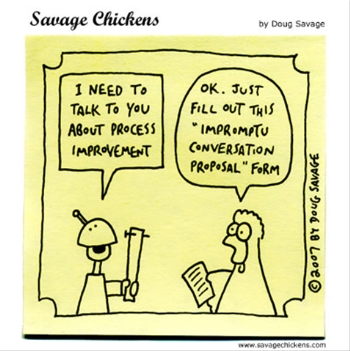
Posted by Mitch Ditkoff at 01:14 PM | Comments (0)
March 01, 2011SNEAK PREVIEW: The President's Speech
Apparently, a sequel to The King's Speech is already underway. According to my sources, it should be in theaters by June. Here's the trailer.
Posted by Mitch Ditkoff at 12:31 AM | Comments (0)
February 28, 2011The 1-Step Program for Ideaholics
I'm sure you've heard about the 12-step program. If you haven't done it yourself, you probably know someone who has.
But have you heard about the 1-step program? Probably not. It's not for alcoholics. It's for ideaholics -- that is, inspired people who got tons of great ideas, but rarely seem to manifest them. Know anyone like that?
Here's how the 1-step program works: you take your next step. That's it. Plain and simple. You don't think about it. You don't obsess about it. You don't go to any meetings trying to figure out why you're not taking your next step. You just take it.
Because you know what you're next step is. You do.
If you think what I'm saying is mere blogspeak, consider this: If someone was holding a gun to your head right now and told you to take your next step with your most inspired idea or else... you'd take it. You would. You know what to do. You just don't have a sense of genuine urgency. You're not living as if your idea matters. Guess what? It does.
Thanks to Scott Cronin for his sage input on this piece... and the change from "Innoholic" to "Ideaholic." Works better that way.
Posted by Mitch Ditkoff at 08:28 AM | Comments (0)
January 04, 2011Do You Really Need More?
An investment banker was standing at the pier of a small coastal village when a small boat with just one fisherman docked. Inside the small boat were several large yellow fin tuna. The banker complimented the fisherman on the quality of his fish and asked how long it took to catch them.
The fisherman replied, "Only a little while."
The banker then asked, "Why didn't you stay out longer and catch more fish?"
The fisherman said, "Why bother? I now have more than enough to support my family's needs."
The banker then asked, "But what do you do with the rest of your time?"
The fisherman said, "I sleep late, fish a little, play with my children, take siesta with my wife, stroll into the village each evening and spend time with my family, I have a full and busy life."
The banker scoffed, "I am a Harvard MBA and could help you. You should spend more time fishing; and with the proceeds, buy a bigger boat! With the proceeds from the bigger boat you could buy several boats. Eventually you would have a fleet of fishing boats. Instead of selling your catch to a middleman you would sell directly to the processor, eventually opening your own cannery. You would control the product, processing and distribution. You would need to leave this small coastal fishing village and move to the capital city. After that, who knows, maybe you could take on the world!"
The fisherman asked, "How long will all of this take?"
To which the banker replied, "I'd say about 15 to 20 years."
"But what then?" asked the fisherman.
The Banker laughed, "That's the best part! When the time is right, you would announce an IPO and sell your company stock to the public and become very rich, you would make millions."
"Millions?...Then what?" the fisherman replied.
"Then you would retire and do whatever you want," said the banker. "What would you want to do?"
The fisherman answered: "I would sleep late, fish a little, play with my children, take siesta with my wife, stroll into the village each evening and spend time with my family."
Idea Champions
My book
Free the Genie
Thanks to Neil Evans for submitting this wonderful story.
Posted by Mitch Ditkoff at 08:53 AM | Comments (0)
December 31, 2010The King's Speech
I don't usually review movies on this blog, but in this case I will make an exception. The King's Speech is an extraordinary movie. Inspiring. Lucid. Compelling. And extremely well acted. If you are looking for your "voice" in 2011, this movie is for you.
Posted by Mitch Ditkoff at 01:22 PM | Comments (1)
December 30, 2010The BEST OF The Heart of Innovation Blog for 2010
Here are the 25 most popular postings on Idea Champions' blog for 2010. As you'll notice, lists are popular. People love lists.
10.0 Thought Leaders Now Being Replaced By Feeling Leaders
10.0 The Four Currents of a Culture of Innovation
10.0 23 Reasons Why Nothing Happens After a Brainstorming Session
10.0 Rethinking Failure
10.0 50 Ways to Foster a Culture of Innovation
10.0 100 Simple Ways to Be More Creative on the Job
10.0 56 Reasons Why Most Corporate Innovation Efforts Fail
10.0 10 Ways to Help Left Brainers Tap Into the Best of Their Creativity
9.7 10 Reasons Why Your CE0 Sabotages Innovation
9.5 41 Ways Business Leaders Can Foster a Culture of Innovation
9.2 The Beauty of What's In Front of You
9.0 innovation from the inside out With Fascination
8.7 25 Awesome Quotes on Creativity
8.6 50 Awesome Quotes on Risk Taking
8.2 20 Qualities of an Innovator
8.0 Metaphors: A Bridge Over Deep Waters
8.0 The Top 100 Lamest Excuses for Not Innovating
7.9 Create Something Before People Know They Need It
7.8 20 Reasons Why Creative People Work in Cafes
7.8 100 Awesome Quotes on What It Really Takes to Innovate
7.7 14 Ways to Get a Breakthrough Idea
7.6 The Good Thing About Bad Ideas
Idea Champions
Our Clients
Our Team
Talking the Talk
Posted by Mitch Ditkoff at 06:34 PM | Comments (0)
NEW FOR 2011: Virtual Coaching for Innovators and Creative ThinkersI've been noticing recently that there are a lot of aspiring innovators, entrepreneurs, intrapraneurs, and closet geniuses "out there" who are working in isolation.
They've got great ideas and the enthusiasm to turn their great ideas into something real, but they have precious little collaboration going on. Bottom line, they're too often working on their own.
Not that there's anything wrong with that. But it's definitely not sufficient.
Human beings -- especially creative human beings -- need community. They need feedback -- not to mention an occasional goose, prod, reality check, and chance to air things out.
Which is precisely why Idea Champions has created a dynamic, new service for 2011 -- Virtual Innovation Coaching.
Simply put, it's a live, online coaching service -- weekly, bi-weekly, monthly, or quarterly -- that will help you:
1. Open your mind to new possibilities
2. Simplify your path forward
3. Solve tough problems in new ways
4. Unleash your hidden genius
5. Discover elegant solutions
6. Make sure you're working on the right problem
7. Generate breakthrough ideas
8. Cut through confusion, doubt, and worry
All you need is a phone, computer, internet connection, and the willingness to make some magic in 2011.
Intrigued? Contact me today (mitch@ideachampions.com) and I will fill you in on the specifics.
Immediate support for you
Idea Champions
My bio
Idea Champions clients
My kick asss
Free the Genie
Posted by Mitch Ditkoff at 09:43 AM | Comments (0)
December 24, 2010Whaddya Gonna Call It?

There is something
you've created
(a business? a book?
a product? a service?)
that is great,
but has the wrong name.
I mean, the name is OK.
It sorta works,
but it lacks,
shall we say,
mojo?
Indeed, there are
many people who are
likely customers of yours
who are not attracted
to whatever you created
because it has the
WRONG NAME.
So change it.
Come up with something new, cooler, buzzier,
more attractive.
Free the Genie
Posted by Mitch Ditkoff at 06:40 PM | Comments (0)
December 17, 2010Get the Creative Juices Flowing!

Looking for a simple way to get the creative juices flowing? Take a tip from Mark Minnichelli, of BASF -- a contented user of our Free the Genie cards.
"We've been using Free the Genie within our business for 3-4 years now. We start most of our meetings by reviewing the ground rules for the meeting, and the last ground rule usually involves someone pulling a Free the Genie card at random, reading the card aloud, and then interpreting the card to make it relevant to our business and the issue at hand.
Free the Genie is a great tool for constantly challenging us to practice the techniques that make us more successful innovators! I carry a deck with me in my briefcase where ever I go, and use the cards regularly."
The online version
The offline version
Idea Champions
Posted by Mitch Ditkoff at 09:25 AM | Comments (0)
Singapore Airlines Rocks!I just flew 19 hours from Newark to Singapore on Singapore Airlines. In a nutshell, here's the difference between Singapore Airlines and all the other airlines.
When it's time to turn off your computer, just before landing, the flight attendant actually comes from a place of kindness and love rather than the gestapo-like monitoring of "bad passenger behavior" that most other airlines seem to be dominated by.
My flight attendant (who was as attentive in the 18th hour of the flight as she was in the first), ASKED me to turn my computer off instead of TELLING me. Huge difference.
After she continued down the aisle, moving like a cool breeze at 36,000 feet, I WANTED to turn my computer off instead of feeling as if my junior high school penmanship teacher had just berated me for something I didn't do.
Singapore Airlines gets it, big time. And it all starts with their flight attendants.
For starters, they like their job. That is totally clear. They treat you like a human being, not a possible disturbance in row 26. And their "customer interactions" don't smell of "training," but of genuine human decency, consciousness, and care.
Here's the bottom line, strange as it may seem. When my flight finally landed, I didn't want to get off the plane. I just wanted to keep flying around -- watching movies, washing with hot towels, and wondering how the Singapore Airlines flight attendants stay so gracefully benevolent for 19 hours in a row.
Posted by Mitch Ditkoff at 07:22 AM | Comments (2)
December 10, 2010Time for Your Elevator Speech!
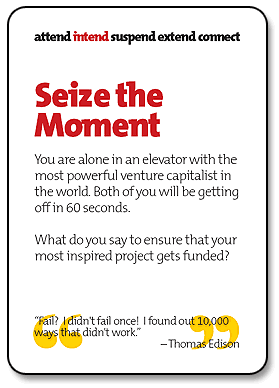
OK.
Let's cut to the chase.
Time is passing, eh?
You've got a BIG IDEA,
but it ain't worth squat
if it's only in your head.
You've to get it
out into the world.
Nor more procrastinating!
You need capital.
You need a sponsor.
You need someone
to invest in you.
Stop waiting for the
tooth fairy,
Kick it in high gear.
Get your rap together.
Not the blues -- gospel!
Free the Genie
The actual card deck
My elevator speech
Posted by Mitch Ditkoff at 10:49 PM | Comments (0)
Speed Is Good (but only sometimes)Is it just me or does it seem as if things are speeding up? I keep noticing that my clients are moving faster and faster -- from one meeting to the next, one project to the next, one day to the next. I think it's time to slow down a bit... but not before watching this video.
Idea Champions
My kick asss (some fast, some slow)
Posted by Mitch Ditkoff at 01:00 PM | Comments (0)
December 03, 2010What You Can Learn from the Bloody Mary
In 1939, a Russian immigrant owned the rights to distribute vodka in the U.S. His efforts bombed, big time. Americans weren't interested in a colorless, odorless alcohol.
Depressed, he sold the rights to Heublein, who asked themselves: "What can we combine with Vodka to give it a distinctive taste and color?"
They came up with tomato juice and, voila, the Bloody Mary was born. Sales? Through the roof.
What most of us think of as an "innovation" is really just the elegant combination of two (or more) pre-existing elements resulting in the creation of a new, value-added product or service.
Want to try it for yourself? Click here for a cool, interactive technique.
Posted by Mitch Ditkoff at 01:39 PM | Comments (0)
November 08, 2010Build a Business Case!

Attention, right brainers!
You obviously
have a great idea.
I know you
are pumped, excited,
fascinated, juiced,
and convinced
your idea
is the next Facebook
or yoyo or whatever.
But it's not enough
for YOU to be convinced.
If you want your idea
to manifest,
you'll need to
convince others,
and that will require
some left brain
business case building.
You can do this!
Start today!
Posted by Mitch Ditkoff at 03:30 PM | Comments (0)
October 28, 2010Live Your Mission
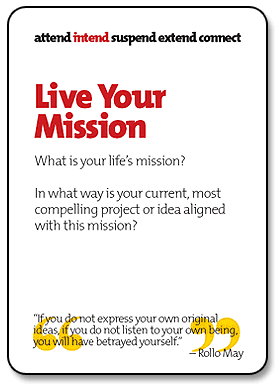
Innovation
is really a
lot simpler
than you think.
If you can tune in
to your mission --
or what some people
would call
"your life's work",
innovation
is like breathing.
It becomes
a natural expression
of your innate
desire to serve.
Here's the deal:
You're not here
to make money.
You're here
to make a difference.
Posted by Mitch Ditkoff at 10:48 PM | Comments (0)
October 27, 2010Follow Your Feeling
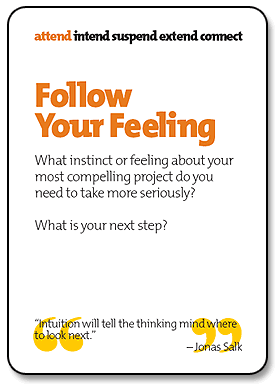
Here's the deal:
You know what to do.
You really do.
There is
something within you
that is
totally tuned in.
You don't need
another focus group.
You don't need
more data.
You don't need
another meeting.
All you need
is to follow
your own instincts.
It's time to
trust yourself.
You can do this!
Ready?
Posted by Mitch Ditkoff at 07:14 AM | Comments (0)
October 06, 2010Create an Innovation Portfolio
One of the biggest obstacles to innovation in most organizations is the addiction to short-term results.
Hustling, speed, and fire fighting rule the day -- resulting in the kind of over-caffeinated efforts that make everyone cranky.
Focusing on your next quarter, of course, is a necessary part of business. But not to the exclusion of the long-term.
Someone's got to focus on projects that won't see the light of day for tree years... or five .... or ten.
If you are serious about innovation, you will need to develop an Innovation Portfolio, one that includes short-term, mid-term, and long-term goals.
Innovation doesn't happen quickly. It takes time.
If you plant an apple seed today, you're not going to get an apple harvest tomorrow... or next week... or next year. Pulling on the seedling or yelling at the tree to deliver apples faster isn't going to work.
Here's an exercise to create your Innovation Portfolio:
1. Define "short-term," "mid-term," and "long-term."
2. Make three columns, headed by each of the phrases above
3. Jot down projects that fit into these three "time horizons."
4. Present this list to your team and get their feedback.
5. Tweak the list as needed.
And now for a related joke...
So there are these three yogis meditating in a cave. They've been there ten years -- in silence the entire time.
One day, in the tenth year of their retreat, an albino mountain lion makes his way to the mouth of the cave and lets out an earth-shattering roar.
Five years pass.
The first yogi says "WOW!"
Another five years pass.
The second yogi, says, "Yeah, I know what you mean."
Five more years pass.
"HEY! If you guys don't shut up," says the third yogi, "I'm moving to another cave."
Posted by Mitch Ditkoff at 09:37 AM | Comments (0)
October 02, 2010The Antidote to Workaholism
"The foolish man
is always doing,
yet much remains
to be done.
The wise man
does nothing,
yet nothing remains
undone."
- Lao Tzu
Posted by Mitch Ditkoff at 12:43 AM | Comments (0)
September 23, 2010Unity Takes Two
Mitch Ditkoff and I have an interesting mercurial chemistry when we get together.
Certain things get completed when we riff and improvise. He and I, and the rest of the Idea Champions crew, have all been talking about what creates a culture of innovation for a few years now. Often, all it takes is two people who have what I call "creative resonance."
Show me any two people who can agree and disagree with equal enthusiasm and respect and I'll show you a duo who can brainstorm persistently at high heat.
A great new series on Creative Pairs at Slate talks eloquently about the dynamic balance and high energy the right two people can create when they "complete" each other.
As a successful professional songwriter, I grew up loving the songs of John Lennon and Paul McCartney, Mick Jagger and Keith Richards, and older teams like Rogers and Hammerstein, the Gershwin brothers, and Lerner and Lowe. It makes perfect sense to a songwriter that creative pairs would launch some of the most successful companies of the last 35 years.
The creative boom in digital technology started in the early 70's with Bill Gates and Paul Allen, Steve Jobs and Steve Wozniak, and continued a generation later when Larry Page and Sergey Brin created Google.
Great duos exist in every vocational and artistic field: Watson and Crick, Gilbert and Sullivan, Engels and Marx.
Two centuries ago, breakthrough composers often arrived in pairs, pacing each other even when they weren't working as teams: piano innovators Chopin and Schumann (both born 1810), opera titans Wagner and Verdi (both born 1813).
Creative pair chemistry ignites when two people spontaneously strike a agreement to both compete and collaborate with each other simultaneously. That tension between collaboration and competition is more easily achieved and managed in pair relationships than any other kind of team configuration.
Joshua Wolf Shenk's Creative Pairs series is now in its third installment at Slate. Part 1 of Inside the Lennon/McCartney Connection starts here and continues on to Part 2.
If you really want to see how simple the crucible of creativity can be, be sure to keep following Shenk's series. You'll think differently about that colleague you argue with all the time.
One little tweak, a mutual change in attitude and mindset, and something magical could happen.
-- Tim Moore
Posted by Tim Moore at 11:08 PM | Comments (0)
Unity Takes TwoMitch Ditkoff and I have an interesting mercurial chemistry when we get together.
Certain things get completed when we riff and improvise. He and I, and the rest of the Idea Champions crew, have all been talking about what creates a culture of innovation for a few years now. Often, all it takes is two people who have what I call "creative resonance."
Show me any two people who can agree and disagree with equal enthusiasm and respect and I'll show you a duo who can brainstorm persistently at high heat.
A great new series on Creative Pairs at Slate talks eloquently about the dynamic balance and high energy the right two people can create when they "complete" each other.
As a successful professional songwriter, I grew up loving the songs of John Lennon and Paul McCartney, Mick Jagger and Keith Richards, and older teams like Rogers and Hammerstein, the Gershwin brothers, and Lerner and Lowe. It makes perfect sense to a songwriter that creative pairs would launch some of the most successful companies of the last 35 years.
The creative boom in digital technology started in the early 70's with Bill Gates and Paul Allen, Steve Jobs and Steve Wozniak, and continued a generation later when Larry Page and Sergey Brin created Google.
Great duos exist in every vocational and artistic field: Watson and Crick, Gilbert and Sullivan, Engels and Marx.
Two centuries ago, breakthrough composers often arrived in pairs, pacing each other even when they weren't working as teams: piano innovators Chopin and Schumann (both born 1810), opera titans Wagner and Verdi (both born 1813).
Creative pair chemistry ignites when two people spontaneously strike a agreement to both compete and collaborate with each other simultaneously. That tension between collaboration and competition is more easily achieved and managed in pair relationships than any other kind of team configuration.
Joshua Wolf Shenk's Creative Pairs series is now in its third installment at Slate. Part 1 of Inside the Lennon/McCartney Connection starts here and continues on to Part 2.
If you really want to see how simple the crucible of creativity can be, be sure to keep following Shenk's series. You'll think differently about that colleague you argue with all the time.
One little tweak, a mutual change in attitude and mindset, and something magical could happen.
-- Tim Moore
Posted by Tim Moore at 11:08 PM | Comments (0)
August 31, 2010The Power of Intrinsic Motivation
/>
Posted by Mitch Ditkoff at 12:11 AM | Comments (1)
July 23, 2010Give Your Workforce More Time to Innovate!
During the past few years I've noticed a curious paradox heading its ugly rear among business leaders tooting the horn for innovation.
On one hand they want the rank and file to step up to the plate and own the effort to innovate.
On the other hand, they are unwilling to grant the people they are exhorting any more TIME to innovate.
Somehow, magically, they expect aspiring innovators to not only generate game-changing ideas in their spare time, but do all the research, data collection, business case building, piloting, project management, idea development, testing, report generation, and troubleshooting in between their other assignments.
Tooth fairy alert!
This is not the way it happens, folks!
Not only is this approach unreasonable, it's unfair, unbalanced, and unworkable. You cannot shoehorn game-changing innovation projects into the already overcommitted schedules of your overworked workforce.
If you do, it won't be innovation you'll get, only half-finished projects and a whole lot of cranky people complaining to you in between meetings.
Aspiring innovators don't need pep talks. They need TIME. Time to think. And time to dream. Time to collaborate. And time to plan. Time to pilot. And time to test. Time to tinker. And time to tinker again.
(Yes, I know there are always a select few fire-in-the-belly mavericks who will innovate under any circumstance, but I am NOT talking about these people. I'm talking about the other 95% who would greatly benefit from more time to explore, noodle, and immerse.)
That's why Google and 3M give its workforce 20% of their time to work on projects not immediately connected to its core business. That's why W.L. Gore gives its workforce a half day a week to follow their fascinations. That's why Corel instituted it's virtual garage program.
"Dig where the oil is," Edward deBono once said.
Indeed! And where is the oil? Right beneath the feet of each and every employee who is fascinated by the work they do, aligned with their company's mission, and given enough time to make magic happen.
Need proof? 50% of Google's newly launched features were birthed during this so-called "free time" -- midwived by engineers, programmers, and other assorted wizards happily following their muse.
The fear? If you give people "freedom" they'll end up playing video games and taking 3-hour lunches. Alas, when fear takes over, folks, (the same fear Peter Drucker asked us all many years ago to remove from the workplace), vision is supplanted by supervision and all his micromanaging cousins.
Time to innovate is not time wasted. It is time invested. Freedom does not necessarily lead to anarchy. It can lead to breakthrough just as easily.
Remember, organizations do not innovate. People do.
And people need time to innovate. Time = freedom. Freedom to choose. Freedom to explore. Freedom to express. And yes, even freedom to fail.
If you've hired the right people, communicated a compelling vision, and established the kind of culture that brings out the best in a human being, you are 80% there.
Now all you need to do is find a way to give your people the time they need to innovate -- or at least MORE time than they have now.
Photo
Idea Champions
Follow me on Twitter
Posted by Mitch Ditkoff at 08:05 PM | Comments (1)
July 12, 2010Thought Leaders Now Being Replaced By Feeling Leaders
A few weeks ago I attended the World Innovation Forum in NYCMy big insight? Thought leaders will soon be a thing of the past.
In their place? Feeling leaders -- business savants who have made the journey from head to heart and aren't afraid to let the rest of us know what they've learned along the way.
I'm not talking warm and fuzzy. Nor am I diminishing the thoughtfulness of the presenters at the World Innovation Forum. They were. Thoughtful, that is. Very.
But it wasn't so much their thinking that moved me -- as it was the feeling behind their thinking.
No matter what business you're in, the engine of innovation is really about being moved. That's what movements are made of -- the heartfelt, intrinsically motivated effort to get off of dead center and accomplish something meaningful.
This is the crossroads all of us are standing at these days -- the intersection between this and that. What the newspaper industry is going through. And the music industry. And the television industry -- just to name a few.
My heroes, these days, are the people who don't just stand at the crossroads, but dance -- inspired individuals who find great delight in the paradoxes, get juiced by the challenges, and realize that "innovation" is not a program, initiative, or model, but a way of life.
That's the main reason why I enjoyed the World Innovation Forum so much.
Because that was precisely the mindset of the presenters -- and the people who attended -- no matter what industry, pedigree, or astrological sign.
As I watched the WIF presenters do their conference thang, I got some unexpected insights into the art and science of delivering a memorable presentation to a global audience of innovation-hungry patrons.
So, for all of you conference kick ass wannabees out there, take note. Here's part 1 of your tutorial.
1. Be in tune with your purpose: If you're going to hold an audience's attention for more than 10 minutes, you've got to begin by holding firm to your purpose... your calling... what gets you out of bed in the morning. If it's missing, all you could ever hope to deliver is a speech -- which is NOT what people want to hear.
If your purpose is clear, you're home free and won't need a single note card.
Mark Twain said it best: "If you speak the truth, you don't need to remember a thing."
2. Be passionate: Realize you are on the stage to let it rip. Completely. People are sitting in the audience because they want an experience, not just information. They want to feel something, not just hear something.
So play full out. Pull the rip cord. Jump!
3. Connect with the audience: You may know a lot of stuff. You may have a double Ph.D, but unless you know how to connect with the audience, your knowledge ain't worth squat.
If you were a tree falling in a conference room, no one would hear it.
So tune in! Establish rapport! Connect! And that begins by respecting your audience and realizing you are there to serve, not preach.
4. Tell stories: That's how great teachers have communicated since the beginning of time. Storytelling is the most effective way to disarm the skeptic and deliver meaning in a memorable way.
"The world is not made of atoms," explained poet, Muriel Rukyser. "It's made of stories."
No bull. Parable!

5. Have a sense of humor: There's a reason why HAHA and AHA are almost spelled the same. Both are about the experience of breakthrough. And both are sparked when the known is replaced by the unknown, when continuity is replaced by discontinuity.
Hey, admit it. At the end of the day, if you can't find the humor in business, you're screwed. So, why wait for the end of the day. Find the humor now.
6. Get visual: It's become a corporate sport to make fun of power point, but power point can be a thrill if done right. A picture really is worth a thousand words.
If you want to spark people's imagination, use images more than words. The root of the word imagination is image.
7. Have confidence: Do you know what the root of the word "confidence" is? It comes from the Latin "con-fide" -- meaning "to have faith." Have faith in what? Yourself.
That's not ego. It's the natural expression of a human being coming from the place of being called.

So, if you're about to walk out on stage and are feeling the impostor syndrome coming on, stop and get in touch with what is calling you.
Let that guy/gal speak.
8. Trim the Fat: When Michelangelo was asked how he made the David, he said it was simple -- that he merely took away "everything that wasn't."
The same holds for you, oh aspiring-kick ass-presenter-at-some-future high-profile-conference (or, at the very least, pep-talk-giver to your kid's Junior High School soccer team).
Keep it simple. Or, as Patti LaBarre, the delightful MC at the World Innovation Forum put it, "Minimize your jargon footprint."
9. Celebrate what works: If you want to raise healthy kids, reinforce their positive behaviors -- don't obsess on the negative. The same holds true for conference kick asss.
If you want to raise a healthy audience, give them examples of what's working out there in the marketplace. Feature the "bright spots," as Chip Heath likes to say. Share victories, best practices, and lessons learned.

Save the bitching and moaning for your therapist.
10. Walk the Talk: Good presenters are genuinely moved. Being genuinely moved, it's natural for them come out from behind the podium and actually move around the stage -- as in, walking the talk.
Big thanks to Michael Porter, Michael Howe, Jeff Kindler, Chip Heath, Andreas Weigend, Biz Stone, Seth Godin, Brian Shawn Cohen, Wendy Kopp, Ursula Burns, Joel Makower, Jeffrey Hollender and Robert Brunner for their presentations at the World Innovation Forum.
Special thanks to Seth Godin for his bold effort to remind people that "there is no map, not even a fictional map" -- and that all he could do was point the way there. Lucid. (Start walking, people!)
DVDs from past World Innovation Forums, are available here.
To subscribe to HSM's Inspiring Ideas Newsletter, click here.
For articles, interviews, videos and podcasts featuring leading business experts, thought leaders, and the latest management training, do not move to Montana. Click here, instead.
This link? Well, let's consider this the token surprise link in today's Heart of Innovation posting. It's kind of like the prize in the crackerjack box. Come on! Take a risk! Click already.
And last, but not least, a big thank you to Patricia Meier, Santiago Muro, George Levy, Becky Gee, Sebastian Mackinlay, Kelsey Woods, and the entire HSM team for all their hard work, good cheer, and vision to make this year's WIF such a delight.
Posted by Mitch Ditkoff at 12:57 AM | Comments (19)
June 28, 2010Six Ways to Go Beyond Your Assumptions
If you want to innovate, the first thing you'll need to do is check your assumptions -- those arbitrary lines you've delicately drawn in the sand.
The so-called "box" people say they want to get out of? Nothing more than their collective assumptions -- and, Lordy, there have been many throughout history.
Some real whoppers.
Assumptions are your blind spots -- what you don't know you don't know -- what you don't see when you look in the mirror just before crashing into the car about to pass you.
OK. Time is passing, too. What to do so you can undo?
SIX WAYS TO GO BEYOND YOUR LIMITING ASSUMPTIONS
1. Make a list of what you think they are.
2. Ask your friends, co-workers, and clients to add to your list.
3. Read these 30 examples, then note your own.
4. Brainstorm your biggest opportunity through the eyes of someone else.
5. Every time you see a FedEx logo, ask yourself: "What am I assuming about Project X?"
6. Turn your biggest assumption into a "How can I?" question, then brainstorm it with friends.
This is just a starter list. You got more? Let me hear from you.
Or, you can invite me in to your organization in order (or disorder) to shed a little non-refracted light on the topic.
Unless, of course, you're assuming I'm too expensive or any number of the other top hundred reasons why you think it can't happen.
Posted by Mitch Ditkoff at 06:56 AM | Comments (0)
June 20, 2010Breakthrough As an Accident Waiting to Happen
Contrary to popular belief, breakthroughs are less about the act of inventing new things than they are the art of recognizing "happy accidents" -- those unexpected moments when an elegant solution reveals itself for no particular reason.
The discovery of penicillin?
The result of Alexander Fleming noticing the formation of mold on the side of a Petri dish left unattended overnight.
Vulcanized rubber?
Discovered in 1839 when Charles Goodyear accidentally dropped a lump of the polymer substance he was experimenting with onto his wife's cook stove.
The post-it? An accident in the lab. After all, 3M made adhesives -- things that stick -- and the post-it didn't stick all that well.
Breakthroughs aren't always about inventing things. They're often about the intervention required to notice something new and surprising.
For this to happen, you'll need to let go of your expectations and assumptions. Not to mention, ideas, concepts, beliefs, paradigms, and dinner plans.
Bottom line, you'll need to get really curious and allow yourself the luxury of following your curiosity to the ends of the earth.
What pundits typically refer to as "brilliance" is less about IQ or enlightened vision than it is letting your eyes adjust to the available light -- so you can see what's already there.
"I invent nothing," said Rodin. "I rediscover."
What failed experiment of yours or unexpected outcome might be worth taking another look at?
Posted by Mitch Ditkoff at 11:45 PM | Comments (0)
May 30, 201020 Ways to See The Invisible
See that FedEx logo on the truck? What do you notice? Letters? Colors? Shapes? Probably. But if that's all you see, you are missing something.
Take another look. Do you see an arrow? A white arrow. No? Look again. Look at the space in between the "E" and the "x". The white space. See it? Cool, huh?
Well then, given our tendency to miss what's right in front of us, is there a way to increase our ability to see the invisible?
Yes, there is. And here, dear readers, are 20 simple ways to begin. Choose one. Experiment. Then see what happens...
20 Ways to See the Invisible
1. Pay attention to your dreams.
2. Honor synchronicity.
3. Immerse. Dive in.
4. Stop projecting your own assumptions onto everything.
5. Trust your instincts more.
6. Let go of attachment to your thoughts.
7. Ask impossible questions.
8. Notice patterns.
9. Sneak up on your project (work in the cracks).
10. Let go of doubt.
11. Work in a different environment.
12. Ask friends to tell you what your blind spots are.
13. Look through the eyes of the person who inspires you the most.
14. Take a break.
15. Slow way down.
16. Share your AHAs.
17. Daydream.
18. Stop trying so hard.
19. Ask children for the answer.
20. Invite unusual suspects to share their point of view.
By the way, every time I see a FedEx truck these days, I stop and ask myself "What am I not seeing?" It only takes 10 seconds, but usually reveals some very useful insights. And even when it doesn't, the act of asking the question opens my eyes a bit wider.
Here's to the revelation of your white arrow!
Posted by Mitch Ditkoff at 10:06 AM | Comments (1)
May 24, 2010All Ducks Do Not Walk in a Row
Breakthrough results are not always the result of a revolutionary Eureka moment. Quite the opposite.
They are often the result of doubt, confusion, ambiguity, and experiments that go awry.
When Thomas Edison was asked how it felt to fail 800 times before coming up with tungsten as the filament for the light bulb, his answer was a revealing one. "Fail?" he said. "I didn't fail once. I learned 800 times what didn't work."
Edison had the ability to tolerate ambiguity.
Like most breakthrough thinkers, he had the ability to dwell in the grey zone -- the space between knowing and not knowing. He had faith in the creative process and was willing to be disoriented, muddled, baffled, and confused because he knew that stuff was often a pre-condition to discovery.
Confusion was not his enemy.
"Confusion," as Henry Miller put it, "is simply a word we have invented for an order that is not yet understood."
Kapish?
If you are trying to birth a breakthrough idea, product, service, or business, get comfortable with ambiguity.
Even more importantly, get comfortable with the discomfort that accompanies ambiguity. Give up your addiction to having all your ducks in a row.
People may think you're a quack, but so what? Ducks don't always march in a row. And those that do, may be closer to wind-up toys that the real thing.
Besides, wasn't the universe itself born from chaos? All those swirling gases! All those nebulae! And all without a Starbucks in sight!
THE BIG QUESTION: What new idea of yours is bubbling on the brink of breakthrough? In what ways can you stay with it -- even if you are impatient for an answer NOW?
More about the creative process
Photo
Posted by Mitch Ditkoff at 09:55 AM | Comments (0)
May 18, 2010Are You a Happy Manager?
Managers, in most organizations, are expected to be efficient, effective, organized, focused, strategic, forward-thinking, and committed.
They are not expected to be HAPPY.
Happiness, as a "management attribute" is usually way down the list -- something reserved for the weekends, stock splits, or Christmas parties.
But recent research on the subject flips this kind of thinking on it's ear.
In today's highly stressed workplace, the time has never been as ripe for managers to radiate genuine happiness.
More about this here.
Posted by Mitch Ditkoff at 07:25 AM | Comments (0)
March 31, 2010The Art of Good Decision Making
A good decision that everyone owns and supports is better than a great decision that is only owned by the boss.
Even when the boss's conviction about a desired direction or solution is warranted, it is often insufficient to ensure a high quality decision.
Why? Because a critical part of a high quality decision is its implementation. Commitment to high quality implementation often requires discretionary effort -- the kind of effort that is the outgrowth of real belief and sustained ownership of the desired direction.
This belief and ownership of a given outcome is generally an outgrowth of the quality of the decision-making process, especially the degree to which all participants have had the opportunity to contribute to the outcome.
Good decision making is often a case of pay me now or pay me later.
If sufficient time is not devoted to including all key implementers in the decision-making process, time will be saved on the front-end (i.e. the time required for processing everyone's contributions) -- but lost on the back-end (i.e. the time required to deal with lackluster implementation efforts.)
If the person in authority wants to exert true leadership, what's required is creating context for effective dialogue in which all ideas are heard and appreciated... and a solution is reached... and a decision made that builds on a distillation of the best of all available perspectives.
When authority is used to create and maintain a high quality decision making process, the result is usually a high quality solution and a high level of commitment to the outcome.
Posted by Mitch Ditkoff at 12:28 AM | Comments (1)
March 21, 2010Create Something Before People Know They Need It!
Here's a juicy definition of innovation from the almost omnipresent Guy Kawasaki. (Excerpted from a recent interview by Diann Daniel of CIO.com)
"Innovation is creating something before people know they need it. The process involves building upon the work of others -- i.e. "copying," grinding it out, and deleting what doesn't work to jump to the next curve. Innovation isn't a lightning bolt of inspiration in the middle of a muse. More often than not, it's a process of grinding, cogitating, and doubting. There truly is no shortcut to innovation. Over the course of a career, you come up with dozens, if not hundreds of ideas, and reject most, try some, and you are lucky if a handful succeed."
Posted by Mitch Ditkoff at 12:23 AM | Comments (3)
March 15, 2010Real Innovation in Health Care

If your organization is interested in raising the bar for innovation and maximizing the creativity of its workforce, you might be interested in the following comment we just received from AtlantiCare's President of Health Care Services, Don Parker...
"AtlantiCare was searching for guides who could help us infuse our organization with creative genius. What we found in Idea Champions was the 'Lewis and Clark' of innovation. Over the past two years of our work with them, we have blazed trails in a number of new areas, including:
1. The seating of a system-wide Innovation Council charged with the responsibility of stimulating and guiding the application of innovation principles throughout our organization.
2. The selection and training of Creativity Champions deployed throughout our organization to assist in new process design, redesign, and remediation of performance problems.
3. The creation of a new, innovative program for random and focused idea submission. (All ideas are responded to, referred to the appropriate process owners, and rewarded when and implemented).
4. Management training and deployment strategies on innovation for more than 350 middle managers.
5. Innovation processes, practices, and knowledge embedded throughout our 5,200 employee workforce.
"No organization, especially those in Health Care, can expect to thrive -- let along survive -- without drawing on all of the collective talent and ideas of their workforce. Idea Champions helps us discover and apply those talents and ideas in a highly productive and practical system. With their guidance, we expect to continue to blaze new trails as we meet the challenges of Health Care Reform."
NOTE: AtlantiCare is one of America's five recipients of the 2009 Baldrige Award. They were recently acknowledged for this accomplishment by President Obama.
Posted by Mitch Ditkoff at 11:01 AM | Comments (0)
March 04, 2010The Third Eye of the Brainstorm
Nowhere in the human psyche is the conflict between the need for independence and the need for support more pronounced than in the creative act, especially the very specific act of generating new ideas in a group -- an activity that has come to be known as brainstorming.
Historically, most people have believed that ideas come to them like bolts from the blue, flashes of inspiration that descend from the
beyond -- a dimension free of the laws of Earth.
Even the modern dictionary speaks of ideas as "transcendent entities." The implication of this way of thinking is that people need to be highly attuned in order to attract new ideas -- becoming a kind of channel through which ideas flow.
The importance of other people, in this approach, is almost non-existent.
Thus the desire for many creative types to seek solitude, moon howling, and any number of artificial stimulants -- whatever it takes to increase their chances of tapping into the exoteric source of brilliance.
But there is another way to get ideas -- a way that does not require solitude, long walks, opium, or surprise visitations from the muse. Quite the contrary.
This approach requires people -- committed people who come together with a focused intention to collectively tap into the unknown, unseen, and untried.
For want of a better word, let's call this activity "brainstorming" -- the creative act by which exciting new ideas are generated through the catalytic action of one mind upon another.
Or, to put it more simply, two heads are better than one.
Unfortunately, the word "brainstorming" has become totally abused in our culture. Like the phrase "Web 2.0," it is applied to anything and everything until it means absolutely nothing.
Meeting with friends to talk about a business deal? "We're brainstorming."
Tossing a few ideas around over cappuccino? "Um... brainstorming."
Kicking around a concept for a screenplay? "Brainstorming, dude."
Not really.
What most people call brainstorming these days is usually just a veiled attempt to impress others with their particular brand of "genius," a caffeinated opportunity to trot out pet ideas, foist opinions, or play out a lifelong ambition to dominate a group.
Brainmisting? Maybe. Braindrizzling? Sure. But not brainstorming. Uh-uh. No way.
Real brainstorming is different. Very different.
High Velocity Brainstorming
Conducting Genius
More on the topic
Posted by Mitch Ditkoff at 12:03 AM | Comments (0)
February 21, 2010You Decide the Value of Our Services
Ten months ago, I heard an intriguing report on the radio. Seems like the Java Street Cafe in Kettering, Ohio, slammed by the economic meltdown, had erased all prices from its menu and was letting customers decide what they wanted to pay...
And so, in the spirit of innovation and removing all obstacles to entry, Idea Champions has decided to make the same offer to all organizations who have never done business with us.
For the months of March, April and May, any organization who engages the following services of ours (High Velocity Brainstorming, Banking on Innovation, Do More With Less, Team Innovation, or Applied Innovation), only pays expenses and what they think our services are worth.
Interested? Call us at 845.679.1066 and let's talk turkey -- or turkey burger.
Posted by Mitch Ditkoff at 10:49 AM | Comments (0)
The Rise of the Innovation NinjasEvery once in a while I come across a quote or excerpt from an article that I want to immediately post on the windshield of every client of mine. It cuts to the chase and lucidly states what I've been trying to say, in various Neanderthalic ways, all these many years.
Take Einstein for example: "Not everything that counts can be counted; and not everything that can be counted counts." Bingo! Bullseye! What a perfect way of explaining to a left-brained addicted world that metrics and analysis is not the only game in town.
And then there's Gary Hamel. He takes a bit more time than Albert to make his point, but hey, it's all relative isn't it? Check this out from the man behind one of my favorite business books of all time:
"Today, innovation is the buzzword du jour in virtually every company, but how many CEOs have put every employee through an intensive training program aimed at boosting the innovation skills of the rank and file? Sure companies have electronic suggestion boxes, slush funds for new ideas, elaborate pipeline management tools, and innovation awards -- but in the absence of a cadre of extensively trained and highly skilled innovators, much of the investment in these innovation enablers will simply be wasted."
"Imagine that you coaxed a keen, but woefully inexperienced golfer onto the first tee at Pebble Beach. After arming the tyro with the latest titanium driver, you challenge him to split the fairway with a monster drive. You promise the neophyte a $100 bonus every time he hits a long bomb that stays out of the rough, and another $100 for every hole where he manages to break par.
But what you don't do is this: You don't give him any instruction -- no books, no tips from Golf Digest, no Dave Pelz and Butch Harmon, no video feedback, and no time off to perfect his swing on the practice range. Given this scenario, how many 200-yard drives is our beginner likely to land in the fairway?
How long is he likely to stay avidly devoted to the task at hand? And what kind of return are you likely to get on the $2,000 you spent on a bag full of high tech clubs and the 450 bucks you shelled out for a tee time? The answers are: Not many, not long, and not much. And no one who knows anything about golf would ever set up such a half-assed contest.
"That's why I'm dumbfounded by the fact that so few executives have invested in the innovation skills of their frontline employees. The least charitable explanation for this mind-boggling oversight: senior managers subscribe to a sort of innovation apartheid.
They believe that a few blessed souls are genetically equipped to be creative, while everyone else is a dullard, unable to come up with anything more exciting than spiritless suggestions for Six Sigma improvements.
A more charitable reading: CEOs and corporate HR leaders simply don't know how to turn on the innovation genes that are found in every human being.
"Obviously, you can't teach someone to be an innovator unless you know where game-changing ideas come from. In other words, you need a theory of innovation -- like Ben Hogan's theory of the golf swing.
This is why, a few years back, I and several colleagues analyzed more than a hundred cases of business innovation. Our goal: to understand why some individuals, at certain points in time, are able to see opportunities that are invisible to everyone else. Here, in a pistachio-sized shell, is what we learned:
Successful innovators have ways of seeing the world that throw new opportunities into sharp relief. They have developed, usually by accident, a set of perceptual "lenses" that allow them to pierce the fog of "what is" in order to see the promise of "what could be." How? By paying close attention to four things that usually go unnoticed:"
1. Unchallenged orthodoxies -- the widely held industry beliefs that blind incumbents to new opportunities.
2. Under-leveraged competencies -- the "invisible" assets and competencies, locked up in moribund businesses, that can be repurposed as new growth platforms.
3. Under-appreciated trends -- the nascent discontinunities that can be harnessed to reinvigorate old business models and create new ones."
4. Unarticulated needs -- the frustrations and inconveniences that customers take for granted, and industry stalwarts have thus far failed to address."
Thanks Gary!
Clearly, what's needed these days are organizations full of Innovation Ninjas. Skillful, agile, perceptive, courageous, and highly trained individuals who know how to find their way through the seeming obstacles in the way in order to get a result.
These obstacles might be "internal" -- as in the outdated assumptions, paradigms, and habits of people with three letter acronyms after their name. OR the obstacles might be "external" -- as in an organization's funkadelic infrastructure, protocols, and processes.
But whatever the obstacles encountered (not counted!), our nimble ninjas of necessity manage to find their way to the goal. Imagine if you had hundreds of these people working in your company. Imagine you had thousands.
Posted by Mitch Ditkoff at 12:57 AM | Comments (0)
December 25, 2009One More Difference Between Men and Women
Since the beginning of time, pundits, psychologists, and philosophers have been waxing poetic about the differences between men and women.
Many well-researched theories and observations have been postulated -- everything from variations of XY chromosomes to moon cycles to shopping habits.
Though I am not a pundit, psychologist, or philosopher, I would like to take this moment to propose yet another difference between the sexes -- something I've been noticing for years, but never completely understood until this morning's opening of Christmas presents:
1. Men and women wrap presents completely differently.
Presents wrapped by women look really good. The edges are square. The tape is in all the right places. There are no unnecessary wrinkles, crunched up paper, or rips. The presents women wrap could easily be photographed for a catalog or Good Housekeeping centerfold.
Presents wrapped by men are usually a joke. Asymmetrical. Random. Pitifully sophomoric. Like an old pair of sweat pants stuffed into a drawer a little too quickly before the dinner guests arrive.
2. Men and women open presents completely differently.
Women look for the seams and the tape and use their tapered fingers in mysteriously delicate ways so the wrapping can be flawlessly removed, flattened, folded, and used again in the future.
Men are huns. They rip. They tear. They plunder the paper as if it was a small village needing to be taken over immediately.
The remains of the wrapping, no matter how beautifully conceived by the giver, ends up in a balled-up heap of chaos on the floor -- unusable for anything but kindling or throwing at other males across the room.
NEXT WEEK: Nail care
Posted by Mitch Ditkoff at 04:19 PM | Comments (1)
December 10, 2009PRODIGY
Mozart was composing and performing for royalty at 4. Ethan Bortnick, from Hollywood, Florida, is not far behind. Yes, practice makes perfect, but then there are those who are prodigies.
And how about this 11 year old?
Posted by Mitch Ditkoff at 05:33 PM | Comments (0)
December 03, 2009Frequently Asked Questions
OK.
Confession time.
I've never liked FAQs.
They always seemed so predictable.
So boring.
So customer-servicey.
That's why I wrote this.
Makes FAQs more fun to read.
(Don't bail out too soon.
It builds).
Well, I guess you'll be the judge of that, eh?
Posted by Mitch Ditkoff at 03:15 AM | Comments (0)
November 11, 2009Here Come the 15-Year Olds!

Tom Peters once said that unless 20% of a company's workforce was under the age of 20, they didn't have a chance.
I totally agree -- especially now that my kids, Jesse and Mimi, are 15 & 12.
Their creativity and resourcefulness blow my mind. See the image above? Photoshopped by Jesse, my son. If you have a photo or illustration that needs to be tweaked, repaired, refined, improved, or manipulated in any way, he's your guy. Forget about outsourcing to a 30-year old from Mumbai. How about a 15-year old from Woodstock? Faster, cheaper, and cooler.
Contact Jesse today: yumyum@hvc.rr.com.
Posted by Mitch Ditkoff at 05:12 PM | Comments (0)
October 27, 2009Twitter Gets It
Stop beating your head against the wall trying to conjure up great, new products and services. Get your customers into the act!
Take a tip from Twitter, who has found a number of ways to access -- and execute -- their users' cool ideas.
Explains Twitter co-founder and CEO, Evan Williams, "Most companies or services on the Web start with wrong assumptions about what they are and what they're for. Twitter struck an interesting balance of flexibility and malleability that allowed users to invent uses for it that weren't anticipated."
Complete NY Time article here. (Thanks to Tim Moore for the link).
Want to help your customers generate great ideas? Give them this.
Posted by Mitch Ditkoff at 01:09 PM | Comments (0)
October 22, 2009Rapping Southwest Airlines Flight Dude
Hallelujah! Finally an airline gets it right! I am definitely flying Southwest sometime soon. (What can YOUR business do to spice up it's communication -- delivering an old message in a new way?)
Posted by Mitch Ditkoff at 12:52 AM | Comments (0)
October 21, 2009Let Your Boss Have the First Say

A sales rep, a clerk, and their manager are on the way to lunch when they find an antique oil lamp on the side of the road. They rub the lamp and a Genie appears.
"Thank you for releasing me!" exclaims the Genie. "In return for your kindness, I will grant each you a wish."
"Me first! Me first!" says the clerk. "I want to be in the Bahamas, driving a speedboat, without a care in the world."
Poof! The clerk is gone.
"Me next! Me next!" shouts the sales rep. "I want to be in Hawaii, relaxing on the beach with my personal masseuse, an endless supply of Pina Coladas, and the love of my life."
Poof! The sales rep is gone.
"OK, your turn," says the Genie to the manager.
"Hmmm..." replies the manager. "I want those two back in the office right after lunch."
Moral of the story: Always let your boss have the first say.
Posted by Mitch Ditkoff at 02:43 PM | Comments (0)
October 13, 2009Adapt Like an Iguana
"It is not the strongest of the species that survives, nor the most intelligent that survives. It is the one that is the most adaptable to change." - Charles Darwin
Posted by Mitch Ditkoff at 06:35 PM | Comments (0)
September 25, 2009What You Can Learn from Mimi

This is my daughter, Mimi.
She is 12 years old
and very flexible.
I'm guessing your business
is more than 12.
I'm also guessing
your business
is not as flexible
as my daughter
(even if it's less than 12).
Ah, flexibility --
nature's way of saying
"Loosen up, adapt, relax."
What can YOU do, today,
to be more flexible,
more adaptive,
more able to stretch?
Posted by Mitch Ditkoff at 01:39 AM | Comments (0)
September 14, 2009Teenage Manifesto from My Son

We interrupt this blog to bring you the most recent manifesto from my 15-year old son. If you have a teenager (or will), the following epistle will be worth the 3 minutes it will take to read.
"There are a couple of main rules for parents to live by in order to have a happy teenage child:
Let them live, but not unsafely.
Trust them. Keep in contact, but let them contact you, not the other way around.
Accept mistakes, but the second time around give them something so they regret it.
In your generation, staying out until midnight wasn't exactly the cool thing to do, but for some reason it is now. Once your kid has a cell phone, let them stay places late as long as they call you when you ask them to. How late completely depends on their age.
Raise them so they know that lying is wrong, so they can talk to you about sex, drugs and alcohol without feeling the need to hold things back.
Let them have parties, and don't insist on being in the house. Just say that whatever is broken when you get back, or whatever is not cleaned up they will have to pay for or have consequences for.
They can choose their own friends, only if they can control them when at your house or in public.
Let your teens express themselves. If that means wearing chains and listening to heavy metal, so be it. If it means painting their own room and writing poetry you don't understand, that's also fine.
One random tip: when they start listening to music you don't like, soundproof their room. It's no fun having to turn down the volume. The best way to listen to music is when you can feel it in your ribcage.
Talk to them, but don't force them to talk back.
Don't introduce them to caffeine, they'll discover it in time.
Buy them one amazing present every one or two years because even though you both know love isn't shown through exchanging possessions, it feels great to get something you know your parents had to put aside money for, and they did it for you.
Don't force your religion or political beliefs on them."
Posted by Mitch Ditkoff at 11:39 PM | Comments (1)
July 11, 2009Yoo Hoo! Customer Service! Wake Up!
Mahatma Gandhi knew how to get the word out. Mother Teresa, too. Now, along comes Dave, a guitar player who wouldn't take NO for an answer after United Airlines blew him off after breaking his guitar. Dave didn't just write a complaint letter, he posted a YouTube video that has now been viewed more than 2 million times. Customer service take note! Every customer is a possible Dave.
Thanks to Val Vadeboncouer for the heads up!
Posted by Mitch Ditkoff at 08:55 PM | Comments (0)
May 09, 2009STICKY IDEA: Post-It Entertainment
If you can spell "innovation," you've probably heard the story about the origins of the post-it note -- how it was an accident in one of 3M's labs and how Art Frye and others saw a market for something that didn't quite stick all that well.
Relax. I'm not going to tell that story again.
What I AM going to do is call your attention to the next creative use of the omnipresent post-it -- a use you are unlikely to have considered yet: the post-it as pure entertainment.
When you're done viewing the 3:19 video, take a few minutes to conjure up some non-traditional uses of your company's best (or worst) selling product. If you don't work for a company, think of some new uses for whatever product or service you are offering the world these days.
As one wise pundit put it, "Discovery is seeing what everybody else has seen, and thinking what nobody else has thought."
(Thanks to my very creative, 14-year old son, Jesse, for turning me on to this video).
Posted by Mitch Ditkoff at 11:26 AM | Comments (0)
March 15, 2009GOOGLE UPDATE: Hire smart people and ask them for your objectives
Just found this interesting update, at Bill's Blog, on innovation at Google (via Google Alerts, of course). If you're looking for some best practices to adapt (and are willing to go beyond business as usual), this one's for you. Here's what I mean:
"Seems like many things at Google, are voted on, or managed by peer reviews. An example are their quarterly objectives and key results. They are done bottoms up with very little top down input. Google's approach is to hire the smartest people they can and then ask them what they should be doing."
Posted by Mitch Ditkoff at 08:24 PM | Comments (0)
February 19, 2009Taking a Flying Leap
Sometimes, the act of creating something new feels like jumping off a cliff, doesn't it? The ground beneath your feet completely disappears. All the familiar reference points are gone and you need a ton of courage to proceed. And so... in the spirit of "a moving picture is worth a thousand words," check this out, oh aspiring innovators...
wingsuit base jumping from Ali on Vimeo.
PS: How does this relate to your life? It does, but only YOU know. If you make any connections, let us know. Happy leaping!
(Thanks to Tim "Wingsuit" Moore for the link.)
Posted by Mitch Ditkoff at 04:00 PM | Comments (1)
February 14, 2009Find Your Creative Tribe on Facebook
Yo! Back in the day, whenever I wanted to hang out with other "creative types" I had to do weird stuff like pound my chest or send smoke signals at midnight. No more!
Now there's Facebook Groups. Or more specifically, my new Create, Innovate, Get Out of the Cave! group -- a place for aspiring innovators to gather round the cyberspatial fire and stoke the flames of creation.
Hey, don't be a neanderthal! You're not in this alone!
Dig it. I struggled to invent the wheel thousands of years before the Mesopotamians (who got all the credit). I had, like, one friend, Ugh, to help me through the process. But YOU have thousands! And they're all starting to meet here.
Posted by Mitch Ditkoff at 07:31 AM | Comments (0)
November 13, 2008Forget About the Box, Get Out of the Cave!
See the caveman to your left? That's Og. He's the protagonist of my new book, Awake at the Wheel: Getting Your Great Ideas Rolling (in an uphill world). The word "protagonist" is not in Og's vocabulary. Even I don't use the word "protagonist" all that much -- though I have used it three times in this paragraph.
Hmmm... That's pretty odd.
Then again, the experience of inventing the wheel was pretty odd, too. Which is what Og did. 24,000 years ago. Long before Game Boy, i-Pod, or Starbucks. And yes, long before the Mesopotamians -- the people who usually get all the credit for the wheel -- some 20,300 years after my main man, Og.
(Hey, when was the last time you used the word "Mesopotamian?" That's another word not in Og's vocabulary.)
Actually, Og didn't need a big vocabulary. He had something else going for him: Neanderthalic genius. Stone age brilliance. Originality. Og, you see, was the first innovator. Intrinsically motivated, he was. Fascinated. Inspired. Mojo-driven. And while he was not without imperfections, he needed no attaboys, cash awards, or stock options to follow his muse.
Back in Og's time, when men were men, and stones were stones, even the idea of an idea was unthinkable. And yet... somehow, he had one -- an IDEA, that is -- and not just your dime a dozen variety. Nope. A GREAT idea, a BIG idea, or what I like to call an "out of the cave" idea: The wheel.
Ah... but I go on too long. If Og were here, he'd be frowning by now, shrugging his stooped shoulders, wondering in his delightfully pre-verbal way what other new ideas and discoveries awaited his wonderfully hairy touch.
Want to order the book now? (Og gets 10% of every sale). Go ahead. Help him put bear meat on the table.
Posted by Mitch Ditkoff at 11:37 AM | Comments (1)
November 05, 2008Baking the Change and Innovation Cake
Last night, my 11-year old daughter, Mimi, and her good friend, Zoe, stayed up late to watch the election results. After Obama was declared the winner, they baked a cake in his honor and, in the morning, frosted it.
As they left the house this morning, Mimi stopped, cake in hand, and shouted out Obama's name at the top of her lungs. Something deep within her rose to the surface and begged to be expressed. Which, being 11 and free of the politically correct constraints that rule the lives of too many adults, she accomplished with great flair.
That same intrinsic motivation that moved Mimi and Zoe to bake their cake, needs to be alive and well in your company if you are truly serious about raising the bar for innovation and change. Mimi and Zoe didn't need to be TOLD to bake the cake. They wanted to. Even more than that, they HAD to.
FOOD FOR THOUGHT: In what ways can you create the kind of culture in your organization that will encourage everyone to bake their cake for change and innovation?
Posted by Mitch Ditkoff at 10:22 AM | Comments (0)
November 04, 2008"It's No Time to Forget About Innovation"
Writing in the New York Times, Janet Rae-Dupree reminds us that even or especially in times "of corporate belt-tightening," companies reduce their efforts to strengthen innovation at their own risk.
She quotes Jon Fisher, a business professor, serial entrepreneur, and author of "Strategic Entrepreneurism," saying, "'Innovation has to be embedded in the daily operation, in the entire work force.' Addressing companies whose aim is to be bought by a major player in their vertical, he explains, 'A large acquirer's interest in a start-up or smaller company is binary in nature: They either want you or they don't, based on the innovation you have to offer.'
"In fact, hard times can be the source of innovative inspiration, says Chris Shipley, a technology analyst and executive producer of the DEMO conferences, where new ideas make their debuts. 'Some of the best products and services come out of some of the worst times,' she says. In the recession of the early 1990s, 'tiny Palm Computing managed to revitalize the entire industry in a matter of months.'"
Also on the encouraging side: as I write this, Rae-Dupree's article is number six on the most-emailed in the Business section.
"It's No Time to Forget About Innovation" - NYT, 11/1/08.
(Illustration: The White Rabbit, by John Tenniel (1820-1914), from the original "Alice In Wonderland.")
Posted by at 04:17 PM | Comments (0)
October 24, 2008TV or Not TV
The 2 minute video below is the first in a series of Idea Champions' public service announcements -- our small attempt at giving back to society. Feel free to forward the link to any TV-watching family members or neighbors of yours who may be technologically challenged re: the immiment shift from analog to digital...
Thanks to the amazing Cary Bayer for the link.
Posted by Mitch Ditkoff at 03:16 PM | Comments (0)
October 18, 2008It's Never Too Late to Be Creative
Grandma Moses started painting at 64. Frank Lloyd Wright designed the Guggenheim museum at 91. Mary Baker Eddy began the Christian Science Monitor at 87. My wife, Evelyne Pouget, began painting at 40 -- and with absolutely no formal training.
One day she just sat down at the easel and began doing portraits and landscapes. Yes, she had been a graphic designer before then. And yes, she was always considered "artistic." But she had never done an oil painting until she turned 40.
The roots of all this? One day Evelyne mentioned to me that her teacher, Baba Muktananda, used to call her "The Painter." I found this quite intriguing and asked her if she had ever painted. When she said "no," I noted that his calling her "The Painter" may have been a clue about a hidden talent of hers -- and that she might want to explore it.
The first portrait Evelyne did (I will post it here later) was a mind blower -- one of those jaw-dropping Mozart/prodigy moments. Without a single lesson, she had created a likeness of her teacher that stunned both of us.
The painting above is a recent one of Evelyne's, -- one of 27 that will be featured at her upcoming opening at the Back Stage Productions Art Gallery in Kingston, New York.
The opening party is Saturday, November 1, 5:00 -- 9:00 pm. Please come if you can. You can preview her paintings here. The work of Scott Cronin, another late artistic bloomer (he started at 50), will also be featured.
The question for you?
What hidden talent of yours is aching to be released? What creative pursuit do YOU want to manifest, but have been too shy or doubtful to let rip? Now's the time! Take your next step. Have more faith in yourself and the power of creation.
Posted by Mitch Ditkoff at 10:39 AM | Comments (2)
October 13, 200814 Year Old Running for President!
There are 25 days left before the Presidential election. Things are heating up, big time. You may have already decided who to cast your vote for. But before you go to the polls, I think it's worth two minutes of your time to view this video.
It was put together (adapted) by my 14-year old son, Jesse, who has decided to run for President. He knows he's not old enough to run for the highest office in the land, but he's going for it, anyway. More power to him!
And guess what? A grass roots movement has sprung up in the past few weeks to support his bold efforts to lead this country. Take a look.
Posted by Mitch Ditkoff at 11:58 AM | Comments (0)
September 08, 2008The Top Seven High Tech Excuses
One way to measure just how omnipresent technology has become in our lives these days is to notice the number of times our EXCUSES include a techno-bent.
In days gone by, breaking a commitment had far more of a human aspect to it, as in "The babysitter was late" or... "I got caught in traffic" or... "The dog ate my homework."
No more. These days, high tech excuses rule -- simple, and often untrue, ways of saving face (and maybe your job.) Here's some of the most common ones:
1. "The server's down."
2. "You're breaking up."
3. "Your email ended up in my spam folder."
4. "I'm out of range."
5. "My laptop crashed."
6. "I can't find my Blackberry."
7. "I forgot to recharge my battery."
I know I'm forgetting some. What? The first three people who send me a reasonable excuse get a free copy of my new book (unless I can think of a really good high tech excuse not to mail it.)
Posted by Mitch Ditkoff at 12:36 PM | Comments (9)
September 06, 2008Doing the Seeming Impossible
OK. Here's a wake up call for all of us who think our life or work challenges are impossible. Click below to see what this chap accomplished, then ask yourself whether or not what YOU'RE trying to accomplish (i.e. invent a new product, grow your business, make a new transition, establish a culture of innovation, forgive someone etc.) is really so difficult to pull off.
For more inspiration, click on the link below the YouTube video.
MORE INSPIRATION TO GO BEYOND THE "IMPOSSIBLE"
"Whatever you can do, or dream you can, begin it. Boldness has genius, power and magic in it." - Goethe
"There is no such thing as a long piece of work, except one that you dare not start. - Charles Baudelaire
"What is now proved was once only imagined." - William Blake
"You must do the thing you think you cannot do." - Eleanor Roosevelt
"Genius is infinite painstaking." - Michelangelo
"A pile of rocks ceases to be a rock pile when somebody contemplates it with the idea of a cathedral in mind." - Antoine Saint-Exupery
"Whenever anything is being accomplished, it is being done, I have learned, by a monomaniac with a mission." - Peter Drucker
"No idea is so outlandish that it should not be considered." - Winston Churchill
"If you can dream it, you can do it." - Walt Disney
"I am looking for a lot of people who have an infinite capacity to not know what can't be done." - Henry Ford
And here's an intro to my new book about a neanderthal who also accomplished the seeming impossible. Go for it!
Posted by Mitch Ditkoff at 08:35 AM | Comments (0)
August 30, 2008Innovation Slush Funds
Nortel, the fiber optics giant, allocates pools of money (or "innovation slush funds") at different organizational levels for any idea a manager thinks has great potential, but doesn't want to be accountable for the bottom-line result. Very cool.
A client of mine, at Michelin, does a similar thing. He is authorized to distribute as much as $10,000 to aspiring innovators who have done their homework and are able to convince him that their high potential projects need a bit funding to get untracked. Also very cool.
What I like about this approach is that it sidesteps the bureaucratic hokey pokey, run-it-up-the-flagpole, command and control, funky chicken shuffle that all too often scuttles powerful new ideas in need of a timely infusion of capital to get them rolling.
Of course, these "innovation slush fund" scenarios require some trust and clearly defined evaluation criteria to keep things on the up and up -- but that is simply done. No Six Sigma required. It's such a simple thing to do and can radically reduce the time it takes for breakthrough ideas and aspiring innovators to make magic happen in your organization.
In what ways can YOU establish some kind of innovation slush fund this month? And if you have already done so, click "comments" below and let us know how it's working out.
And remember, as one wise pundit put it, "It's not the money that starts the idea, it's the idea that starts the money."
Posted by Mitch Ditkoff at 09:30 PM | Comments (1)
August 11, 2008Big Problem or Right Problem? The Egg Freckles Saga.
Have you ever spent hours trying to solve a problem only to find you've been working on the wrong problem? Try doing it for five years. That's what Apple Computer engineers did with the Newton handheld computer over a decade ago.
From 1993-1998, Apple made a valiant effort to break open a market for portable handheld pen computers. Unfortunately, they spent most of that time working on a problem that didn't really exist for consumers. And as they labored at it, their intended market was stolen by Palm Computing's PalmPilot.
What follows is a tale about a fatal assumption -- an obsession with a Big Problem that led to one of Silicon Valley's great product misfires.
Consider the moral first.
Solving a Big problem doesn't mean you're solving the Right problem.
Apple's team chose to tackle the biggest challenge in pen computing: high-level handwriting recognition. Newton would be the first portable computer people could write on directly using their natural hand. From anyone's scrawl, the computer would extract the standard ASCII characters computers need to work with. This posed a massive challenge in pattern recognition. Since every user's handwriting is different, the Newton would need to learn the particular way its user wrote each letter and number. IF it got all the letters in, say, the word "thing" right, Newton would compare that string of letters to words in its 10,000 word native memory. IF the word "thing" was stored there, Newton would find a match and "know" the word.
The Newton team was determined to build the world's most sophisticated pattern learning pen computer. But why were they doing it? And for who? Here they made one fatal assumption about their potential buyer, an assumption that would seal the Newton's fate.
The assumption went something like this:
"Users want to do things the way they've always done them. The user shouldn't have to learn anything new to adapt to a machine. A smart machine can and should adapt to the user (in this case, learn the user's handwriting)."
This assumption became a frame and the frame became a mindset. Without ever turning back to question their customer premise, Newton's team labored to build a noble, mind-blowing machine that could recognize the diverse scrawls of any and every human on Earth. But was this the Right Problem to solve?
When the Newton Message Pad debuted in 1993, its handwriting recognition fell way short of the mark, and a public drubbing ensued. The Doonesbury comic strip showed a character writing a six-word sentence on a Newton-like hand-held. The unit coughed up "Egg freckles?" Then The Simpsons piled on. The world laughed.
All through 1993, the Newton was skewered in the press. In October of that year, Apple CEO John Sculley left with freckled egg on his face. Humiliated, the Newton team redoubled their efforts to solve their core problem: getting Newton to learn better.
At the heart of Newton's learning challenge was the "second-stroke problem." Each time a user's pen lifted off the tablet and set back down, Newton's brain detected a pause and became uncertain. "What did that pause mean? Is this next stroke part of the current letter, or a new letter or word?" As it turns out, many alphabet characters need multiple strokes, leaving plenty of room for uncertainty. Capital "T" and "X" involve two strokes. "H" needs three. Add user hesitancy and writing quirks, and you have a thorny problem. And that's just English. Try Cyrillic or Japanese ideograms.
Because Newton's recognition engine was unsure so often, it routinely threw a list of possible words at the user. This was both inconvenient and embarrasing. Who wants their computer to say, "I'm confused. Take time out, scan these words and select the right one"? Worse, if you wanted Newton to learn a word outside its native 10,000 word database, you had to train it. You first had to write it your way, then type it letter by letter using an on-screen keyboard. All that to tell Newton, "This is what 'Hoboken' looks like when I write it."
The upshot? To "save" users from having to adapt their writing habits to machines, the Newton subjected ordinary people to drawn out and repetitive clarification and training routines; a tacit admission that Newton wasn't doing its core job cleanly.
None of this was lost on Jeff Hawkins, inventor of the Palm Pilot, who was carrying around a wooden block as a pretend pocket PDA and using a whittled down chopstick as a pen to imagine his interface.
Hawkins never lost sight of what consumers would want most in a pen computer: fast writing and true mobility - something they could fit in their shirt-pocket. He cut to the chase and questioned Apple's core assumption:"Why must the computer learn everything? Why can't users adapt? Why build a sophisticated learning machine at all? Let's get the job done. People learn faster than computers, so why can't people help the machine? People could easily get the hang of a new single-stroke alphabet. Hmm. One stroke per character and presto! No more second-stroke problem."
So that's what Jeff Hawkins did. With his Grafitti language, he simply redesigned the alphabet, turning centuries-old letters and numbers into single-stroke symbols that mostly kept the look of the original characters. Suddenly the computer had only one master rule to follow. "When the pen lifts up, the character is done. When the pen comes down again, it's a new character. Want to end a word? One stroke makes a space." Simple. And while we're at it - since each stroke is a new character, lets not even write along a line. Write letters on top of each other, in the same input space, and let them display as type in another. Presto - a smaller screen.
Hawkin's low-tech solution made Palm Pilot's pen input "good enough." (Apple even licensed Grafitti in 1995 as an input option for the Newton. Some say it kept the Newton alive.) But the real power of Grafitti was size. It shrank the screen, which shrank the box, which created a viable pocket-PDA market.
In March, 1996, when Newtons were selling as digital writing tablets for up to $1000, the first pocket-sized PalmPilots debuted for under $300. A million of them sold in the first 18 months. The Newton team countered with a much improved Newton 1000 and 2000, but by then it was too late. Two years after the PalmPilot was released, Apple cancelled the Newton product line on February 27, 1998. The project had cost the company half a billion dollars.
Hawkins "technology" was a low-tech workaround; it wasn't "handwriting recognition" in the high-level MIT sense. But while PhD's may have felt Grafitti was a cheat, ordinary people, not giving a hang about the technology issues, found PalmPilots handy and useful. While engineers rallied around solving the Big Problem, consumers swarmed to buy the solution to the Right Problem, which started with a chopstick and a block of wood.
By year 2000, Palm owned 70 percent of PDA sales and had sold well over five million units. At the peak of PDA use, white boards everywhere were covered with Grafitti symbols, which many considered faster to write for high-velocity brainstorming.
The Newton team spent five years working on the Big Problem, writing and rewriting untold lines of code to create a learning machine for the existing alphabet. Hawkins spent a few days designing a new alphabet any computer could easily understand.
Despite its truly impressive interface, Newton stumbled at the main task it promised to do - turn writing into standard ASCII characters quickly. And why did Apple paint themselves into this corner? Because they assumed consumers would want their handheld to adapt to their personal way of writing. Instead of biting into Apple's Big Problem, Jeff Hawkins assumed people would adapt. As he once put it, "It takes you weeks or months to learn how to type, so why not spend 15 minutes learning [how to talk to a computer] with a pen?"
The Lessons
In hindsight, Apple's underlying user assumptions made little sense. What makes people's standard routine (handwriting) so sacred? Who said people shouldn't adapt to machines? Who said you had to work with the existing English alphabet? Why make a program strain to recognize every possible variant of every letter and number? Who said your program had to recognize scrawled words by finding them in a limited word database? Engineers set up these problems, not users.
Great minds often get hijacked by their own brillliance and vision. They forget that simple is smart, dumb is basic and low-tech often beats high tech. We can get so obsessed with an elusive quarry and so enamored of our intelligence that we never go back up to the 20,000 foot level and see that we're hacking the wrong problem. The famous monkey trap metaphor is worth repeating here.
If a monkey reaches through a hole for a banana, but the hole is too small for her hand to withdraw with the banana, she's presented with a quandry. "Which do I want? - the banana or my freedom?" All she has to do is let go of the banana in order to be free of the trap. But the monkey doesn't let go of the banana. She sits there determined to extract it, even in the face of being captured.
Big Problems are like monkey traps. If your Solution quest starts feeling "heroic," or your Big Problem is "big" mostly because everyone is trying to solve it (big kudos await if YOU solve it), its likely you're trapped by the epic magnitude of your quest. In that mindset, the simplest options are likley to escape your notice. Check to see if your solving the Right Problem by running your mind through the following four steps:
1. Restore objectivity. Take time off and come back fresh later. Sleep on it.2. Once you're fresh, carefully and slowly go over your assumptions about the people who will use you product or service. Put yourself in their shoes. Separate your needs from theirs. Don't underestimate their intelligence or overestimate the rightness of your point of view. Break down every assumption you have about your prospective buyer and question it.
3. Especially question your assumptions about what your "users" expect. Often they don't know what they want. They rarely see the next development much less have an opinion about it. But they are ready for a surprise, a break in routine, a new challenge. Keep in mind that IF the payoff is strong, humans will learn new tricks. Are student drivers motivated learners? You bet.
4. Review your supposed technical limitations, challenges or goals to see if you can use lower-tech or human-scale solutions. Stretch for new metaphors that can change the problem, shift the frame, reverse figure and ground.
5. Simplify. Simplify again. Keep simplifying.
Whenever you're stuck or breathing hot and heavy about a solution, you're too close to your work. It's time to step out of problem-solving mode and reassess the problem you're trying to solve.
This excerpt is from the author's book-in-progress, Big Problem or Right Problem? Innovating For Real People.
Copyright © 2007 Tim Moore. All reproduction rights except blog linking are reserved.
Posted by Tim Moore at 02:03 PM | Comments (2)
Big Problem or Right Problem? The Egg Freckles Saga.Have you ever spent hours trying to solve a problem only to find you've been working on the wrong problem? Try doing it for five years. That's what Apple Computer engineers did with the Newton handheld computer over a decade ago.
From 1993-1998, Apple made a valiant effort to break open a market for portable handheld pen computers. Unfortunately, they spent most of that time working on a problem that didn't really exist for consumers. And as they labored at it, their intended market was stolen by Palm Computing's PalmPilot.
What follows is a tale about a fatal assumption -- an obsession with a Big Problem that led to one of Silicon Valley's great product misfires.
Consider the moral first.
Solving a Big problem doesn't mean you're solving the Right problem.
Apple's team chose to tackle the biggest challenge in pen computing: high-level handwriting recognition. Newton would be the first portable computer people could write on directly using their natural hand. From anyone's scrawl, the computer would extract the standard ASCII characters computers need to work with. This posed a massive challenge in pattern recognition. Since every user's handwriting is different, the Newton would need to learn the particular way its user wrote each letter and number. IF it got all the letters in, say, the word "thing" right, Newton would compare that string of letters to words in its 10,000 word native memory. IF the word "thing" was stored there, Newton would find a match and "know" the word.
The Newton team was determined to build the world's most sophisticated pattern learning pen computer. But why were they doing it? And for who? Here they made one fatal assumption about their potential buyer, an assumption that would seal the Newton's fate.
The assumption went something like this:
"Users want to do things the way they've always done them. The user shouldn't have to learn anything new to adapt to a machine. A smart machine can and should adapt to the user (in this case, learn the user's handwriting)."
This assumption became a frame and the frame became a mindset. Without ever turning back to question their customer premise, Newton's team labored to build a noble, mind-blowing machine that could recognize the diverse scrawls of any and every human on Earth. But was this the Right Problem to solve?
When the Newton Message Pad debuted in 1993, its handwriting recognition fell way short of the mark, and a public drubbing ensued. The Doonesbury comic strip showed a character writing a six-word sentence on a Newton-like hand-held. The unit coughed up "Egg freckles?" Then The Simpsons piled on. The world laughed.
All through 1993, the Newton was skewered in the press. In October of that year, Apple CEO John Sculley left with freckled egg on his face. Humiliated, the Newton team redoubled their efforts to solve their core problem: getting Newton to learn better.
At the heart of Newton's learning challenge was the "second-stroke problem." Each time a user's pen lifted off the tablet and set back down, Newton's brain detected a pause and became uncertain. "What did that pause mean? Is this next stroke part of the current letter, or a new letter or word?" As it turns out, many alphabet characters need multiple strokes, leaving plenty of room for uncertainty. Capital "T" and "X" involve two strokes. "H" needs three. Add user hesitancy and writing quirks, and you have a thorny problem. And that's just English. Try Cyrillic or Japanese ideograms.
Because Newton's recognition engine was unsure so often, it routinely threw a list of possible words at the user. This was both inconvenient and embarrasing. Who wants their computer to say, "I'm confused. Take time out, scan these words and select the right one"? Worse, if you wanted Newton to learn a word outside its native 10,000 word database, you had to train it. You first had to write it your way, then type it letter by letter using an on-screen keyboard. All that to tell Newton, "This is what 'Hoboken' looks like when I write it."
The upshot? To "save" users from having to adapt their writing habits to machines, the Newton subjected ordinary people to drawn out and repetitive clarification and training routines; a tacit admission that Newton wasn't doing its core job cleanly.
None of this was lost on Jeff Hawkins, inventor of the Palm Pilot, who was carrying around a wooden block as a pretend pocket PDA and using a whittled down chopstick as a pen to imagine his interface.
Hawkins never lost sight of what consumers would want most in a pen computer: fast writing and true mobility - something they could fit in their shirt-pocket. He cut to the chase and questioned Apple's core assumption:"Why must the computer learn everything? Why can't users adapt? Why build a sophisticated learning machine at all? Let's get the job done. People learn faster than computers, so why can't people help the machine? People could easily get the hang of a new single-stroke alphabet. Hmm. One stroke per character and presto! No more second-stroke problem."
So that's what Jeff Hawkins did. With his Grafitti language, he simply redesigned the alphabet, turning centuries-old letters and numbers into single-stroke symbols that mostly kept the look of the original characters. Suddenly the computer had only one master rule to follow. "When the pen lifts up, the character is done. When the pen comes down again, it's a new character. Want to end a word? One stroke makes a space." Simple. And while we're at it - since each stroke is a new character, lets not even write along a line. Write letters on top of each other, in the same input space, and let them display as type in another. Presto - a smaller screen.
Hawkin's low-tech solution made Palm Pilot's pen input "good enough." (Apple even licensed Grafitti in 1995 as an input option for the Newton. Some say it kept the Newton alive.) But the real power of Grafitti was size. It shrank the screen, which shrank the box, which created a viable pocket-PDA market.
In March, 1996, when Newtons were selling as digital writing tablets for up to $1000, the first pocket-sized PalmPilots debuted for under $300. A million of them sold in the first 18 months. The Newton team countered with a much improved Newton 1000 and 2000, but by then it was too late. Two years after the PalmPilot was released, Apple cancelled the Newton product line on February 27, 1998. The project had cost the company half a billion dollars.
Hawkins "technology" was a low-tech workaround; it wasn't "handwriting recognition" in the high-level MIT sense. But while PhD's may have felt Grafitti was a cheat, ordinary people, not giving a hang about the technology issues, found PalmPilots handy and useful. While engineers rallied around solving the Big Problem, consumers swarmed to buy the solution to the Right Problem, which started with a chopstick and a block of wood.
By year 2000, Palm owned 70 percent of PDA sales and had sold well over five million units. At the peak of PDA use, white boards everywhere were covered with Grafitti symbols, which many considered faster to write for high-velocity brainstorming.
The Newton team spent five years working on the Big Problem, writing and rewriting untold lines of code to create a learning machine for the existing alphabet. Hawkins spent a few days designing a new alphabet any computer could easily understand.
Despite its truly impressive interface, Newton stumbled at the main task it promised to do - turn writing into standard ASCII characters quickly. And why did Apple paint themselves into this corner? Because they assumed consumers would want their handheld to adapt to their personal way of writing. Instead of biting into Apple's Big Problem, Jeff Hawkins assumed people would adapt. As he once put it, "It takes you weeks or months to learn how to type, so why not spend 15 minutes learning [how to talk to a computer] with a pen?"
The Lessons
In hindsight, Apple's underlying user assumptions made little sense. What makes people's standard routine (handwriting) so sacred? Who said people shouldn't adapt to machines? Who said you had to work with the existing English alphabet? Why make a program strain to recognize every possible variant of every letter and number? Who said your program had to recognize scrawled words by finding them in a limited word database? Engineers set up these problems, not users.
Great minds often get hijacked by their own brillliance and vision. They forget that simple is smart, dumb is basic and low-tech often beats high tech. We can get so obsessed with an elusive quarry and so enamored of our intelligence that we never go back up to the 20,000 foot level and see that we're hacking the wrong problem. The famous monkey trap metaphor is worth repeating here.
If a monkey reaches through a hole for a banana, but the hole is too small for her hand to withdraw with the banana, she's presented with a quandry. "Which do I want? - the banana or my freedom?" All she has to do is let go of the banana in order to be free of the trap. But the monkey doesn't let go of the banana. She sits there determined to extract it, even in the face of being captured.
Big Problems are like monkey traps. If your Solution quest starts feeling "heroic," or your Big Problem is "big" mostly because everyone is trying to solve it (big kudos await if YOU solve it), its likely you're trapped by the epic magnitude of your quest. In that mindset, the simplest options are likley to escape your notice. Check to see if your solving the Right Problem by running your mind through the following four steps:
1. Restore objectivity. Take time off and come back fresh later. Sleep on it.2. Once you're fresh, carefully and slowly go over your assumptions about the people who will use you product or service. Put yourself in their shoes. Separate your needs from theirs. Don't underestimate their intelligence or overestimate the rightness of your point of view. Break down every assumption you have about your prospective buyer and question it.
3. Especially question your assumptions about what your "users" expect. Often they don't know what they want. They rarely see the next development much less have an opinion about it. But they are ready for a surprise, a break in routine, a new challenge. Keep in mind that IF the payoff is strong, humans will learn new tricks. Are student drivers motivated learners? You bet.
4. Review your supposed technical limitations, challenges or goals to see if you can use lower-tech or human-scale solutions. Stretch for new metaphors that can change the problem, shift the frame, reverse figure and ground.
5. Simplify. Simplify again. Keep simplifying.
Whenever you're stuck or breathing hot and heavy about a solution, you're too close to your work. It's time to step out of problem-solving mode and reassess the problem you're trying to solve.
This excerpt is from the author's book-in-progress, Big Problem or Right Problem? Innovating For Real People.
Copyright © 2007 Tim Moore. All reproduction rights except blog linking are reserved.
Posted by Tim Moore at 02:03 PM | Comments (2)
July 18, 2008The First Annual Last Words Contest
"I wish I had drunk more champagne."
With these last words, John Maynard Keynes, the famous British economist, passed into the Great Beyond. Way to go Johnny!
Conrad Hilton, grandfather of Paris and founder of one of the world's most acclaimed hotel empires, left us with a slightly different message. "Leave the shower curtain on the inside of the tub."
Thank you, Conrad. I will do my best to remember that.
What about you? What do you imagine your last words will be? Or better yet, what would you like them to be? Oh sure, you may have lots of emails to answer, spreadsheets to read, and meetings to attend... but it's never too soon to get your legacy in gear.
Setting a clear intention is not only important for business, it's also important for LIFE.
Got it? Good! Now share it with the rest of us. When four or more submissions are received I'll post them here for everyone to read.
And soon thereafter, Idea Champions' esteemed panel of imperfect judges will bestow one lucky reader of this blog with the FIRST ANNUAL LAST WORDS prize (a copy of the book from whence these quotes were quoted). Should be interesting.
If you need some inspiration to get you going, click below to see what Mata Hari, P.T. Barnum, Oscar Wilde and a host of others had to say just before they left their mortal coil...
"I am in a duel to the death with this wallpaper. One of us has to go." - Oscar Wilde
"Why not? After all, it belongs to Him." - Charlie Chaplin
"How were the circus receipts in Madison Square Garden?" - P.T. Barnum
"Death is nothing, nor life either, for that matter. To die, to sleep, to pass into nothingness, what does it matter? Everything is an illusion." - Mata Hari
"I've had a hellava lot of fun and have enjoyed every minute of it." - Erroll Flynn
"That was the best ice cream soda I ever tasted." - Lou Costello
"Die, I should say not, dear fellow. No Barrymore would allow such a conventional thing to happen to him." - John Barrymore
"Don't pull down the blinds. I feel fine. I want the sunlight to greet me." - Rudolf Valentino
"More light!" - Johann Wolfgang von Goethe
"That was a great game of golf, fellers." - Bing Crosby
"God, don't let me die. I have so much to do." - Huey Long
"I shall hear in heaven!" - Ludwig Van Beethoven
"I have just had 18 whiskeys in a row. I do believe that is a record." - Dylan Thomas
"Go on. Get out! Last words are for fools that haven't said enough!" - Karl Marx
"Wait a second." - Madame de Pompadour
"Don't let it end this way. Tell them I said something." - Pancho Villa
OK. Your turn...
Excepted from Famous Last Words by Ray Robinson (Workman Publishing, 2003)
Posted by Mitch Ditkoff at 02:57 PM | Comments (1)
July 11, 2008The 30 Second Summer Blog for People on the Go
78% of all people who log onto the Idea Champions website spend less than 30 seconds there. It's probably the same for this blog. Short and sweet is the name of the game these days.
And so... for the rest of the summer, all our blog postings will take you less than 30 seconds to read. The one you're reading now has taken you about 23 seconds so far. Which means I have another 7 seconds or so to say something meaningful.
To be continued...
Posted by Mitch Ditkoff at 09:42 PM | Comments (1)
June 29, 2008More On Where and When You Get Your Best Ideas
A big thanks to Chuck Frey of Innovation Tools for his June 26th posting on our just-released poll results re: "Where and When People Get Their Best Ideas?"
Chuck notes the top ten catalysts:
1. When you're inspired
2. Brainstorming with others
3. When you're immersed in a project
4. When you're happy
5. Collaborating with a partner
6. Daydreaming
7. Analyzing a problem
8. Driving
9. Commuting to and from work
10. Reading books in your field
And here are the bottom ten:
70. Swimming
71. Brushing your teeth
72. Drinking anything with alcohol
73. Playing a sport
74. When you're sad
75. Mowing the lawn
76. Shaving
77. Procrastinating
78. In a bar
79. Having sex
80. Smoking tobacco
(If you're looking for a fun way to spark some great ideas, click here.)
Or here.
Posted by Mitch Ditkoff at 11:14 AM | Comments (1)
June 10, 2008Getting All Googley
Interesting summary of Google CEO's speech to the Economic Club of Washington this Monday.
Among other things, Schmidt talked about his company's attempts to innovate, including allowing engineers to use 20 percent of their time to work on projects of their own choosing. Schmidt acknowledged that trusting the workforce to follow their fascination has resulted in many successes for the enterprise. "Part of Google's success is creating more luck," he said.
Success also needs a positive environment and encouragement for employees to be more creative and innovative, Schmidt said.
"It is possible to build a culture around innovation, it is possible to build a culture around leadership, and it is possible to build a culture around optimism," added the googley Mr. Schmidt
Posted by Mitch Ditkoff at 03:58 PM | Comments (0)
June 01, 2008AWAKE AT THE WHEEL: Getting Your Great Ideas Rolling (in an uphill world)

Ta da! After seven years, 22 rejections, multiple rewrites, 2 agents, and a whole lot of looking at myself in the mirror, here it is: the publication of my new book, AWAKE AT THE WHEEL: Getting Your Great Ideas Rolling (in an Uphill World). Part fable, part creative thinking toolbox, the book is a wake up call for all aspiring innovators -- a simple way to help people "get out of the cave" and manifest BIG ideas in a world not always ready for the new and the different.
If you have an inspired idea that is lingering in your mind and needs a fresh jolt to see the light of day, this book is for you.
To order from Amazon, click here.
Tim Gallwey: "A superb catalyst for anyone with the urge to bring their best ideas into reality."
Donna Fenn: "Og may have invented the wheel, but Mitch Ditkoff has created a GPS for the innovation process. Awake at the Wheel is a witty and inspiring roadmap for the journey from ideas to invention."
Jay Conrad Levinson: "Nothing is as powerful as an idea whose time has come. The time has come for this book and Mitchell Lewis Ditkoff has put it into words. He has done a masterful job."
Jack Mitchell: "Go ahead and 'hug' your employees by giving them Awake at the Wheel and creating a company culture that fosters, develops, and celebrates the best of their ideas."
Joyce Wycoff: "A highly accessible alchemist's stone for aspiring innovators."
Melinda McLaughlin: Awake at the Wheel illuminates! It's the perfect book for those of us who have felt the excitement of the 'aha' moment only to experience the frustration that comes when no one sees the brilliant lightbulb above our head. Mitch Ditkoff takes us on an engaging journey that re-imagines how to turn an idea into great success and makes it suddenly seem easy.?
Chuck Frey: "Entertaining and inspiring."
Posted by Mitch Ditkoff at 06:05 AM | Comments (0)
January 21, 2008The Big Game

Last night I watched the NY Giants beat the Green Bay Packers 23-20 in an NFL championship football game.
I watched it with eight friends. As always, we had a fantastic time -- an experience that our wives (no matter how wonderful they may be) have never been able to truly fathom. Our viewing behavior, to them, is merely a parody of the American male: two-dimensional, woefully predictable, and absurd.
That assessment, however, was not my experience last night. No way. On the contrary, my experience was noble, ecstatic, tribal, and divine. Beyond the pretzels, popcorn, chips, and beer something else was happening.
At the risk of making a mountain out of a football game, allow me to share a few observations about the experience and, by extension, the experience of millions of men huddled together before the Big Game. In that sacred act of viewing, NOTHING ELSE WAS HAPPENING! Zero. Nada. Zilch. No work. No bills. No back taxes. No car repairs. No war in Iraq. No recession. No primaries. No relationship issues. No cholesterol. No this and no that. Only The Game.
Pure immersion it was. Spontaneous expression. Presence. Unbridled emotion. Liberated laughter. And the kind of concentration most yogis would trade their third eye for.
What, you may ask, has any of this to do with innovation -- the supposed topic of this supposed blog? Plenty. The state of mind (no, make that state of being), of last night's BIG-GAME watching, pretzel- munching men is exactly the state of being required by an individual, team, or organization in order to have even the slightest chance of innovating.
OK. Let's go to the slow motion, video replay of that last sentence: I'm talking focus, friends. I'm talking compelling goal. The experience of community. Uncensored delight. Resilience. Loyalty. Humor. Hope. Perseverance. The entertainment of possibility. And the soulful appreciation of each other.
Please don't get me wrong. I'm not talking about the common garden variety trance experience induced by watching TV or a movie. No. I'm talking about the BIG GAME. The "All In" moment. The Full Monte. The No Turning Back. The This Is It. The There's No Tomorrow. And all of it sprinkled with a healthy dose of pepperoni, cheese, and celebration even before anyone knows the final score.
Yes, I admit, the eight of us didn't deliver anything as a result of watching the BIG GAME -- no output, no product, no proof that we had used our time well. But so what? When you're eating chips and experiencing the Unified Field of Consciousness on the day the Lord rested and time stops as your team huddles in the freezing cold, against all odds, to gather together one more time, focused on the goal and absolutely free of constraint, doubt, and delusion, what is there left to say except:
Giants 23, Packers 20. (And in overtime, yet!)
The Year of Creativity launches on April 1.
Posted by Mitch Ditkoff at 01:30 AM | Comments (0)
January 02, 2008Give Everything You Have
If you are looking for a breakthrough in 2008 -- whether it's in the realm of innovation, collaboration, business, or personal relationships, allow me to offer you one simple piece of advice: give everything you have. Yup. Go all the way. Let it rip. Put all your chips on the table. Go all in. "A monomaniac on a mission" is how Peter Drucker once put it.
Martha Graham said the same basic thing, but a bit more poetically: "There is a vitality, a life force, that is translated to you into action, and because there is only one of you in all time, this expression is unique. And if you block it, it will never exist through any other medium, and will be lost."
Yessiree. Now's the time -- the time to translate your life force into action no matter what form it takes. Book to write? Move to make? Idea to manifest? Business to turnaround? Whatever. The key is to go for it. Give it everything you have. And yet, the act of giving everything you have is only HALF the battle. The other half... is HOW you give it.
And so, for all Heart of Innovation readers and any one else who has somehow found their way to this virtual space and time, I offer the following as a gift to you for a life well-lived in 2008. Imbibe it's meaning and you will find yourself succeeding beyond your wildest dreams. Not only will your cash flow, but so will you...
GIVE EVERYTHING YOU HAVE
Give everything you have,
and after you have given,
give what's left.
After you give what's left,
give what remains.
After giving that,
give the feeling of having given.
After giving the feeling
of having given,
give what you get
for having given.
Then give again,
never stopping, always giving.
And should it come to pass that you forget,
forgive yourself immediately.
Then begin again,
giving everything you have,
and after you have given,
give what's left.
Posted by Mitch Ditkoff at 10:17 PM | Comments (0)
December 30, 2007Seeing Innovation Clearly

There's an old Indian adage that goes something like this: "When a pickpocket meets a saint, all he sees are pockets." Psychologists summarize this phenomenon in three words: "Motivation affects perception." In other words, if you're hungry when driving through a town, you'll notice the restaurants. If you're running out of gas, you'll notice the gas stations. If your mother is dying, you'll notice the funeral homes.
What is the meaning of this to you?
Simply this: If you are really serious about innovating in 2008, first you will need get clear about your motivation -- what's driving you. The clearer you are, the more your efforts will be free of the hidden agendas, assumptions, and filters that limit your ability to create what you SAY you want to create.
For example, if you think your real motivation is to create a breakthrough product, but what is really driving you is the need for short term profits, you won't have the kind of patience and perseverance required to aacomplish your goal.
Metaphorically speaking, if "innovation" is the "saint" you are seeking, you don't want to be approaching it like a pickpocket.
Next month, in this space, we'll be posting a poll to explore this phenomenon more deeply. We want to find out WHY people want to innovate. To jump start this effort, we invite you NOW to tell us why YOU want to innovate in 2008. What's in it for you? Why bother? What's the payoff?
Is it survival? Is it an attempt to keep pace with the competition? A way to enjoy your job more? A calling? Your strategy to get promoted? Something else? Simply click the "comments" link and let us know.
Which reminds me of that old Woody Allen joke: This guy goes into a psychiatrist's office and, in great distress, confesses that his brother thinks he's a chicken.
"Bring him in," the psychiatrist says.
"I can't," explains Woody.
"Why not," the psychiatrist asks.
"We need the eggs."
Posted by Mitch Ditkoff at 02:43 AM | Comments (0)
December 28, 2007ANNOUNCING: The Winners of Our First Annual Blog Contest!
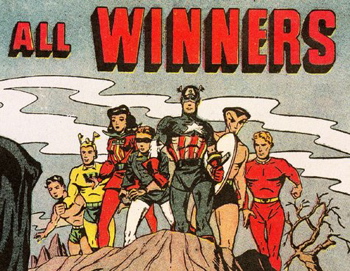
Ta da! It's official! We have a winner! Actually, we have five winners and a bonus sixth -- the first people to respond to our Dec. 17th 30 Second Blog Contest.
And they are, in the exact order they left their "I-am-about-to-win-something-free-on-this-new-blog" comments: Nettie Hartsock, Paul D. Williams, Harmony, Bill Pearce, and James Todhunter.
Congratulations one and all for responding so quickly and winning a free copy of Mitch Ditkoff's Awake at the Wheel: Getting Great Ideas Rolling (in an Uphill World). The book is in the mail.
And a special acknowledgment to Paul Kwiecinski for entering the contest after the polls had closed and after most of our readers thought there was no more chance to win. Paul's tenacity has earned him a free copy of the book. Perseverance furthers.
Posted by Mitch Ditkoff at 01:29 AM | Comments (0)
ANNOUNCING: The Winners of Our First Annual Blog Contest!
Ta da! It's official! We have a winner! Actually, we have five winners and a bonus sixth -- the first people to respond to our Dec. 17th 30 Second Blog Contest.
And they are, in the exact order they left their "I-am-about-to-win-something-free-on-this-new-blog" comments: Nettie Hartsock, Paul D. Williams, Harmony, Bill Pearce, and James Todhunter.
Congratulations one and all for responding so quickly and winning a free copy of Mitch Ditkoff's Awake at the Wheel: Getting Great Ideas Rolling (in an Uphill World). The book is in the mail.
And a special acknowledgment to Paul Kwiecinski for entering the contest after the polls had closed and after most of our readers thought there was no more chance to win. Paul's tenacity has earned him a free copy of the book. Perseverance furthers.
Posted by Mitch Ditkoff at 01:29 AM | Comments (0)
December 22, 2007Time to Catch the Bubbles

A few years ago I found myself standing in my closet, madly searching for clean clothes in a last minute attempt to pack before yet another business trip, when I noticed my 4-year old son standing in the entrance. In one hand he was holding a small plastic wand. In the other, a plastic bottle of soapy water. "Dada," he said, looking up at me -- his eyes wide open -- "do you have time to catch my bubbles?"
Time? It stopped. And so did I. At that moment it suddenly made no difference whether or not I caught my plane. (I could barely catch my breath.) The only thing that existed was him and that soulful look of longing in his eyes.
For the next ten minutes, all we did was play -- him blowing bubbles and laughing, me catching and laughing, too. His need was completely satisfied. His need for connection. His need for love. His need for knowing, beyond a shadow of a doubt, that absolutely everything was perfect -- just the way it was.
He is 13 now. His bubbles are digital. But his need is still the same -- and so is mine. And so is yours, I would venture to say.
And so dear friends, clients, prospects, bloggers, and fellow earthlings, I wish you the happiest of holidays and a fabulous New Year. If you are busier than you want to be, I wish you stillness. If things are a little too still, I wish you more business. But no matter where you are on the continuum of life, please remember -- as my young son reminded me not that many years ago -- to take some time to catch the bubbles. Be in the moment. Enjoy the gift of life. Be grateful for every single breath, your family, and all the wonderful people who love you.
Posted by Mitch Ditkoff at 12:50 AM | Comments (1)
December 17, 2007The 30 Second Blog Contest
If you are one of the first five people who leave a comment in response to this blog posting, you win a free copy of Mitch Ditkoff's newly published book on what it takes to manifest bold new ideas, Awake at the Wheel. Thirty seconds of your time is all it will take -- about the time it takes to put your socks on. You see... the Idea Champions team has a little bet going on. We want to find out how many people will actually respond to this invitation.
Alright, enough context. Now's the time. Post your comment already...
Winners will be announced by Dec 31.
(PS: Idea Champions staff and family are excluded from this little contest.)
Posted by Mitch Ditkoff at 07:39 PM | Comments (6)
December 15, 2007Create In-House Start Ups

If your organization is finding it slow going cranking up its innovation machine, take a tip from the world of high tech.
Teradyne, a manufacturer of testing equipment for semiconductor chips, phone networks, and software, has found a way to cut to the chase and go beyond the internal money grubbing game that all too often drives aspiring innovators up the wall or out the door. Simply put, Teradyne funds ersatz start-ups inside the company for its best ideas. The start-ups report not to a boss, but to a Board of Directors. It has venture capital -- not a budget.
Now you're talking -- a simple way to turn "one's job" into "one's work" -- and that is the secret sauce. If you want to spark innovation, you first have to spark the innovators. And one way to do that is to treat them like entrepreneurs, not worker bees. Go beyond the command and control budget game. Give people room enough to match their excitement. Let them create a business, not just work for a business.
Posted by Mitch Ditkoff at 12:22 AM | Comments (0)
July 26, 2007InnovationTools' "Quote of the Week" is from Mitch
In a nice and unexpected coincidence with the kickoff of our blog here, the Quote of the Week in the current InnovationWeek newsletter is from our own Mitch Ditkoff, President and co-founder of Idea Champions. The newsletter is published by the respected InnovationTools.com.
Innovation Quote of the Week"In today's flattened, restructured, downsized organization, your role is much more than getting the best out of people. It's getting the best out of the best part of people - out of their inspired imaginations, their ability to dream, conjure and conceive - and transforming those inspired ideas into the products, services and improvements that will not only keep your business humming, but make the world an even better place for all of us to live."
- Mitch Ditkoff
The quote comes from near the end of an article of Mitch's, "Innovation Coaching, The Manager as Idea Midwife." The article also appears on the InnovationTools site (demonstrating at the very least what a thorough reader their Chuck Frey is).
Posted by at 07:12 PM | Comments (0)
July 24, 2007Talking Innovation: 3M's Secret Weapon
When talking (or blogging) about practical innovation in the corporate world, there's no better place to start than 3M, a company whose name has become synonymous with the word. 3M is committed to 30% of its revenues coming from recently introduced new products.
Impressive, indeed, but how do they do it?
Dr. Larry Wendling, VP of 3M's corporate research labs, revealed 3M's "secret weapon," in what he refers to as the "Seven Habits of Highly Innovative Organizations."
The Seven Habits are (paraphrased from Amy Rowell's Innovate Forum article):
1. Totally commit to innovation from top management on down.
2. Actively maintain an innovative culture.
3. Maintain a broad base of technology.
4. Encourage formal and informal networking.
5. Reward employees.
6. Quantify efforts.
7. Tie research to customers.
It all makes perfect sense, of course, starting with Wendling's first habit, the commitment of top management. But the fourth habit, what Wendling calls 3M's "secret weapon," is often overlooked, or even ignored, much of the time in organizations. In Rowell's words: "Talk, talk, talk. Management at 3M has long encouraged networking -- formal and informal -- among its researchers."
I think Wendling calls this 3M's "secret weapon" because so few other companies do this well, or are even aware of its importance. But what could be more important to innovation than encouraging the collaboration and teamwork we know lies behind every innovation since the invention of the wheel?
This is where the "silo" mentality and the "not invented here" syndrome intrudes on an innovation culture. Strict, formal reporting structures, loyalty to business unit before the organization, and the human tendency to only interact with people who already share our own views and experiences, all come into play. Any or all of these can block, or at least slow down, many companies' internal "network of innovation."
I can't tell you how many times I've facilitated a brainstorm session at a major corporation when a proposed idea will get criticized, or even rejected, because the development of the idea would involve another department or business unit! Sometimes the excuse is that there is no protocol for working with the other unit, and one would have to be created. Sometimes there is a poor previous history of collaboration between the two departments, (often involving, unsurprisingly, the two people at the top of each division).
In any case, I can't help but wonder how many great ideas fall between the cracks because executing them falls between the purviews of two different departments. And, unfortunately, it is in space between two major realms of focused business activity where we would expect to find some of the most exciting and profitable innovations!
To its credit, 3M actively encourages employees to talk to each other; across business units and despite formal roles, responsibilities, and organizational charts. If an employee has the kernel of an idea, he (or she) has the permission, indeed, the responsibility, to reach out and find out if it's viable, or if someone else has the missing piece. They're free to ask if others are interested in developing it, no matter where they work in the organization! (You mean you're allowed to DO that? Who knew?)
So, how does YOUR company's culture deal with employee networking? Does it encourage employees reaching out across organizational boundaries to share insights and ideas? Does it ignore this important aspect of innovation? Or is it actually hostile to it, punishing employees who reach out to others in order to get something started?
Here's a relatively cost-free way to improve the culture of innovation of your organization. Take advantage of 3M's experience and success and make employee networking your innovation "secret weapon" as well.
And, yes, you ARE allowed to do that!
Posted by Val Vadeboncoeur at 06:45 PM | Comments (7)


